
100+ Space Research Topics [Updated]
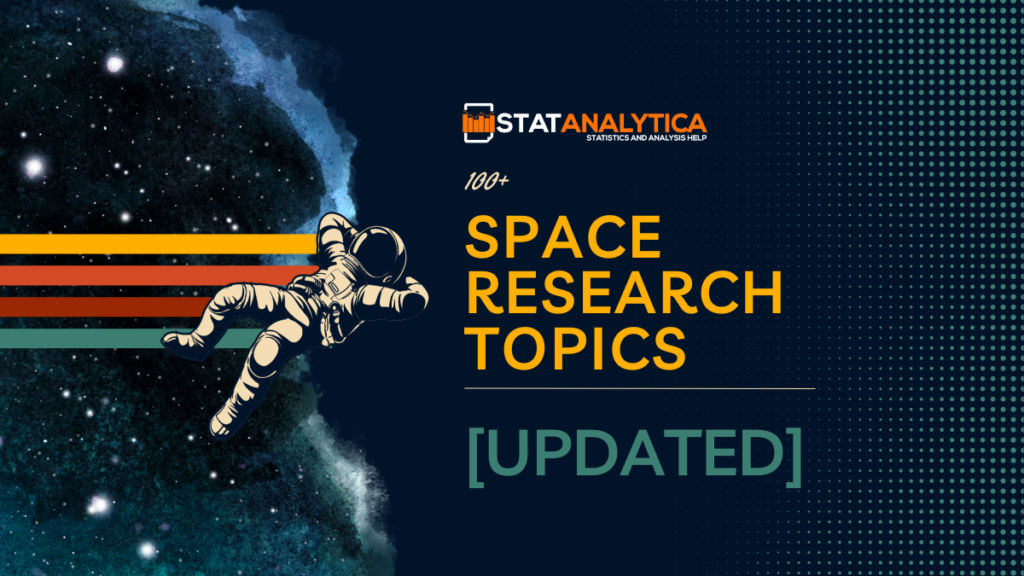
Space has always attracted humanity’s imagination. The vastness of the cosmos, with its twinkling stars, mysterious planets, and enigmatic black holes, beckons us to explore its depths. But why do we study space? What are the research topics that drive scientists to reach for the stars? In this blog, we’ll delve into the fascinating world of space research topics, exploring key topics that continue to inspire and challenge researchers around the globe.
Why Do We Study Space?
Table of Contents
Here are some key points explaining why we study space:
- Understanding our Origins: Space research helps us uncover the origins of the universe, including how galaxies, stars, and planets formed.
- Advancing Scientific Knowledge: Studying space leads to breakthroughs in physics, astronomy, and other scientific fields, expanding our understanding of the cosmos.
- Technological Innovation: Space exploration drives the development of new technologies, such as satellite communication and medical imaging, benefiting society as a whole.
- Exploration and Discovery: Humans are inherently curious, and space offers a vast frontier for exploration, fueling our desire to discover new worlds and phenomena.
- Earth Observation: Space-based observations provide valuable data on Earth’s climate, weather patterns, and environmental changes, aiding in disaster management and conservation efforts.
- Search for Life: Investigating other planets and celestial bodies helps us understand the conditions necessary for life, potentially leading to the discovery of extraterrestrial life forms.
- Inspiration and Education: Space exploration inspires future generations of scientists, engineers, and explorers, fostering innovation and curiosity about the universe.
100+ Space Research Topics: Category Wise
Astronomy and astrophysics.
- Exoplanet detection methods and recent discoveries
- The life cycle of stars: from birth to death
- Supermassive black holes and their role in galaxy formation
- Gravitational waves: detection and implications
- Dark matter and dark energy: understanding the mysteries of the universe
- Supernovae explosions: studying the aftermath of stellar deaths
- Galactic dynamics: exploring the structure and evolution of galaxies
- Cosmic microwave background radiation: insights into the early universe
- Gamma-ray bursts: uncovering the most energetic explosions in the cosmos
- The search for extrasolar planets with potential habitable conditions
Planetary Science
- Martian geology and the search for signs of past life
- Jupiter’s Great Red Spot: dynamics and longevity
- Saturn’s rings: composition, structure, and origin
- Lunar exploration: past missions and future prospects
- Venusian atmosphere: understanding the greenhouse effect and extreme conditions
- Io, Europa, Ganymede, and Callisto: Jupiter’s diverse moons
- Titan: Saturn’s moon with an Earth-like atmosphere and hydrocarbon lakes
- The Kuiper Belt and Oort Cloud: reservoirs of comets and icy bodies
- Dwarf planets: Pluto, Eris, Haumea, Makemake, and Ceres
- Planetary volcanism: processes and consequences on various celestial bodies
Space Technology and Engineering
- Satellite constellations for global internet coverage
- CubeSats: miniaturized satellites for scientific research and technology demonstration
- Space debris mitigation strategies and technologies
- Ion propulsion systems: efficient propulsion for deep space missions
- Space telescopes: next-generation observatories for astronomy and astrophysics
- Space-based solar power: harvesting solar energy in orbit
- Asteroid mining: extracting resources from near-Earth objects
- In-situ resource utilization on other planets and moons
- Additive manufacturing (3D printing) in space exploration
- Autonomous spacecraft navigation and control for long-duration missions
Astrobiology and the Search for Life
- Extremophiles: organisms thriving in extreme environments on Earth and their implications for extraterrestrial life
- Biosignatures: markers of past or present life on other planets
- Methanogenesis on Mars: potential evidence for subsurface microbial life
- Europa’s subsurface ocean: exploring the possibility of life beneath the ice
- Enceladus: hydrothermal vents and the search for life in its subsurface ocean
- The habitability of exoplanets: assessing conditions for life beyond the solar system
- Panspermia: the transfer of life between celestial bodies
- Astrobiology field research in extreme environments on Earth
- SETI: the search for extraterrestrial intelligence and communication
- The implications of discovering microbial life on Mars or other celestial bodies
Space Policy and Ethics
- International collaboration in space exploration and research
- The Outer Space Treaty: principles governing the use of outer space
- Space tourism regulations and safety considerations
- Space law and jurisdiction: legal frameworks for activities in space
- Military applications of space technology and potential arms race in space
- Space resource utilization and ownership rights
- Space environmentalism: advocating for the protection of celestial bodies and their environments
- Space colonization ethics and implications for human societies
- Space governance beyond national boundaries
- Cultural heritage preservation on the Moon and other celestial bodies
Challenges and Future Directions
- Funding challenges and opportunities in space research and exploration
- Space radiation hazards and mitigation strategies for astronauts
- Interplanetary communication and navigation for deep space missions
- Long-duration spaceflight: physiological and psychological effects on astronauts
- Terraforming Mars: engineering a habitable environment on the Red Planet
- Space elevator concept: a revolutionary approach to space access
- Next-generation space launch vehicles and propulsion technologies
- Nuclear propulsion for crewed missions to Mars and beyond
- Space settlement design and infrastructure requirements
- Advancing artificial intelligence and robotics for autonomous space exploration
Space Weather and Space Environment
- Solar flares and coronal mass ejections: impacts on Earth’s magnetosphere and technology
- Space weather forecasting and its applications in satellite operations
- Magnetospheres of Earth and other planets: comparative studies and dynamics
- Solar wind interactions with planetary atmospheres and magnetospheres
- Aurora phenomena on Earth and other planets
- Radiation belts: understanding and mitigating hazards for spacecraft and astronauts
- Cosmic rays: sources, composition, and effects on space missions
- Space climate change: long-term variations in solar activity and their consequences
- Space weather effects on satellite communications, navigation, and power systems
- Space weather monitoring and prediction networks
Space Exploration and Missions
- Mars Sample Return mission: challenges and scientific objectives
- Artemis program: NASA’s plans for returning astronauts to the Moon
- Asteroid impact mitigation strategies and planetary defense initiatives
- The James Webb Space Telescope: capabilities and scientific goals
- Europa Clipper mission: exploring Jupiter’s icy moon for signs of habitability
- China’s Chang’e lunar exploration program: past achievements and future missions
- Commercial crew and cargo transportation to the International Space Station
- Voyager and Pioneer missions: the farthest human-made objects in space
- Space missions to study near-Earth objects and potential asteroid mining targets
- International Mars exploration collaborations and missions
Space Communication and Navigation
- Deep space communication networks and relay satellites
- Laser communication technology for high-speed data transmission in space
- Satellite-based navigation systems: GPS, Galileo, and GLONASS
- Interplanetary Internet: protocols and architectures for space communications
- Radio astronomy and interferometry: probing the universe with radio waves
- Quantum communication in space: secure and ultra-fast communication channels
- Delay-tolerant networking for deep space missions
- Autonomous navigation systems for spacecraft and rovers
- Optical communications for small satellites and CubeSats
- Space-to-ground communication systems for remote sensing and Earth observation satellites
Space Medicine and Human Spaceflight
- Microgravity effects on human physiology and health
- Countermeasures for mitigating bone and muscle loss in space
- Psychological challenges of long-duration space missions
- Space food technology: nutrition and sustainability in space
- Medical emergencies in space: protocols and procedures for astronaut health care
- Radiation shielding and protection for crewed missions beyond Earth orbit
- Sleep and circadian rhythms in space: optimizing astronaut performance
- Artificial gravity concepts for maintaining crew health on long-duration missions
- Telemedicine applications for space exploration missions
- Bioastronautics research: advancing human spaceflight capabilities and safety
Space Industry and Commercialization
- NewSpace companies: the rise of private space exploration ventures
- Satellite constellation deployments for global internet coverage
- Space tourism: opportunities, challenges, and market trends
- Commercial spaceports and launch facilities around the world
- Space manufacturing and in-space assembly techniques
Tips To Write Space Research Papers
Crafting space research papers can be a thrilling and fulfilling pursuit, yet it demands meticulous planning and implementation to guarantee that your efforts effectively convey your discoveries and make meaningful contributions to the discipline. Here are some tips to help you write space research papers:
- Choose a Narrow Topic: Space is a vast field with numerous sub-disciplines. Narrow down your topic to something specific and manageable, ensuring that it aligns with your interests and expertise.
- Conduct Thorough Research: Before you start writing, immerse yourself in the existing literature on your chosen topic. Familiarize yourself with key concepts, theories, and recent discoveries to provide context for your research.
- Develop a Clear Thesis Statement: Define the central argument or hypothesis of your paper in a concise and focused thesis statement. This statement should guide your writing and serve as the foundation for your research.
- Outline Your Paper: Create a detailed outline outlining the structure of your paper, including the introduction, literature review, results, and conclusion sections. This will help you organize your thoughts and ensure that your paper flows logically.
- Write a Compelling Introduction: Begin your paper with a captivating introduction that offers context about your subject, underscores its importance, and delineates the paper’s framework . Grab the reader’s interest and inspire them to delve further into your work.
- Provide a Comprehensive Literature Review: Synthesize the existing research on your topic in a literature review section. Examine pertinent research, theories, methodologies, and results, pinpointing any disparities or deficiencies in the existing literature that your study seeks to rectify.
- Detail Your Methodology: Describe the methods you used to conduct your research, including data collection, analysis, and interpretation techniques. Provide enough detail for readers to understand how your study was conducted and to evaluate its validity and reliability.
- Present Your Results Clearly: Present your research findings in a clear, concise manner, using tables, figures, and charts to illustrate key data points. Interpret your results objectively and discuss their implications in relation to your research question or hypothesis.
- Engage in Critical Analysis: Analyze your findings in the context of existing literature, discussing their significance, strengths, limitations, and potential implications for future research. Be critical and objective in your evaluation, acknowledging any potential biases or limitations in your study.
- Craft a Strong Conclusion: Summarize the main findings of your research and reiterate their significance in the conclusion section. Discuss any implications for theory, practice, or policy and suggest avenues for future research.
- Proofread and Revise: Before submitting your paper, carefully proofread it for spelling, grammar, and punctuation errors. Edit your writing to ensure clarity, coherence, and consistency, guaranteeing that your points are adequately backed and logically organized.
- Follow Formatting Guidelines: Follow the formatting instructions provided by the journal or conference to which you intend to submit your paper. Pay attention to details such as font size, margins, citation style, and reference formatting to ensure that your paper meets the publication requirements.
Space research offers a window into the vastness of the cosmos, revealing the beauty and complexity of the universe we inhabit. From the depths of space to the surfaces of distant planets, scientists are uncovering new wonders and answering age-old questions about our place in the universe. As we look to the stars, let us be inspired by the spirit of exploration and discovery that drives humanity ever onward, towards new horizons and unknown worlds. I hope you find the best space research topics from the above list.
Related Posts

Step by Step Guide on The Best Way to Finance Car

The Best Way on How to Get Fund For Business to Grow it Efficiently

Suggested Searches
Climate Change
Expedition 64
- Mars perseverance
- SpaceX Crew-2
- International Space Station
- View All Topics A-Z
Humans in Space
Earth & Climate
The Solar System
The Universe
Aeronautics
Learning Resources
News & Events
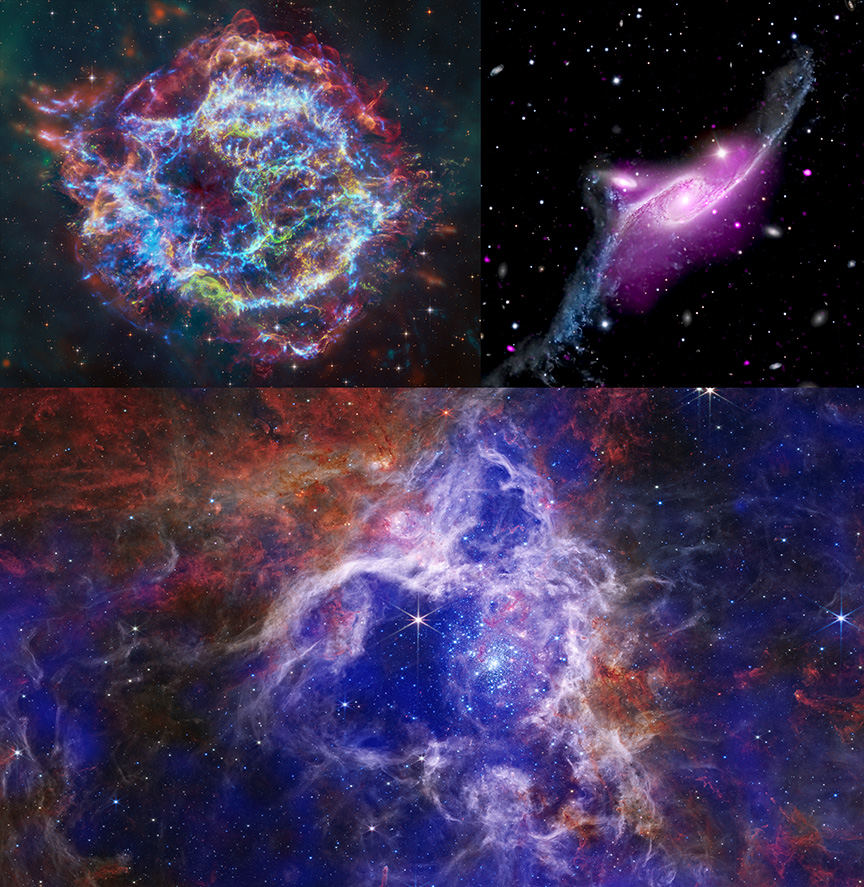
New NASA Sonifications Listen to the Universe’s Past

What’s Up: September 2024 Skywatching Tips from NASA

NASA Mission Gets Its First Snapshot of Polar Heat Emissions
- Search All NASA Missions
- A to Z List of Missions
- Upcoming Launches and Landings
Spaceships and Rockets
- Communicating with Missions
- James Webb Space Telescope
Hubble Space Telescope
- Why Go to Space
Commercial Space
- Destinations
- Living in Space
- Explore Earth Science
- Earth, Our Planet
- Earth Science in Action
- Earth Multimedia
- Earth Science Researchers
- Pluto & Dwarf Planets
- Asteroids, Comets & Meteors
The Kuiper Belt
The Oort Cloud
Skywatching
- The Search for Life in the Universe
Black Holes
The Big Bang
- Dark Energy & Dark Matter
Earth Science
Planetary Science
- Astrophysics & Space Science
- The Sun & Heliophysics
Biological & Physical Sciences
Lunar Science
Citizen Science
Astromaterials
Aeronautics Research
Human Space Travel Research
Science in the Air
NASA Aircraft
Flight Innovation
Supersonic Flight
Air Traffic Solutions
Green Aviation Tech
Drones & You
Technology Transfer & Spinoffs
- Space Travel Technology
- Technology Living in Space
- Manufacturing and Materials
Science Instruments
For Kids and Students
For Educators
- For Colleges and Universities
For Professionals
Science for Everyone
- Requests for Exhibits, Artifacts, or Speakers
STEM Engagement at NASA
- NASA's Impacts
- Centers and Facilities
- Directorates
Organizations
People of NASA
Internships
- Our History
Doing Business with NASA
Get Involved
NASA en Español
Aeronáutica
- Ciencias Terrestres
- Sistema Solar
- All NASA News
- Video Series on NASA+
Newsletters
Social Media
Media Resources
- Upcoming Launches & Landings
Virtual Guest Program
- Image of the Day
- Sounds and Ringtones
Interactives
- STEM Multimedia

NASA Invites Social Creators to Experience Launch of Europa Clipper Mission

NASA’s Mini BurstCube Mission Detects Mega Blast

NASA Astronaut Don Pettit’s Science of Opportunity on Space Station

NASA, Boeing Optimizing Vehicle Assembly Building High Bay for Future SLS Stage Production

NASA Seeks Input for Astrobee Free-flying Space Robots
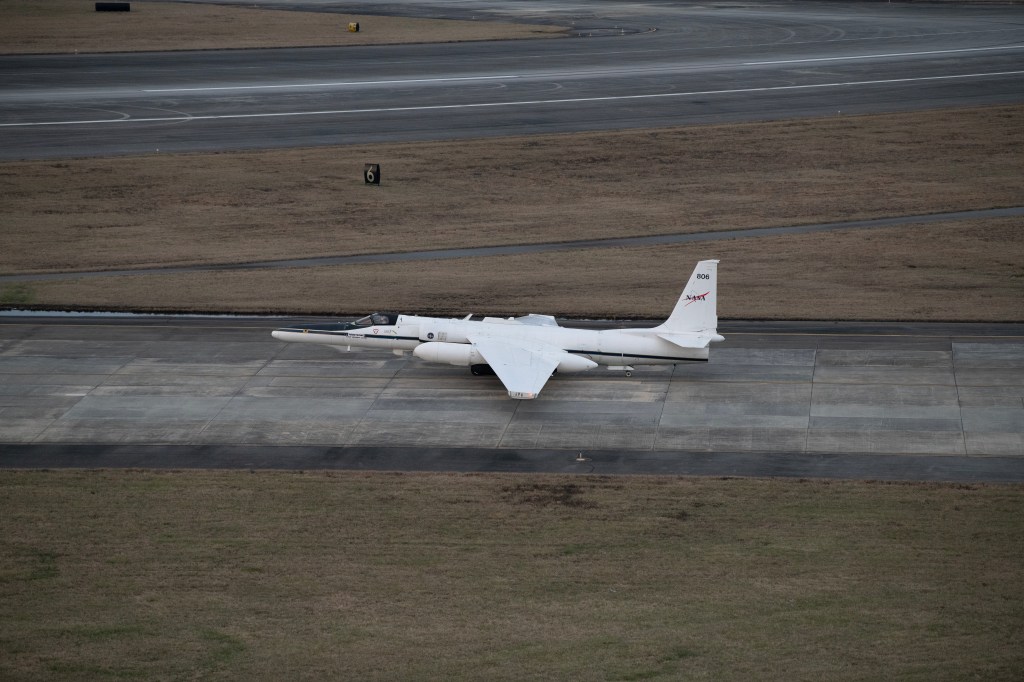
NASA Earth Scientists Take Flight, Set Sail to Verify PACE Satellite Data

Proyecto de la NASA en Puerto Rico capacita a estudiantes en biología marina
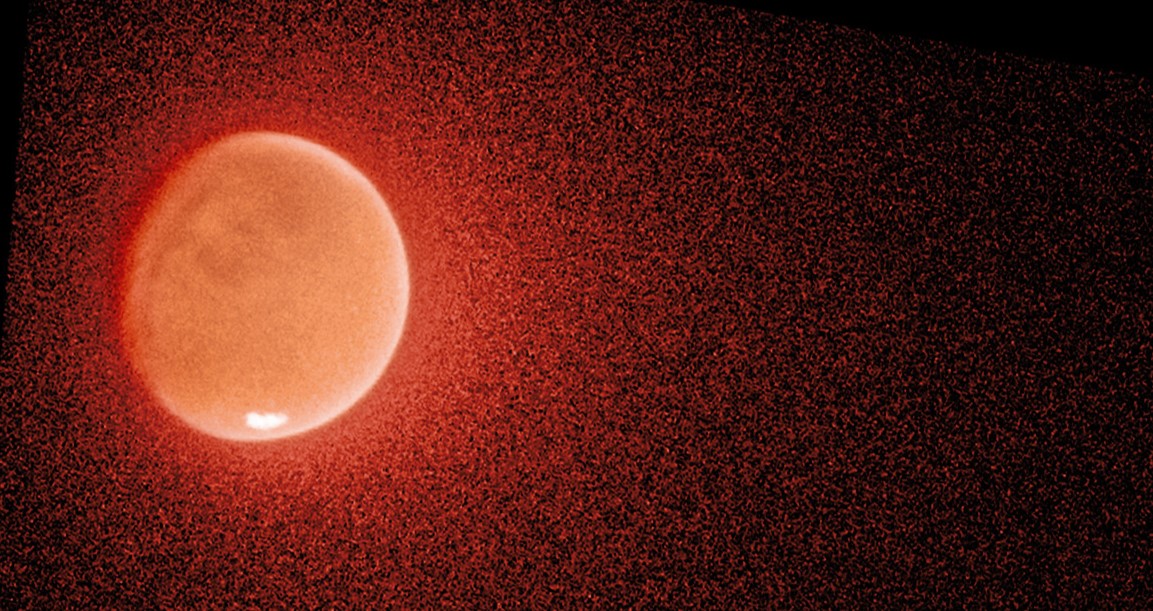
NASA’s Hubble, MAVEN Help Solve the Mystery of Mars’ Escaping Water
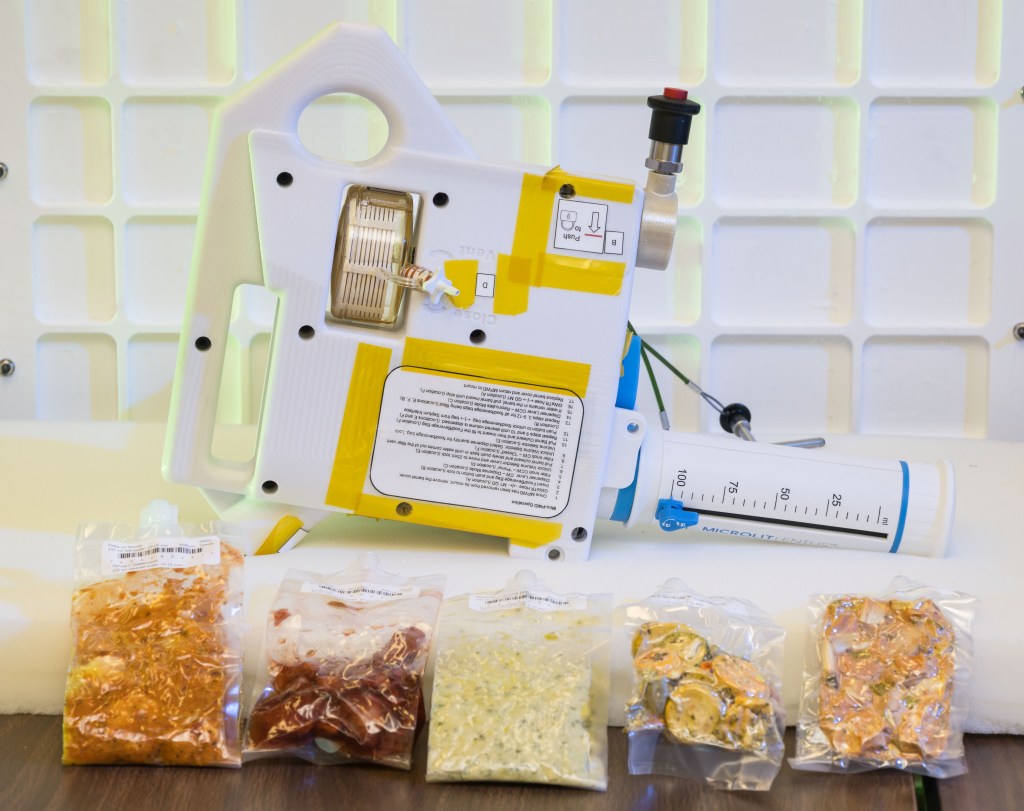
Artemis IV: Gateway Gadget Fuels Deep Space Dining
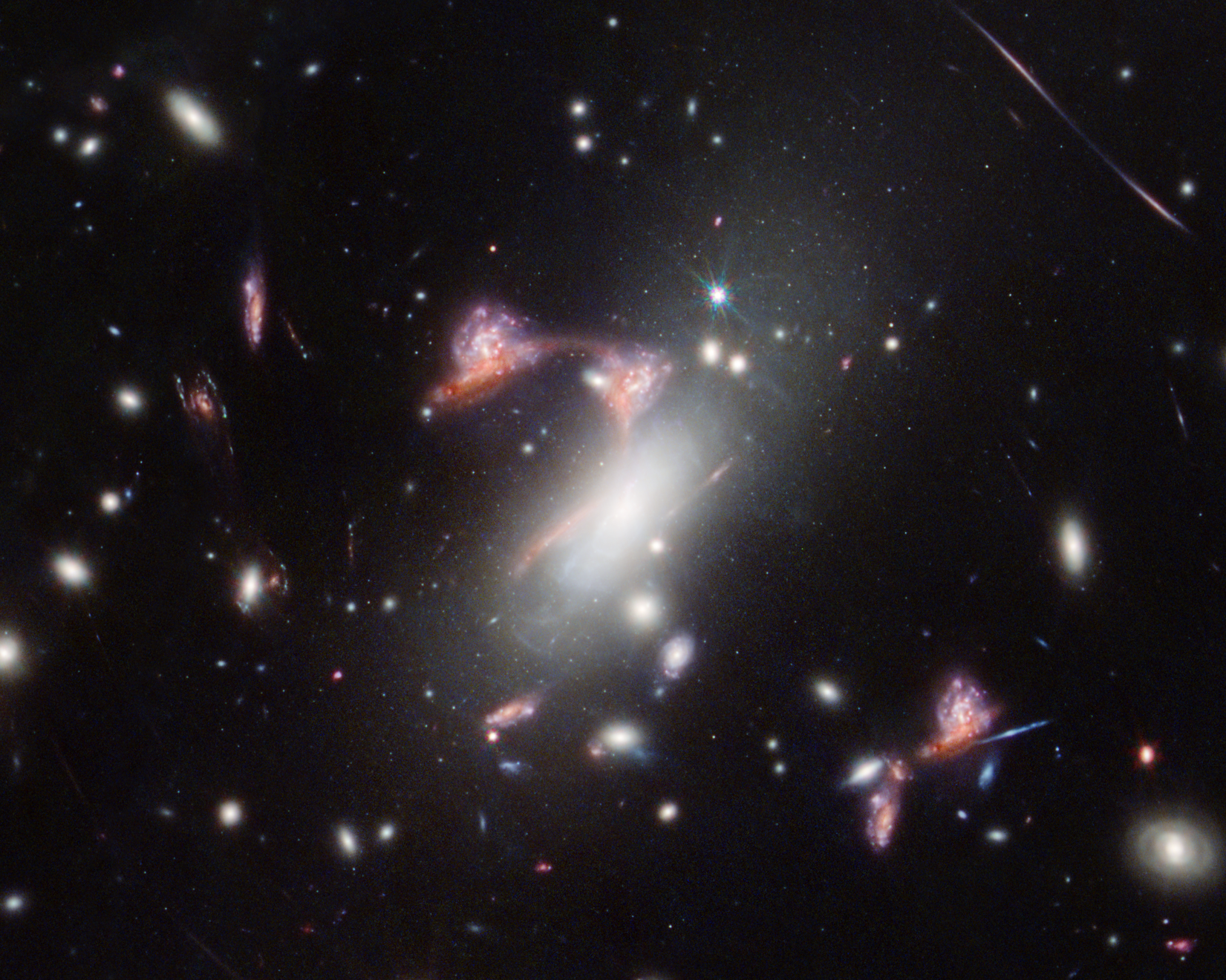
NASA’s Webb Reveals Distorted Galaxy Forming Cosmic Question Mark
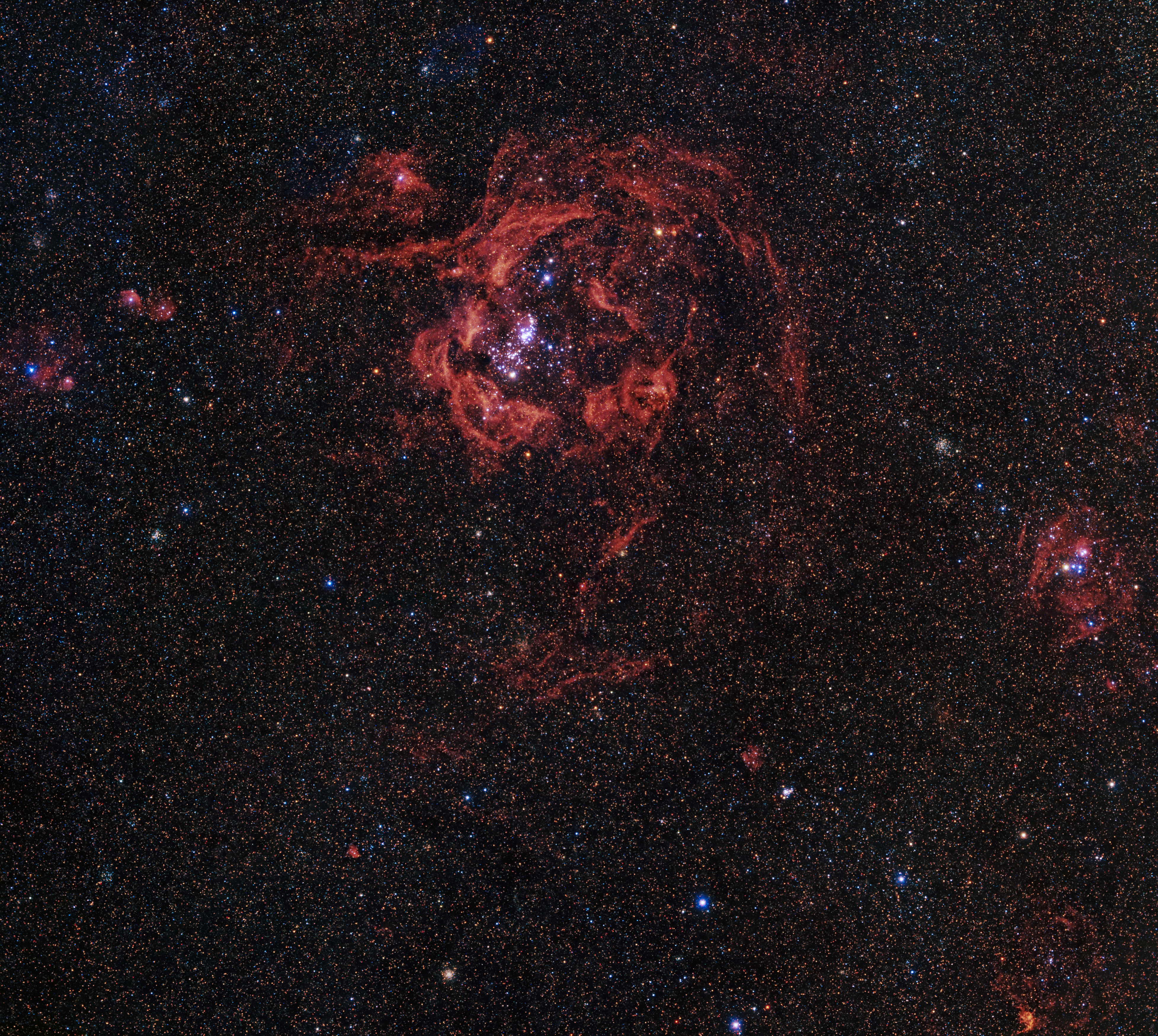
Hubble Zooms into the Rosy Tendrils of Andromeda
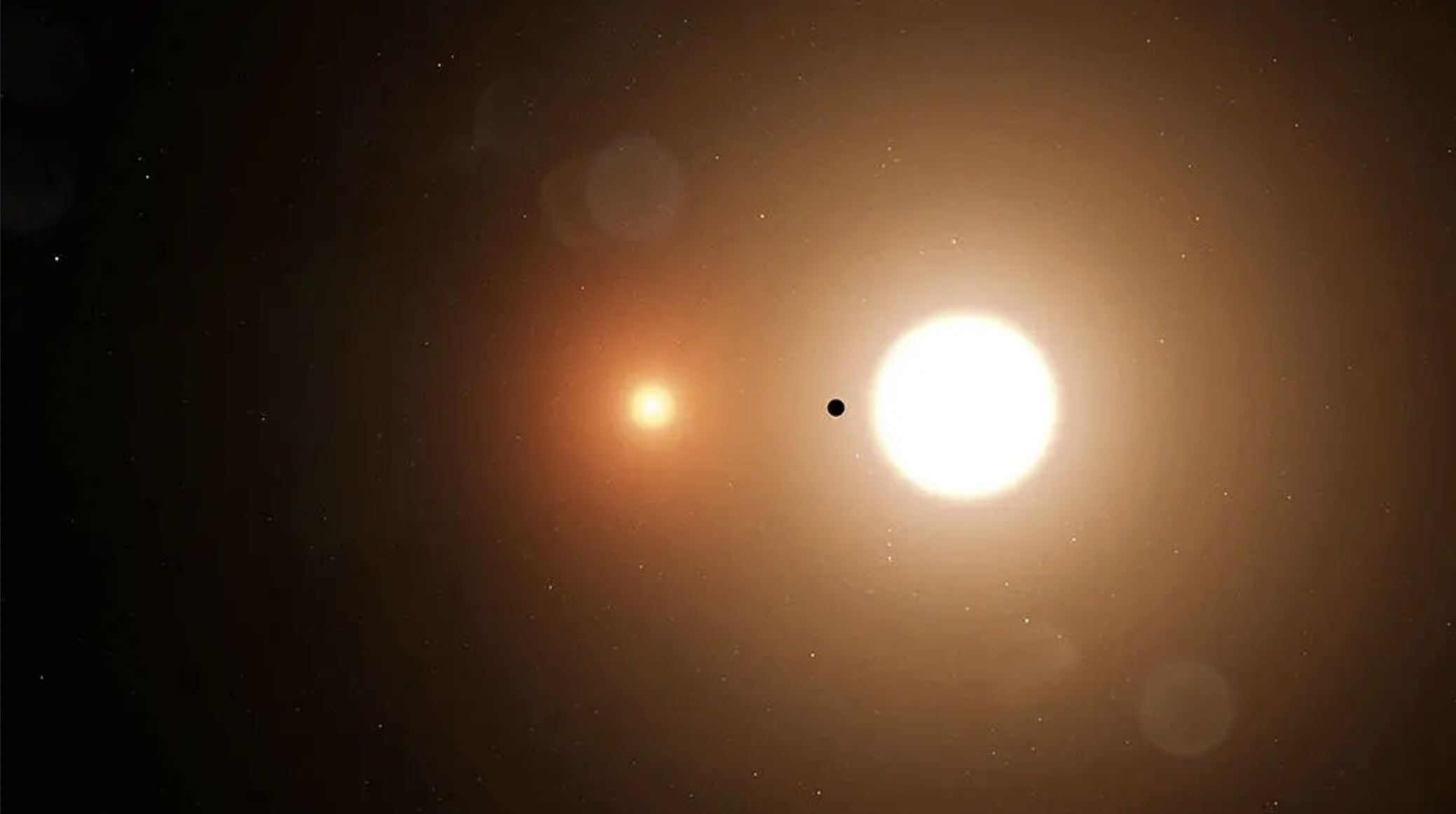
Join the Eclipsing Binary Patrol and Spot Rare Stellar Pairs!

NASA Tunnel Generates Decades of Icy Aircraft Safety Data

Research Plane Dons New Colors for NASA Hybrid Electric Flight Tests

NASA G-IV Plane Will Carry Next-Generation Science Instrument
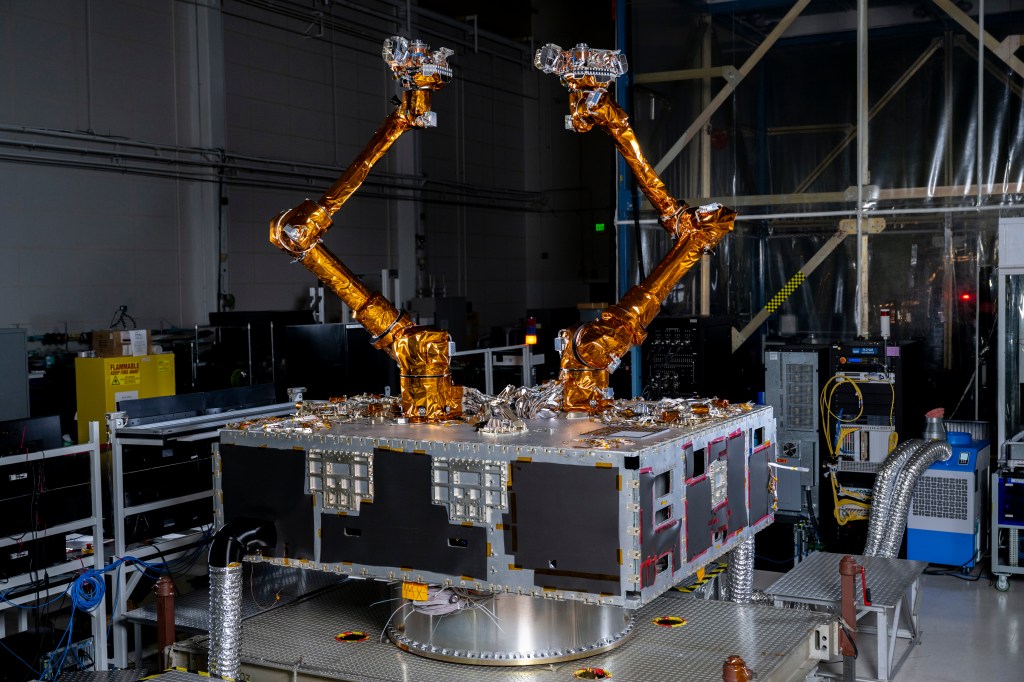
NASA to Support DARPA Robotic Satellite Servicing Program

NASA JPL Developing Underwater Robots to Venture Deep Below Polar Ice
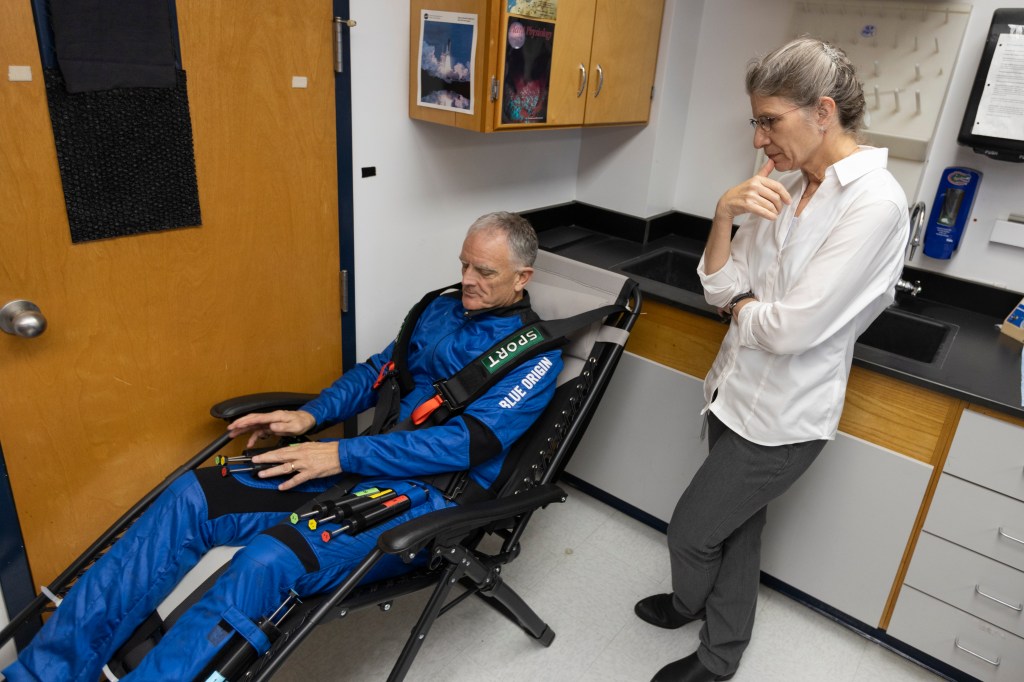
First NASA-Supported Researcher to Fly on Suborbital Rocket
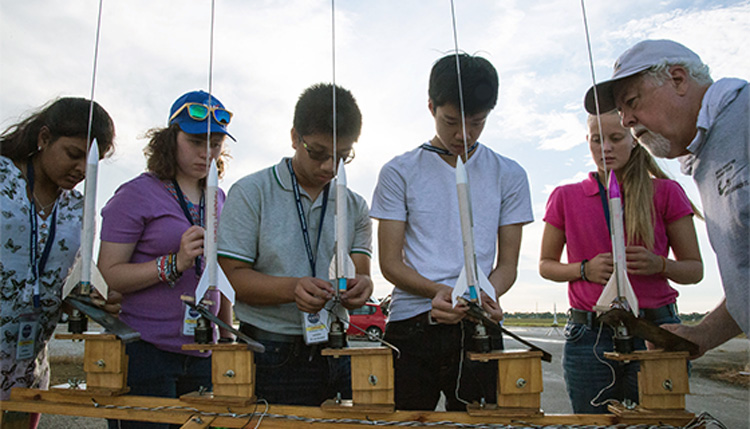
Learn Math with NASA Science

Eclipses Create Atmospheric Gravity Waves, NASA Student Teams Confirm
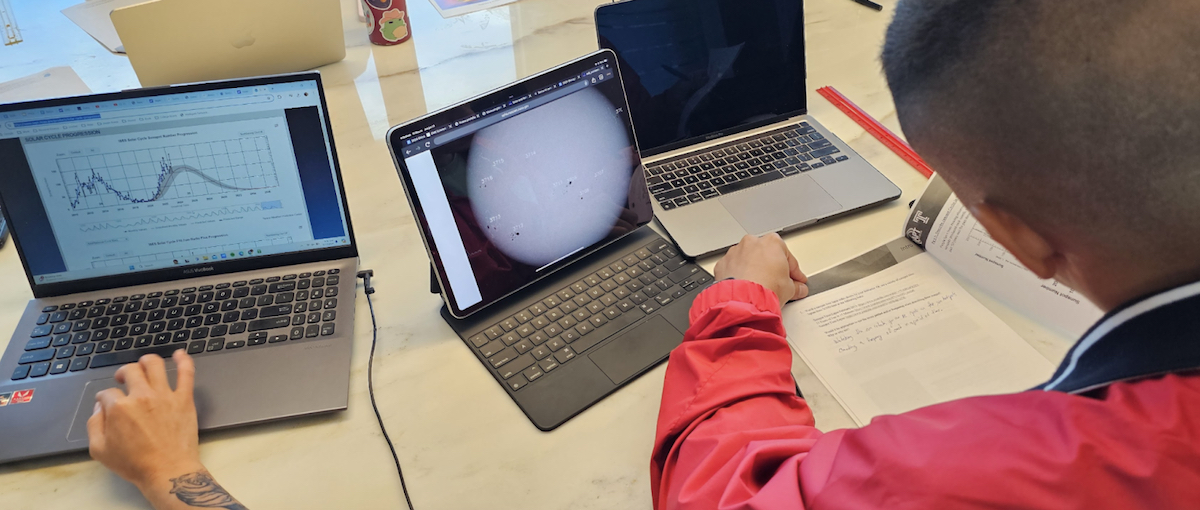
Leveraging Teacher Leaders to Share the Joy of NASA Heliophysics
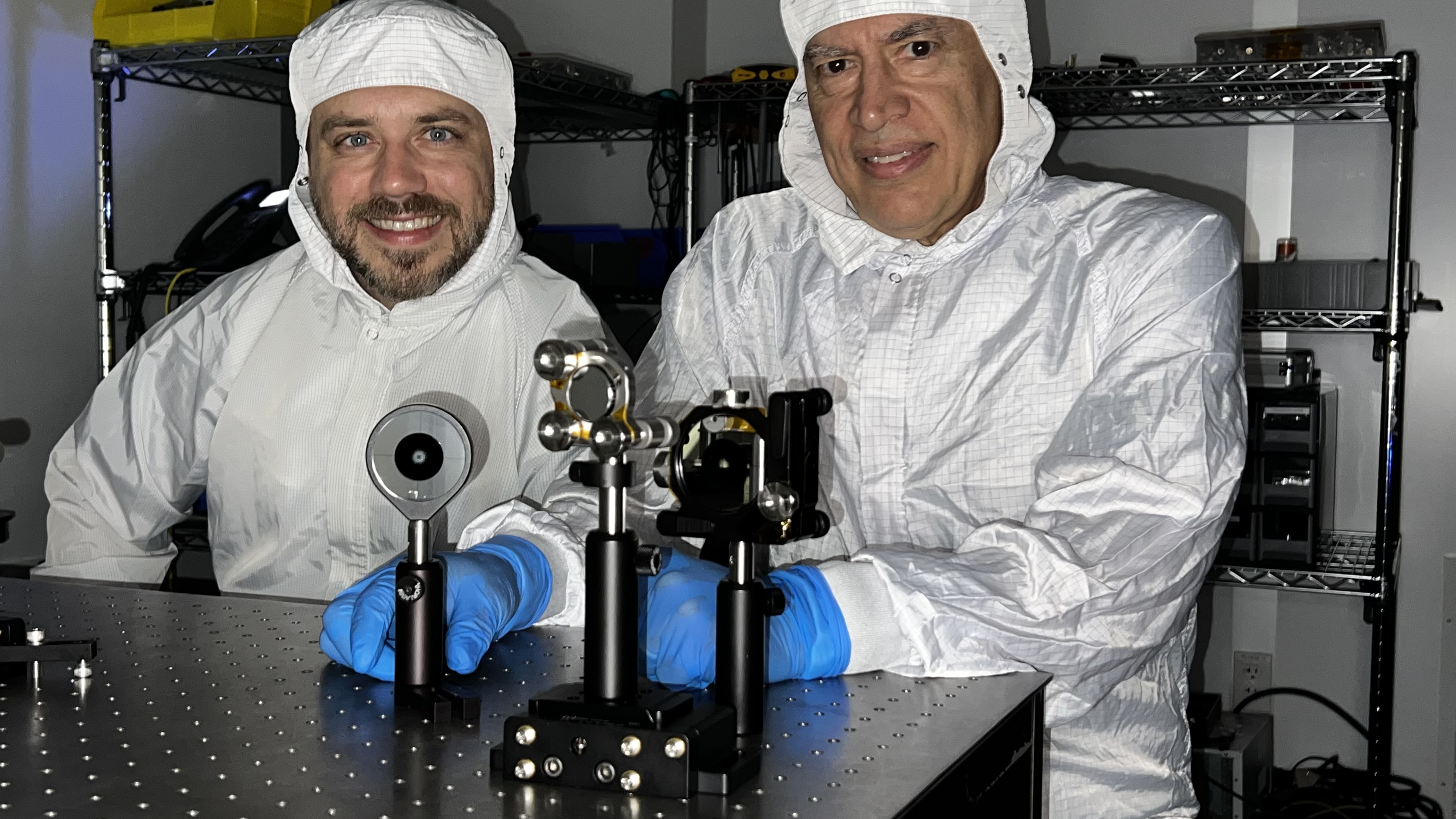
Carbon Nanotubes and the Search for Life on Other Planets

235 Years Ago: Herschel Discovers Saturn’s Moon Enceladus

La NASA invita a los medios al lanzamiento de Europa Clipper

El X-59 de la NASA avanza en las pruebas de preparación para volar

La NASA invita a creadores de las redes sociales al lanzamiento de la misión Europa Clipper
A to z topics listing.
Use this A to Z Topics listing to discover all things NASA!
2017 Solar Eclipse
2023 Annular Eclipse
2024 Solar Eclipse
3D Tissue Chips
67P/Churyumov-Gerasimenko
AAM Drones and You
Academy of Program / Project & Engineering Leadership
Accessibility at NASA
Accessing Flight Tests
ACE (Advanced Composition Explorer)
Acerca de NASA
ACME (Advanced Combustion via Microgravity Experiments)
AcrimSat (Active Cavity Irradiance Monitor Satellite)
ACT (Atmospheric Carbon and Transport) – America
ACTE (Adaptive Compliant Trailing Edge)
Active Galaxies
ADEOS (Advanced Earth Observing Satellite) / MIDORI
Advanced Air Transport Technology
Advanced Air Vehicles Program
Advanced Composites
Advanced Studies & Concepts (PACE)
Advanced Spacesuits
Aeronautics Research Mission Directorate
Aeronautics Technology
Aerosciences Evaluation Test Capabilities
Aerospace Safety Advisory Panel
AIM (Aeronomy of Ice in the Mesosphere)
Air Mobility Pathfinders Project
Air Traffic Control Labs
Airborne Science
AirMOSS (Airborne Microwave Observatory of Subcanopy and Subsurface)
AJAX (Alpha Jet Atmospheric eXperiment)
Akatsuki/Venus Climate Orbiter mission (PLANET-C)
Alan B. Shepard Jr.
Alan G. Poindexter
Alan L. Bean
Albert Sacco Jr.
Alfred M. Worden
Analog Missions
Andre Douglas
Andrew J. Feustel
Andrew M. Allen
Andrew R. Morgan
Andrew S. W. Thomas
Animal Biology
Anna L. Fisher
Anne C. McClain
Antarctic Stations
Antarctic Station NSF
Anthony W. England
APH (Advanced Plant Habitat)
Apollo Program
Apollo 15 Subsatellite
Apollo 16 Subsatellite
Apollo-Soyuz Test Project
Applied Sciences Program
Apply for Funding
ARCTAS (Arctic Research of the Composition of the Troposphere from Aircraft and Satellites)
ARIEL (Atmospheric Remote-sensing Infrared Exoplanet Large-survey)
Armstrong Flight Research Center
Armstrong Test Facility (Plum Brook)
Artemis Campaign Development Division
ASCA (Advanced Satellite for Cosmology and Astrophysics)
Asteroid Initiative
Asian American and Native Hawaiian Pacific Islander Heritage
ASTHROS (Astrophysics Stratospheric Telescope for High Spectral Resolution Observations at Submillimeter-wavelengths)
Astro Observatory 1
Astro Observatory 2
Astrobiology
Astronaut Candidates
Astrophysics
Astrophysics Division
Astrophysics Explorers Program
Astrophysics Pioneers
Astrophysics Research Program
Atmospheric Composition
ATLAS (Atmospheric Laboratory of Applications and Science)
Atmospheric Tomography Mission (ATom)
ATS (Applications Technology Satellite Program )
ATTREX (Airborne Tropical TRopopause Experiment)
Awarded Abstracts
AWE (Atmospheric Waves Experiment)
B-377 Super Guppy
Barbara R. Morgan
BARREL (Balloon Array for Radiation-belt Relativistic Electron Losses)
Barry E. Wilmore
BBXRT (Broad Band X-ray Telescope)
BECCAL (Bose Einstein Condensates & Cold Atoms Lab)
Become an Astronaut
Benefits Back on Earth
Benefits to Humanity
Benefits to Science
Benjamin Alvin Drew
BepiColombo
Bernard A. Harris Jr.
Bill Nelson
Binary Stars
Biological Experiment-01 (BioExpt-01)
BION / Biocosmos
Black History Month
Boeing Starliner
Bonnie J. Dunbar
Brand Guidelines Center
Brent W. Jett
Brewster H. Shaw Jr.
Brian Duffy
Brian T. O’Leary
BRIC (Biological Research in Canisters)
Brown Dwarfs
Bruce E. Melnick
Bruce McCandless
Bryan D. O’Connor
Budget & Annual Reports
Buzz Aldrin
Byron K. Lichtenberg
Caldwell Catalog
CALIPSO (Cloud-Aerosol Lidar and Infrared Pathfinder Satellite)
Callie First Graphic Novel
Candidate Astronauts
Carbon Cycle
Carl E. Walz
Carl J. Meade
Carlos I. Noriega
Carruthers Geocorona Observatory (GLIDE)
CARVE (Carbon in Arctic Reservoirs Vulnerability Experiment)
Cassini-Huygens
Catherine G. Coleman
CATS (Cloud-Aerosol Transport System)
Cell and Molecular Biology
Centennial Challenges
Centennial Challenges News
Center Innovation Fund Center of Excellence for Collaborative Innovation (CoECI)
CERES (Clouds and the Earth’s Radiant Energy System)
CeREs (Compact Radiation Belt Explorer)
Ceres Dwarf Planet
Cessna C206
CGRO (Compton Gamma Ray Observatory)
CHAMP (Challenging Mini-satellite Payload)
Chandra X-ray Observatory
Chandrayaan-1
Chandrayaan-2
Chandrayaan-3
Charles A. Bassett II
Charles Camarda
Charles Conrad Jr.
Charles D. Gemar
Charles D. Walker
Charles E. Brady Jr.
Charles F. Bolden Jr.
Charles G. Fullerton
Charles J. Precourt
Charles Lacy Veach
Charles M. Duke Jr.
Charles O. Hobaugh
Chiaki Mukai
CHIPS (Cosmic Hot Interstellar Plasma Spectrometer)
Christina Birch
Christina H. Koch
Christopher J. Ferguson
Christopher J. Loria
Christopher J. Cassidy
Christopher L. Williams
Ciencia e Investigación
CINDI (Coupled Ion Neutral Dynamic Investigation)
CIPHER (Complement of Integrated Protocols for Human Exploration Research)
Cirrus SR-22
Clayton C. Anderson
Clifton C. Williams Jr.
Climate Science
CLPS (Commercial Lunar Payload Services)
COBE (Cosmic Background Explorer)
Columbia 300
Combustion Science
Commercial Crew
Commercial Crew Rockets
Commercial Crew Spacecraft
Commercial Lunar Payload Services (CLPS)
Commercial Space Programs
Commercial Supersonic Technology
Communicating and Navigating with Missions
Community of Practice Webinar
Community Partners
Complex Fluids
Conjunction Assessment Risk Analysis Team (CARA)
Constellations
CONTOUR (COmet Nucleus TOUR)
Convergent Aeronautics Solutions
CORAL (COral Reef Airborne Observatory)
Coronal Mass Ejections
COSI (Compton Spectrometer and Imager)
Cosmic Origins Program
Courses & Curriculums for Professionals
COVID-19 Response
Crab Nebula
Crew Health and Performance Exploration Analog (CHAPEA)
Crew Vehicle Systems Research Facility
Cross Program Integration
CRRES (Combined Release and Radiation Effects Satellite)
Cryogenic Fluid Management (CFM)
Cryogenic Propellant Handling
CubeSat Launch Initiative
CubeSat Or Microsat Probabilistic and Analogies Cost Tool (COMPACT)
CuPID (Cusp Plasma Imaging Detector)
Curiosity (Rover)
Curtis L. Brown Jr.
CUSP (CubeSat Mission to Study Solar Particles)
Cycles & Focus Areas
CYGNSS (Cyclone Global Navigation Satellite System)
Dale A. Gardner
Daniel C. Brandenstein
Daniel C. Burbank
Daniel M. Tani
Daniel T. Barry
Daniel W. Bursch
Dark Matter & Dark Energy
DART (Double Asteroid Redirection Test)
Data Resources
David A. Wolf
David C. Hilmers
David C. Leestma
David M. Brown
David M. Walker
David R. Scott
DAVINCI (Deep Atmosphere Venus Investigation of Noble gases, Chemistry, and Imaging)
Deep Impact / EPOXI (Extrasolar Planet Observation and Deep Impact Extended Investigation)
Deep Space 1
Deep Space Atomic Clock
Deep Space Network (DSN)
Deep Space Optical Communications (DSOC)
Deniz Burnham
Desert RATS (Research and Technology Studies)
Developmental, Reproductive and Evolutionary Biology
(DECLIC) DEvice for the study of Critical LIquids and Crystallization
Didymos & Dimorphos
Diffuse X-Ray Spectrometer (DXS)
DISCOVER AQ (Deriving Information on Surface Conditions from COlumn and VERtically Resolved Observations Relevant to Air Quality)
Discovery Program
Diversity at NASA
Dominic A. Antonelli
Dominic L. Gorie
Don L. Lind
Donald A. Thomas
Donald E. Williams
Donald H. Peterson
Donald K. Slayton
Donald L. Holmquest
Donald R. McMonagle
Donald R. Pettit
Donn F. Eisele
Dorothy M. Metcalf-Lindenburger
Douglas G. Hurley
Douglas H. Wheelock
Dragon Crew Spacecraft
Draper SERIES-2
DSCOVR (Deep Space Climate Observatory)
Duane G. Carey
Duane Graveline
Dust Storms
Dwarf Planets
Dynamics Explorer (DE)
Early Career Faculty
Earth Information Center
Earth Observatory
Earth Observing-1 (EO-1)
Earth Science Data Systems Program
Earth Science Division
Earth Science Technology Office
Earth Surface & Interior
Earth System Observatory (ESO)
Earthquakes
Earth’s Atmosphere
Earth’s Magnetic Field
Earth’s Moon
Earth’s Vital Signs
Ecostress (ECOsystem Spaceborne Thermal Radiometer Experiment on Space Station)
Edgar D. Mitchell
Edward G. Gibson
Edward G. Givens Jr.
Edward H. White II
Edward M. Fincke
Edward T. Lu
Eileen M. Collins
ELaNa (Educational Launch of Nanosatellites)
Electrified Powertrain Flight Demo
ElectroHydroDynamic (EHD) Test Chamber
Electromagnetic Spectrum
ELFIN (Electron Losses & Fields Investigation)
Ellen Ochoa
Ellen S. Baker
Ellington Field
Elliot M. See Jr.
Elliptical Galaxies
Ellison S. Onizuka
Emergency & Pandemic Response
EMIT (Earth Surface Mineral Dust Source Investigation)
Environmental Management Division (EMD)
Environmental Science Services Administration (ESSA)
ERBS (Earth Radiation Budget Satellite)
Eric A. Boe
EscaPADE (Escape and Plasma Acceleration and Dynamics Explorers)
Established Program to Stimulate Competitive Research (EPSCoR)
Eta Aquarids
E-TBEx (Enhanced Tandem Beacon Experiment)
Eugene A. Cernan
Eugene H. Trinh
Europa Clipper
EUVE (Extreme-Ultraviolet Explorer)
Everyday Extraordinary Stories
Exoplanet Catalog
Exoplanet Discoveries
Exoplanet Exploration Program
Exoplanet Science
Exoplanet Travel Bureau
Expedition 1
Expedition 2
Expedition 3
Expedition 4
Expedition 5
Expedition 6
Expedition 7
Expedition 8
Expedition 9
Expedition 10
Expedition 11
Expedition 12
Expedition 13
Expedition 14
Expedition 15
Expedition 16
Expedition 17
Expedition 18
Expedition 19
Expedition 20
Expedition 21
Expedition 22
Expedition 23
Expedition 24
Expedition 25
Expedition 26
Expedition 27
Expedition 28
Expedition 29
Expedition 30
Expedition 31
Expedition 32
Expedition 33
Expedition 34
Expedition 35
Expedition 36
Expedition 37
Expedition 38
Expedition 39
Expedition 40
Expedition 41
Expedition 42
Expedition 43
Expedition 44
Expedition 45
Expedition 46
Expedition 47
Expedition 48
Expedition 49
Expedition 50
Expedition 51
Expedition 52
Expedition 53
Expedition 54
Expedition 55
Expedition 56
Expedition 57
Expedition 58
Expedition 59
Expedition 60
Expedition 61
Expedition 62
Expedition 63
Expedition 65
Expedition 66
Expedition 67
Expedition 68
Expedition 69
Expedition 70
Expeditions
Exploration Capabilities Division
EFT 1 (Exploration Flight Test 1)
Exploration Ground Systems
Exploration Operations Division
Exploration Systems Development Mission Directorate
Explorer 33
Explorer 35
Explorer 49
Explorers Program
Extraterrestrial Life
Extreme Ultraviolet High-Throughput Spectroscopic Telescope (EUVST) Epsilon
Extreme Weather Events
EZIE (Electrojet Zeeman Imaging Explorer)
F. Drew Gaffney
Faces of NASA
FAST (Fast Auroral SnapshoT Explorer)
FASTSat (Fast, Affordable, Science and Technology Satellite)
FBCE (Flow Boiling and Condensation Experiment)
Featured Careers
Fermi Gamma-Ray Space Telescope
Fernando Caldeiro
Film & Documentary Guidelines
Find Your Place
First Woman Graphic Novel
Fission Surface Power (FSP)
FLARE (Flammability Limits At Reduced-g Experiment)
Flight Demos Capabilities
Flight Opportunities Program
Flight Program
Flight Providers
Flight Simulation
Fluid Physics
For Colleges & Universities
Former Astronauts
Francis R. Scobee
Franco Malerba
Frank Borman
Frank L. Culbertson Jr.
Frank Rubio
Franklin R. Chang-Díaz
Fred W. Haise Jr.
Fred W. Leslie
Frederick D. Gregory
Frederick H. Hauck
Frederick W. Sturckow
Fruit Fly Lab (FFL)
Fundamental Physics
FUSE (Far Ultraviolet Spectroscopic Explorer)
FutureFlight Central
G. David Low
G. Reid Wiseman
Galaxies, Stars, & Black Holes Research
Galaxy of Horrors
GALEX (Galaxy Evolution Explorer)
Galileo Jupiter Atmospheric Probe
Game Changing Development Program
Gamma-Ray Bursts
Garrett E. Reisman
Gary E. Payton
Gas Giant Exoplanets
Gateway Program
Gateway Space Station
GDC (Geospace Dynamics Constellation)
GEDI (Global Ecosystem Dynamics Investigation)
Gemini VIII
GRIP (Genesis and Rapid Intensification Processes)
Gente de la NASA
General George D. Nelson
George D. Zamka
Geosat (U.S. Navy GEOdetic SATellite)
Geospace Dynamics Constellation (GDC)
Gerald Carr
Glenn Research Center
GLIMR (Geosynchronous Littoral Imaging and Monitoring Radiometer)
Global Hawk
Goddard Institute for Space Studies
Goddard Space Flight Center
GOES (Geostationary Operational Environmental Satellite)
GOLD (Global-scale Observations of the Limb and Disk)
GPIM (Green Propellant Infusion Mission)
GPM (Global Precipitation Global Precipitation Measurement)
GRACE (Gravity Recovery And Climate Experiment)
GRACE-FO (Gravity Recovery and Climate Experiment Follow-on)
Grades 5 – 8
Grades 5 – 8 for Educators
Grades 9 – 12
Grades 9-12 for Educators
Grades K – 4
Grades K – 4 for Educators
GRAIL (Gravity Recovery And Interior Laboratory)
Grants & Opportunities
Gravity Probe B (GP-B)
Greenhouse Effect
Greenhouse Gasses
Gregory C. Johnson
Gregory E. Chamitoff
Gregory H. Johnson
Gregory J. Harbaugh
Gregory Jarvis
Gregory T. Linteris
Griffin (lander)
Ground Facilities for ISS
Guion S. Bluford Jr.
Gulfstream C-20A
Gulfstream G-III
Gulfstream G-V
Gulfstream IV
Guy S. Gardner
HALCA (Highly Advanced Laboratory for Communications and Astronomy)
Halley’s Comet
Harrison H. Schmitt
Heidemarie M. Stefanyshyn-Piper
Heliophysics
Heliophysics Division
Heliophysics Research Program
Heliosphere
Helix Nebula
Henry W. Hartsfield Jr.
HERA (Human Exploration Research Analog)
HERMES (Heliophysics Environmental and Radiation Measurement Experiment Suite)
Herschel Space Observatory
HETE-1 (High Energy Transient Explorer 1)
HETE-2 (High Energy Transient Explorer 2)
High-Tech Computing
Hinode (Solar B)
Hi-Rate Composite Aircraft Manufacturing
Hispanic Heritage Month
History: NASA
Hiten / Hagomoro
Hitomi (ASTRO-H)
Horsehead Nebula
HS3 Hurricane Mission (Hurricane and Severe Storm Sentinel)
Human Dimensions
Human Exploration of Space: Why We Go
Human Health and Performance
Human Landing System Program
Human Research Program
Human Spaceflight Capabilities Division
Hybrid Thermally Efficient Core
Hypersonic Technology
HyspIRI (Hyperspectral Infrared Imager)
IBEX (Interstellar Boundary Explorer)
ICESat (Ice, Clouds and Land Elevation Satellite)
ICESat-2 (Ice, Cloud and land Elevation Satellite-2)
ICON (Ionospheric Connection Explorer)
IEH-3 (International Extreme Ultraviolet Hitchhiker)
IMAGE (Imager for Magnetopause-to-Aurora Global Exploration)
Images & Media Guidelines
IMAP (Interstellar Mapping and Acceleration Probe)
IMP-8 (Interplanetary Monitoring Platform 8)
In-flight Education Downlinks
INCUS (Investigation of Convective Updrafts)
Infrared Space Observatory (ISO)
Ingenuity (Helicopter)
InSight (Interior Exploration using Seismic Investigations, Geodesy and Heat Transport)
Institutional Funding
Integrated Aviation Systems Program
International Gamma-ray Astrophysics Laboratory (INTEGRAL)
International Space Station (ISS)
International Space Station Division
ISRU (In-Situ Resource Utilization)
IRIS (Interface Region Imaging Spectrograph)
Irregular Galaxies
ISEE-3/ICE (International Sun-Earth Explorer-3 / International Cometary Explorer)
ISERV (ISS SERVIR Environmental Research and Visualization System)
ISS-RapidScat (Rapid Scatterometer)
ISS Research
IUE (International Ultraviolet Explorer)
IXPE (Imaging X-ray Polarimetry Explorer)
Jack D. Fischer
Jack Hathaway
Jack R. Lousma
James A. Lovell Jr.
James A. McDivitt
James A. Pawelczyk
James B. Irwin
James C. Adamson
James D. A. Van Hoften
James D. Halsell Jr.
James D. Wetherbee
James F. Buchli
James F. Reilly
James H. Newman
James M. Kelly
James P. Bagian
James P. Dutton
James S. Voss
James Webb Space Telescope (JWST)
Janet L. Kavandi
Janice E. Voss
Jasmin Moghbeli
Jason-CS (Continuity of Service) / Sentinel-6
Jay Clark Buckey
Jeanette J. Epps
Jean-Jacques Favier
Jeffrey A. Hoffman
Jeffrey N. Williams
Jeffrey S. Ashby
Jerry L. Ross
Jerry M. Linenger
Jessica U. Meir
Jessica Watkins
Jessica Wittner
Jet Propulsion Laboratory
Joan E. Higginbotham
Joe F. Edwards Jr.
Joe H. Engle
John A. Llewellyn
John B. Herrington
John D. Olivas
John E. Blaha
John H. Casper
John H. Glenn Jr.
John L. Phillips
John L. Swigert Jr.
John M. Fabian
John M. Grunsfeld
John M. Lounge
John O. Creighton
John S. Bull
John W. Young
Johnson Flight Operations
Johnson Space Center
Johnson’s Mission Control Center
Joint Agency Satellite Division
Jon A. McBride
José M. Hernández
Joseph M. Acaba
Joseph P. Allen
Joseph P. Kerwin
Joseph R. Tanner
Josh A. Cassada
JPSS (Joint Polar Satellite System)
Judith A. Resnik
JUICE (Jupiter Icy Moons Explorer)
Jupiter Moons
JWST (James Webb Space Telescope)
K. Megan McArthur
Kalpana Chawla
Karen L. Nyberg
Karl G. Henize
Karol J. Bobko
Katherine Johnson IV & V Facility
Kathleen Rubins
Kathryn C. Thornton
Kathryn D. Sullivan
Kathryn P. Hire
Kayla Barron
Keck Interferometer (KI)
Kennedy Space Center
Kenneth D. Bowersox
Kenneth D. Cameron
Kenneth D. Cockrell
Kenneth S. Reightler Jr.
Kenneth T. Ham
Kent V. Rominger
Kepler / K2
Kevin A. Ford
Kevin P. Chilton
Kevin R. Kregel
Kjell N. Lindgren
Knowledge Inventory For Professionals
Kuiper Airborne Observatory (KAO)
L. Blaine Hammond Jr.
L. Gordon Cooper Jr.
La Tierra y calentamiento global
LADEE (Lunar Atmosphere Dust Environment Explorer)
LAGEOS (LAser GEOdynamics Satellite)
Landsat 8 / LDCM (Landsat Data Continuity Mission)
Langley Research Center
Laser Communications Relay
Launch Services Office
Launch Services Program
Laurel B. Clark
Lawrence J. Delucas
LBTI (Large Binocular Telescope Interferometer)
LCROSS (Lunar Crater Observation and Sensing Satellite)
Lee J. Archambault
Lee M. Morin
LEIA (Lunar Explorer Instrument for space biology Applications)
Leland D. Melvin
Lenticular Galaxies
Leonid K. Kadenyuk
Leonid MAC (Multi-instrument Aircraft Campaign)
Leroy Chiao
Lessons Learned for Professionals
LGBTQ Pride
Life at NASA
LIS (Lightning Imaging Sensor)
Linda M. Godwin
LISA (Laser Interferometer Space Antenna)
Lisa M. Nowak
Lodewijk Van Den Berg
LOFTID (Low-Earth Orbit Flight Test of an Inflatable Decelerator)
Logistics Management Division (LMD)
Logo & Media Usage
Loral O’Hara
Loren J. Shriver
Loren W. Acton
Low Boom Flight Demonstrator
Low-Density Supersonic Decelerator
Low-Earth Orbit Economy
LRO (Lunar Reconnaissance Orbiter)
LSII Consortium
Luke Delany
LunaH-Map (Lunar Polar Hydrogen Mapper)
Lunar Discovery & Exploration Program
Lunar Eclipses
Lunar Lander Simulation
Lunar Orbiter
Lunar Orbiter 1
Lunar Orbiter 2
Lunar Orbiter 3
Lunar Orbiter 4
Lunar Orbiter 5
Lunar Prospector
Lunar Surface Innovation Consortium
Lunar Surface Innovation Initiative
Lunar Surface Technology Research
Lunar Trailblazer
M. Scott Carpenter
Mae C. Jemison
Magnetosphere
MAIA (Multi-Angle Imager for Aerosols)
Management Astronauts
Manley Lanier Carter Jr.
Manufacturing, Materials, 3-D Printing
MarCO (Mars Cube One)
Marcos Berrios
Margaret Rhea Seddon
Mario Runco Jr.
Mark C. Lee
Mark E. Kelly
Mark L. Polansky
Mark N. Brown
Mark T. Vande Hei
Mars Campaign Development Division
Mars Climate Orbiter
Mars Exploration Program
Mars Exploration Rovers (MER)
Mars Express
Mars Global Surveyor (MGS)
Mars Observer
Mars Odyssey
Mars Orbiter Mission (MOM)
Mars Oxygen In-Situ Resource Utilization Experiment (MOXIE)
Mars Pathfinder
Mars Phoenix
Mars Polar Lander / Deep Space 2
Mars Reconnaissance Orbiter (MRO)
Mars Sample Return (MSR)
Mars Science Laboratory (MSL)
Marsha Ivins
Marshall Space Flight Center
Marshall Test Facility and Support Infrastructure
Martian Moon Exploration (MMX)
Martin J. Fettman
Mary E. Weber
Mary L. Cleave
Materials Science
Materials Science Research Rack (MSRR)
Matthew Dominick
MAVEN (Mars Atmosphere and Volatile EvolutioN)
Megan McArthur
Merchandise Approvals
MESSENGER (MErcury Surface, Space ENvironment, GEochemistry, and Ranging)
Messier Catalog
Meteor Showers
Meteors & Meteorites
MetOp (Meteorological Operational satellite)
Michael A. Baker
Michael Collins
Michael Fincke
Michael E. Fossum
Michael E. Lopez-Alegria
Michael J. Bloomfield
Michael J. Foreman
Michael J. Massimino
Michael J. McCulley
Michael J. Smith
Michael L. Coats
Michael L. Gernhardt
Michael P. Anderson
Michael R. Barratt
Michael R. Clifford
Michael S. Hopkins
Michael T. Good
Michel F. Curtis
Michoud Assembly Facility
Microbial Tracking (MT)
Microbiology
Millie Hughes-Fulford
Mini-RF Instrument
MinXSS (Miniature X-ray Solar Spectrometer)
Mission Equity
Mission Support Directorate
MMS (Magnetospheric Multiscale)
Modeling, Analysis and Prediction (MAP) Program
Moderate Resolution Imaging Spectroradiometer (MODIS)
Modern Figures
Modular Optoelectric Multispectral Scanner (MOMS)
MOS (Marine Observation Satellite)
MSI Exchange
MSL Instrumentation
Multi-Spectral Fluorescence Imaging System (Spectrum)
MUSE (Multi-slit Solar Explorer)
Museum Alliance
N. Jan Davis
NAAMES (North Atlantic Aerosols and Marine Ecosystems Study)
Nancy Grace Roman Space Telescope
Nancy J. Currie-Gregg
NASA Advisory Council (NAC)
NASA Aeronautics Committee
NASA Centers & Facilities
NASA Directorates
NASA e-Books
NASA Educator Professional Development Center
NASA en español
NASA Engineering and Safety Center
NASA Engineering & Safety Center Academy
NASA Headquarters
NASA History
NASA History Office
NASA Home & City
NASA Images
NASA Innovative Advanced Concepts (NIAC) Program
NASA Interactives
NASA iTech Program
NASA Knowledge Program
NASA Open Source Software
NASA Podcasts
NASA Safety Center
NASA Safety Center Professional Development
NASA Shared Services Center
NASA Social Media Contacts
NASA Socials Program
NASA STEM Projects
NASA Worldwind
National Aeronautics Research Institute
National Space Council Users’ Advisory Group (NSpC UAG)
Native American Heritage Month
Natural Disasters
NEA Scout (Near Earth Asteroid Scout)
NEAR Shoemaker
Near Space Network
Near-Earth Object (NEO)
Nebulae Game
NEEMO (NASA Extreme Environment Mission Operations)
Neil A. Armstrong
Neil Gehrels Swift Observatory
Neil W. Woodward III
NEK/SIRIUS (Nezemnyy Eksperimental’nyy Kompleks/Scientific International Research In a Unique terrestrial Station)
NEO Surveyor (Near-Earth Object Surveyor Space Telescope)
Neptune Moons
Neptune-Like Exoplanets
Neutral Buoyancy Lab
Neutron Stars
New Frontiers Program
New Horizons
NExIS (NASA’s Exploration & In-space Services)
Next Gen STEM
NIAC Studies
NIAC Symposium
NICER (Neutron star Interior Composition Explorer)
Nicholas J. M. Patrick
Nichole Ayers
Nicole A. Mann
Nicole P. Stott
Night Sky Network
NISAR (NASA-ISRO Synthetic Aperture Radar)
NOAA (National Oceanic and Atmospheric Administration)
NOAA-20 (JPSS-1)
NOAA-21 (JPSS-2)
NOAA-N Prime
Norman E. Thagard
Northrop Grumman Commercial Resupply
Nova-C (Lander)
NuSTAR (Nuclear Spectroscopic Telescope Array)
O / OREOS (Organism / Organic Exposure to Orbital Stresses)
Ocean Surface Topography Mission (OSTM) / Jason-2
Ocean Worlds
Oceanography
Oceans Melting Greenland (OMG)
OCO (Orbiting Carbon Observatory)
OCO-2 (Orbiting Carbon Observatory 2)
OCO-3 (Orbiting Carbon Observatory 3)
Office of Diversity and Equal Opportunity (ODEO)
Office of International and Interagency Relations (OIIR)
Office of Legislative and Intergovernmental Affairs (OLIA)
Office of Small Business Programs (OSBP)
Office of Strategic Infrastructure (OSI)
Office of Technology, Policy and Strategy (OTPS)
Office of the Chief Engineer (OCE)
Office of the Chief Financial Officer (OCFO)
Office of the Chief Health and Medical Officer (OCHMO)
Office of the Chief Information Officer (OCIO)
Office of the Chief Scientist (OCS)
Office of the General Counsel (OGC)
One Year Crew
Opportunities For Educators to Get Involved
Opportunities For International Participants to Get Involved
Opportunities For Researchers to Get Involved
Opportunities For Students to Get Involved
Opportunities For U.S. Citizens to Get Involved
Opportunities to Contribute to NASA Missions & Get Involved
Opportunity (Rover)
ORACLES (ObseRvations of Aerosols above CLouds and their IntEractionS)
Orbiting Astronomical Observatory (OAO)
ORFEUS (Orbiting and Retrievable Far and Extreme Ultraviolet Spectrometer)-SPAS II
Origin & Evolution of the Universe
Orion Multi-Purpose Crew Vehicle
Orion Nebula
Orion Spacecraft
Orionids OSAM-1 (On-Orbit Servicing, Assembly, and Manufacturing 1)
OSIRIS-REx (Origins, Spectral Interpretation, Resource Identification, Security-Regolith Explorer)
Outer Planets & Ocean Worlds Program
Outside the Classroom
Owen K. Garriott
Ozone Layer
Ozone Mapping and Profiler Suite (OMPS)
PACE (Plankton, Aerosol, Cloud, Ocean Ecosystem)
Pamela A. Melroy
Parker Solar Probe (PSP)
Partner Astronauts
Partner with NASA STEM
Partner With Us
Patricia C. Robertson
Patrick G. Forrester
Paul D. Scully-Power
Paul J. Weitz
Paul S. Lockhart
Paul W. Richards
Peggy A. Whitson
Peregrine Lunar Lander
Perseverance (Rover)
Peter J. K. Wisoff
PFMI (Pore Formation and Mobility Investigation)
Philae (Lander)
Philip K. Chapman
Physical Sciences
Physical Sciences Program
PI Resources
Pierre J. Thuot
Piers J. Sellers
Pioneer 0 / Able 1
Pioneer 1 / Able 2
Pioneer P-3 / Able 4B
Pioneer P-30 / Able 5A
Pioneer P-31 / Able 5B
Pioneer Venus
Pioneer Venus 1
Pioneer Venus 2
Planetary Defense
Planetary Defense Coordination Office
Planetary Environments & Atmospheres
Planetary Geosciences & Geophysics
Planetary Science Division
Planetary Transits
Plant Biology
Plasma Kristall 4 (PK-4)
Plume-Surface Interaction (PSI) Project
Pluto Moons
Popular History
Post Doc Program
Potentially Hazardous Asteroid (PHA)
PREFIRE (Polar Radiant Energy in the Far-InfraRed Experiment)
PRESat (PharmaSat Risk Evaluation Satellite)
Private Astronaut Missions
Prizes, Challenges & Crowdsourcing
Prizes, Challenges & Crowdsourcing News
Project Management & Systems Engineering
Project Mercury
Proxima Centauri b
Psyche Asteroid
Psyche Mission
PUNCH (Polarimeter to Unify the Corona and Heliosphere)
Q-PACE (CubeSat Particle Aggregation and Collision Experiment)
Quadrantids
Quesst (X-59)
Quesst: The Flights
Quesst: The Mission
Quesst: The Science
Quesst: The Team
Quesst: The Vehicle
QuikSCAT (Quick Scatterometer)
RADARSAT-1 (Radar Satellite 1)
Randolph J. Bresnik
Redstone 3 (Freedom 7)
Redstone 4 (Liberty Bell 7)
Research & Analytics Program
Research Archive
Research Opportunities in Space and Earth Sciences (ROSES)
Revolutionary Vertical Lift Technology
Rex J. Walheim
RHESSI (Reuven Ramaty High Energy Solar Spectroscopic Imager)
Richard A. Mastracchio
Richard A. Searfoss
Richard F. Gordon Jr.
Richard H. Truly
Richard J. Hieb
Richard M. Linnehan
Richard M. Mullane
Richard N. Richards
Richard O. Covey
Richard R. Arnold
Rick D. Husband
Rings of Jupiter
Rings of Neptune
Rings of Saturn
Ring-Sheared Drop (RSD)
RLL (Robotic Lunar Lander)
Robert A. R. Parker
Robert C. Springer
Robert D. Cabana
Robert F. Overmyer
Robert J. Cenker
Robert L. Behnken
Robert L. Crippen
Robert L. Curbeam Jr.
Robert L. Gibson
Robert L. Satcher Jr.
Robert L. Stewart
Robert Shane Kimbrough
Robotic Lunar Exploration Program
Rodent Research (RR)
Roger B. Chaffee
Roger K. Crouch
Ronald A. Parise
Ronald E. Evans
Ronald E. McNair
Ronald J. Garan Jr.
Ronald J. Grabe
Ronald M. Sega
Rosalind Franklin (Rover)
ROSAT (ROentgen SATellite)
Roy D. Bridges Jr.
Russell L. Schweickart
RXTE (Rossi X-ray Timing Explorer)
S. Christa McAuliffe
S. David Griggs
SAC-B (Satélite de Aplicaciones Científicas-B)
SAGE III (Stratospheric Aerosol and Gas Experiment)
SAGE-III Meteor-3M (Stratospheric Aerosol and Gas Experiment III on Meteor-3M)
Sally K. Ride
SAMPEX (Solar Anomalous and Magnetospheric Particle Explorer)
Samuel T. Durrance
Sandra H. Magnus
Saturn Moons
SBIR / STTR
Science & Research
Science Activation
Science Leadership
Science Mission Directorate
Science of Space Exploration
Science Solicitations
Science-enabling Technology
Scientific Balloons
Scott D. Altman
Scott D. Tingle
Scott E. Parazynski
Scott J. Horowitz
Scott J. Kelly
SEAC4RS (Studies of Emissions, Atmospheric Composition, Clouds and Climate Coupling by Regional Surveys)
SeaWiFS (Sea-viewing Wide Field-of-view Sensor)
Sentinel-6 Michael Freilich Satellite
Sentinel-6B
Serena M. Auñón-Chancellor
Seres Humanos en el spacio
SERVIR (Regional Visualization and Monitoring System)
Seyfert Galaxies
Shannon W. Lucid
Shannon Walker
Sherwood C. Spring
Shoemaker-Levy 9
Shuttle-Mir
Sidney M. Gutierrez
Sierra UAS #2
SIR-C/X-SAR (Shuttle Imaging Radar-C / X-Band Synthetic Aperture Radar)
Sistema solar
Skywatching Tips
Small Bodies of the Solar System
Small Business Innovation Research / Small Business
Small Satellite Missions
Small Spacecraft Technology Program
SmallSats Program
SMAP (Soil Moisture Active Passive)
SMART-1 (Small Missions for Advanced Research in Technology 1)
SNOE (Student Nitric Oxide Explorer)
SOFIA (Stratospheric Observatory for Infrared Astronomy) / 747-SP
Soft Matter Dynamics (SMD) / FOAM
Software to License
SOHO (Solar and Heliospheric Observatory)
Solar Cruiser
Solar Dynamics Observatory (SDO)
Solar Eclipses
Solar Electric Propulsion (SEP)
Solar Flares
Solar Orbiter
Solar Sail – Beyond Plum Brook
Solar System Ambassadors
Solar System Exploration Research Virtual Institute
Solar Terrestrial Probes Program
Solid Fuel Ignition and Extinction (SoFIE)
Solidification Using a Baffle in Sealed Ampoules (SUBSA)
SORCE (Solar Radiation and Climate Experiment)
SORTIE (Scintillation Observations & Response of the Ionosphere to Electrodynamics)
Sounding Rockets
Sounding Rockets Program
Sounds & Ringtones
Southern Delta Aquariids
Space Biology
Space Biology Program
Space Biosciences at Ames
Space Communications & Navigation Program (SCaN)
Space Communications Technology
Space Environment Testbeds (SET-1)
Space Environments Testing Management Office (SETMO)
Space Flight Awareness (SFA)
Space Grant
SLS (Space Launch System)
Space Life & Physical Sciences Research & Applications Division
Space Nuclear Propulsion (SNP)
Space Operations Directorate Resource Management Office
Space Operations Mission Directorate
Space Samples for Your Classroom
Space Shuttle
Space Station Research Opportunities
Space Tech Graduate Research
Space Technology 5
Space Technology 6
Space Technology 7 / Disturbance Reduction System (DRS)
Space Technology Grants
Space Technology Mission Directorate
Space Technology Research Grants
Space Vehicle Mockup Facility
Space Weather
SpaceX Commercial Resupply
Spectrum Management
SPHEREx (Spectro-Photometer for the History of the Universe and Ices Explorer)
Spiral Galaxies
Spirit (Rover)
Spitzer Space Telescope
Spot the International Space Station
SRTM (Shuttle Radar Topography Mission)
Stanley G. Love
Stardust / Stardust NExT
Stennis Space Center
Stennis Test Facility and Support Infrastructure
Stephanie D. Wilson
Stephen D. Thorne
Stephen G. Bowen
Stephen K. Robinson
Stephen N. Frick
Stephen S. Oswald
STEREO (Solar TErrestrial RElations Observatory)
Steven A. Hawley
Steven L. Smith
Steven R. Nagel
Steven R. Swanson
Steven W. Lindsey
Story Musgrave
Strange New Worlds
Strategic Integration and Management Division
Strategic Partnerships Guidelines
Stratosphere
Stuart A. Roosa
Studying Exoplanets
Submillimeter Wave Astronomy Satellite (SWAS)
Sunita L. Williams
SunRISE (Sun Radio Interferometer Space Experiment)
Suomi NPP (Suomi National Polar-orbiting Partnership)
Super King Air
Super-Earth Exoplanets
Surveyor Model 1
Surveyor Model 2
Surveyor Model SD-1
Susan J. Helms
Susan L. Kilrain
Sustainability at Kennedy Space Center
Sustainable Flight Demonstrator
Sustainable Flight National Partnership
SWOT (Surface Water and Ocean Topography)
Synchronous Meteorological Satellite (SMS)
System-Wide Safety
T-38 Astronaut Trainer
Tamara E. Jernigan
Taylor Wang
Tech Demo Missions
Tech Dev Projects
Tech Portfolio
Technology Demonstration
Technology Demonstration Missions Program
Technology for Living in Space
Technology for Space Travel
Technology Highlights
Technology Research
Telerobotics
Terence T. Henricks
Terrence W. Wilcutt
Terrestrial Exoplanets
Terrestrial Planets
Terriers (Tomographic Experiment Using Radiative Recombinative Ionospheric EUV and Radio Sources)
Terry J. Hart
Terry W. Virts Jr.
TESS (Transiting Exoplanet Survey Satellite)
Tethered Satellite System (TSS)
The Future of Commercial Space
The Great Red Spot
The Habitable Zone
The Human Body in Space
The Milky Way
The North Star
The Search for Life
THEMIS (Time History of Events and Macroscale Interactions During Substorms)
THEMIS-ARTEMIS (Time History of Events and Macroscale Interactions During Substorms – Acceleration, Reconnection, Turbulence and Electrodynamics of Moon’s Interaction with the Sun)
Theodore C. Freeman
Thermosphere
Thomas D. Akers
Thomas D. Jones
Thomas H. Marshburn
Thomas J. Hennen
Thomas K. Mattingly II
Thomas P. Stafford
TIMED (Thermospere Ionosphere Mesosphere Energetics and Dynamics Mission)
Timothy J. Creamer
Timothy L. Kopra
TIROS (Television Infrared Observation Satellite Program)
TOMS-EP (Total Ozone Mapping Spectrometer – Earth Probe)
TOPEX / Poseidon (ocean TOPography EXperiment)
Total and Spectral Solar Irradiance Sensor – 1 (TSIS-1)
Total and Spectral Solar Irradiance Sensor – 2 (TSIS-2)
TRACE (Transition Region and Coronal Explorer)
Trace Gas Orbiter (TGO)
Tracking Aerosol Convection Interactions Experiment (TRACER)
Tracking and Data Relay Satellite (TDRS)
Tracy Caldwell Dyson
Transformational Tools
Technologies
Transformative Aeronautics Concepts Program
Trojan Asteroids
Tropical Rainfall Measuring Mission (TRMM)
TROPICS (Time-Resolved Observations of Precipitation Structure and Storm Intensity with a Constellation of Smallsats)
Troposphere
Tropospheric Emissions: Monitoring of Pollution (TEMPO)
TWINS (Two Wide-Angle Imaging Neutral-Atom Spectrometers)
Twins Study
Tyler N. Hague
UAS in the NAS
UAS Traffic Management
Underway Recovery Test 10
Universe of Monsters
University Innovation
University Leadership Initiative
University Student Research Challenge
Upper Atmosphere Research Satellite (UARS)
Uranus Moons
Urban Air Mobility Simulation
USGS (United States Geological Survey)
Valles Marineris
Van Allen Probes
Vance D. Brand
Vegetable Production System (VEGGIE)
Venus Express
VERITAS (Venus Emissivity, Radio Science, InSAR, Topography & Spectroscopy)
Vertical Motion Simulator
Victor J. Glover
VIPER (Volatiles Investigating Polar Exploration Rover)
Virgil I. Grissom
Visible Infrared Imaging Radiometer Suite (VIIRS)
Voyager Program
Wallops Flight Facility
Walter Cunningham
Walter M. Schirra Jr.
Warren Hoburg
Water & Energy Cycle
Water on Earth
Weather and Atmospheric Dynamics
Wendy B. Lawrence
White Dwarfs
White Sands Test Facility
White Sands Test Facility and Support Infrastructure
Why Go To Space
Wilkinson Microwave Anisotropy Probe (WMAP)
William A. Anders
William A. Oefelein
William A. Pailes
William B. Lenoir
William C. McCool
William E. Thornton
William F. Fisher
William F. Readdy
William G. Gregory
William M. Shepherd
William R. Pogue
William S. McArthur Jr.
Wind Mission
Winston E. Scott
WIRE (Wide-Field Infrared Explorer)
WISE (Wide-field Infrared Survey Explorer)
Women at NASA
Women’s History Month
Xelene Lunar Lander (XL-1)
xEVA & Human Surface Mobility
XMM-Newton (X-ray Multi-Mirror Newton)
XRISM (X-Ray Imaging and Spectroscopy Mission)
Yvonne Darlene Cagle
Zena Cardman
Zero Boil-Off Tank (ZBOT-NC)
- Write my thesis
- Thesis writers
- Buy thesis papers
- Bachelor thesis
- Master's thesis
- Thesis editing services
- Thesis proofreading services
- Buy a thesis online
- Write my dissertation
- Dissertation proposal help
- Pay for dissertation
- Custom dissertation
- Dissertation help online
- Buy dissertation online
- Cheap dissertation
- Dissertation editing services
- Write my research paper
- Buy research paper online
- Pay for research paper
- Research paper help
- Order research paper
- Custom research paper
- Cheap research paper
- Research papers for sale
- Thesis subjects
- How It Works
80 Space Research Paper Topics: Ideas for Astronomical Grades!
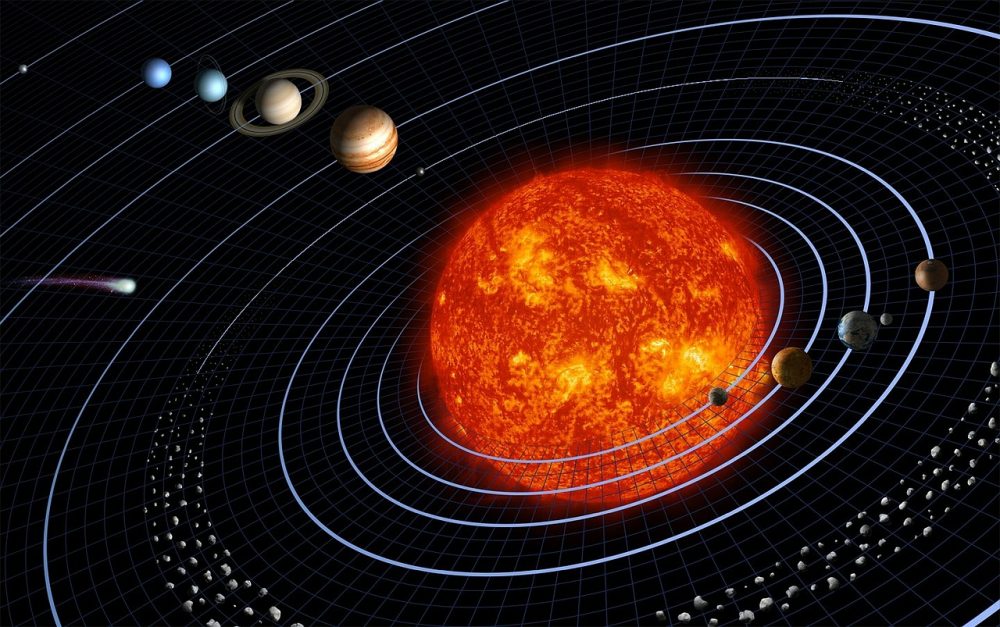
Why space research? The universe is replete with worlds apart from the planet earth. From our historical ancestors discovering fire to modern man exploring space, inquisitiveness has been vital to the innovation and exploration of our universe, and the survival and advancement of the human species. Space science has become increasingly popular over the years. With the study of outer space and space discoveries piling up by the day, it is essential to be able to write an essay on space. Writing on any topic about space will require that you are abreast of the latest space discoveries.
Writing a space essay would require that you have a working knowledge of other types of essays that we have described in our previous posts. For example, knowing how to write a descriptive essay will help in an article on the study of objects in space, while knowledge of how to write an argumentative essay will come in handy when writing an essay on controversial space topics. If you’re not sure you can do all this on your own, get college thesis writing help .
Coming Up With Great Space Topics
Space race topics, space research topics, space exploration topics, space topics for presentation, controversial space topics, earth and space science topics, astronomy research paper topics, astronomy essay topics, space arguable research topics, space science investigative essay topics.
Before writing an article on space study, you need to choose the right space topic. Choosing appropriate space topics is critical to the success of your space essay as the right topic will give you the luxury of a better flow of ideas. For this reason, we have crafted 80 topics about space that will make writing a space essay easy. You can never get bored while working on these interesting space topics because you will learn to explore and study space as you’ve never done before. These 80 cool space topics will come in handy in any space essay you plan to write.
Writing a space race essay is an excellent place to start if you want to explore the events that lead to the explosive growth of the space industry. The space race was a competition between the United States and the Soviet Union to attain the capability of space flight from the period of 1955 to 1975. If you’re interested in going back in time to tell these space stories uniquely, these space race topics will surely land you on the moon!
- The 1955 Space Race: Its Pros and Cons on the Rival Countries.
- The 1955 Space Race: Its Enduring Impact on Modern Space Technology and Travel.
- The 1955 Space Race: A Battle for Supremacy.
- How the Space Race Transformed America.
- The 1955 Space Race: The reason the Soviet Union lost to the USA.
Space research has become popular over the last decades. It is an extensive research field that seeks to study outer space scientifically. Research topics about space are relatively easy to find considering the broad research areas, which include: Earth observations, Geodesy, Atmospheric Sciences, Space physics, Planetology, Astronomy, Materials sciences, Life sciences, and Physics. Space research paper topics must stimulate and birth inquiry and answer compelling questions. Are you ready to get on the space shuttle? Here are some space research topics to help you!
- 2000 – 2010: A successful Decade in Astronomy?
- The Theory of Relativity in Space.
- UFOs and Extraterrestrials: Fact or Fiction?
- Space Colonization: Reasons, Goals, and Methods.
- Big Bang Theory: The Birth of the Universe?
Space exploration is the investigation of outer space with the use of space technology and astronomy. While the study of space is carried out mainly by astronomers with telescopes, its physical exploration is carried out by both robotic space probes and human spaceflight. Writing a space exploration essay opens your imagination to the wonders of outer space. You sure need to be ready for the unexpected! Here are some space exploration topics to whet your adventurous appetite!
- The Need for Continuous Space Exploration.
- Space Exploration: Differences between the then and now.
- Space Exploration: Its Importance to the Knowledge of the Earth and Universe.
- Space Exploration: Operations and Future Exploration Plans.
- The Importance of Unmanned Space Exploration.
Giving a presentation or seminar on space could be quite dicey. It requires that you can make complex phenomena appeal to the mind of your listeners. To be able to do this, you need to have a considerable amount of knowledge in any of the space science topics that you choose. A tip will be to choose topics that your audience will easily relate to, prepare adequately, and remember that you’re communicating with earthlings. Here are some space topics for a presentation that will earn you the respect of the extraterrestrials!
- The Earth and Universe.
- Getting the Big Picture from the Study of Dwarf Galaxies.
- History of Astronomy: A scientific Overview.
- What Exists in Space beyond our Solar Neighborhood.
- Future Space Missions: A look into what they should be.
Something as big as space study does not come without its controversies. Space exploration and travel are not without their risks and benefits. Many believe that robots, instead of humans, should man shuttles for space travel because of the risk space travel poses to humans. Many people also see space study as a sheer waste of time and resources and think it better to channel these vast amounts of money to more critical areas like health and education. All these different views and more, are what make space study a controversial topic. Here are some controversial space topics that will give you a hang of what to discuss in a space-related debate. Some of these topics could also be helpful in a space travel essay.
- Space Travel: At the Expense of our Health, Earth, and Future?
- Space Travel: A thing for Robots or Humans?
- Space Research: A Pointless Adventure and Waste of Resources?
- Earth and the Search for Other Habitable Planets.
- Science Versus Religion: The Big Bang?
Earth and Space Science or ESS, for short, connects systems by exploring the interrelationships between the land, atmosphere, ocean, and life on Earth. These include the water cycle, carbon cycle, rock cycle, and other materials that continually influence, shape, and sustain the earth. Here are some new earth and space science topics just for you!
- The Interactions between Weather and Climate.
- The Process of Rock Formation and Erosion.
- Plate Tectonics: An In-depth Exploration.
- Natural Catastrophes: Its consequence on the Ecosystem.
- The Moon and Sun: Effects on Ocean Tides.
There are two fields of study in carrying out astronomical research – the observational and theoretical fields of astronomy. Observation primarily deals with the study and monitoring of actual celestial objects in space like stars, planets, moons, and asteroids.
Theoretical dwells more on creating and studying models of astronomy that cannot be observed and haven’t been properly seen. Some astronomy research paper topics include;
- What happens during a solar eclipse?
- What are the major factors responsible for the solar eclipse?
- What should you expect during a lunar eclipse
- What lies beyond our visible universe
- Light and its dimension in space
- The lunar cycle – how does it function?
- Understanding solar system, sun, and the planets
- What is astrophysics?
- What are the different grand unification theories?
- The latitude and longitude of the earth.
- Fast mode, slow mode, and nonlinear effects
Celestial bodies like the sun, moon, other planets, and relatively closer objects in space are examined and comprehensively written upon under astronomy. Examples of astronomy essay topics include;
- How our planet came to exist
- How solar flares occur
- Our solar system, in broad view
- The effect of the moon on our oceans
- How stars are born
- What are the different types of stars in existence?
- Understanding molecular cloud
- How does the universe accelerate?
- Understanding cosmic acceleration and galaxy cluster growth
- Hubble constant and dark energy theories
- Formation, evolution, and destruction of clouds in galaxies
- What is the meridian and transit circle?
The mystery of what occurs inside a black hole is still up for debate, and so are other astronomical events. These form the bulk of space arguable research topics, which discuss things yet to be fully understood. Some space arguable research topics include;
- What is truly beyond the Milky Way?
- What is antimatter?
- Why does space keep expanding?
- How long does it take to travel the space?
- The physics behind a black hole.
- Is earth the most prominent of all the planets?
- How do people who live on other planets survive?
- Is Pluto an official planet or not?
- Should the journey to Mars be opened to everyone?
- What do astronauts eat while in space?
- Is Pluto a dwarf planet?
- A detailed analysis of the 2012 transit of Venus
- What are the best defenses against killer asteroids?
- Interplanetary matter and how to relate it to space activities.
Space is so vast and mysterious that there’s a lot to uncover with events to monitor and investigate. Creating agencies like NASA and the first mission to the moon was born out of curiosity about our place in this vast universe. Some space science investigative essay topics you could present include;
- How does the sun affect our water bodies?
- Where do asteroids come from?
- Molecular Cloud: Molecules, Properties, and Distribution
- How do solar systems with two stars operate?
- Is there an earth-like planet in the nearest solar system?
- Would we ever discover aliens?
- Conducting exoplanet research
- What is interstellar extinction?
- What are the essentials needed for space travel?
- Beyond this realm – understanding extraterrestrial life.
- What is a deep impact mission?
- Understanding the structure of the solar chromosphere.
- An analysis of the Wilson-Bappu effect
- What is a color index?
So here we are! 80 awesome space topics absolutely for free! Hopefully, you’ve got the perfect topic for your assignment or project. Keep shining like the star that you are! If you need more ideas, please check the following graduate project ideas .
Leave a Reply Cancel reply
- Core Beliefs
- A Commitment to a Powerful Story
- Embraced Pedagogy
- Learning Community Model
- Full News Archive
- Testimonials
- Student Spaceflight Expts Program
- Voyage National Program
- Family Science Night
- Journey Through The Universe
- To Earth and Beyond
- MESSENGER Educator Fellows
- Videoconference with Astronauts
- Compendia of Lessons
Presentation Topics
- Engaging Reading
- Clarke Institute
Center Director, Dr. Jeff Goldstein after a Family Science Night presentation attended by over 600 in Muncie, Indiana, gets swarmed by children. Click for Details
The Center’s staff researchers have given thousands of presentations to diverse audiences—students, families, teachers (at conferences and workshops), and the general public. The hallmark is audience participation, and the topics addressed span the Earth and space sciences. The central objective is to develop conceptual understanding of the universe around us by building bridges to the familiar—using the power of models .
Provided below are descriptions of presentations by our staff which were developed for Family Science Night at the Smithsonian’s National Air and Space Museum and for Journey through the Universe . Presentations are available for communities nationally through To Earth and Beyond . Read comments from attendees of our programs.
In addition, presentations in classrooms by the Journey through the Universe Visiting Researchers—a National Team of scientists and engineers from research organizations across the nation—provide a personal view of scientific research, and are crafted by the presenters to dovetail with the local curriculum.
Sample descriptions of presentations by the Center’s staff—
Public and Family Programs; Keynote Addresses for Professional Development Events; and Keynote/Featured Addresses at Conferences
A Voyage that will Forever Change Your Perspective of Home When we venture beyond our home and explore a greater landscape—whether it’s the town beyond our house, or a planet beyond the Earth—we gain a deeper sense of our own existence. It’s a fundamental principle of exploration. To truly know and appreciate our home, we must leave it. So to truly know and appreciate a place called Earth, we must venture beyond it, and recognize the breadth and majesty of a greater universe.
From another vantage point—we are integrally connected to the universe, and it to us—so to know the universe is to know ourselves. And while we may seem small in its shadow, beauty has nothing to do with size—for the universe is revealed with something the size of the human mind.
You’re invited to the story of our existence—a race of explorers, 6 billion tiny souls strong. It is a story that ignites wonder about the universe, and a sense of pride in our ability to reveal its nature through both human imagination and ingenuity. It is a story that humbles us, and brings a sense of humility to our lives. It is a voyage that will forever change your perspective of home.
Focus: inspiration to young and old—a wonderful family program; understanding the nature of our existence using the power of models
Celebrating the Past, Embracing the Present, and Inspiring the Future We live in a moment in time. It’s the place where the accomplishments of those that came before us meet up with what will be undertaken by future generations. It’s a great place to be, especially if you’re part of the future generation. By learning about the past both in terms of what we know and how we’ve come to know it, and talking to those that work on the frontiers right now, you can choose to shape the future. It’s pretty powerful stuff. You are the link between the past and the future.
Focus: inspiration for students; scientists and engineers as heroes and role models
Human Exploration—the Journey Continues A wondrous look at who we are as a species and what drives us to the great frontiers.
Throughout history, humans have been space explorers. For thousands of generations we have looked to the sky and wondered about our place in the cosmos. Yet it was only 400 years ago that we first improved our view with telescopes. And only within the last 50 years have we become true spacefarers, able to travel beyond Earth’s atmosphere with robots and humans.
Standing on the shoulders of past generations, we have done remarkable things in our time. On July 20, 1969 we walked on the Moon. Today, peoples of the world are working together to build a space station—a research laboratory placed 200 miles above the surface of our world. Through the eyes of robots we’ve seen sunset on Mars, volcanoes erupting on a moon of Jupiter, and the awesome majesty of Saturn’s rings. With telescopes on the ground and in space we have seen the birth of other suns, found solar systems beyond our own, and have traveled back in time to see the universe as it was billions of years ago. We humans have even sent four spacecraft beyond Pluto en route to the stars with greetings from Earth aboard. Look what we have done!
Journey to the frontiers of flight in air and space to see how far we’ve come and what awaits the next generation!
Focus : the nature of human exploration ; history of space exploration
The Art of Science (for educator conferences)
Science is an art , and researchers are artists. Fundamental to science research is the explorer’s ability to ask questions, frame a pathway to an answer, and interpret what they find. It requires a deep understanding of core knowledge , which includes both core factual information and key concepts. It also requires an artists approach to critical thinking , where finely honed skills over time allow you to see a possible pathway from question to answer through the complex noise of the universe around us. This describes a process by which we can explore. It is the application of this process by the scientist or engineer that is the art.
Absolutely fundamental to an understanding of: core factual information and key concepts; the means to frame a possible pathway to an answer; and interpreting what one has found—the new knowledge , is finding ways to relate all of this to what is familiar. That is the function of models , and there are many different flavors of them. Put another way— models are arguably the most powerful tools in an explorer’s toolbox . Focus: the process of scientific inquiry; the power of models.
Presentations for Schools and School Districts
A Picture’s Worth a Thousand Words Did you ever wonder how a camera creates a photograph? Did you ever stop to think about the enormous amount of information a single photograph contains? For instance, the sizes, shapes, and colors of an object in an image can tell us a lot about its composition, even its origin. We can even take pictures in flavors of light that our eyes cannot see! We explore our entire universe through images. We’ve even sent cameras to other planets. Let’s use images of the planets through history to explore what we can learn through imaging science. Focus: imaging technology used for scientific research
How Big is Big? It’s a big, often intimidating universe out there. How do we even begin to fathom objects and distances that dwarf anything we’ve ever experienced? Earth’s place in space is knowable. The secret is placing the universe in a context that is familiar. Take a magical journey from spaceship Earth to points unknown. Focus: understanding the universe using models
Asteroids and Comets! Look up in the sky–it’s a bird, it’s a plane–why no it’s a rock. A big rock! And wasn’t that a snowball the size of city that just flew by? Visit some of the asteroids and comets in the Solar System, and see how these objects have affected life on Earth. Focus: small bodies of the Solar System
Fifty of Your Very Own Look up on a starry night far from city lights. What you’re seeing is but a tiny portion of the Milky Way, our home galaxy. Our Milky Way is a vast and swirling mass of 300,000,000,000 suns, enough to give 50 to every person on Earth! Come explore the different neighborhoods of the Milky Way, and gain an understanding of our home world’s place among the stars. Focus: the universe beyond the Solar System.
Saying Hi to E.T. on a Planet Far, Far Away Wouldn’t it be cool to talk to an alien? It’s not as far out as you might think. Right now a ‘hello’ from E.T. may be passing through your body as a radio signal! We might just need to point an antenna in the right direction, tune to the right channel, and listen in! That’s exactly what’s we’re doing around the world. Focus: astrobiology, communication
An Expedition to the Top of the World See what it’s like to be a scientist on a research expedition to the top of the world in the pacific. It’s about an expedition to one of the largest telescopes on Earth, atop 14,000 ft Mauna Kea, on the island of Hawaii. The mission: measure winds on other worlds! Focus: the nature of scientific research
© 2021 National Center for Earth and Space Science Education
P.O. Box 2350 Ellicott City, MD 21041-2350
(301) 395-0770 (telephone)
Design by: Drew Roman & WooThemes
A collection of TED Talks (and more) on the topic of Space.
Video playlists about Space

Curator's Picks: Top 10 TED Talks of 2018

The most popular TED Talks of 2018
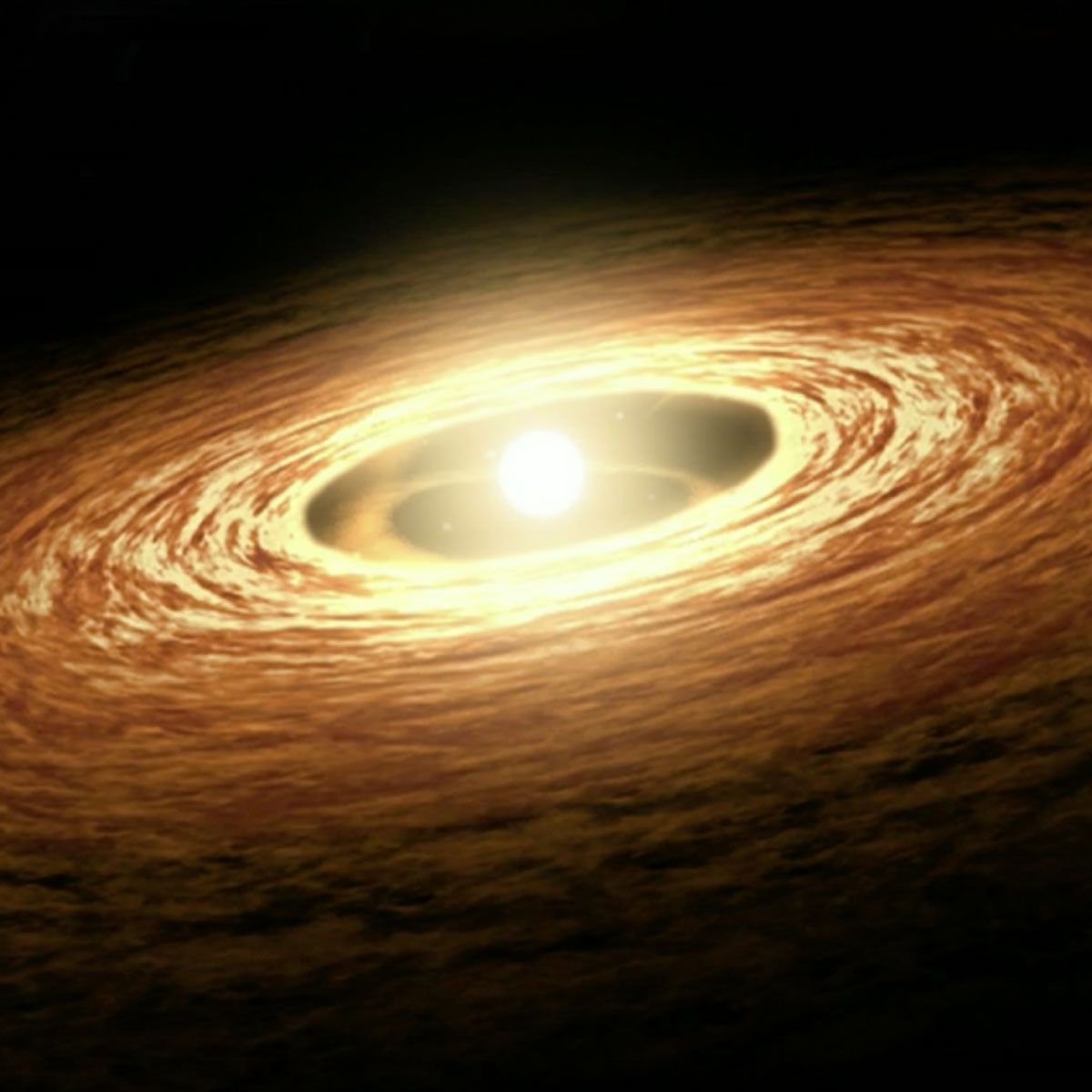
The mystery and wonder of stars
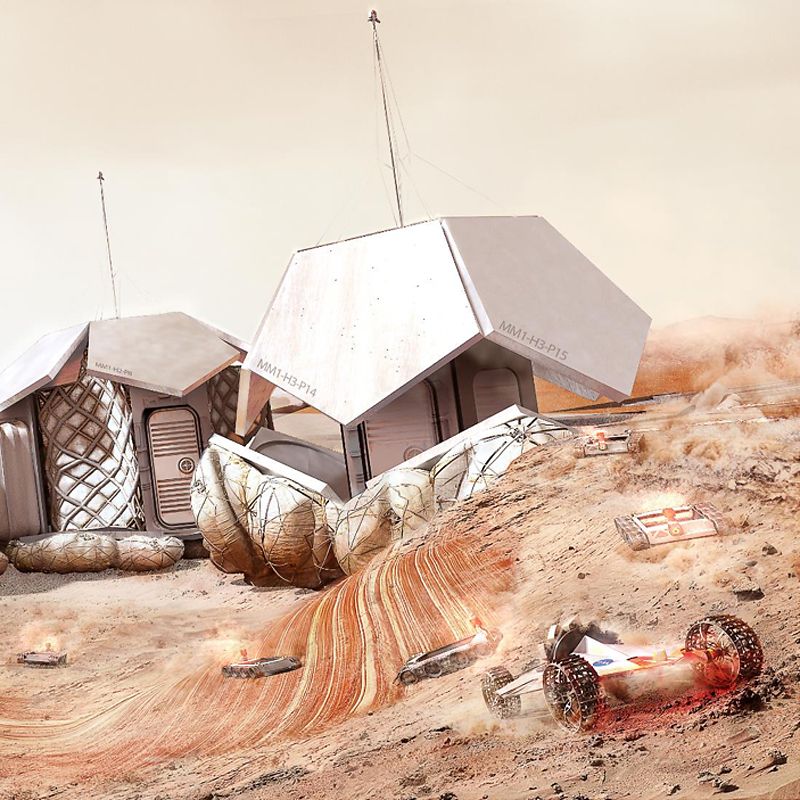
What would it be like to live on another planet?
Talks about space.

How space changes an astronaut’s body

The satellite helping slow climate change — right now

Why are scientists shooting mushrooms into space?

My search for proof aliens exist
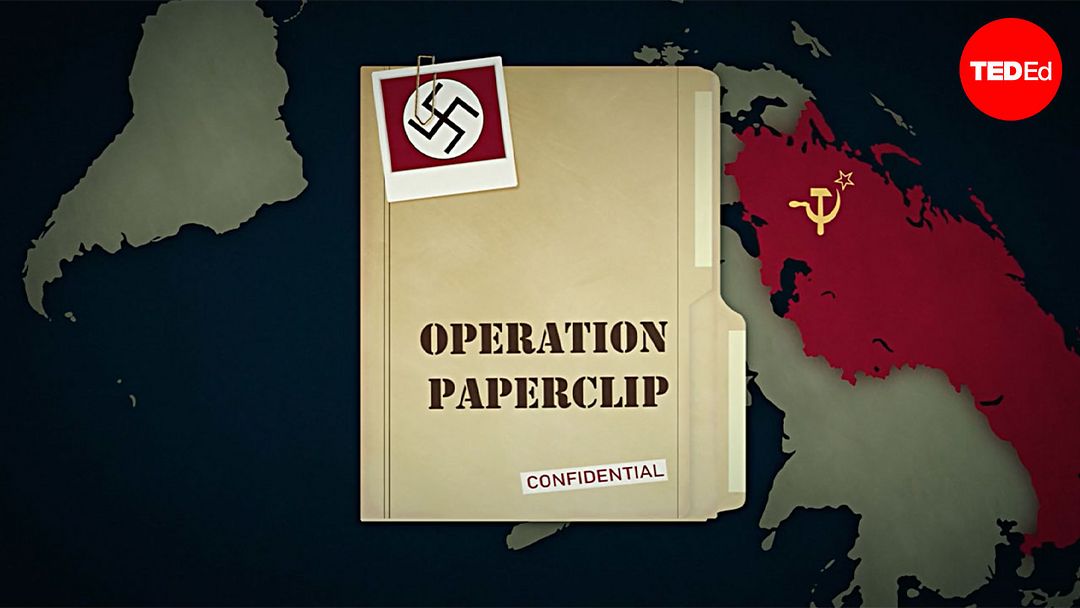
The Nazis recruited to win the Cold War

The aboriginal knowledge stored in the stars
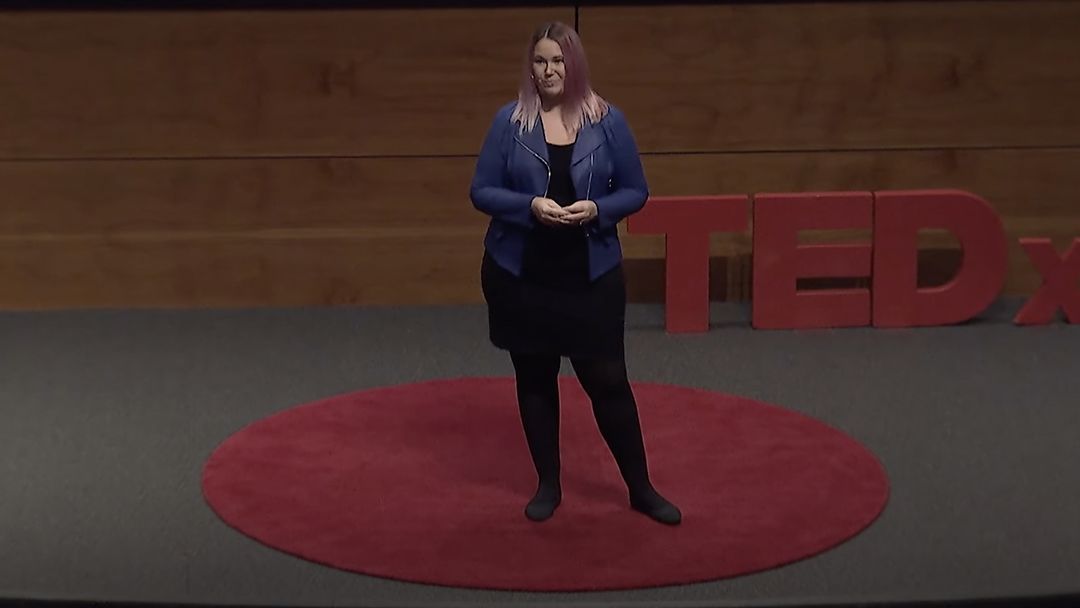
The real-world influence of Star Trek
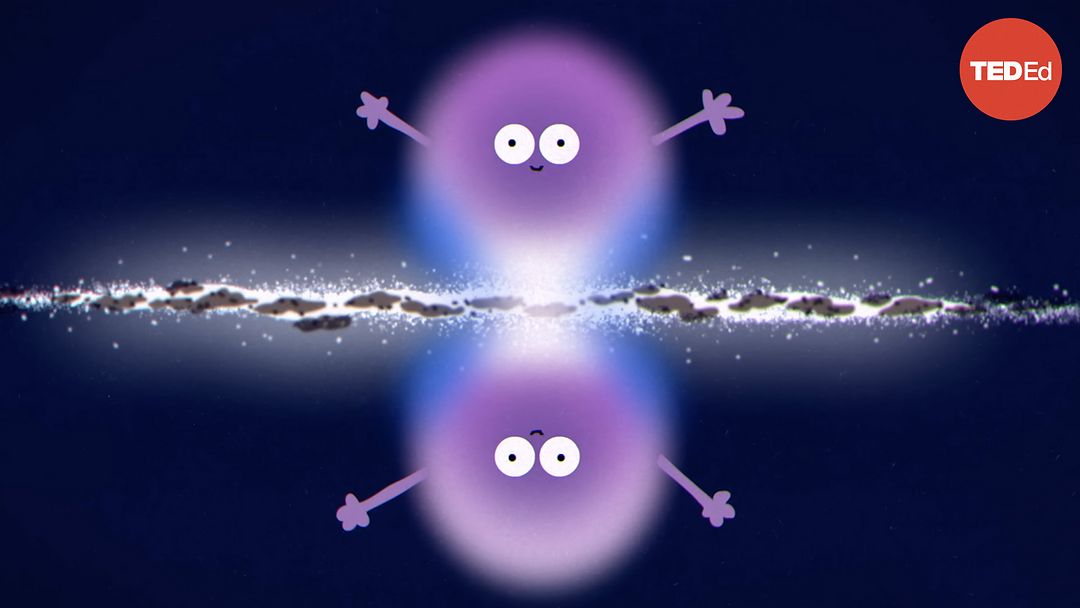
Something weird is happening in our galaxy
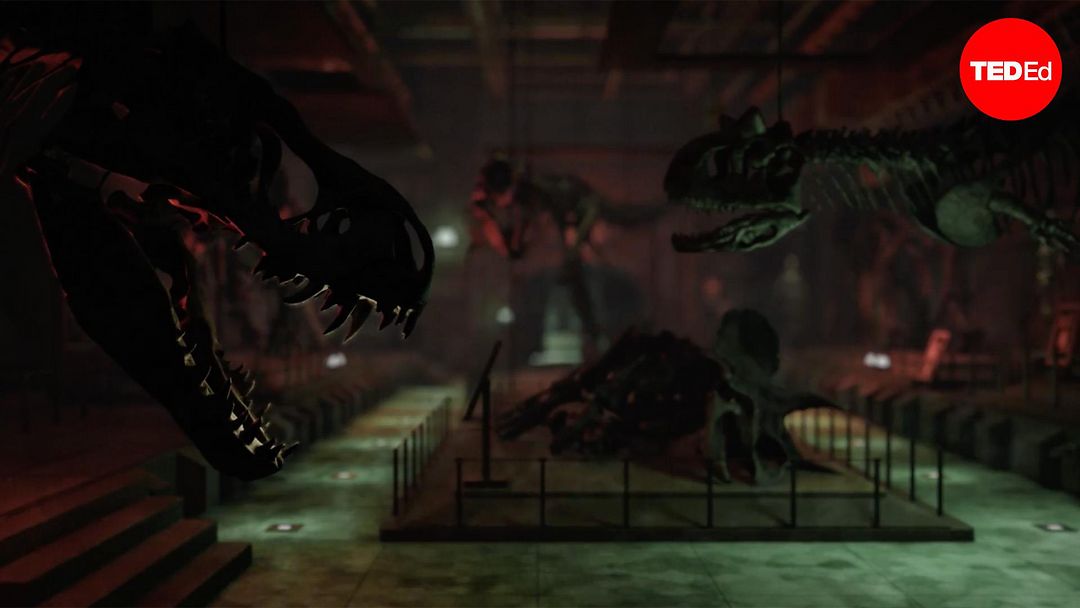
What really killed the dinosaurs? (It wasn’t just the asteroid)

The Encyclopedia of Invisibility — a home for lost stories
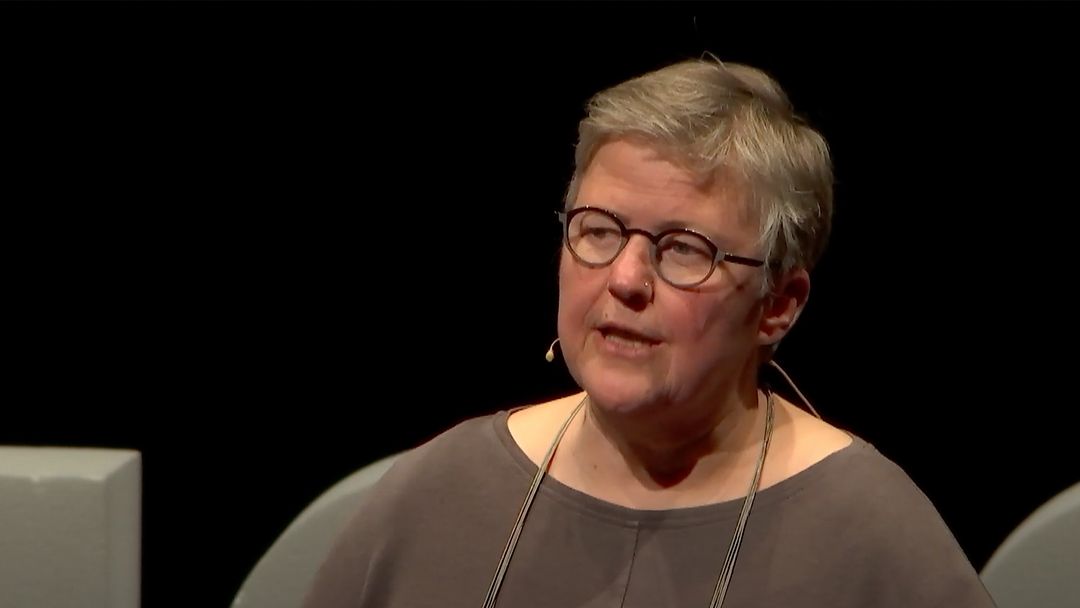
How new drugs could come from space
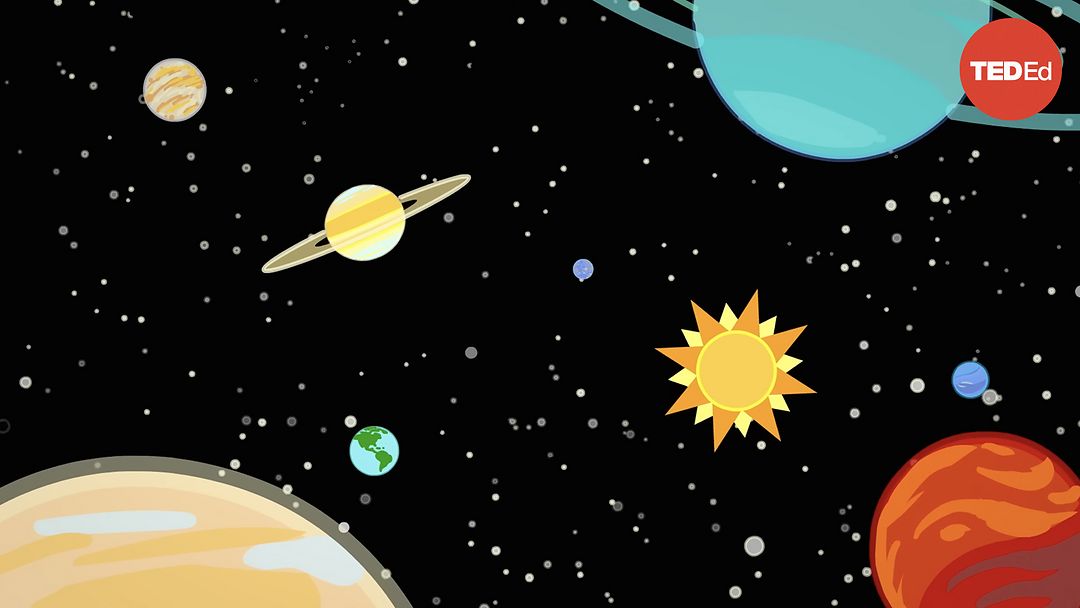
Whoever builds something here will be rich beyond measure

The battle that formed the universe

Why we should search for alien artifacts

The outlaws of the ocean — and how we're reeling them in
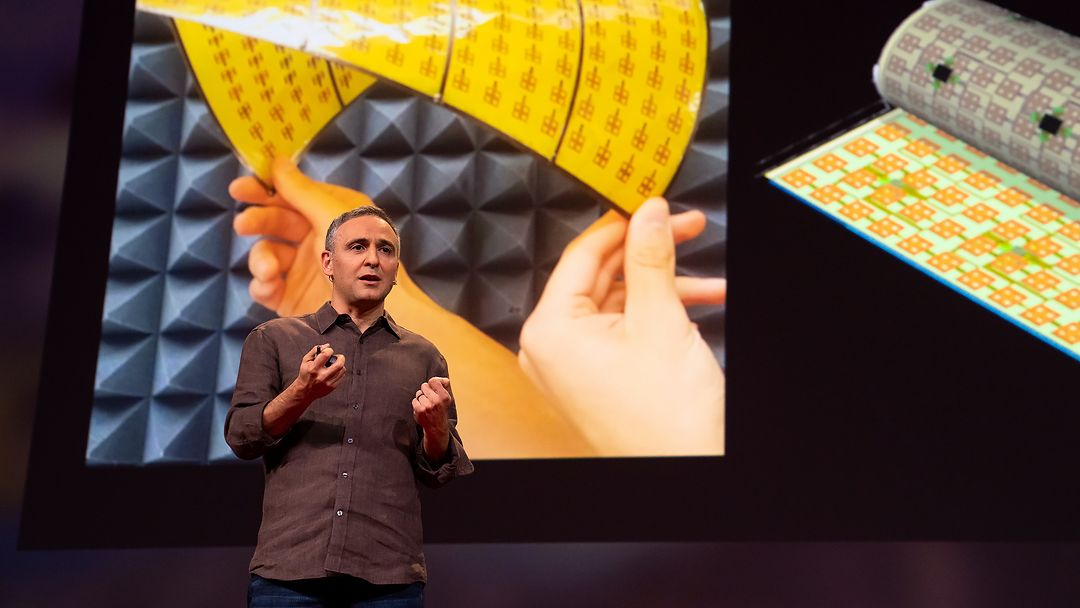
How wireless energy from space could power everything
Exclusive articles about space, the jaw-droppingly high, out-of-this-world carbon footprint of space tourism, a bold step for womankind: meet the young women behind kyrgyzstan’s satellite program, a delightful art project for anyone who’s ever dreamed of living on the moon.

25 Useful Presentation Topics for Science
By: Author Shrot Katewa
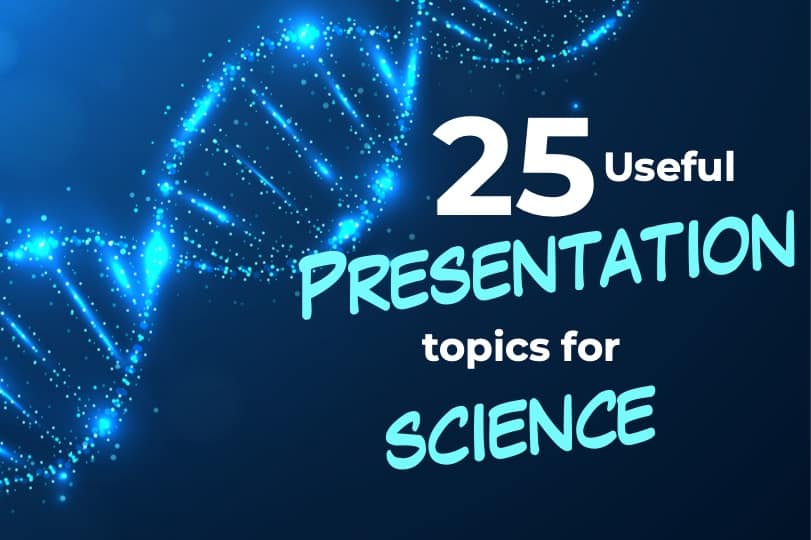
We are mostly asked questions about Presentation Design. But, sometimes, we do have our patrons reaching out to us to seek help with the “content” that needs to be created even before we begin with the design of the presentation.
So, today we are sharing a few really easy-to-cover super useful presentation topics for Science. This is especially helpful for all those teachers and parents who are looking to increase the curiosity of aspiring students and children.
So, let’s dive right into it –
A Quick Note Before We Begin – if you want to make jaw-dropping presentations, I would recommend using one of these Presentation Designs . The best part is – it is only $16.5 a month, but you get to download and use as many presentation designs as you like! I personally use it from time-to-time, and it makes my task of making beautiful presentations really quick and easy!
1. Big Bang Theory – Origin of Our Universe
As a kid, I was always curious about how we came into existence! How the planet Earth was created? How did it all start? This is a great topic to really generate and at times, even quench the curiosity of your students or children. While it is a great topic for presentation in class, it is also an equally good topic for a dinner conversation with your kids.
2. DNA structure
Our DNA is the very core of our life. If the Big Bang Theory is how the universe came into being, DNA is where our personal journey begins. While the structure of DNA is quite fascinating, the impact it has on our lives and how it affects our characteristics is mind-boggling!
It is another great topic for a Science Presentation. Do keep in mind, use of visual aids will most likely improve comprehension and retention among your audience.
3. Gene Editing & Its Uses
In case you choose to go with the previous topic of DNA, Gene Editing serves as a perfect extension of that topic even though it can be a great topic in itself. Sharing insights on Gene Editing and how it works, can showcase the capacity of human endeavors and its resolve to make things better.
4. Important Discoveries of Science
Okay, so this can really be a fun topic. As a kid, it was always fascinating to know about some of the world’s greatest discoveries and inventions.
Be it Penicillium or the first flight by the Wright Brothers, such topics allow you to take your audience on a journey and relive the times in which these discoveries and inventions were made. The thing that I like the most about this topic is that it doesn’t have to be completed in one session.
In fact, this can be turned into a knowledge series of multiple sessions as the list of discoveries is endless.
5. Aerodynamics
Most kids and students are really fascinated with planes. But, only a few really understand the basic principles of how a plane works. Explaining Aerodynamics can be an interesting topic.
It also allows you to introduce props such as a plane and practical exercises such as creating your own plane and analyzing its aerodynamics. The introduction of visuals for such a topic can greatly enhance the learning experience.
So this is a topic that most of the kids and students would have at least heard of, most might know about it a little. But very few would really understand how gravity truly changed our concepts not just on Earth, but also beyond our Planet in our Solar System.
Gravity alone is responsible for the tectonic shift of mindset that the Earth was the center of our Solar System to the fact that the Sun is the center of our Solar System around which the rest of the planets revolve. That and much more!
Explaining the stories of Galileo who first challenged this assumption and how Newton turned everything we knew upside down (almost literally!)
7. Photosynthesis
Another interesting Science topic for a presentation.
How do non-moving organisms produce and consume food? How Photosynthesis is not just limited to trees but virtually drives all lifeforms on Earth through the transfer of energy.
Also, touching upon the fact how Photosynthesis has led to the revolutionary discovery of Solar cells and how it is potentially going to be powering our future.
8. Artificial Intelligence – Boon or Bane
When it comes to Artificial Intelligence, there is a lot that we can do to engage the curiosity of our kids and students. It is an evolving part of Science as we haven’t fully applied and utilized AI.
One of the reasons this can be a great topic is because it engages your students or kids to really think. You may consider forming 2 teams and allowing an open debate on how AI could be a boon or a bane – a great way to promote cross-learning.
9. Ocean – The Unknown World
Our Ocean is what sets our planet Earth apart from the other planets in our solar planet. It is not only one of the main factors contributing to life on earth, the Ocean holds a world of its own with hidden creatures which have only recently been explored.
There is a lot to cover when it comes to the Ocean. Don’t limit your imagination to just lifeforms as you can even talk about treasures troves contained in the ships that sank!
10. Astronomy
So I have a confession to make. Which is this – Astronomy astonished me as a kid, and it amazes me even now! There have been countless nights that I gazed at the stars in the sky in amazement trying to locate a planet, and falling stars and other man-made satellites in the sky.
This is not just an amazing topic for a presentation, but if you could get hold of a telescope for a practical session, it will make a night to remember for the kids and the students!
11. Light and its effects
This is another topic that can turn into a great practical session!
Presentations can be accompanied by a trip to the physics lab or even using equipment like a prism to take the session experience of your audience to a totally different level! Experiencing the various colors that form light is one thing, but understanding how it impacts almost every single thing in our day-to-day activities makes us admire it.
12. Atoms – Building Blocks of Matter
While there is a whole universe outside of our Planet, there is a completely different world that exists when we go granular inside any matter.
There are literally billions and billions of atoms inside just our human body. Each atom has its own world making it as diverse as you can imagine.
How these atoms interact with each other and what makes an atom can be a really engaging topic to bubble the curiosity of the students or your kids!
13. Sound & Waves
Another super interesting presentation topic for Science for kids and students is to understand how Sound works.
There are several things to cover as part of this ranging from simple waves to frequency and resonance experiments. Sound is not just a good topic for a presentation but also for experiments and physical demos.
14. Technology
Technology as a topic has a lot to cover. As we all know that technology touches each of our lives on a daily basis, students can find this topic relatable quite easily. The canvas for exploration and presentation is quite broad giving you a wide range of technology topics to present from.
15. Human Brain
Many believe that we only use 10% of the capacity of our human brain. We have to date only barely managed to understand how our brain works.
Even the parts that we have gathered an understanding about, we don’t quite fully understand. The human brain has remained a topic of astonishment for scientists for a long time. It is only logical to conclude that if presented effectively, this can be a good presentation topic on science.
16. Evolution
When Charles Darwin presented his Theory of Evolution by Natural Selection in his book “The Origin of Species”, it took the world of science by storm.
How the species have evolved over a period of millions of years is quite interesting. There were quite a few interesting learnings that Darwin had and he shared that as a summary. This is something that has been also covered in the TV series Cosmos by Neil Degrasse Tyson.
I highly recommend giving this TV series a watch to get inspiration for some topics for presentation.
17. Magnetism
The majority of the kids have handled and spent hours in awe playing with a magnet. Many try to understand how a magnet really works! But, only a few are able to really understand the science behind it.
Magnetism can be a really fun topic to give a presentation on. Additionally, this topic also allows enough space to display, experiment, and have fun with real magnet and iron filings to showcase the effect of magnetism.
18. Electricity
Electricity is pretty much everywhere.
Today, if there is no electricity, the region is considered underdeveloped or backward. The discovery and the use of electricity is probably one of the greatest inventions of the 20th century.
It has been single-handedly responsible for industrialization, powering growth, and the development of the human race.
19. Steam Engine
Steam Engine was the first step of the human race towards powered locomotives.
From the discovery of the steam engine to how it was responsible for creating a time standard and time zones along with the stories related to it, can all be very fascinating and take you back in time to relive history!
A perfect presentation topic for science students.
20. Science of Medicine
No list of presentation topics for Science would be complete without mentioning medicine and its benefits.
The discovery of medicines and drugs has been responsible for nearly doubling the average human age. The impact is far-reaching with several pros and cons that constitute an interesting topic for presentation.
21. Periodic Table
Students often find this topic very dull. However, if you can help them understand the beauty and significance of this periodic table, it can be an amazing topic.
To really understand how Mendeleev could predict the existence of various elements even before they were discovered, is mind-boggling!
The periodic table is such a perfect table that explains how the elements are arranged in a well-structured manner in nature. This topic can be turned into a very interesting topic but a bit of effort and some out-of-the-box thinking may be required.
22. Buoyancy
Okay, so we all may have heard the story of Archimedes in a bathtub and how he shouted “Eureka” when he managed to solve the problem that was tasked to him. He did this using the Buoyancy principle.
While this story is something we relate to buoyancy the most, there is a lot more than we can truly learn and apply using this principle. This can be a very helpful topic for a presentation as well as a practical science experiment.
23. Health & Nutrition
Health & Nutrition is a very important aspect of our life. Its importance is often not completely understood by kids and students alike. Presenting about Health & Nutrition can go a long way to benefit the students to maintain a very healthy life!
24. Our Solar System
Our Solar System is a topic that is mostly taught since you join the school.
However, while most of us know about our solar system, there are enough mysteries about it to capture and captivate the attention of your audience. Questions like – why is Pluto not a planet anymore?
Or other questions such as – are we alone in this universe or even topics around the Sun as a star or even the asteroid belt between Mars and Jupiter can all lead to great engaging presentations and discussions.
25. Stem Cell
Stem cell research has become cutting-edge medical research. Thus, it is often a hot topic for discussion but is often not completely understood.
This topic will also provide you an opportunity to engage your audience in a debate that could be centered around the ethics of stem cells and their application.
This is a perfect topic as this allows your students or kids to learn and share their opinion with others.
Science is a vast world. Even though there are several other topics that can be covered, we decided to list topics that are relatively common such that it widely applies to a large set of people. If you have shortlisted your presentation topic and are looking for help to create a visually appealing presentation that captures the attention of your audience, be sure to reach out to us!
Our goal on this blog is to create content that helps YOU create fantastic presentations; especially if you have never been a designer. We’ve started our blog with non-designers in mind, and we have got some amazing content on our site to help YOU design better.
If you have any topics in mind that you would want us to write about, be sure to drop us a comment below. In case you need us to work with you and improve the design of your presentation, write to us on [email protected] . Our team will be happy to help you with your requirements.
Lastly, your contribution can make this world a better place for presentations . All you have to do is simply share this blog in your network and help other fellow non-designers with their designs!

17 Presentations on Space

From Life Beyond Earth to Communities on the Moon
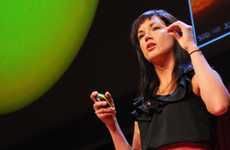
Got any suggestions?
We want to hear from you! Send us a message and help improve Slidesgo
Top searches
Trending searches
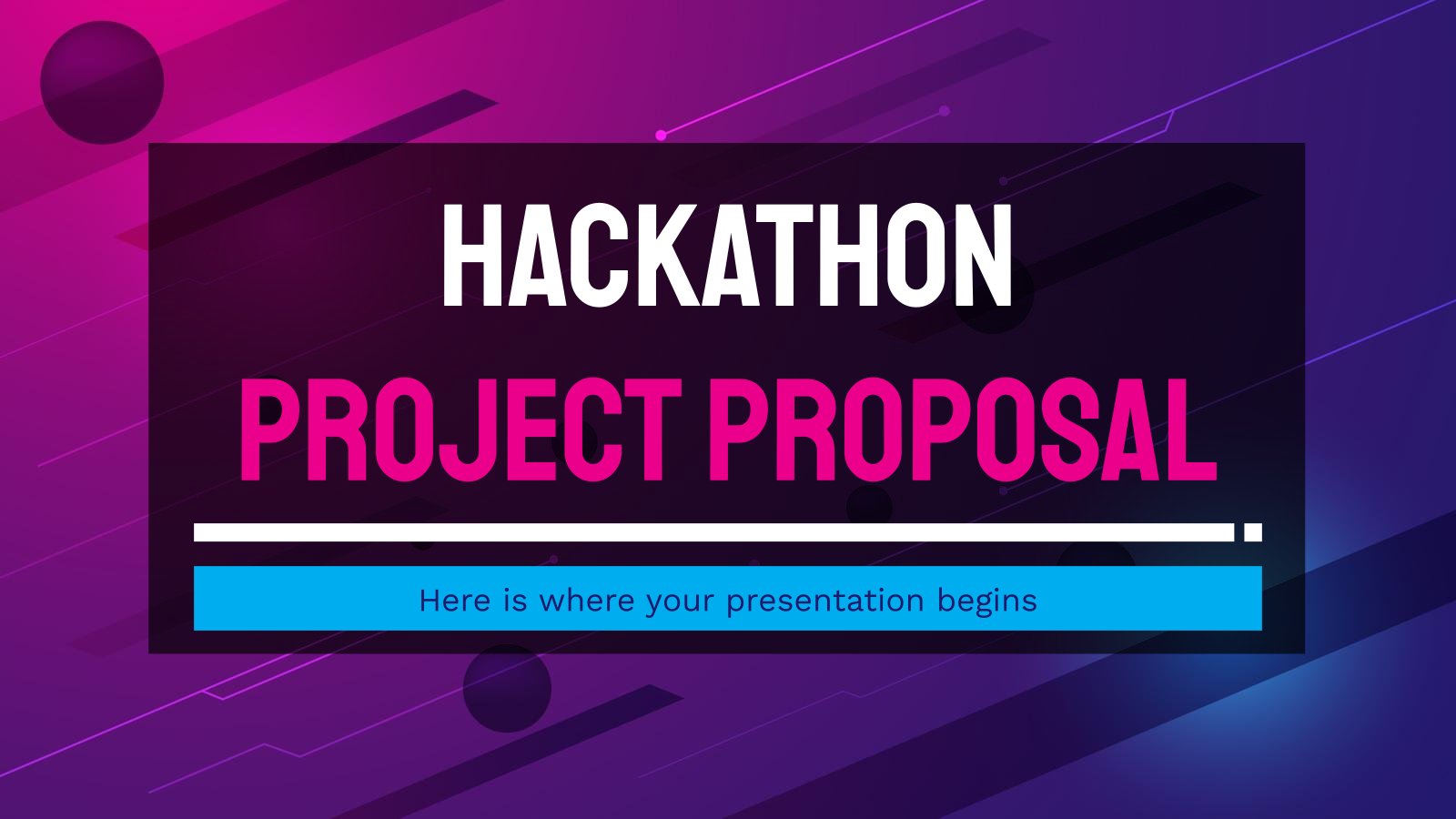
35 templates
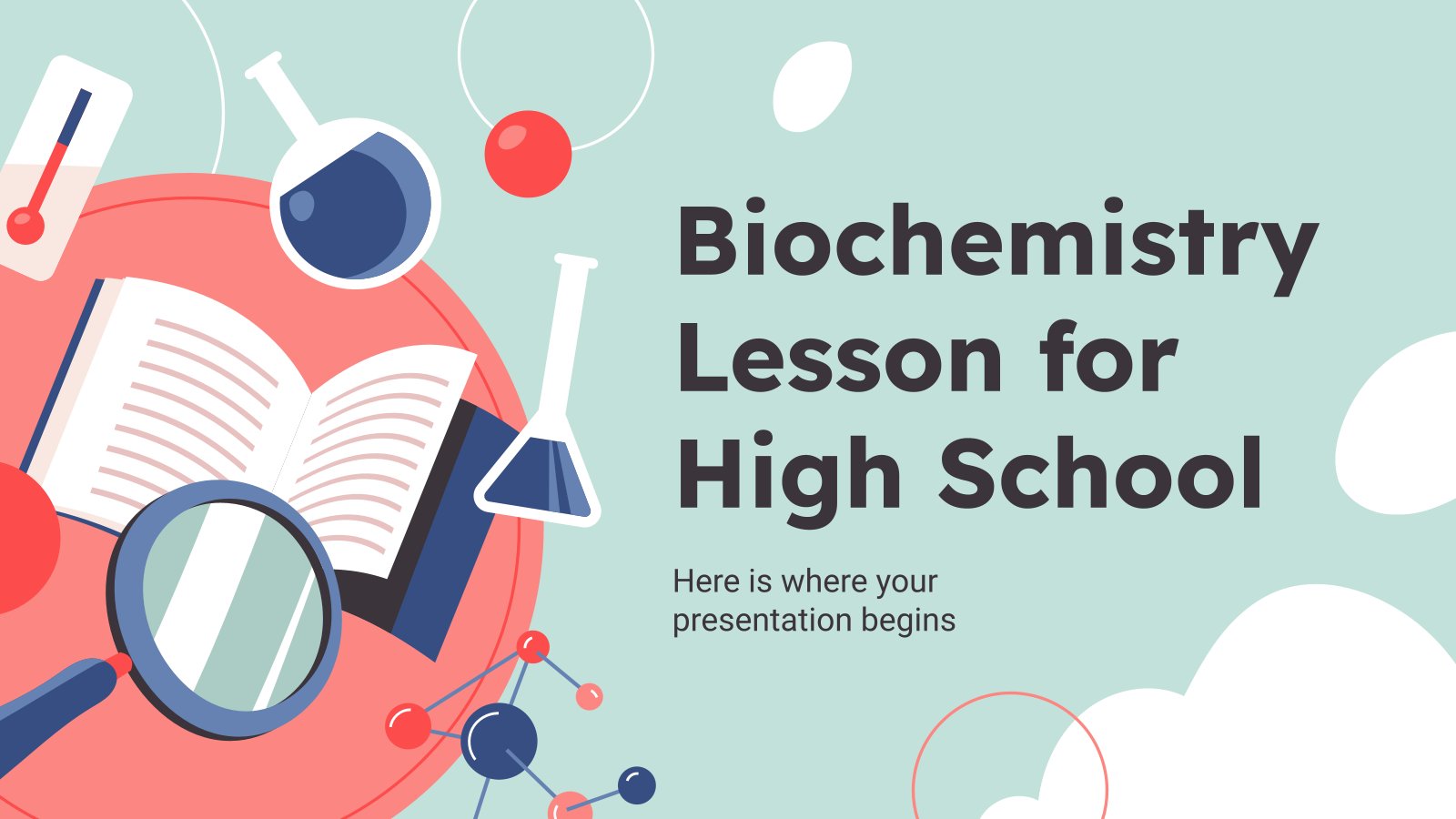
biochemistry
38 templates

hispanic heritage month
21 templates

travel itinerary
46 templates

mid autumn festival
18 templates
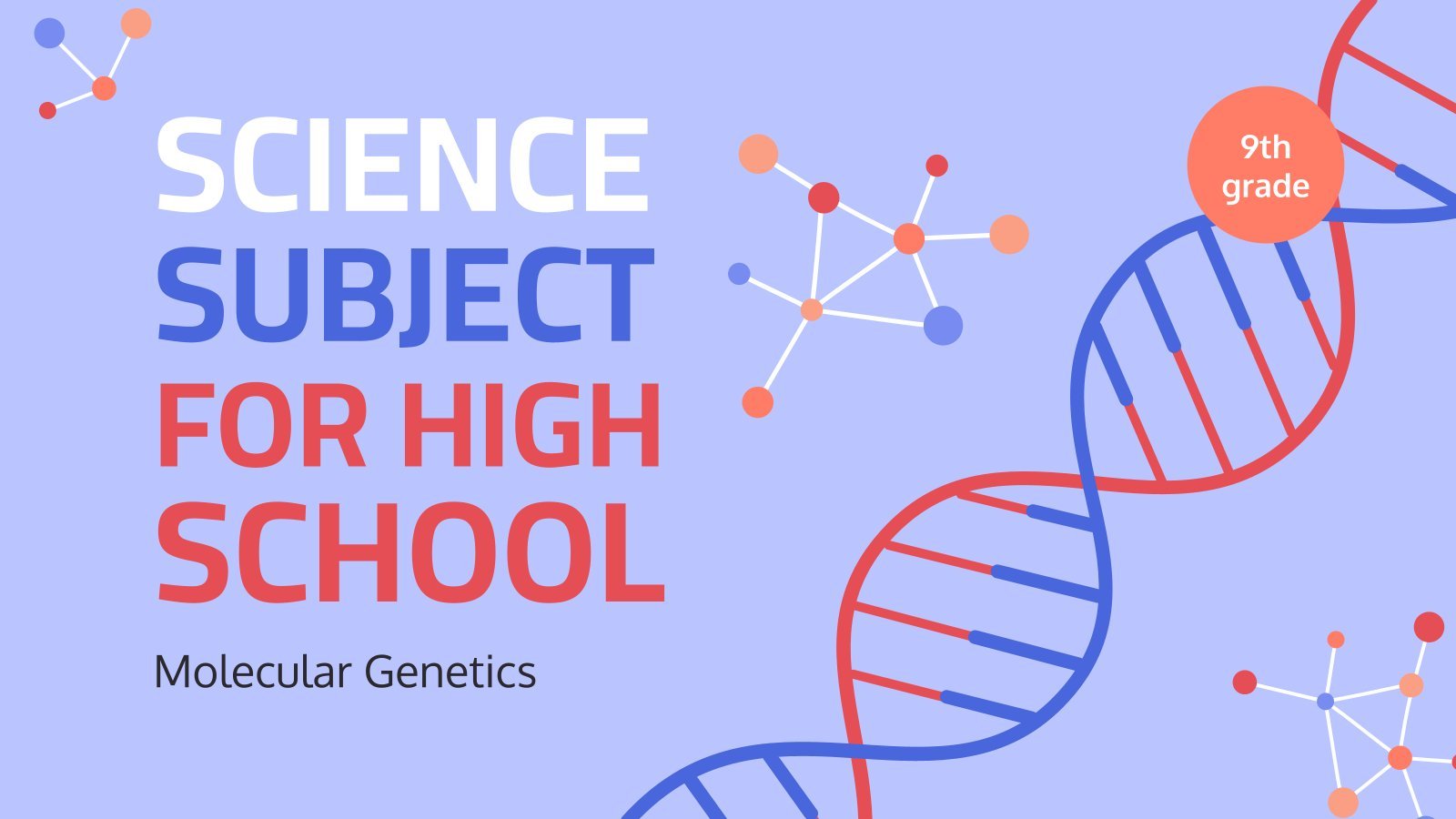
63 templates
Space Presentation templates
The slidesgo rocket is about to take off get on it to discover everything in outer space: galaxies, planets, stars, satellites and amazing google slides themes and powerpoint templates to use in your space presentations..
- Calendar & Weather
- Infographics
- Marketing Plan
- Project Proposal
- Social Media
- Thesis Defense
- Black & White
- Craft & Notebook
- Floral & Plants
- Illustration
- Interactive & Animated
- Professional
- Instagram Post
- Instagram Stories

It seems that you like this template!
Premium template.
Unlock this template and gain unlimited access

Register for free and start downloading now
Multi-space theme for may.
If you like movies about the galaxy you will love this proposal that we bring you today. It is inspired by the famous movie and has a dark background with illustrations of robots, planets, etc. The typography of the titles is especially striking, sans serif and futuristic style, very consistent...

Science Subject for Elementary - 3rd Grade: Universe
You know us... at Slidesgo we are big fans of the planets, the galaxy and the universe. So, of course we have a science lesson template about the universe! Download this presentation to organize your elementary school science class and all your students will learn the order of the planets...
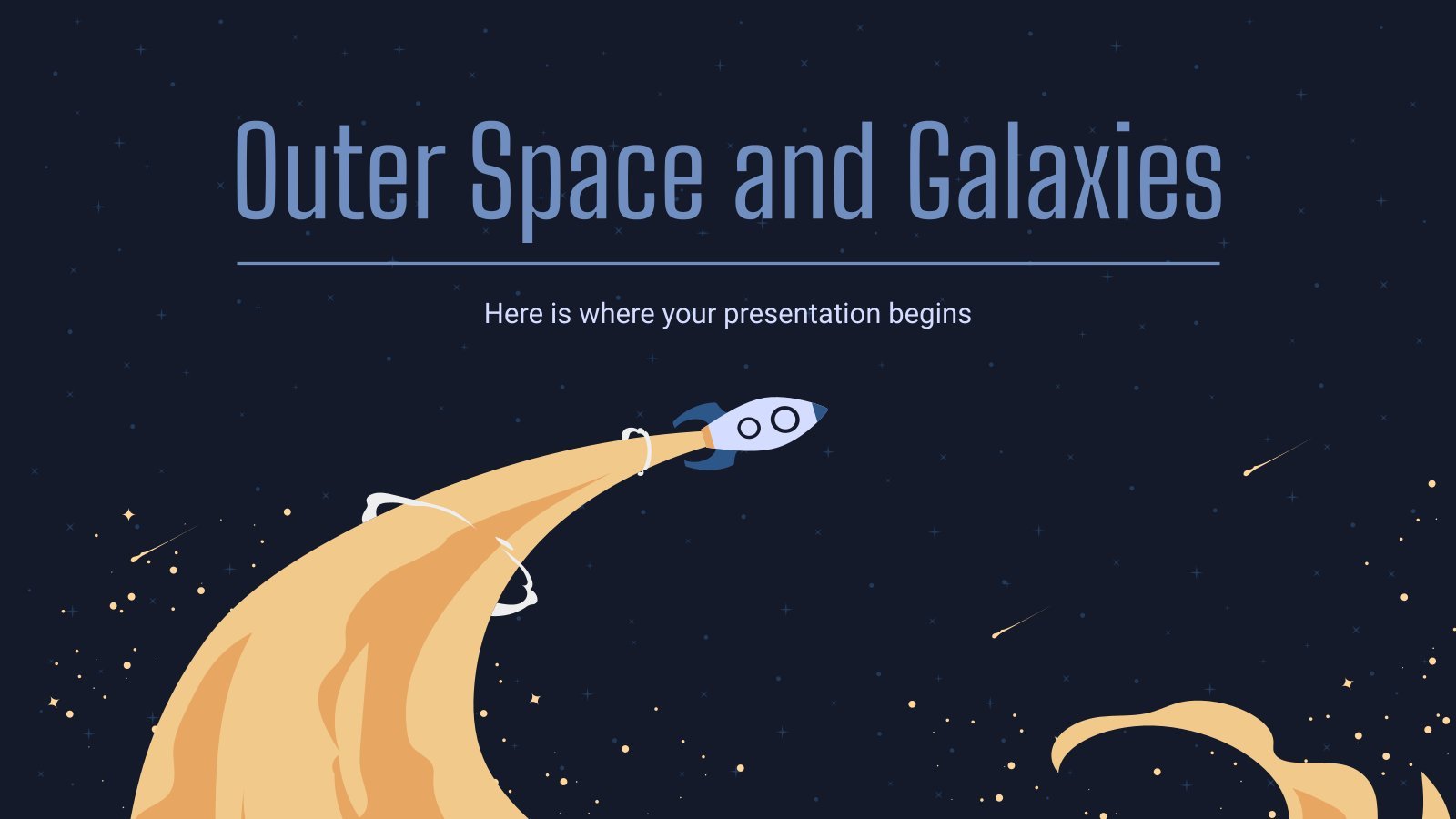
Outer Space and Galaxies
Slidesgo always aims high, as high as the space! This new template is an ode to planets, the galaxy and outer space. All illustrations are in-theme, and every single infographic, graph or timeline has planets integrated into them in one way or another. We think the result is very cool!

Outer Space
Take your audience to outer space—not literally—with this new template. There are timelines, graphs and mockups that can help you highlight essential data.
Elegant Galaxy Background Breakthrough
Is there a new breakthrough in the field of medicine that you think it should be divulged to the entire planet, or even the galaxy? Perhaps it's an exaggeration, but here you have a new template with a galactic theme. You can lay out the results of the test, the...
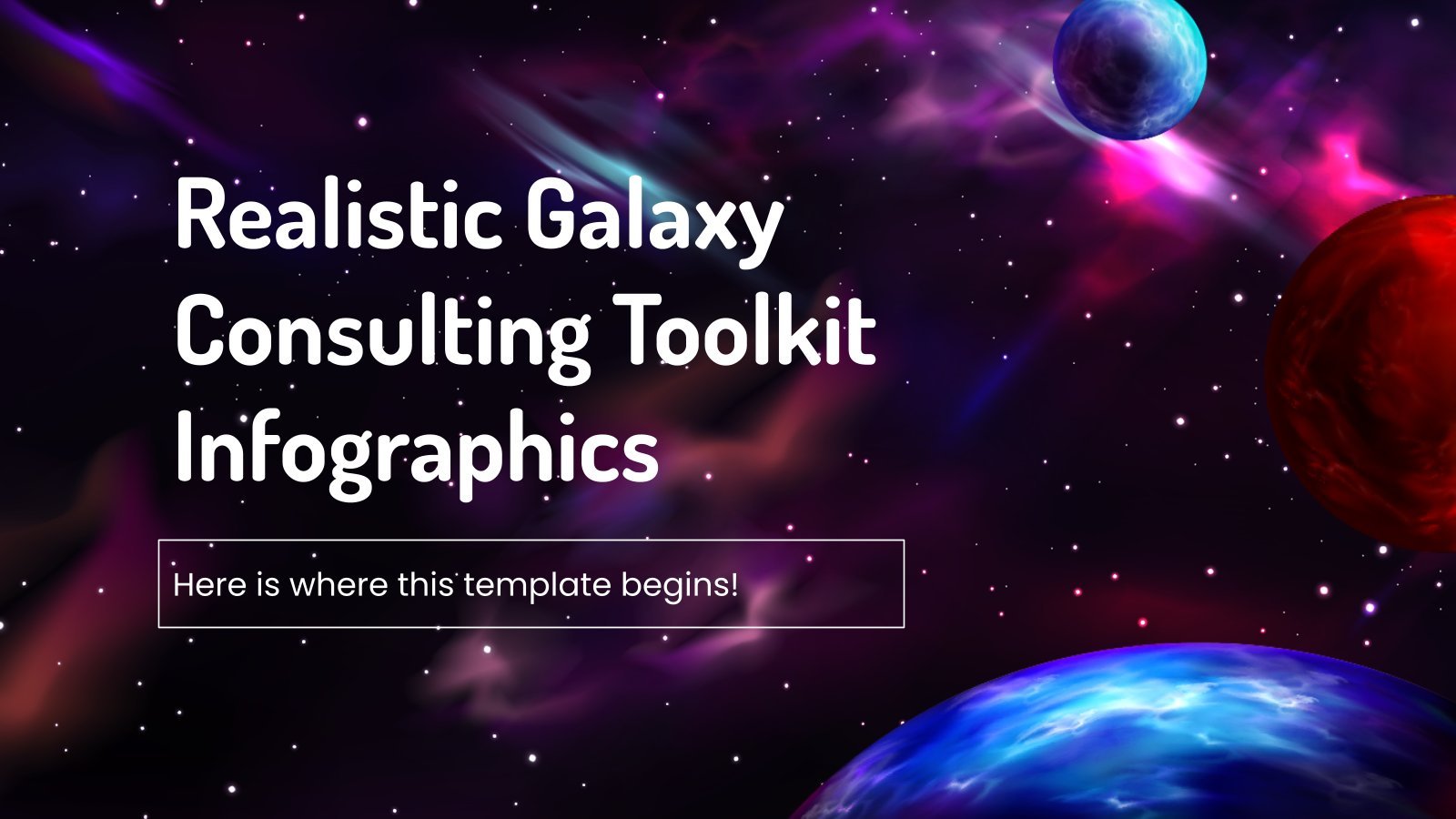
Realistic Galaxy Consulting Toolkit Infographics
Pink, purple, blue and a galactic backdrop of stars and planets… what’s not to love? This collection of infographics has been designed to complement our “Realistic Galaxy Consulting Toolkit” presentation, and equips you with tons of visuals, from maps to timelines, graphs and tables to present every aspect of your...

Space Studies Thesis
Time to defend your thesis on planets and stars! We have just created a presentation with many illustrations that is perfect for you. Provide some info about your objectives, methodology, results and conclusions and show your data using timelines or pie charts.

Galaxy Gradient
Let your imagination fly and bring your ideas to a new universe with this template from another galaxy, where every single detail will make your data shine like the stars.
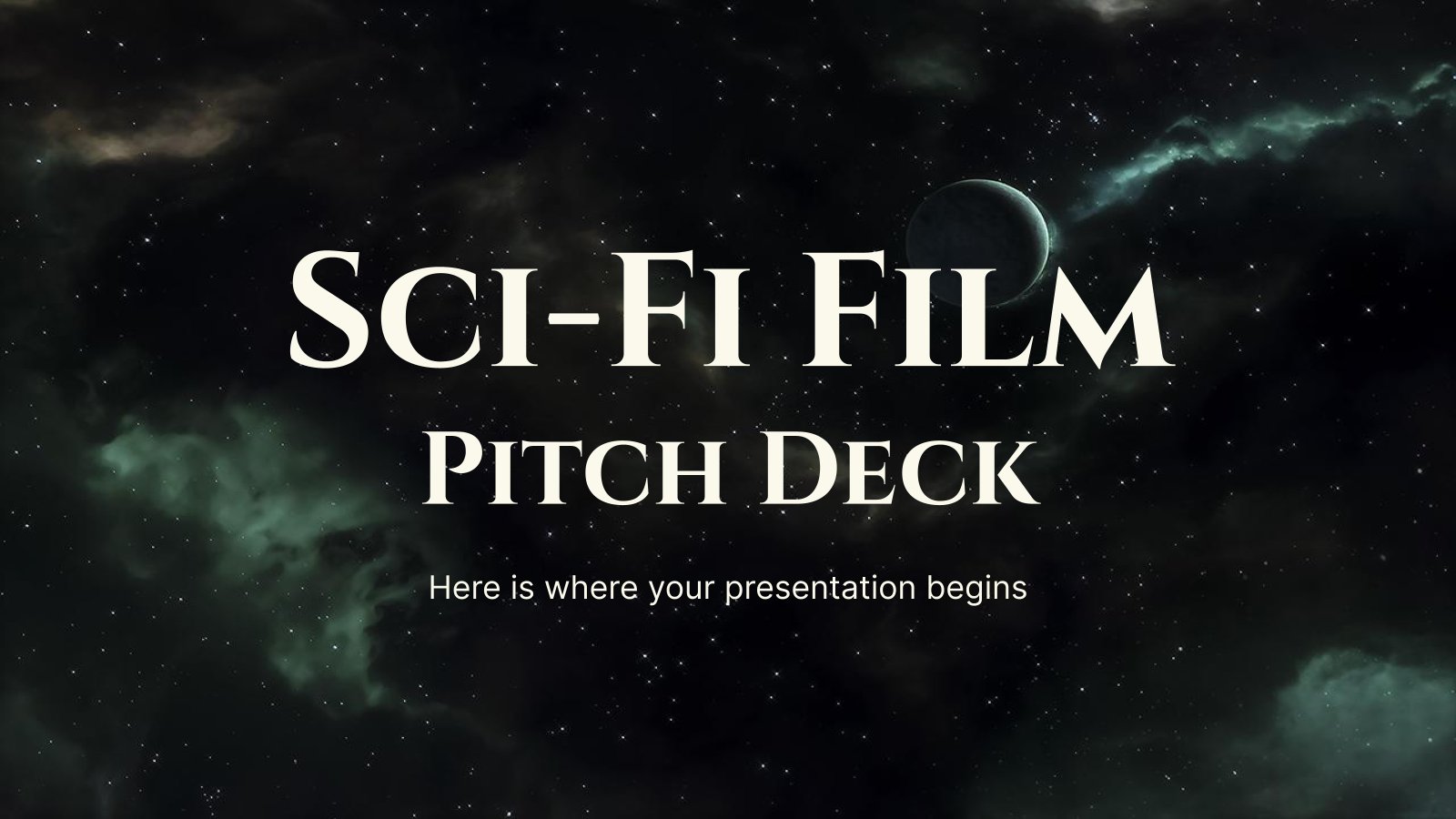
Sci-fi Short Film Pitch Deck
Can you see yourself already parading down the red carpet and rubbing shoulders with big names in cinema? No wonder with a project like yours! If you've been chosen to prepare a pitch deck about the new sci-fi short film that will revolutionize cinema, download this template, its backgrounds taken...
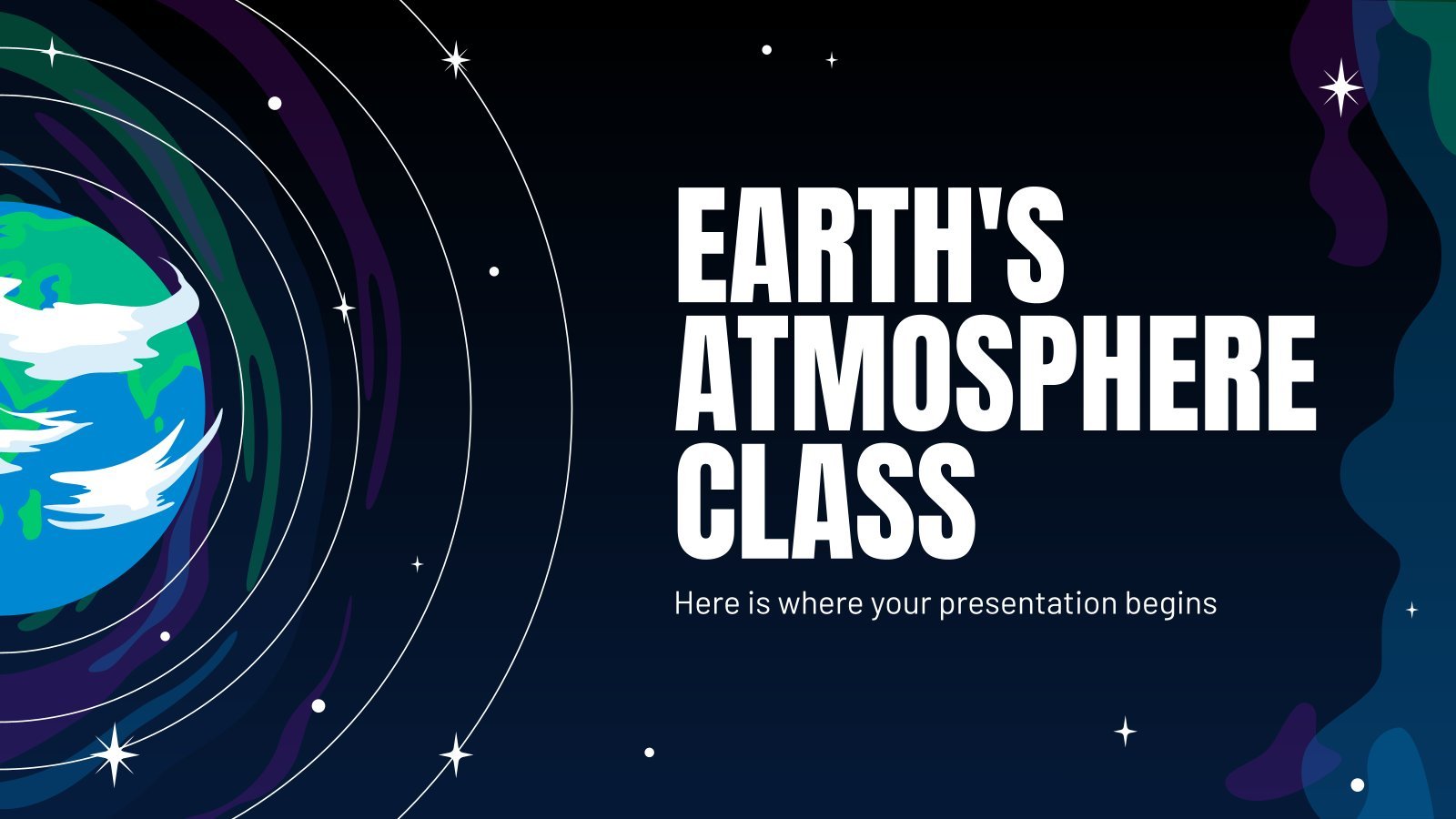
Earth's Atmosphere Class
Do you remember that mobile game where your virtual pet had to jump upwards and go through the layers of the atmosphere? Thanks to that, you will remember that airplanes fly through the troposphere, the lowest layer of the atmosphere. Perhaps, though, you need a more scientific resource to study...

Shooting Stars Theme
Download the Shooting Stars Theme presentation for PowerPoint or Google Slides and start impressing your audience with a creative and original design. Slidesgo templates like this one here offer the possibility to convey a concept, idea or topic in a clear, concise and visual way, by using different graphic resources....

Midnight Background Portfolio
Let’s think about it… is there any actual reason why you should NOT present your portfolio in a design of a midnight sky background? Well? Exactly, we didn’t think so either! This template is guaranteed to make you stand out from the competition and stay fresh in your potential clients’...
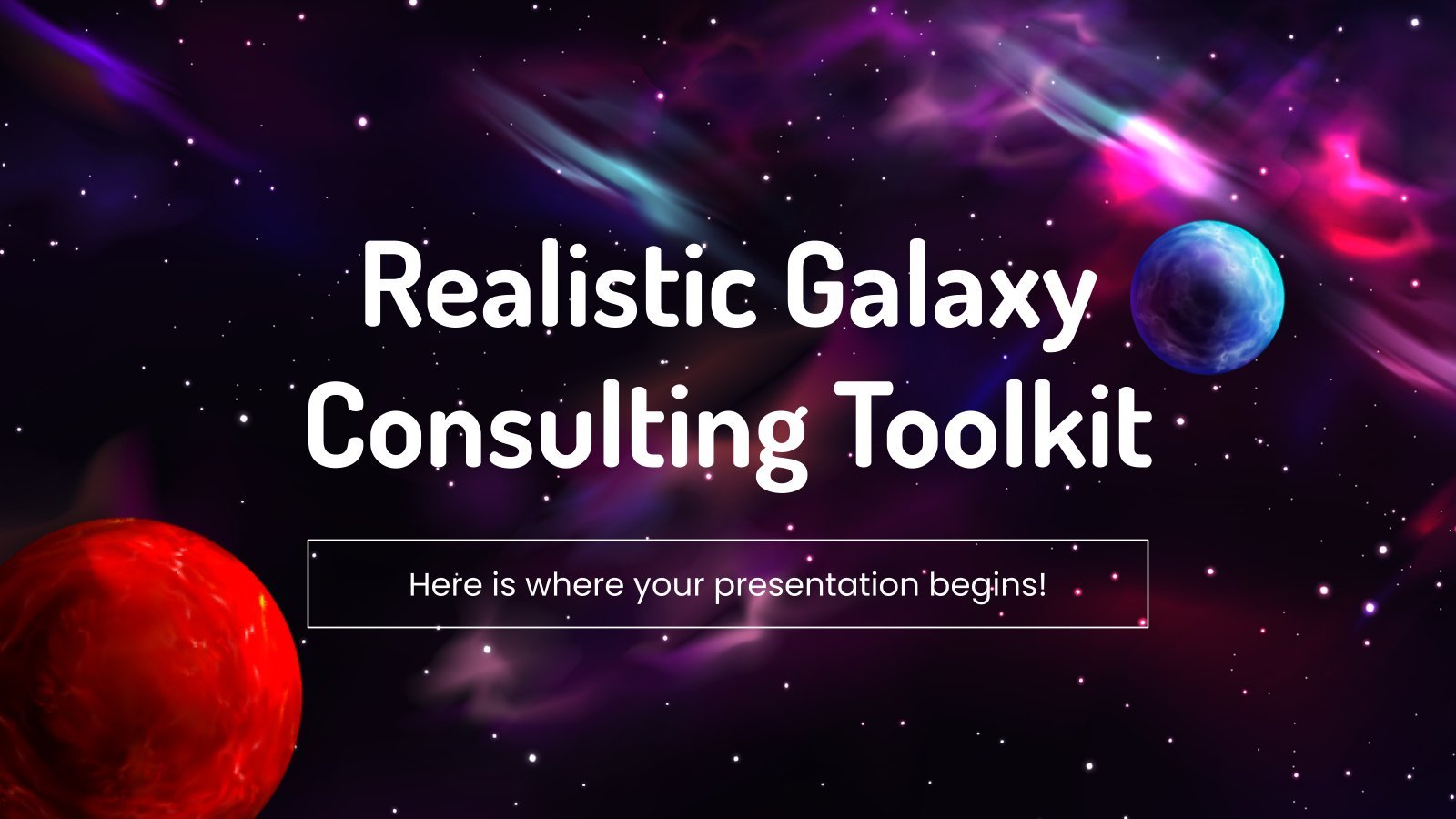
Realistic Galaxy Consulting Toolkit
Why limiting yourself to customers from planet Earth when you can be the best company in the entire Milky Way? But to aim that high, you'll need the help of expert consultants, like the ones that use this galactic template for their work. As with our other consulting toolkits, this...

Earth and Space Sciences - Science - 8th Grade
Download the "Earth and Space Sciences - Science - 8th Grade" presentation for PowerPoint or Google Slides. If you’re looking for a way to motivate and engage students who are undergoing significant physical, social, and emotional development, then you can’t go wrong with an educational template designed for Middle School...

Outer Galaxies: Astronomy Education Center
We were so fascinated by the space that "Mercury is the closest planet to the Sun" and "Slidesgo" ended up being two concepts that can appear in the same sentence. There are certain learning centers whose main focus is astronomy. What if a student of your own center discovers a...
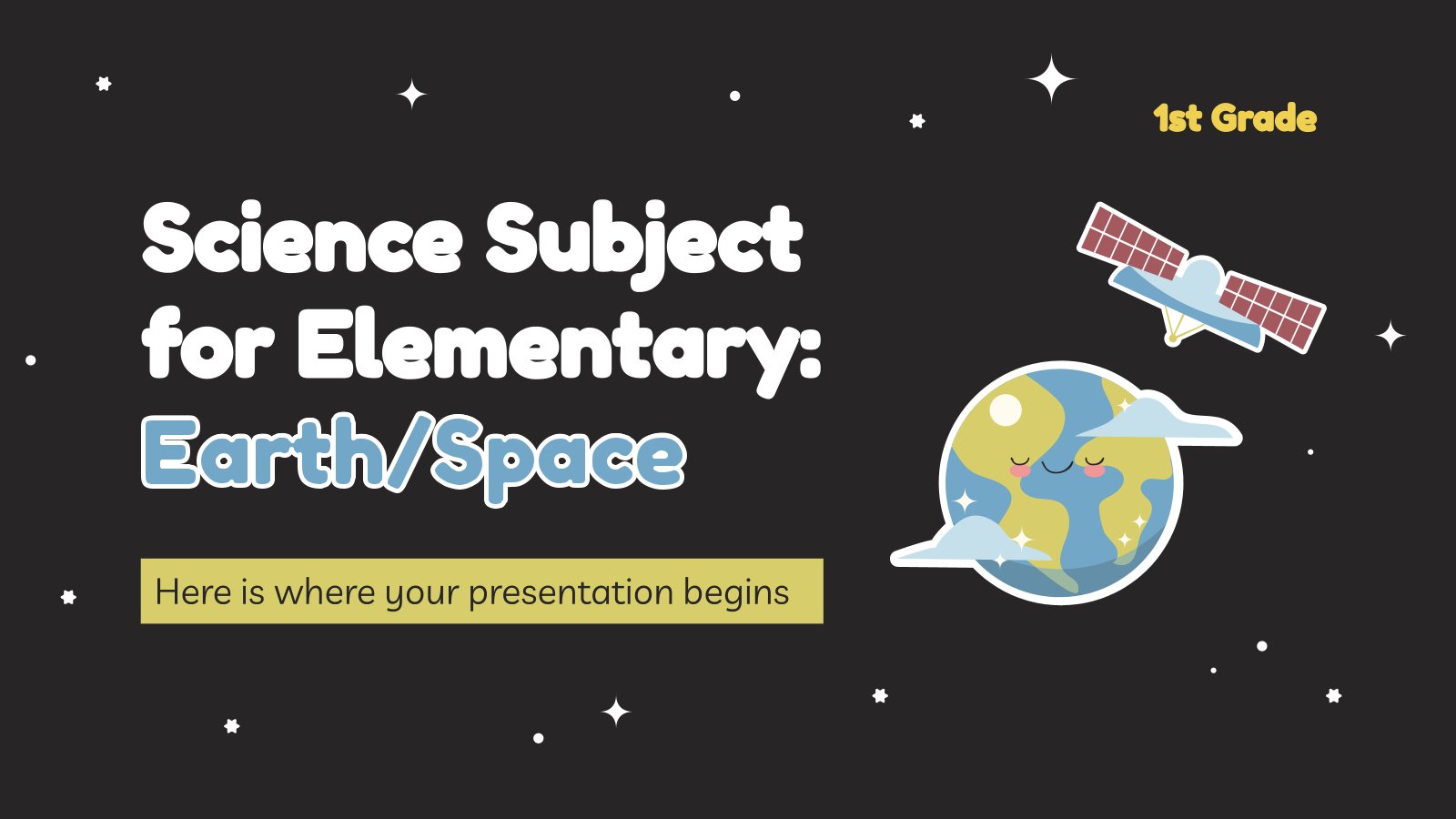
Science Subject for Elementary - 1st Grade: Earth/Space
Despite being red, Saturn is a very cold place. Wait, that's not Slidesgo's famous phrase. Maybe we need an astronomy review class! Freshly landed on Earth from a trip around the Solar System comes a template for an elementary science lesson about Earth and other planets in the Solar System....

Astronomy Minitheme
Download the Astronomy Minitheme presentation for PowerPoint or Google Slides and start impressing your audience with a creative and original design. Slidesgo templates like this one here offer the possibility to convey a concept, idea or topic in a clear, concise and visual way, by using different graphic resources. You...
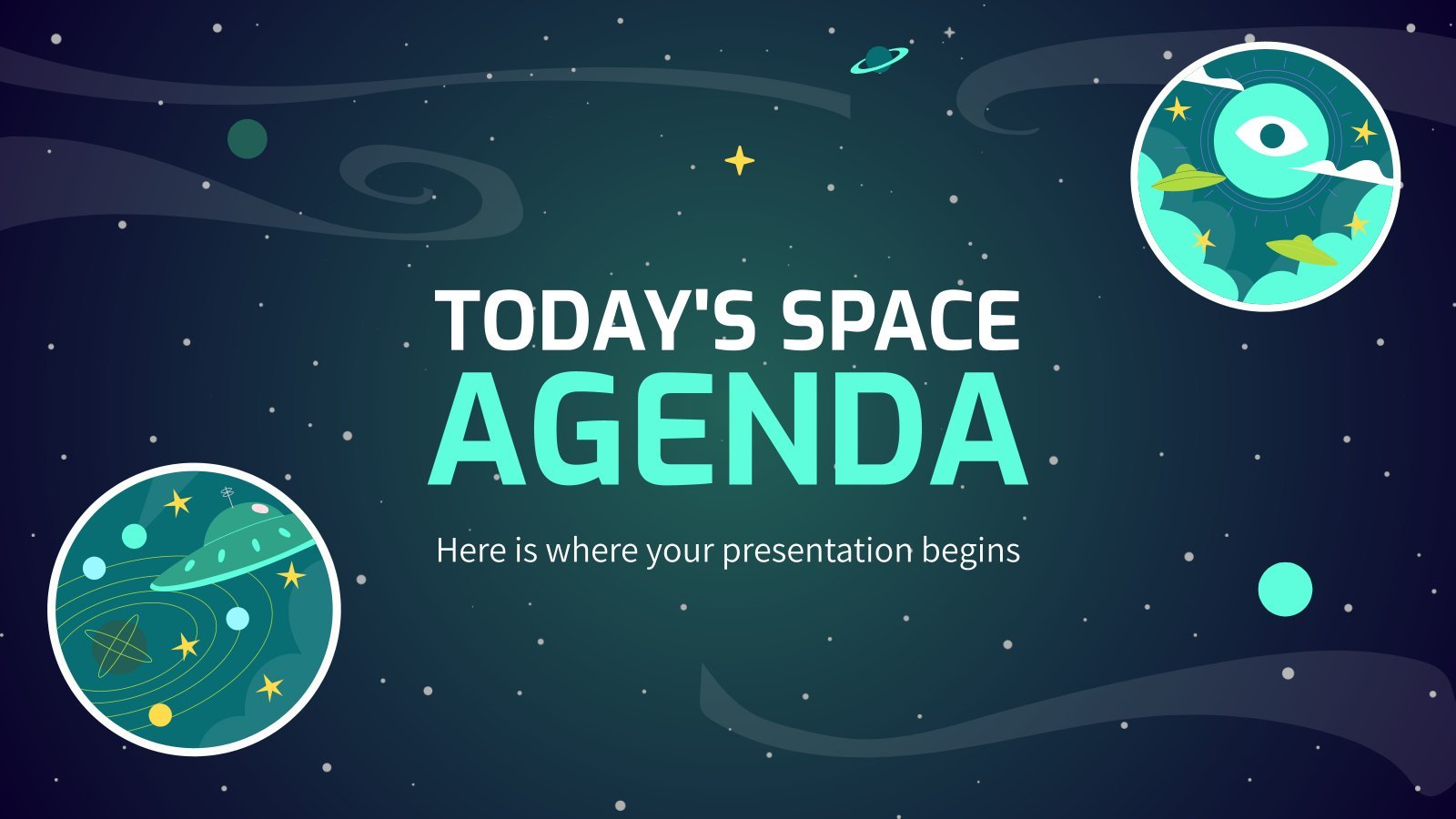
Today's Space Agenda
Download the Today's Space Agenda presentation for PowerPoint or Google Slides and start impressing your audience with a creative and original design. Slidesgo templates like this one here offer the possibility to convey a concept, idea or topic in a clear, concise and visual way, by using different graphic resources....
- Page 1 of 16
- Space Exploration Paper Topics Topics: 76
- Zoology Topics Topics: 145
- Archaeology Topics Topics: 56
- Charles Darwin Research Topics Topics: 51
- Gene Essay Topics Topics: 77
- DNA Paper Topics Topics: 113
- Atmosphere Paper Topics Topics: 50
- Biology Topics Topics: 101
- Cloning Essay Topics Topics: 74
- Anatomy Essay Topics Topics: 70
- Extinction Research Topics Topics: 55
- Genetics Research Topics Topics: 213
- Stem Cell Topics Topics: 100
- Action Research Topics Topics: 64
- Biochemistry Topics Topics: 47
126 Topics about Space
For a space essay, you need a rocketing title! Welcome to our space essay topics, where we journey beyond Earth’s boundaries. Space exploration, astronomy, and the mysteries of the universe have captivated human curiosity for centuries! Go through these space topics for presentation and uncover the wonders arising from our quest to understand the cosmos.
🚀 TOP 7 Topics about Space
🏆 best space essay topics, 👨🚀 space exploration topics, ✍️ space essay topics for college, 🌶️ hot research questions about space, ❓ space topics for presentation.
- Investing in Climate Change vs. Space Exploration
- Mathematics and Space Travel
- Arguments for Space Exploration
- Indian Space Mission and Its Negative Aspects
- Space Exploration: The Liberal Arts Lenses
- Space Investigation and Its Limits
- Space Studies: Why Should People Enter Space?
- Ocean Research vs. Outer Space Exploration Both the study of the outer space and the research of the processes that take place on Earth, particularly, in the ocean, are crucial for facilitating the safety of the humankind.
- Space Exploration: India Space Mission The following paper will discuss the topic of ISRO to launch India’s first spacecraft to Mars. Some of the benefits attributed to the mission relate to the race between India and China.
- SpaceX Company Sends Humans to the International Space Station This paper discusses the story of SpaceX, its founder Elon Musk, and their latest historical achievement of sending humans to space.
- Astronomy: International Space Station The space station operating at international level known as ISS is a partnership operation comprised of several countries with a common objective of conducting space explorations.
- Autonomous Space Robots Actualization The actualization of NASA’s idea of autonomous space robots with the capacity to repair and refuel satellites will pave the way for further developments and exploration.
- Long-Term Space Travel and Psychological Issues The exploration of space is one of the strategic goals humanity is likely to focus on in the nearest future. Astronauts have spent months during quite lasting spaceflights.
- The Space Shuttle Challenger Disaster The space shuttle is known to be one of the most ambitious projects of the modern age. The idea to create a spaceship seemed fantastic and even ridiculous.
- Museum Space of the British Museum This paper is aimed at the comparative analysis of two approaches concerning museum spaces by Duncan and Hillier and Tzortzi in relation to the visit to the British Museum.
- Space Mining and Exploration: Legislative Basis During the Cold War, countries designed laws to govern space exploration. While these laws have worked, militarization and desire for space mining have created tension.
- The Space Shuttle Challenger Engineering Ethics The engineering practices of the manufacture of the Space Shuttle Challenger were marred by ethical and moral lapses in NASA and the Morton Thiokol engineers.
- Valero Refinery Disaster and Confined Space Entry On November 5, 2010, a disaster occurred at the Valero Delaware City, Delaware. Two workers succumbed to suffocation within a process vessel.
- The Transcendental Exposition of the Concept of Space The Transcendental Exposition of the Concept of Space postulates that humans have a pure instinct of space, a concept that is commonly referred to as the argument from geometry.
- Space Exploration: UAE and INDIA Space Cooperation The potential collaboration between India and the UAE in the context of space programs’ development seems to be highly promising.
- Voice Loops as Cooperative Aids in Space Shuttle Mission Control This article deals with voice loops – a group software technology that allows operators to coordinate their actions with many spatially remote personnel.
- Space and Cyberspace Deterrence For decades the US Army has emphasized deterrence, basing its advancements on nuclear weapons to improve their defense services.
- Assessing President Kennedy’s Vision for Space Exploration Another important issue with his speech is that Kennedy’s argument does not consider whether the planets are suitable for human life.
- Katya Echazarreta, a Mexican American Woman in Space This paper considered the first case when Katya Echazarreta, a Mexican-born American woman, was sent into orbit for the first time in the history of space exploration.
- The National Aeronautics and Space Administration: Space Colonization The National Aeronautics and Space Administration is actively working on the project of Mars colonization, which is its biggest space colonization goal.
- The Evolution of Space Exploration: From the Space Race to the Present.
- The Mars Rover Missions: Unveiling the Mysteries of the Red Planet.
- Collaborative Research and Human Survival at the International Space Station.
- Pioneering Female Astronauts and Their Contributions.
- Prospects and Challenges of Lunar Colonization.
- The New Space Age: Private Companies and the Future of Space Travel.
- Space Tourism: Commercial Ventures Beyond Earth’s Atmosphere.
- The Role of Satellites in Modern Life.
- Asteroid Mining: Tapping into Celestial Resources for Earth’s Benefit.
- The Search for Earth-Like Worlds – Exoplanets and Habitable Zones.
- Expanding Our Understanding of the Universe with the Space Telescopes.
- Space Junk and Debris as the Growing Threat to Spacecraft.
- Challenges and Possibilities of Journeying Beyond Our Solar System.
- The James Webb Space Telescope: Opening New Windows to the Universe.
- What Are the Potential Barriers to Advanced Spacefaring Civilizations?
- Voyages to Explore Beyond Our Planetary Neighborhood.
- The Cosmic Microwave Background: Insights into the Early Universe.
- Space Weather and Its Impact on Earth’s Technological Infrastructure.
- Can We Estimate the Number of Communicative Extraterrestrial Civilizations?
- Space Law and Governance: Regulations for Activities Beyond Earth.
- The Challenges of Propulsion Systems for Interplanetary and Interstellar Travel.
- Robotic Vs. Human Space Exploration: Pros and Cons of Each Approach.
- The Search for Extraterrestrial Intelligence and Contact.
- The Discrepancy Between the High Probability of Extraterrestrial Life and the Lack of Contact.
- The Implications of Discovering Microbial Life Beyond Earth.
- The Concept of Space Elevators: An Alternative to Rocket-Based Space Access.
- Ethical Considerations and Potential Impacts on Indigenous Martian Environments.
- The Search for Cosmic Signatures of Life: Biosignatures and Technosignatures.
- The Effects of Microgravity on Human Health.
- The Long-Term Viability of Human Settlements on Other Planets.
- Space Exploration Through the Humanitarian Lens This paper discusses the implementation of the humanitarian lens in the context of space exploration, considering both technological and economic factors.
- NASA’s Efforts of Space Colonization: Pros and Cons NASA’s active efforts in space colonization are based on evidence and economically viable, but the concerns on the long-term sustainability aspects are valid.
- The NASA Space Colonization Plans The National Aeronautics and Space Administration is putting efforts into advancing space colonization by using its existing competencies.
- Space Informational Guides: Analysis Space and the universe are filled with mysteries that the Astronautical Space Exploration Centre seeks to solve.
- NASA and Space Colonization Space colonization efforts should adhere to universal design principles in order not to discriminate against people with disabilities.
- Space Shuttle Columbia Disaster: Results After the Space Shuttle Columbia disaster, NASA identified the management failure elements that led to the disaster and substituted them with sustainable alternatives.
- “Space Mining & Exploration” Article by Skauge Skauge’s article “Space Mining & Exploration: Forcing a Pivotal Movement” discusses essential issues regarding space mining, which is a quick-approaching reality.
- The Future of the Space Missions The current obsession with space discoveries leaves enough room for innovative developments in the area that are expected to take humanity closer to interplanetary missions.
- Accident Investigation: Space Shuttle Columbia Report The crash of any aircraft is a serious incident demanding an in-depth and comprehensive analysis of factors resulting in the emergence of an unexpected situation.
- High-Temperature Materials Selection: Space Shuttle Shield and Turbochargers The paper analysis the service requirements for these components and attempts to find the group of material that would suit these products.
- The International Law Rules in the Space Despite the insignificant presence of people in space, every action out of Earth is governed by international law rules, including autonomous space exploration.
- Microgravity – Effects on the Human Body During and After Long-Duration Space Flight The volume of selected muscles, lean body mass, and spinal bone marrow composition can be measured by Magnetic Resonance Imaging and Bone Mineral Loss and Recovery.
- Space Shuttle Challenger Disaster: Causes of the Tragedy and the Measures to Be Taken On January 28, 1986, the Challenger was launched to explode 73 seconds after its lift-off. The tragedy is commonly called “the worst disaster in the history of the space program”.
- Space and Place in the History of the American West The United States of America is a vast country that appeared due to the expansion of its frontiers by pioneers who conquered the wilderness.
- Different Races in the Same Space The attitudes toward people of different races functioning in the same space would vary depending on the assumptions dominating the society in relation to that race.
- Record Breaking X-37B Unmanned Space Plane Resistance to unintentional interferences, low probability of interceptions, and worldwide availability of frequencies are critical concerns in enhancing the functionality of UAS.
- The Vancouver Art Gallery: Perception of Space At the moment, the Vancouver Art Gallery is located in what was previously the provincial courthouse. The VGA is Canada’s fifth-largest art gallery but in Western Australia, it is the largest.
- Space Telescope Science Institute Presentation This paper presents a reflection on the presentation hosted by the Space Telescope Science Institute. The event provided insight about scientific idea and Hubble press releases.
- National Aeronautics and Space Administration’s Management Issues NASA is experiencing significant challenges in its management and program risks. The organization has had advanced knowledge in science and space exploration for many years.
- The Space Shuttle Challenger Disaster Factors One of the causes of the Space Shuttle Challenger disaster is that NASA put more emphasis on the timeframe of the project as compared to the quality standards of the project.
- The International Space Station: Building for the Future The International space station is a globally established exploration facility constructed in a low- world orbit. It is the biggest space station ever assembled.
- The Link Between Space Exploration and Advancements in Science and Military Defense
- Columbia Space Shuttle- Final Mission
- The Future Looks Promising for Space Exploration
- Why Space Colonization Will Be Fully Automated?
- The History and Origins of Space Travel
- The Science Behind Human Space Travel Over Time
- Will Asia Win the Next Space Race?
- The International Space Station: History and Future Literature Review
- The Space Race and the Tension Between the United States and the Soviet Union
- Principles of The North Korean Space Program
- The Second Race for Space: NASA vs. Private Space Enterprise
- The Space Shuttle Challenger Disintegrated 73 Seconds After Its Take Off
- The Past, Present, and Future of the Hubble Space Telescope
- General Information about The Next Generation Space Telescope
- The Economic, Health, and International Agreement Issues of Space Exploration
- Why Space Explorations Are Essential for Humanity?
- Case NASA: The End of the Space Shuttle Program
- The Symbolic and Social Meanings of Space
- The Reusable Booster Rockets of the U.S. Space Shuttle
- Why the United States Joined the Space Race
- The Human’s Great Yearning to Travel in Space
- The Four Major Space Crafts Launched in the Seventies
- General Information About the U.S. Space Program
- The Pros and Cons of Space Tourism’s Expansion
- The Space Race Greatly Affected the Cold War History
- Why Can’t You Trust Private Space Programs?
- How the Government’s Space Program Influenced the United States Economy?
- What Is the History and Perspectives of Space Exploration?
- Who Controls the Private Sector in Space?
- Why the United States Join the Space Race?
- How Did the Space Race Affect the Cold War?
- What Are the Ethical Principles and Practices of Space Exploration?
- Can the High Costs of Space Exploration Be Justified?
- How Do Carbon Composites Protect the Lives of Astronauts and Shuttles from the High Temperatures in Space?
- What Is the GDP Growth Forecast from Space?
- Why Space Exploration and Innovation Is Important for the Human Race?
- What Are the State R&D Programs for the Commercialization of Space?
- How Can Poor Countries Afford Space Programs?
- Which Space Programs Are Funded by the US Government?
- What Is Known about the Air Force Space Station at Cape Canaveral?
- How Does the Education Reform Impact the Space Race?
- What Benefits Has the United States Brought Space Inventions?
- How Did the Space Shuttle Challenger Disaster Happen?
- What Are Off-Planet Mobility and Media Perspectives of Virtual Space Tourism?
- What Are the Ethical Aspects of the Space Shuttle Columbia Accident?
- How Is Economic Growth and Regional Convergence Carried Out in a Sustainable Space Economy?
- Why Shouldn’t People Explore Outer Space?
- How Space Travels Inspires the Minds of the Youth?
- What Do You Know About Extraterrestrial Life and Outer Space?
- How Is the Space Debris Population Controlled?
Cite this post
- Chicago (N-B)
- Chicago (A-D)
StudyCorgi. (2021, December 21). 126 Topics about Space. https://studycorgi.com/ideas/space-essay-topics/
"126 Topics about Space." StudyCorgi , 21 Dec. 2021, studycorgi.com/ideas/space-essay-topics/.
StudyCorgi . (2021) '126 Topics about Space'. 21 December.
1. StudyCorgi . "126 Topics about Space." December 21, 2021. https://studycorgi.com/ideas/space-essay-topics/.
Bibliography
StudyCorgi . "126 Topics about Space." December 21, 2021. https://studycorgi.com/ideas/space-essay-topics/.
StudyCorgi . 2021. "126 Topics about Space." December 21, 2021. https://studycorgi.com/ideas/space-essay-topics/.
These essay examples and topics on Space were carefully selected by the StudyCorgi editorial team. They meet our highest standards in terms of grammar, punctuation, style, and fact accuracy. Please ensure you properly reference the materials if you’re using them to write your assignment.
This essay topic collection was updated on June 24, 2024 .

Science Dome - Presentation Topics

Live Presentation Topics for Field Trips and Private Shows
What makes a planet a planet? Which planets are currently visible in the sky? Is Mercury really boring? How old is Jupiter’s Great Red Spot? What makes the outer planets different from the inner planets? Learn the answers to these questions and more in this tour of the 8 planets in our solar system!
Moons of the Solar System
Earth has a moon, and some of the other planets do as well! Take a tour of some of the lesser known, but very mysterious worlds in our Solar System.
Strange Space
Explore some of the strangest things in space! What are the really crazy things out in space? Learn about supermassive black holes, dark matter, pulsars, and much more! Specific topics may vary.
Comets, Asteroids & Dwarfs, oh my!
Learn about the small objects in our Solar System including comets, asteroids and dwarf planets! What makes comets and asteroids different from each other? Why is Pluto “the dwarf planet” and no longer Pluto “the planet”? How many dwarf planets are out there, and what are they like?
Daily and Seasonal Motion
Did you know that the motions of objects in the sky can help us tell time and keep track of the seasons? How and why do the Sun, Moon and Stars move across the sky? Why is the fall night sky not the same as the spring night sky?
Visit the universe's diverse Galaxy Zoo! Learn about the different types of galaxies and find out what lurks in a galactic center. What happens if galaxies collide?
Our Place in the Universe
Learn about the size and scale of the universe. What does the universe look like on a cosmic scale, and is our place in the universe unique or special? Drift through our local group and discover where we fit into our corner of the universe.
You may already know about the 8 planets in our Solar System, but are there others out there? Go on an interstellar adventure to far-off, exotic planets.
Phases of the Moon
Why can we see more of the moon at some times than others? Why do we never see a full moon at noon or a crescent moon at midnight? Learn how the sun-earth-moon monthly dance drives what we see.
Our Sun & Other Stars
How does our sun compare to other stars? How big can a star be? What happens when stars die?
Night Sky Tour
Presentation on what is currently in our night sky: Identify Constellations, nebulas and other deep sky objects in our current night sky.
You are using an outdated browser. Please upgrade your browser .

List of Ready-Made Presentations for Meetings, Class Visits, and Cloudy Days

Space Agenda 2021

Introduction
From evolving adversary threats to game-changing technologies to emerging commercial capabilities, the space enterprise is in an era of rapid change. This moment presents countless opportunities to shape the future of space. Challenges will have to be addressed, whether it’s managing space traffic and orbital debris, integrating new commercial operators or preparing for a new era of contested space.
Space Agenda 2021 , is a series of papers highlighting issues already at the forefront of U.S. space policy or are likely to emerge in the coming years. Each paper serves as a chapter in the full Space Agenda 2021 report, offering concise backgrounds, astute analyses, and potential options to aid government decisionmakers, industry leaders and other space stakeholders.
Read the Full Collection

Outpacing the Threat
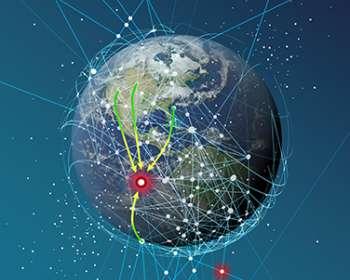
This is a critical moment for the U.S. and its allies in space. As the space domain becomes more crowded and contested, potential adversaries are developing new capabilities that threaten national security and interests. These papers offer insights into key topics and trends that must be considered in order to continuously outpace the threat.
- Developing a Foundational Spacepower Doctrine: Fostering an Independent Space-Minded Culture and Identity - Peter Hays, Russell Rumbaugh, Michael Gleason
- A Roadmap for Assessing Space Weapons - Michael Gleason, Peter Hays
- What Place for Space: Competing Schools of Operational Thought - Russell Rumbaugh
- Organizing for Defense Space: Balancing Support for the Joint Force and Independent Space Operations - Russell Rumbaugh, Peter Hays, Michael Gleason
- Getting the Most Deterrent Value from U.S. Space Forces - Michael Gleason, Peter Hays
- Noninterference with National Technical Means: The Status Quo Will Not Survive - Michael Gleason, Luc Riesbeck
- Leveraging Commercial Space for National Security - Jamie Morin, Sam Wilson
- Continuous Production Agility: Future-Proofing the National Security Space Enterprise - Karen Jones, Geoffrey Reber
- The Future of Ubiquitous, Realtime Intelligence: A GEOINT Singularity - Josef Koller
- Space-Enabled Persistence and Transparency in the Arctic to Support Infrastructure and National Security Needs - Karen Jones, Lina Cashin
Expanding Frontiers
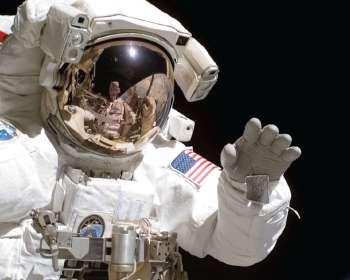
As the nation’s space capabilities continue to advance, leveraging new innovations and partnerships with the commercial sector and international allies can create new opportunities to augment U.S. government missions. These papers discuss key ideas and topics that will help shape the trajectory and expectations for this expansion of new frontiers.
- To the Moon and Beyond: Challenges and Opportunities for NASA’s Artemis Program - Angie Bukley
- Cislunar Development: What to Build and Why - James Vedda
- Human Spaceflight Safety: Regulatory Issues and Mitigating Concepts - Josef Koller, George Nield
- Emerging Issues in New Space Services: Technology, Law, and Regulatory Oversight - Josef Koller, Rebecca Reesman, Tyler Way
- Public-Private Partnerships: Stimulating Innovation in the Space Sector - Karen Jones
Managing the Growth in Space Traffic
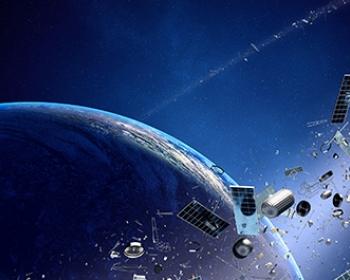
Technological advances and new commercial entrants are lowering the barriers of entry to put spacecraft on orbit. While this trend provides promising opportunities, issues such as an increasingly congested orbit, impact on existing operations, and long-term sustainability must be addressed. These papers highlight some of the key issues in keeping space accessible and safe for the growing enterprise.
- Space Traffic Management: The Challenge of Large Constellations, Orbital Debris, and the Rapid Changes in Space Operations - Marlon Sorge, William Ailor, Ted Muelhaupt
- Slash the Trash: Incentivizing Deorbit - Rebecca Reesman, Michael Gleason, Layla Bryant, and Colleen Stover
- Airspace Integration in an Era of Growing Launch Operations - Robert Unverzagt
- Light Pollution from Satellites - Josef Koller, Luc Riesbeck, Roger Thompson
- Cislunar Stewardship: Planning for Sustainability and International Cooperation - George Pollock IV and James Vedda
- Developing a Sustainable Spectrum Approach to Deliver 5G Services and Critical Weather Forecasts - David Lubar, David Kunkee, and Lina Cashin
Leading in a Time of Change
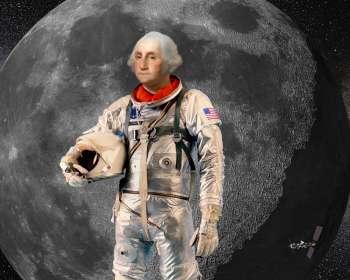
Space leadership has enduring importance, yet it seems to mean different things to different people. Shaping the future of space must account for the domain’s rapidly evolving complexities as a physical, political, economic, and threat environment. These papers explore the challenges, priorities and potential strategies for a modern space enterprise.
- Space Leadership in Transition - James Vedda
- Strategic Foresight: Addressing Uncertainty in Long-Term Strategic Planning - Kara Cunzeman, Robin Dickey
- Space Game Changers: Driving Forces and Implications for Innovation Investments - Karen Jones
- Defense Space Partnerships: A Strategic Priority - Sam Wilson, Colleen Stover, Steven Jordan Tomaszewski
- Space-Based Solar Power: A Near-Term Investment Decision - James Vedda, Karen Jones
- Survey of Space-Related Political Appointees and Offices in U.S. Government - Robin Dickey, Colleen Stover
Custom Essay, Term Paper & Research paper writing services
- testimonials
Toll Free: +1 (888) 354-4744
Email: [email protected]
Writing custom essays & research papers since 2008
154 hot astronomy research topics for a-grade papers.
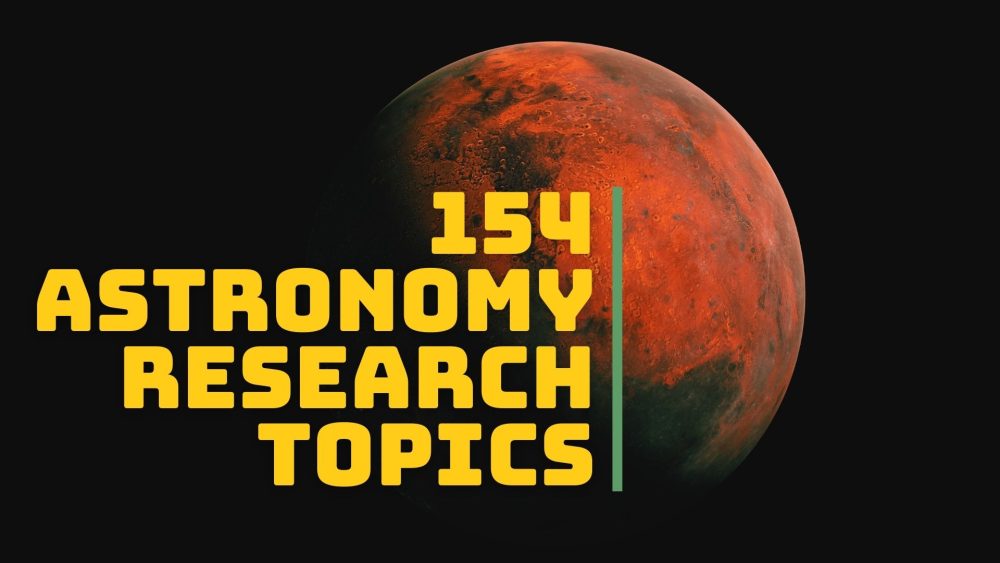
Do you have a college astronomy paper or essay and have been wondering how to get the best topic? You might also be stuck with the paper, wondering how to go about it.
The truth about astronomy is that getting interesting space topics is never easy, but how do you address the challenge? There is no need to worry anymore because we are here to help.
In this post, we list 154 astronomy paper topics and further highlight the traits of a great research paper. Why get content with standard or low-quality paper when you can get the best in your class by checking out the guide and topics, as well as getting lab report help ?
What Is Astronomy?
Before looking at the leading space science topics for your university assignment, let’s start with the definition. Astronomy is the study concerned with researching and understanding everything that takes place beyond the earth’s atmosphere. Although the advances in technology, especially on telescopes, satellites, and manned space vehicles, have helped people to peep deeper into space, this is just a scratch on the surface. There is a lot more waiting to be explored, including the controversial question, “Is there life on other planets?”
Characteristics Of A Good Astronomy Research Paper
From the definition of astronomy, it is clear that you can have a long list of astronomy project topics or ideas. Once you have picked the preferred option from our research topics in cosmology, the next step is preparing your paper. Here are the main characteristics of a good school research paper in astronomy:
- Systematic: This means that your research paper should be structured per clearly defined rules. So, students should start by reviewing requirements by their professors or teachers and think creatively of how to make their papers professional.
- Logical: This implies that the student carefully reasons all the points to ensure they support the selected topic. Although there is so much one can write on a specific topic, you must narrow it down to those points that are current and that support your topic.
- Comprehensive: Your paper also needs to be as comprehensive as possible. So, you must exhaustively identify the core points in a selected topic. It should also fit well in the current literature on the same topic, helping to advance the discipline.
- Plagiarism-Free: All universities out there have very strict rules on plagiarism. Therefore, your work must be 100% original.
- Clearly flowing points and free from errors: Finally, your paper should be arranged well to ensure that all the points flow logically from the start to the end. Again, it should be proofread to ensure it is free from errors.
Best Astronomy Essay Topics
Now that we have looked at the main characteristics of a high quality astronomy paper or essay, it is time to dig deeper into the main topics. Check out our list of the leading astronomy research topics for top grades.
Top Astronomy Research Topics
- What is the future of space exploration?
- A closer review of the big bang theory.
- Compare two theories that explain the origin of the universe.
- Stephen Hawking theories.
- Space Challenger disaster: What are the sociological impacts?
- A review of the recent space exploration breakthroughs.
- The moon landing.
- The Mars landing of space rovers.
- A deeper look at the history of astronomy.
- Reviewing the heliocentric model of the galaxy.
- Analyzing the lifecycle of a star.
- What impact does the moon have on the earth?
- Space debris and its impact on the solar system.
- What impact do humans have on the solar system?
- The rise of space tourism: What impact will it have on space exploration?
- Is space tourism a good thing?
- What could go wrong with space tourism?
- Space manufacturing: Is it a good thing?
- The mythologies associated with heavenly bodies.
- What impact do the stars have on earth?
Unique Astronomy Research Paper Topics
- A review of the Hubble telescope.
- A closer look at the Haley’s comet.
- Through the mind of early astronomers: Galileo Aristotle, and Ptolemy.
- What are the advantages of exploring space?
- The race to explore space and the cold war.
- Reviewing the first astronauts to visit the moon.
- What lessons did NASA learn from its first mission to the moon?
- Can life exist on the moon?
- What is the biggest difference between earth and moon?
- Explaining the earth’s outlook as viewed from space.
- The design of space vehicles: Are the modern models riskier compared to those used in the 20th century?
- What impact will private companies like SpaceX and Blue Origin have in astronomy?
- If we have a space station where scientists travel often, is the idea of space hotels far-fetched? A closer look at Blue Origin’s idea of a space hotel.
- Looking beyond the Milky Way.
- A review of Pluto: How does it compare to other planets?
- How does earth compare to Jupiter?
- Explain the sun’s source of heat and light for millions of years.
- Analyzing the rings of Saturn.
- A review of astronauts physical and health preparedness before setting off for space exploration.
- What effects does long stay in space have on the human body?
- What can astronauts do to reduce the danger of muscle atrophy?
- Zero gravity in space.
Awesome Astronomy Topics To Write About
- What are wormholes?
- A review of the evolution of space exploration changes in history.
- Speed of light travel: what are the implications?
- A closer look at time travel: Theory versus fiction.
- Zero gravity: What impact does it have on astronauts’ health over time?
- The interdisciplinary perspectives of space.
- Astrophysics: A review of the main controversies.
- Explore the possibility of having life on other planets.
- What implications would life on other planets have on planet earth?
- Think of yourself as an astronaut: What would be your reaction upon encounter with aliens?
- Stars and how people use them for navigation.
- Comparing different theories that explain the origin of life on planet earth.
- Space weather.
- How does space weather compare to the earth’s weather?
- Global warming: An astronaut’s view.
- The sun and its relationship with the earth.
- Comparing the sun’s relationship with Saturn and Pluto.
- Robotic space exploration: Is it a good idea?
- Constellations: A review of human interpretations.
- A review of emerging business opportunities in space.
- Space travel for non-astronauts: Is it a good idea?
- Comparing space travelling scientists to tourists: What is the difference?
Engaging Space Research Paper Topics
- What is the difference between planets and asteroids?
- How did the “northern lights” come about?
- Capture hypothesis: A review.
- What caused the Challenger to explode after take-off?
- The challenger shuttle disaster: A review of the preparations.
- What lessons did we learn from the challenger disaster?
- Was the Challenger the greatest failure in NASA’s history?
- Analyzing President Ronald Reagan’s speech after the Challenger disaster.
- Space Challenger disaster analysis: Why we are on the blink of another bigger and deadlier disaster.
- Are the current space policies ample to guide the new era of space travel?
- Dennis Tito: Looking at the experience of the first space tourists.
- Space politics: Is competition a good thing when it comes to space exploration?
- Reimagining the space: What would happen if we suddenly discovered that it was possible to inhabit the moon?
- Space will form the next generation combat zone for superpowers in competition for new resources.
- Factoring the distance and other logistics: Would mining in space be viable?
Great Space Exploration Topics
- A review of three biggest planets that orbit outside the solar system.
- Comparing the characteristics of gas planets to terrestrial planets.
- Fission Hypothesis by George Darwin.
- A review of the Giant Impact Theory.
- Exploring the theories that explain the origin of the moon.
- How long does it take for a new planet to form?
- Imagining a Marxist society living on Mars.
- Exploring the process of formation of the biggest stars in the cosmos.
- Is it possible for light to escape from the black hole?
- Determining the moon’s diameter: How accurate is the method used for calculation?
- Is the Big Bang Theory the best explanation of the origin of the universe?
- Reviewing the fate of the universe.
- Gravitational waves: Why their discovery is so important.
- Monitoring the State of the Environment using Ecologically Clean devices.
- Reviewing the doctrine of Noosphere.
- The legends of Starry Sky.
- The importance of mathematics in space explorations.
Astrophysics Research Topics For Debate
- Relativity theory and gravity.
- What is a variable star?
- Gravity and eclipse.
- Venus: Reviewing its formation.
- The mass of matter and nebulae.
- The Big Bang Theory.
- Brown Dwarf.
- Space manufacturing: What materials and products are manufactured in space?
- What happens during a solar eclipse?
- Celestial mechanics.
- Manned space shuttles.
Discussion Topics In Astronomy
- A thematic review of the heliocentric theory.
- The conflicting theories on the origin of the earth: science versus religion.
- Expecting the worst: What could go wrong with space missions?
- Is the cost and effort for space exploration worth it?
- Beyond the visible universe: What should we expect?
- How does the lunar cycle function?
- The dimensions of light in space: How does it differ after entering the earth’s atmosphere?
- What is astrophysics?
- Nonlinear, slow mode, and fast mode effects.
- Grand unification theories.
- What impact does the moon have on the oceans?
- The longitudes and latitudes of the earth.
- What are the different types of stars?
- The formation and destruction of clouds in the Galaxies.
- Meridian and transit circles: What are they?
- The galaxy cluster growth.
- A review of the molecular cloud.
Investigative Astrophysics Research Topics
- How long does it take to travel to space?
- Which is the most prominent of all planets? Is it earth?
- Survival on other planets? How to make it possible.
- Pluto should not be considered another planet: Discuss.
- Journey to Mars: Should we open it to all?
- Comparing the journeys to the International Space Station (ISS) and the Moon.
- Space keeps expanding: Explain.
- The best defense against killer asteroids.
- How to relate interplanetary matter with space activities.
- The 2012 transit of Venus: A detailed review.
- What do astronauts eat when travelling to space?
Controversial Astronomy Topics For Research Paper
- Militarization of space: Is it avoidable?
- Asteroid mining: Is it a good idea?
- A review of space exploration issues and connection to women.
- State exploration is very important: Approve or disapprove this statement.
- Colonizing other planets: Is it ethical?
- Terraforming on Mars.
- The security challenges of space explorations.
- Space exploration: Does it have any impacts on planet earth.
- Using VR and AR should replace humans for space explorations.
Other Cool Astronomy Topics
- The impact of the sun on water bodies.
- Interstellar extinction: What is the cause?
- What is the deep impact mission?
- Essential requirements for space travel.
- Preparing for space travel.
- Is there an earth-like planet that is habitable?
- Solar systems with two stars: How do they operate?
- Comparing the preparation for space tourists and astronauts.
- Where do asteroids come from?
- What is antimatter?
Seek Help From The Best Paper Writing Service
Now that we have listed the characteristics of a great research paper, are you ready to write the assignment? If you find it challenging, know that you are not alone. A lot of students find it tough because the topics are very broad and require a lot of research. “I need a paper written for me” is a thought of many, not just you. Well, no matter the reason why preparing the paper is challenging, you should seek help from online expert writers.
Our service works with professionals, and you can count on them to the best grade in your paper. They are native English writers with a lot of experience in writing custom astronomy papers. The service is also secure and trustworthy, implying that no one other than you can know that the paper was bought. The writers are also excellent in editing, cheap and fast. They will handle even your papers with very tight deadlines. All that you need is to visit our site and tell us to “ write my paper .”

124 Space Essay Topic Ideas & Examples
🏆 best space topic ideas & essay examples, 👍 good essay topics on space, 📌 simple & easy space essay titles, ❓ easy space questions.
- The Future of Space Exploration The attitude of the researchers in this field is rather ambivalent; the main beneficial and negative points of space exploration would be covered in the next parts to make the argumentative and clear statement.
- The Importance of Space Exploration It is evident in the study that spaceflight was the most instrumental element that acted as the driving force and backbone of the exploration processes to the orbital surface.
- Human Access to Space and Space Flight Therefore, these industries work together to develop cheap and efficient alternatives to local products with applications in outer space Finally, space exploration takes on new meaning when it comes to expanding the boundaries of human […]
- The Future for Space Tourism Objectives of the study This term paper lays down the need for researching the background of the future space tourism, its impact to the society and those who are involved as well as assessment over […]
- Space: The Reflection of Thoughts About Space We send people and satellites in space, we use telescopes and other machines to cognize it, and we even landed on the Moon, which is definitely one of the greatest successes demonstrating the power of […]
- Space Exploration Problems On the other hand, people have an opportunity to study the processes which could be useful for understanding the origins of planets, galaxies and the universe in general. BNSC reflected on the plans that UK […]
- How the Movie Techniques of Space and Mise-En-Scene Work to Deliver Meaning in Film It gives a depressive quality that defines the placement of the characters and focuses on what the general theme of the movie is going to be.
- Man in Space – Norm Thagard Man continues to make space travel attempts through advanced technology with the intention of exploring the space. The second technology used in space travel was the use of cordless power tools.
- Space Debris Problem They cause collision dangers to other satellites and spacecrafts in the orbit and have the potential of increasing debris in space, which would increase the likelihood of collision and hence affect the normal operation of […]
- Reagan’s The Space Shuttle ‘Challenger’ Tragedy Address The speech was given to address the American grief about the disaster that happened to the Space Shuttle Challenger and support the families and the nation.
- India’s Space Exploration Affairs Space exploration has become a key area of concern for modern scientists and this is evident from the many attempts being undertaken in the world today to explore every bit of the outer space.
- Space Technology: a Critical Investment for Our Nation’s Future by Bobby Braun The author devoted the article called Space Technology: A Critical Investment for our Nation to discussing the advantages of the process and positive outcome of the American aerospace industry.
- Space Tourism from TUI Travel PLC Group The leading company in space tourism is Space Adventure, the company that took the first tourist to space; therefore, it enjoys much popularity in the world.
- Ways Through Which Space Is Defined by Cultural Ornamentation The organic ornaments on the other hand are the inherent decorations of the art representing the piece of art in its organic form.
- Space, Sky and Universe Analysis After watching the videos, the teacher may ask students to think about the sky and think about what they know about it.
- The Shared Space Cultural Diversity and the Public Domain As a matter of fact, it should be noted that management in relation to implementation of the principles of cultural diversity will be important in terms of ensuring that all the respective agenda for ensuring […]
- The concept of space and time In 1986, Szamosi delved into the subject again this time round detailing how the perceptions of space and time developed from earlier attempts of primitive life forms to understand their world to become the modern […]
- Development of New Space Vehicles: Manned Flight to the Moon and Mars The Apollo 11 landing on the surface of the Moon represents the highest point yet in the conquest of the cosmos by man.
- International Space Station: Origin, Purpose, Structure, Power Supply The international space station program is a joint venture between the National Aeronautics and space administration of the United States of America, Russia Federal Space Agency of Russia, Japan Aerospace Exploration Agency of Japan, Canadian […]
- Space Travel and Its Impact on the Planet In addition to sending humans into space on the New Shepard, the company is working on reusable liquid rocket engines, space inhabitation programs and orbital launch vehicles.
- SpaceX: Disrupting the Space Industry At the same time, the use of a single core made the BFR rocket easier and more idea-driven to launch. This decision was made because of the significant advantages of SpaceX and the new approaches […]
- Venus: The Object for Research and Space Missions The current offer is unique in that it is planned to launch modules on the surface of Venus and keep them active for a long time.
- Vegetation Monitoring From Space Remote sensing also helps in the determination of the distribution of the existing vegetation cover within a particular locality. In this paper, the author seeks to provide an overview of the use of remote sensing […]
- The Challenger Space Shuttle Disaster The case of the space shuttle Challenger is, probably, one of the biggest disasters in the history of American space exploration.
- Space Science and Technology Development in the UAE For this reason, the given study focuses on investigating the role of space science and technology development in the UAE and their contribution to the development of international relations.
- Space Shuttle Challenger’s Explosion Factors A fault tree analysis can be used to identify and examine the major factors that led to the failure of the O-rings in the Solid Rocket Boosters. The failure of the O-rings led to the […]
- Outer Space and Its Impact on the Earth As the name implies, the outer space exists in a void area where there is no atmosphere of the Earth. The temperature varies with the time of the earth day on the outer space area […]
- Mercury Exploration and Space Missions The density of this planet is almost the same to that of the earth and this explains why the winds carried the eroded soils.
- Space Exploration: Attitude & Recent Breakthrough It created the basis for the development of natural science and technologies. Moreover, from the social perspective, overcoming the challenges of surviving in space requires cooperation and the development of communities.
- Framework for the Weaponization of Outer Space The task of limiting an arms competition in outer space has been at the center of the international community’s attention since the really start of space activities in the late 1950s.
- Prince William’s Criticism Towards Commercial Space Travel Yet, on the other hand, it can be argued that the owners of SpaceX, Blue Origin, and Virgin Galactic are not obligated to solve environmental issues more than other people.
- Integrated Process Control and Space Flight Safety The reason for this is the fact that error analysis can influence and change the principle of implementation, therefore, it must be taken into account.
- Role of Law in Case of Space Shuttle Challenger Explosion The occurrence of white color crimes and the inability of the society to protect itself from their adverse effects have led to the government coming up with laws to protect the society and deal with […]
- Applications of Space Technologies to Global Health The results of the research demonstrated that there indeed was a connection between the use of space technology and global health tendencies.
- Film Critique: 2001: A Space Odyssey Further on, in the film what becomes apparent is the fact that the vastness of space and the lonely feeling that is being experienced by the crew is being represented by the music as well […]
- New Artemis Accords Comparison to Outer Space Treaty Section 10 emphasizes that the signatories are obliged to “inform the Secretary-General of the United Nations, the public and the international scientific community, regarding the extraction of space resources activities by the Outer Space Treaty”.
- Space Exploration Mission: Mars Reconnaissance Orbiter The historical development of Mars Reconnaissance Orbiter is anchored on the dual mission which was targeted for in the 2003 Mars launch window; nonetheless, within the course of the drafting the proposal the MRO was […]
- Space Agency: Risk Management The Bowtie method is one of the models of risk management that have gained massive popularity over the recent past.”Bowtie method is a risk evaluation method that can be used to analyze and demonstrate causal […]
- Inayatullah’s Triangle: Space Tourism One of the major problems of space tourism is the fact that human bodies cannot adapt quickly in outer space as it does on Earth.
- Privatization of Human Space Flight The Commission studied the 9-year-old Constellation Program, the human spaceflight program within NASA and found it to be totally inadequate to render possible the realization of any goals of human space exploration. Consequently, the President […]
- Functional, Personal, and Physical Scope of the UAE Space Law The focus of this paper is to examine the extent to which the UAE space law clarifies the functional, personal, and physical scope of the application of the UN space treaties.
- Space Exploration History and Prospects The exploration of space assists in addressing the central questions about humanity’s place in the history of the universe and the solar system. Scientists are working day and night to reveal ways of mitigating the […]
- Risk Management in the International Space Station ISS is faced with various threats and risks, which could be classified into three major categories: i) those that could cause the destruction of the Station, ii) risks that could compromise the health of the […]
- “Mega Project: Space Exploration” Scenarios One of the primary targets of the mission, measuring the atmospheric composition of the new planet, is expected to be achieved without major problems.
- India’s Space Race Relevance The case is similar to that of the United States and the Soviet Union in the 1990s. The leaders should consider investments to ensure the peaceful coexistence of people due to the lack of basic […]
- National Aeronautics and Space Administration History The agency issued guidelines on the technologies used and the existing equipment, and the approach to this task. The agency had been responsible for the transfer of information from space to the community; it had […]
- How Close Is the Success of Suborbital Commercial Space Shuttles? This paper seeks to provide an overview of the space tourism industry, determine the advantages and disadvantages of various aspects of the industry, take a look at some of the major players of industry with […]
- Cold War Space Race Analysis The objective of this paper is to critically analyze the historic events that escalated as a result of the space race between America and the Soviets during the Cold war.
- The Contributions of Dwight Eisenhower to America’s Success in Their Space Exploration Efforts When he took over the presidency he saw the importance of incorporating space technology in the country’s defense mechanism and in this respect he directed that the construction of ballistic missiles and also the construction […]
- Building a Space Launching Pad in Australia Advantages Such programs as operation of satellite and its services, processing of signal and space data, space instrumentation, designing of ground equipment, tracking of space debris and GPS usage are useful in Australia just as it […]
- Architecture of the Air and Space Museum in Washington, DC As the most prolific work of architecture, the National Air and Space Museum is considered to be one of Washington DC’s most important displays of the current modern architecture.
- Space and Aeronautics Market in Saudi Arabia The purpose of this paper is to analyze and outline the market needs for space and aeronautics technology in Saudi Arabia.
- Military in Space: What Will It Give the US? If these are the primary purposes of the current military strategy in space, there is more for the military in the future.
- Role of Servicescape in Providing a Space for Value Co-Creation to Occur The value proposition is a summary of product features that are of importance to a customer and that are promised to be delivered.
- The Space Challenger Shuttle: Advocacy vs. Inquiry First, the fact that advocacy aims to get an idea passed regardless of the consequences, was the wrong decision-making approach as it led to the death of 7 people.
- Chinese Space Program: Innovation and Value of the Proposed Experiments The surveillance of the environment and the prediction of natural disasters system will be innovative in comparison to the existing satellite-based system.
- Powered Exoskeleton in Military & Space Industries The use of exoskeletons by the military will lead to a reduction in the need for heavy-lift machinery on the battlefield since the soldiers will be able to lift heavy objects with the help of […]
- Laser Communication Links in Space Inter-satellite laser communication is also a great prospect to explore, as there are no obstacles in space that could impede or reduce the effectiveness of a laser beam.
- Diabetes Investigation in Space Flight Research Collaboration with the Chinese space station program is a good way to facilitate experiments and research that were conducted as part of other space programs.
- Hubble Constant in Space Telescope Key Project In a plot of the recession velocity and the distance from the observer, the fraction of the velocity and the distance, when expressed as a ratio, represents the Hubble constant.
- Space Programs: Progress or Waste of Money? According to Ehrenfreund, the ingenuity to develop technologies and work in space is part of the progress that comes from space programs. Space programs have led to the development of technologies that improve air transport.
- Space Tourism, Its Safety and Barriers to Progress The primary purpose of the paper is to critically discuss the importance of the safety of space tourism and evaluate whether it hinders the progress and development of the technology.
- Marsha Sue Ivins’ Speech for World Space Week She was able to achieve the aims of her statements and kept the audience interested in the content of her speech.
- National Aeronautics and Space Administration’s Threats According to CRM used by NASA, risk is composed by the following triplet: the scenario of “degraded performance”, the likelihood of the scenario, and the consequences expressed in the severity of results.
- National Aeronautics and Space Administration’s Risks Although the idea of narrowing the number of areas to be included in the design of a risk management strategy may affect the success of the process, it helps organize the procedure.
- Inner Space Exploration Vehicles There are three common types of underwater vehicles such as autonomous underwater vehicle, human occupied vehicles, and remotely operated vehicles. In addition, there are some human occupied vehicles that are simply used to visit life […]
- The Soviet Space Program Role in the Cold War The paper will begin by providing an overview of the Cold War in order to highlight the conditions that led to the space race between the US and the USSR.
- The Kepler Space Observatory The first was to identify the terrestrial planets that existed in the habitable zone of the huge number of stars that the mission was going to analyze.
- Space Exploration Accidents: Challenger and Columbia The failure in the joint of the elements of the rocket motor caused the Challenger catastrophe. The analysis of the accidents led to the development of a number of recommendations.
- The Main Reasons for Space Exploration In 1957, the Soviet successfully launched the first satellite into space that marked the beginning of space exploration. After the success of the Soviet’s satellite, the U.S.invested more into space exploration.
- Development of Space Power Currently, it is acknowledged that the future of the military success lies in the ability of the forces to exploit the space power.
- Consumer Interest in Space Tourism Consequently, the absence of alternative forms of tourism limited the products of tourism only to those tourists who consume traditional and common tourism products leaving out potential tourists attracted to alternative and unique tourism products.
- Geometry, Space, Manipulative, and Technology In this research report, the focus of the study will be centered on the topic of geometry, space, manipulative, and technology. This is the part of the research that facilitates understanding of the geometry and […]
- Market Based Approaches for Controlling Space Mission Costs This has however been addressed and there has been a recommendation that in any future missions using the same system, a mechanism has to be put in place that combines the development and operational phases […]
- Competitive Space Technologies in US The USA is one of the leaders of the space technology and it is trying to find new ways of exploring and using the outer space.
- Organization Behavior and Management: Space Shuttle Challenger This paper will look at the SHUTTLE 51-L MISSION, the organization that was involved in the Challenger project, the mechanical failure of the Space Shuttle Challenger, the organizational behavior and management shortcomings that contributed to […]
- An Observation on the Necessity of Established Space Lanes Solar flares can be described as an event wherein the plasma located in the sun is heated to tens of millions of Kelvins resulting in a sudden brightening and the release of energy from the […]
- Space Hazards as a Challenge to Astronauts Astronauts are best positioned to operate in space since they have studied the universe and understand the risks and the benefits of the operations in space.
- Digital Theory and Aesthetics Space and Network Cultures in the Urban Environment Davies’ ‘Osmose’, is more of a philosophical work and it tries to show a non-dualist world view that foresees the “human self in the natural environment, instead of a man-made one”.
- Space Shuttle Challenger Disaster: 20/20 Hindsight Bias The best way of doing this is through enabling of the funds drafted in the forwarded budget and transferring the monitoring responsibilities to watchdogs and commissions that consist of a panel of specialists in the […]
- International Space Exploration: Improving Human Life Advances in space exploration, particularly the creation of the International Space Station, has enhanced the observation of the globe to provide better comprehension and solutions to environmental matters on earth.
- Hazard from Space: Mass Extinction Theory The massive impact of extraterrestrial objects did not cause mass extinction of dinosaurs. Dinosaur basis of mass extinction theory do not give plausible explanation for extraterrestrial bodies since they occurred only once during the period […]
- Space Tourism: Eliminating Social, Economical, and Emotional Challenges The main purpose of this study is to evaluate the consequences and key concepts involved in the development of space tourism and eventually offer suggestions from the research findings on ways of reducing or eliminating […]
- America should continue to fund the Space Program In the recent years, it is a fashion among people to use the country’s name synonymous with scientific and technological advancements.”Space operations are emerging as the one of the distinctive attributes of the sole remaining […]
- What Impact Did the Challenger Disaster Have on Space Travel?
- How Can Maintenance Strategies from the Space and Satellite Sectors Be Applied to the Oil and Gas Industry?
- What Was the Effect of the Challenger Space Shuttle?
- Does Long-Term Space Travel Affect the Human Body?
- Why Did the United States Join the Space Race?
- How Did the Hubble Space Telescope Capture the Cosmos?
- What Is the International Law on Space Weapons?
- Is There a Connection Between Space Exploration and Advances in Science and Military Defense?
- Why Has the Space Shuttle Program Failed to Deliver on Its Lofty Promises?
- How Can the High Costs of Space Exploration Be Justified?
- What Are the Benefits for America from the Construction of the International Space Station?
- Did the Space Race Affect the Cold War?
- Why Is Space Exploration and Innovation Important to Humanity?
- How Do Carbon Composites Protect Astronauts’ Life and the Shuttle from High Temperatures in Space?
- What Is the Significance and Value of Introducing Students to Space Exploration?
- Are There Psychological Effects of Space Travel?
- Why Did the US Decide to Dominate Space and the Conspiracy Theories Surrounding the Moon Landing?
- How Did Space Inventions Benefit the US?
- What Are the Amazing Capabilities of the Hubble Space Telescope?
- Is Space Exploration the Key to the Future of Mankind?
- What Are the Ethical Considerations Regarding the Space Shuttle Columbia Accident?
- How Does Space Travel Inspire Young Minds?
- Why Should Ocean Exploration Be Funded at the Same Rate as Space Exploration?
- Is the United States Spending Billions of Dollars on Space Exploration?
- What Is the Specific Immunological Countermeasure Protocol for Deep Space Exploration Missions?
- How Do Astronauts Survive in Space Without Food?
- Why Should Private Space Programs Not Be Trusted?
- Is There an Effect of Spaceflight on Changes in the Eyes and Vision of Astronauts?
- What Are the Advantages and Disadvantages of Space Exploration?
- Could the Earliest Forms of Life Have Come from Outer Space?
- Myspace Topics
- Big Bang Theory Research Ideas
- Expedition Ideas
- Gravity Research Topics
- NASA Topics
- Space Exploration Titles
- Pseudoscience Topics
- Solar System Essay Topics
- Chicago (A-D)
- Chicago (N-B)
IvyPanda. (2024, February 29). 124 Space Essay Topic Ideas & Examples. https://ivypanda.com/essays/topic/space-essay-topics/
"124 Space Essay Topic Ideas & Examples." IvyPanda , 29 Feb. 2024, ivypanda.com/essays/topic/space-essay-topics/.
IvyPanda . (2024) '124 Space Essay Topic Ideas & Examples'. 29 February.
IvyPanda . 2024. "124 Space Essay Topic Ideas & Examples." February 29, 2024. https://ivypanda.com/essays/topic/space-essay-topics/.
1. IvyPanda . "124 Space Essay Topic Ideas & Examples." February 29, 2024. https://ivypanda.com/essays/topic/space-essay-topics/.
Bibliography
IvyPanda . "124 Space Essay Topic Ideas & Examples." February 29, 2024. https://ivypanda.com/essays/topic/space-essay-topics/.
Like what you're reading?
Need a good presentation topic? Here are hundreds of them.
Get your team on prezi – watch this on demand video.
Anete Ezera November 04, 2022
If you’re looking for good topics for presentations, you’ve landed on the right page. In this article, you’ll find plenty of good presentation topics, tips on choosing the most suitable presentation topic for you, and essential design elements to make your presentation a success.
Many factors go into an excellent presentation. You need to have confident body language and engage your audience to hold their attention. You also need eye-catching visual aids like images, data visualizations, GIFs, and others (all of which you can find in Prezi ), not to mention a great opening to grab attention and a strong closing line to stay memorable. However, the most essential aspect of your presentation is the topic. It’s the core of your presentation, so it has to be strong, insightful, attention-grabbing, and appealing to yourself and your audience in order to evolve into a successful presentation everyone will love.

How to choose a good presentation topic
There are millions of topics you could create a presentation on, but what defines a good presentation topic? If you’re struggling to either come up with a good topic for a presentation or you can’t decide between multiple ones, here are a few questions you should ask yourself before choosing a topic.
What’s the goal of your presentation?
When you’re choosing a presentation topic, consider the meaning behind it. Ask yourself what the purpose of talking about this topic is, and what you want to say about it. Whatever topic you choose to present, the conclusion needs to provide a takeaway or lesson you want to communicate to your audience. A meaningful goal will make your presentation more memorable.
Are you interested in the topic?
If you’re not interested in the presentation topic, others won’t be curious either. Interest, enthusiasm, and passion enrich your presentation and are noticeable when presenting. Interest shines through and inspires others to find the topic as fascinating as you do. Think about the last time you saw someone sharing something they were passionate about – their excitement drew people in to pay closer attention to what they were saying.
When choosing a topic, you need to find it or a particular angle of it interesting for yourself. For example, perhaps you’re not a pop music enthusiast, but you’re passionate about studying cultural phenomena. In this case, you can talk about pop music’s influence on early 2000s youth culture.
Will your audience find this topic relatable?
While you have to find the topic you’re presenting interesting, you also have to think about your audience. When choosing a subject, consider your audience’s background in terms of demographics, interests, culture, and knowledge level about the topic. Think about what others will find fascinating and relevant, so they’re not bored or confused during your presentation.
Do you have prior experience or knowledge about this topic?
Personal experiences are always great to share in a presentation, providing your unique perspective for anyone listening. While you can easily prepare your presentation based on a quick Google search, it won’t make the same lasting impact on your audience. Choose a presentation topic you have some prior knowledge about, or have an interesting opinion you can share with others. It’ll make your presentation more engaging and memorable.

Ideas for good presentation topics
It’s not easy to come up with a good presentation topic from scratch. It’s much easier to get inspired from other good presentation topics to build your topic on. Whether you’re looking for presentation ideas for work, about me presentation ideas, unique or easy presentation topics, you’ll find them all here.
Without further ado, here are some good presentation topics to choose from or get inspired by.
Presentation topics about social media
- The role of social media in portraying gender stereotypes
- How social media impacts our body image
- How social media shaped Gen Z
- The most significant differences between the Facebook and TikTok generations
- The negative effects of social media
- The positive impacts of social media
- The effects of social media on behavior
- How social media impacts our physical (or mental) health
- How social media has shaped our understanding of mass media
- Should we teach about social media in schools?
- The rise of social media influencers
- How AR Instagram filters impact our self-image
- How to go viral on social media?
- The origins of social media echo chambers
- Social media as a news outlet
Author: Ish Verduzco
Presentation topics about movies
- How movies influence our understanding of good and evil
- Beauty standards represented in movies
- How female characters are depicted in Hollywood movies
- How horror movies and global fears have developed through time
- The adverse effects of romance movies
- How movies have changed our understanding of the Western culture
- Charlie Chaplin and the silent movie era
- The globalization of culture: Hollywood vs. Bollywood
- The psychology behind the music in films
- The ethics of using animals in movies
- Social media’s influence on the film industry
- The history of filmmaking
- The role of color in movies
- The cultural impact of romance movies
- How are gender stereotypes depicted in Hollywood movies?
Author: Cinto Marti
Presentation topics about music
- The impact of pop music on beauty standards
- Should digital music be free for everyone?
- The psychology behind the music in advertisements
- The effectiveness of sound therapy
- Can music inspire criminal behavior?
- The psychological effects of metal music
- The origins of K-pop
- How does music influence our understanding of the world?
- Can music help in the learning process?
- The positive effects of classical music
- The history of hip hop
- Why is music education essential in schools?
- The psychological benefits of playing piano
- Can anyone become a famous musician?
- The role of music in fashion
Author: Prezi Editorial
Presentation topics about health
- The link between food and mental health
- Inequality in the healthcare system
- Myths about healthy practices
- Simple practices that help you stay healthy
- Health education in schools: Should it change?
- Toxic positivity and mental health
- The impact of superfoods on our health
- The psychology behind unhealthy eating habits
- Sex education in schools: Why should we have it?
- How to trick yourself into getting better: The placebo effect
- How to strengthen your immune system
- How to tell if someone is depressed
- The health benefits of regular exercise
- The impact of junk food on mental health
- Stress-caused diseases
Author: Prezi Education Team

Presentation topics about human psychology
- What is social depression?
- What triggers panic attacks?
- The impact of testosterone on aggressive behavior
- How to overcome social anxiety
- Differences in the functioning of the brain of a child and adult
- The impact of violent video games on children’s brain development
- How does the use of social media influence our attention span?
- How to overcome childhood trauma
- The influence of marijuana on the human brain
- How does behavioral therapy work
- The psychology behind fame
- The causes of personality disorders
- The differences in brain functioning between men and women
- What happens in therapy sessions?
- The psychology of substance abuse
Presentation topics about self-development
- The impact of exercise on productivity
- How to deal with stress
- How to deal with procrastination
- The positive effects of meditation
- Why new–year’s resolutions don’t work
- How to overcome bad habits
- The impact of negative thoughts
- The negative effects of self-criticism
- The role of creativity in self-development
- Benefits of journaling
- How to learn something fast
- How to be mindful
- The importance of curiosity
- How to become more self-aware
- Why it’s essential to spend time with yourself
Author: Nir Eyal
Presentation topics about education
- What are the advantages and disadvantages of online education?
- The positive effects of a gap year
- Should university education be free?
- Inequality in education access
- How language learning benefits brain development
- Emerging gender issues in education
- The importance of socialization in school
- School bullying and student development
- The benefits of reading
- Is the education system broken?
- What you don’t learn in college
- The link between education and brain development
- The history of schools
- The gender gap in STEM
- The connection between equality in education and economic growth
Presentation topics about culture
- Is graffiti a form of art or street vandalism?
- Cultural diversity in the workplace
- The impact of culture on gender roles
- The issue with orientalism
- Are humans the only species that has culture?
- How do different cultures view death?
- The ethical issues of pop culture
- The impact of culture on personal development
- Sexism in different cultures
- The impact of globalization on local cultures
- The viral spread of the #metoo movement
- The history of subcultures
- The problem with romanticizing toxic relationships in movies
- 90s pop-culture influence on fashion trends
- The evolution of cultural psychology
Author: Devin Banerjee
Presentation ideas for work
- What it’s like to be a digital nomad?
- How to deal with workplace conflicts
- The secret to a productive day
- How to set achievable goals
- The importance of diversity in a workplace
- The positive effects of creative thinking at work
- How to give constructive feedback
- The characteristics of a valuable team member
- Inequality and the glass ceiling
- Racial discrimination in the workplace
- Work habits of different cultures
- How is work perceived in various countries?
- Technological development and the future of work
- The importance of a healthy work/life balance
- The rise of health problems in office work
Author: Charles Huang
Presentation topics about hybrid work
- The positive effects of hybrid work on work/life balance
- Is hybrid work the future work model?
- How to stay connected in a hybrid work model
- The challenges of hybrid work nobody talks about
- How to stay productive when working from home
- The social effects of hybrid work
- The economic impacts of hybrid work
- Case study: Hybrid work model in [company]
- What causes Zoom fatigue?
- The problem with online meetings
- Is hybrid work better than remote work?
- How to develop a close relationship with colleagues in a hybrid work model
- What kind of company culture is best for a hybrid work model?
- Is hybrid work sustainable?
- Cybersecurity consideration for hybrid working
Author: Barbie Brewer
Presentation topics about public speaking
- The importance of body language in public speeches
- How to appear confident when you’re not
- How to become a better orator
- The use of eye contact in public speaking
- Breathing exercises that will calm you down before public speaking
- The benefits of public speaking
- Ways to improve public speaking skills
- How to leave a great first impression on stage
- How to engage your audience during a public speech
- How to best structure your public speech
- How to end your presentation speech
- Can anyone learn to be good at public speaking?
- How to prepare for a public speech
- What not to do right before a public speech
- How to address a controversial topic in a public speech
Author: Prezi Team
Presentation topics about entrepreneurship and leadership
- The main principles of a good leader
- The impact of leadership skills on professional performance
- The mistake every entrepreneur makes
- How to successfully lead a cross-cultural team
- How to celebrate inclusivity in a diverse team
- What are the common personality traits of a successful entrepreneur?
- The impact of entrepreneurship on the global economy
- The characteristics of a leader
- The most common challenges of entrepreneurship
- Can anyone learn to become a successful leader?
- What affects new venture growth?
- The psychology of leadership
- What is crowdsourcing?
- The benefits of being an entrepreneur
- Common mistakes leaders make
Author: Jill Sinclair
Presentation topics about technology
- The rise of technological development
- Is technology addictive?
- Should we use drones for military and non-military purposes?
- The sustainability of electric cars
- What are deepfakes?
- Limitations of AI machines
- The future of programming
- Ethical issues of AI
- The future of AR in business
- How VR can be used in the medical field
Author: David Vandegrift
Sales presentation topics
- How to make a cold email intro
- What is sales enablement?
- How to build better relationships with customers
- The best way to improve pipeline management
- Coaching via verbal and written role-play
- How to plan cold calls
- What’s a deal-breaker for most customers?
- All about personalized coaching
- How to manage objections
- How to close more deals
- How to keep your prospects engaged
- Effective sales communication strategies
- How to conduct a competitor analysis
- The most valuable sales skills
- What soft skills do you need to become a successful sales rep?
Author: Cindy McGovern
Easy presentation topics
- Benefits of daily exercise and how to incorporate it into your routine
- Simple and nutritious meal recipes
- Tips for improving time management and productivity
- The importance of recycling
- The history of a local landmark or festival
- Ways to reduce stress
- Exploring different types of renewable energy sources and their impact on the environment
- The basics of budgeting and saving money for future goals
- The benefits of social media for professional use
- Tips for overcoming stage fright
- How to start a meditation practice
- The impact of technology on modern society
- The basics of personal finance
- The health benefits of a plant-based diet
- The history of Earth Day
Good how to presentation topics
- How to create a successful social media marketing strategy
- How to give a persuasive presentation
- How to create effective and engaging content for your blog
- How to discover your strengths and weaknesses
- How to use project management tools to increase productivity
- How to make the most out of boring meetings
- How to build a personal brand
- How to conduct effective market research
- How to use data analytics to improve decision-making
- How to improve your decision-making process
- How to write a winning proposal
- How to create a visually stunning presentation
- How to manage stressful situations at work
- How to make friends as an adult
- How to network at work events
About me presentation ideas
- My journey to becoming who I am today
- My passion for [insert topic or activity]
- My career aspirations and goals
- My travels and adventures around the world
- My hobbies and interests outside of work/school
- My role models and influences
- My strengths and weaknesses
- My favorite books, movies, and TV shows
- My proudest achievements and accomplishments
- My favorite childhood memories
- My family and friends
- My education and academic background
- My volunteer and community service experience
- My personality traits and values
- My vision for the future and how I plan to achieve it
Author: Adam Grant
Student presentation ideas
- The history and evolution of video games
- The history and cultural impact of tattoos
- The impact of social media on body image and self-esteem
- The effects of globalization on local cultures and economies
- The role of education in promoting social justice and equity
- The ethical implications of autonomous weapons in warfare
- The impact of mass media on society and culture
- The causes and effects of deforestation on biodiversity and climate change
- The history and cultural significance of dance in different parts of the world
- The psychology of addiction and recovery
- The impact of the gig economy on labor rights and job security
- The history and impact of feminism on gender equality
- The benefits and drawbacks of renewable energy sources
- The impact of colonialism on indigenous cultures and identities
- The role of technology in promoting global connectivity and intercultural understanding
Author: Edward Quinn
Informative presentation topics
- The science of sleep: How to get a restful night and improve your wellbeing
- A journey through the history of the internet
- Exploring the potential of AI in our world
- Climate change: Understanding the challenge, seeking solutions for a sustainable future
- How new technologies are shaping the future of food
- Understanding the psychology of money for financial success
- The power of a story: How storytelling captures hearts and minds
- Mastering the art of negotiation in every interaction
- The science of happiness: Unlocking the secrets to a more fulfilling life
- The power of mindfulness for a more present and peaceful YOU
- Understanding cybersecurity threats and protecting yourself online
- Exploring the potential of virtual reality for a more immersive future
Author: Andrew Davis
How to create a good presentation
If you know what you want to present on, it’s time to create an impactful presentation that grabs everyone’s attention. Presentation design plays a crucial role in how your presentation is received and remembered. To stand out and leave a memorable impact on your audience, create a Prezi presentation. Instead of a linear, slide-based presentation, offer an engaging and dynamic storytelling experience to your audience. Breathe life into your presentation with motion, zoom, and spatial relationships. When creating your presentation, consider the following three essential elements:
Visuals play a significant part in presentation design. They evoke emotions, make a memorable impact, and give more context to the story. Not to mention, 65% of people are visual learners , so visual aids are helpful when explaining a complex topic.
In your presentation, include different types of visuals, such as images, videos, GIFs, and stickers, all of which you can find in Prezi’s content library. When selecting your visuals, consider what’s relevant and brings additional value to the story. Only add what’s meaningful and necessary. A video or image at the right place and time will enrich the viewing experience and make your presentation more memorable.
The layout of your presentation is the structure of your story. It’ll help you introduce the topic, intrigue your audience, and unfold the layers of your topic one by one until you disclose your main arguments and summarize the presentation. A good presentation layout has a hierarchical, chronological, or logical flow that leads the viewer from start to finish.
If you’re creating a Prezi presentation, you can create a dynamic storytelling experience by experimenting with your layout. Instead of going from slide to slide, you can zoom in and out of topics and experiment with different shapes, animations, and effects that draw the viewer into your story world. Here’s an example of a Prezi presentation with a great storytelling layout:
Author: Lydia Antonatos
Data visualizations can elevate your presentation from being a good one to a great one. By providing data behind your arguments, you’ll appear more trustworthy and confident in your audience’s eyes.
Add charts, graphs, interactive maps, and more to your presentations with Prezi Design. You can choose from a wide selection of charts and maps to illustrate your data. With interactive elements, you’ll be able to engage your audience and make a memorable impact.
Engaging visuals, a well-structured layout, and relevant data visualizations will provide a great starting base to create a memorable presentation. Discover other tips and tricks that make your presentation effective and capture people’s attention.
Prezi AI for presentation success
If you already have a clear presentation style in mind or plenty of time for creation, fantastic! But what if you only have a day or less or you don’t know where to start? Enter Prezi AI . It’s your assistant for streamlining the presentation creation process. Here’s how Prezi AI leverages the power of artificial intelligence to turn you into a presentation pro:
Effortless design from scratch
Ditch the blank page anxiety with the AI presentation maker . Simply provide a title or outline, and Prezi AI will generate a visually appealing draft presentation in seconds. It’s like having a built-in design assistant ready to brainstorm with you.
Smarter text, stronger impact
Prezi’s AI text-editing tool helps you perfect your message in seconds. It analyzes your content, suggesting improvements for readability and conciseness.
From bullet points to animations
Let’s face it, static bullet points can put even the most dynamic presenter to sleep. Prezi’s AI animated slides maker transforms your text into captivating visual stories. Choose from formats like flowcharts, animated lists, or zoom reveals to keep your audience engaged.
Perfect for busy presenters
We all know the struggle – a million tasks on your plate, and a looming presentation deadline. Prezi AI can help you save valuable time! With AI assistance, you can generate presentations faster, focus on refining your content, and present with the confidence that comes from knowing your presentation looks polished and professional.
Design help
Don’t worry if you don’t have an eye for design. Prezi AI provides the tools and guidance to create presentations that impress visually.
With Prezi AI, crafting presentations is easy, allowing you to focus on delivering your message with impact and leaving your audience engaged and inspired. Explore what’s possible with Prezi A I today!
Learn more on how to turn your presentation topic into a stunning presentation with AI:
Final thoughts on selecting good presentation topics
Choosing a topic for a presentation isn’t easy. When selecting a topic, think about the goal of your presentation, your interests, and knowledge about the topic, and whether or not your audience will find it relevant and interesting for them. Also, get inspired by other topics that’ll help you figure out what you want to talk about. Lastly, when creating your presentation, consider the impact of visuals, layout, and data visualizations. To simplify the creation process, try Prezi AI or follow the step-by-step process of making a presentation with helpful tips and resources.

Give your team the tools they need to engage
Like what you’re reading join the mailing list..
- Prezi for Teams
- Top Presentations

200 topics for 20-Minute Presentations

As a presenter, having a variety of captivating topics for 20-minute presentations is crucial. These 200 topics are designed to energize and engage your audience, ensuring your next presentation is a memorable one!
- The Impact of Social Media on Mental Health
- Climate Change: Causes and Consequences
- The Future of Artificial Intelligence
- Renewable Energy: Prospects and Challenges
- The Rise of Telemedicine and Healthcare Accessibility
- The Gig Economy and the Future of Work
- Cryptocurrency: A Financial Revolution?
- Space Exploration: Benefits and Risks
- Mindfulness and Stress Reduction Techniques
- Plastic Pollution and Ocean Conservation
- The Evolution of Smart Cities
- The Ethics of Gene Editing Technologies
- Veganism and its Impact on the Planet
- The Power of Positive Thinking
- Cybersecurity in the Digital Age
- The Importance of Financial Literacy
- The Role of Education in Economic Development
- Mental Health Stigma and Society
- The Psychology of Procrastination
- Bridging the Gender Gap in STEM Fields
- The History and Impact of the Internet
- Understanding the Refugee Crisis
- The Influence of Music on Emotions
- The Art of Negotiation in Business
- The Importance of Biodiversity
- Emotional Intelligence in Leadership
- The Benefits of Urban Green Spaces
- The Future of Transportation Technologies
- The Science of Habits and Behavior Change
- Overcoming Impostor Syndrome
- The Role of Media in Shaping Public Opinion
- Animal Rights and Ethical Treatment
- Plant-based Nutrition and Health
- The Challenges of Global Water Scarcity
- The Psychology Behind Consumer Behaviour
- The Effects of Globalization on Culture
- The Relationship Between Diet and Disease
- Mind-Body Connection: How Emotions Affect Health
- Understanding Blockchain Beyond Bitcoin
- The Power of Language in Communication
- The Science of Sleep and its Importance
- The Potential of Virtual and Augmented Reality
- The Digital Divide and Access to Technology
- The Global Economy and Trade Wars
- The Ethics of Autonomous Vehicles
- Overpopulation: Crisis or Myth?
- The Fourth Industrial Revolution
- The Human Impact on Deforestation
- Waste Management and Recycling Innovations
- The History of Human Rights and Their Future
- Combating Fake News and Misinformation
- The Role of the United Nations in World Peace
- The Benefits of Cross-Cultural Communication
- Top Skills You Can Learn Online
- Strategies for Effective Time Management
- The Relationship Between Art and Culture
- The Stigma Surrounding Mental Illness
- Preserving Indigenous Languages and Cultures
- Global Warming and the Polar Ice Caps
- Understanding the Autism Spectrum
- The Complexity of Human Memory
- Exploring the World’s Major Religions
- The Significance of Coral Reefs
- The Growth of eSports and Gaming Culture
- The Challenge of Educational Inequality
- Body Positivity and Self Love
- The Sociology of Social Networks
- Public Speaking: Techniques and Tips
- Virtual Assistants and Their Contribution to the Economy
- The Causes and Effects of Urban Sprawl
- The Science of Addiction
- Autonomous Drones and the Future of Delivery
- The Cultural Significance of Festivals Around the World
- Detrimental Effects of Fast Fashion
- Ocean Acidification and Marine Life
- The Benefits of Volunteering and Community Service
- Nuclear Energy: Pros and Cons
- The Power of Branding in Marketing
- The Use of Technology in Education
- Addressing Income Inequality
- The Decline of Pollinators and Its Impact
- Robotics and Its Role in Transforming Industry
- The History and Impact of Feminism
- Addressing Homelessness in Modern Society
- The Function of Ecosystem Services
- The Complexity of Language Acquisition
- The Rise of Populism in Global Politics
- 3D Printing: Industry Disruptor or Hype?
- Understanding and Preventing Cyberbullying
- The Science Behind Climate Change Denial
- The Ethics of Animal Testing
- The Role of Algorithms in Our Daily Lives
- Conspiracy Theories: Psychology and Impact
- The Effects of Sleep Deprivation on Health
- The Importance of Cultural Heritage
- The Transition to Sustainable Fashion
- The Influence of Video Games on Youth
- The Global Impact of Tourism
- The Psychology of Motivation
- The Future of Food Security
- The Role of Parents in Child Development
- The Mysteries of the Deep Sea
- Alternative Dispute Resolution Methods
- The History of Space Travel
- The Human Microbiome and Health
- The Sociology of Sports
- Achieving a Work-Life Balance
- The Preservation of Endangered Languages
- The Mechanics of Financial Markets
- The Geopolitics of Energy
- The Future of Books in the Digital Age
- The Threat of Antibiotic Resistance
- The Psychology of Group Dynamics
- The Quest for Sustainable Agriculture
- The Importance of Coral Reefs
- The Science of Earthquakes and Natural Disasters
- The Expansion of the Universe
- The World of Competitive Chess
- The Impact of Fast Food on Society
- The Power of Nonverbal Communication
- The Cultural Impact of Reality Television
- The Challenges of Patent Law in Technology
- The Enigma of Black Holes
- The Influence of Celebrity Endorsements
- The Controversy Over GMO Foods
- The Economic Impact of Immigration
- The Power of Lobbying in Politics
- The Importance of Clean Energy Initiatives
- The Role of Satire in Society
- The Phenomenon of Urbanization
- The World of Professional Blogging
- The Science of Aging
- The Effects of Intermittent Fasting on Health
- The Reality of Digital Privacy
- The Impact of Fast Food on Health
- The Benefits and Challenges of Bilingualism
- The Significance of Historic Preservation
- The Potential of Stem Cell Research
- The Art of Improvisation in Music and Theatre
- The Dynamics of Population Growth
- The Function of Political Parties in Democracies
- The Psychology of Superstitions
- The Lifecycle of Stars
- The Role of Mentorship in Career Development
- The Historical Evolution of Languages
- The Relevance of Philosophy in the Modern World
- The Rising Number of Social Media Influencers
- The Role of Social Entrepreneurship
- The Dangers of Multitasking and Digital Distraction
- The Life and Works of William Shakespeare
- The Cultural Implications of Memes
- The Phenomenon of Mass Extinctions
- The Role of Exercise in Mental Health
- The Sociology of Fashion
- The Future of Libraries in the Digital Era
- The Principles of Sustainable Design
- The Science of Emotional Intelligence
- The Tactics of Nonviolent Protest
- The Global Impact of Cryptocurrencies
- The Economics of Sports
- The Process of Wine Making
- The Threats to Global Biodiversity
- The Power of Microloans in Developing Economies
- The Challenge of Climate Refugees
- The Basic Principles of Stoicism
- The Effects of Urban Noise Pollution
- Benefits of Owning a Home Garden
- The Influence of Parenting Styles on Child Development
- The Renaissance: A Historical Overview
- The Value of Play in Child Development
- The Complexity of Ecosystem Interdependencies
- The Motivations Behind Human Exploration
- The Psychology of Color and Marketing
- The Role of Journalism in a Democracy
- The Principles of Effective Teamwork
- The Intricacies of the Human Brain
- The Science and Art of Cooking
- The World of High-Fashion Modeling
- The Rise of Digital Nomadism
- The Physiology of Exercise
- The Importance of Conservation Efforts
- The Consequences of Economic Sanctions
- The Cultural Significance of Tattoos
- The Challenge of Antibiotic Resistance
- The Benefits of Public Transportation
- The Psychology Behind Conspiracy Theories
- The Evolution of Video Game Graphics
- The Impact of Overfishing on Marine Ecosystems
- The Power of Persuasive Communication
- The Influence of Social Proof in Decision Making
- The Mysteries of the Ancient Pyramids
- The Connection Between Mindfulness and Productivity
- The Future of Drone Technology
- The Benefits and Limitations of Online Learning
- The Cultural Revolution in China
- The Ethics of Using Drones in Warfare
- The Role of Microbes in Human Health
- The Historical Impact of Pandemics
- The Importance of Intercultural Competence
- The Process of Design Thinking
Related Posts:

- Presentations
- Most Recent
- Infographics
- Data Visualizations
- Forms and Surveys
- Video & Animation
- Case Studies
- Design for Business
- Digital Marketing
- Design Inspiration
- Visual Thinking
- Product Updates
- Visme Webinars
- Artificial Intelligence
105+ Creative Presentation Ideas to Engage Your Audience

Written by: Orana Velarde

With most people tuning out of a PowerPoint presentation within the first 10 minutes , developing engaging slide show presentation ideas that keep your audience hooked till the end can be a challenge.
This is why we've created this post with 105+ creative presentation ideas to help you put together exciting presentations that don't put your audience to sleep. You can use these presentation ideas for business meetings, webinars, classrooms, online courses, pitch decks and more.
Here are some of the ideas we’re covering:
- Use neon colors and duotones
- Unify transitions horizontally
- Use a monochrome palette
- Tell a personal story
- Use isometric illustrations
In this article, you'll find unique slide examples, templates, designs and more. Put these slide show presentation ideas to practice using our presentation maker and create your own presentation in minutes.
Here's a short selection of 8 easy-to-edit Presentation templates you can edit, share and download with Visme. View more below:
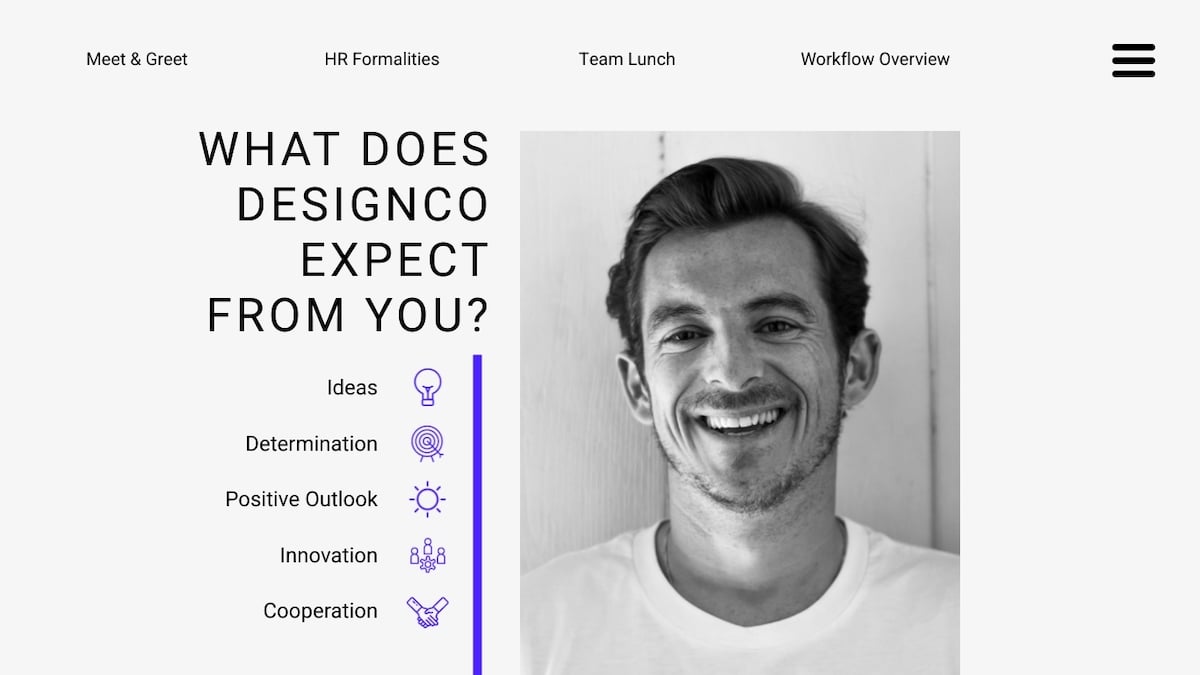
- Add bright and bold colors to make your presentation stand out and grab your audience's attention. Create a vibrant and dynamic look by using neon colors and duotones.
- Instead of using different transitions for each slide, use the same transition horizontally throughout your presentation. This creates a cohesive and visually pleasing flow.
- To create a sophisticated, minimalist look, limit your color choices to shades of a single color.
- Connect with your audience and make your message more relatable by incorporating personal anecdotes or stories into your presentation.
- Add depth and dimension to your presentation with isometric illustrations, which can be a fun and engaging way to present complex information.
- Sign up for Visme’s presentation software to start applying these creative presentation ideas.
105+ Creative Presentation Ideas
The ideas we've shared cut across various design concepts, industries and use cases. We've also sprinkled presentation design ideas from Visme's template library. If you're running out of creative steam, you can use these templates to jumpstart your designs.
And if you're running out of time, consider using Visme's AI presentation maker to bring these 100 creative presentation ideas to life. It's a user-friendly tool that effortlessly transforms your ideas into visually stunning presentations.
Now, let's jump into the creative presentation design ideas.
1 Use Neon Colors
Neon colors will give your presentation enough color kick to keep the viewer’s attention. Use neon colors either as the background, as specific elements or as details inside the slides. The trick with neon is to not go overboard with the contrasts. Instead of using a neon rainbow, think more along the lines of neon accents.
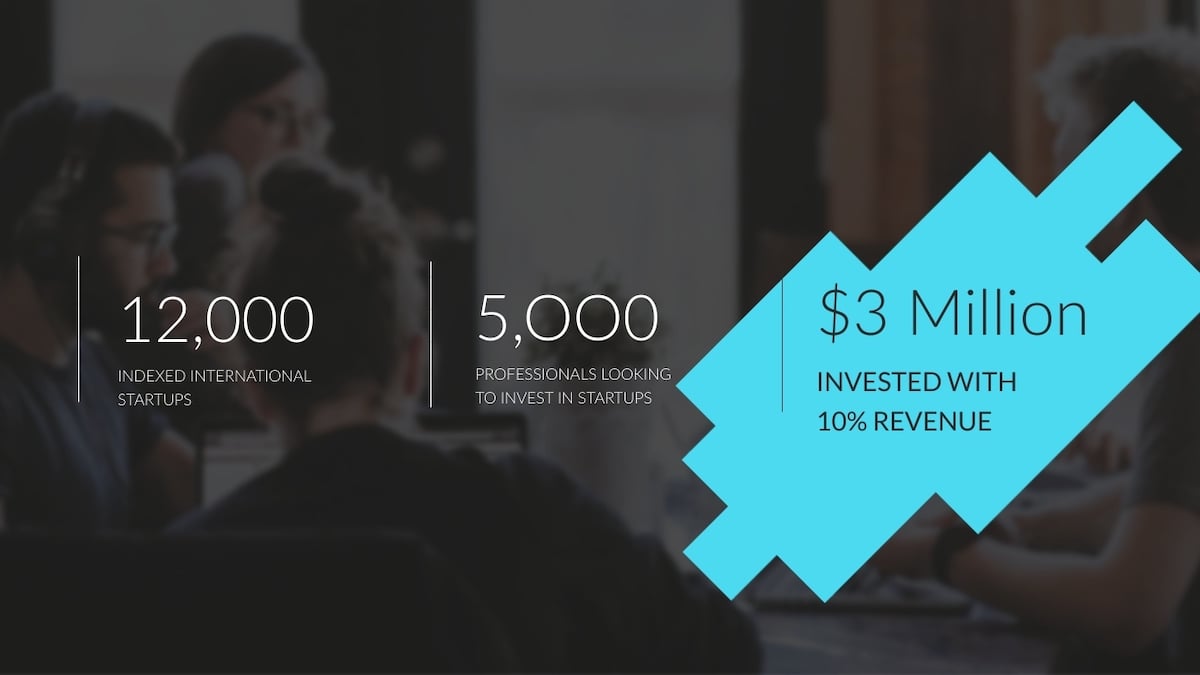
2 Be Minimal
Using a minimal design composition is one of the unique presentation ideas. The trick is to have just enough information and visual details for the viewer to feel comfortable seeing the slides. A minimal design can instill calm and awe in your audience when done right. The trick with minimalism is to know when enough is enough, you wouldn’t want to be boring instead of minimal.
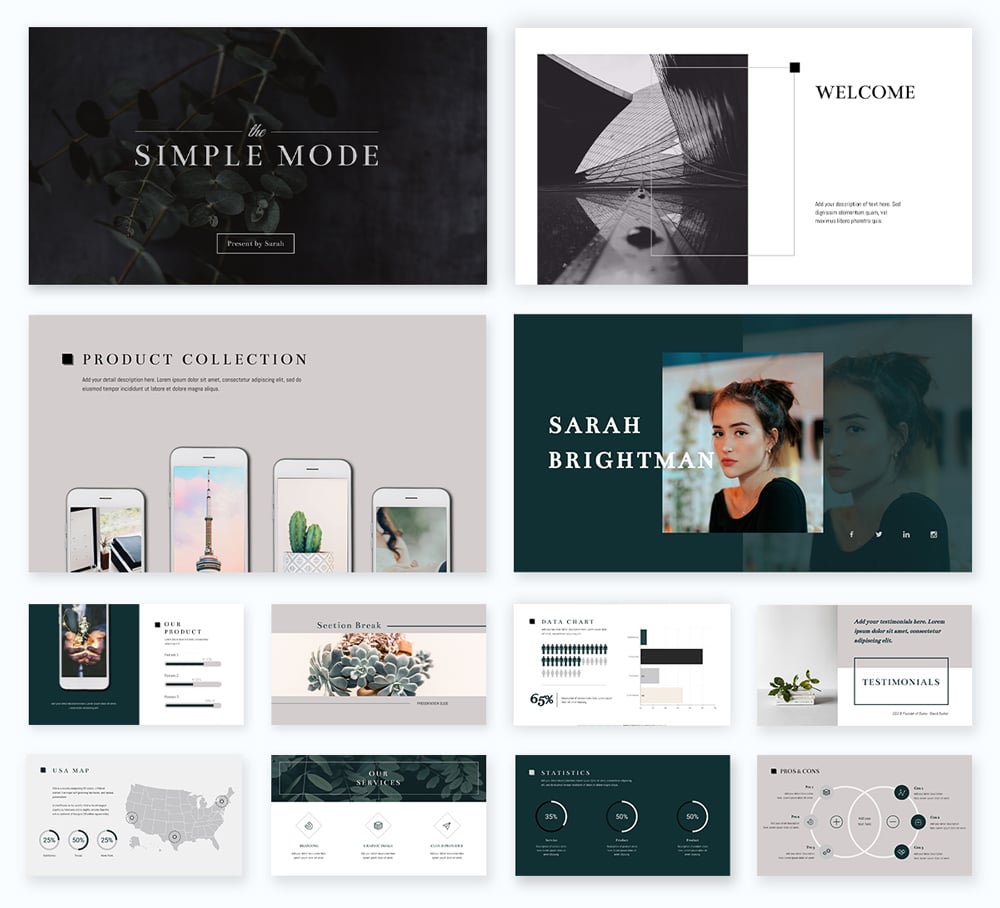
RELATED: 20+ Examples of Minimalist Design to Inspire Your Own Creations
3 Use all caps
Another creative presentation idea is using all caps when you feel like the topic of your presentation can be delivered with few words. Using all capitals in your slides will give the message importance. This design might not be suited for a text-heavy presentation but maybe one with an audio narrative that goes along with it or bullet points.
Also, this kind of presentation design is suitable for captivating introduction slide ideas.
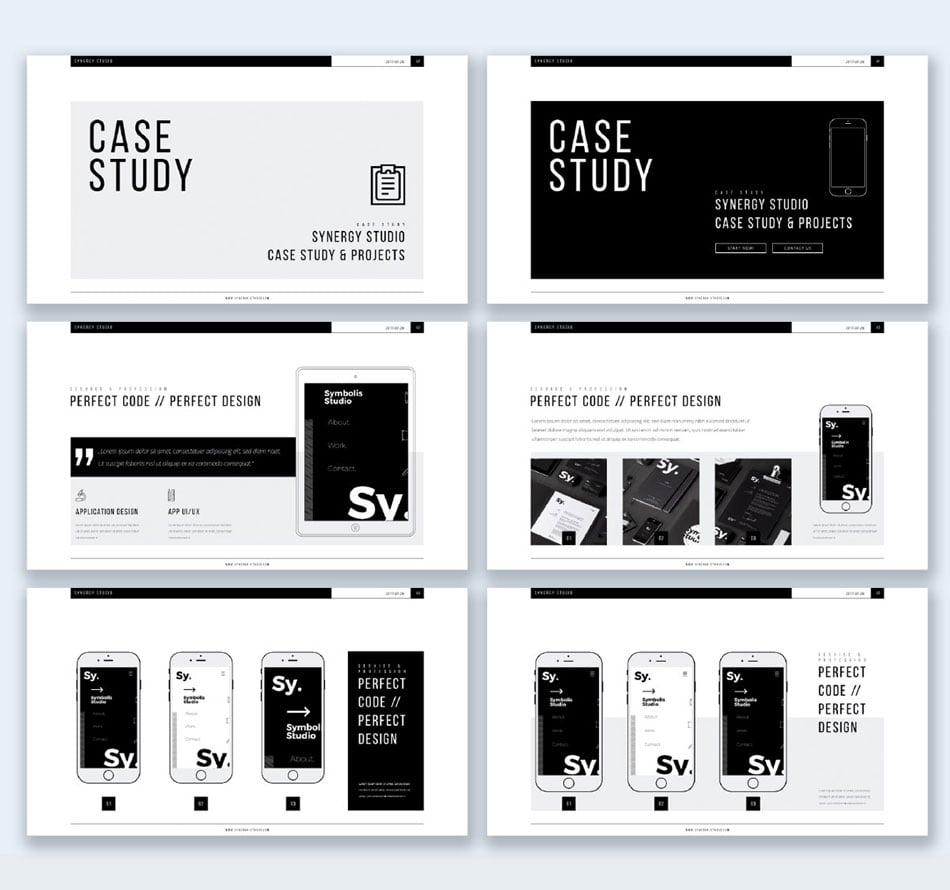
Image Source
4 Go vertical
Rectangular presentations are definitely the norm, but with the rise of Instagram Stories, this might be starting to change. This shift introduces a unique opportunity for those looking for ideas for presentation styles that stand out. Now that we can put archived stories into Highlights, why not publish vertical presentations there? Going vertical is just one idea. Along with that, you can add any other design technique.

5 Use duotones
Duotone doesn’t exactly mean “two colors,” it actually means “two tones.” The idea behind this design angle is to use two contrasting tonalities which can have different shades. The difference between duotone and two colors is that it has a more edgy look. Depending on what two tonalities you choose, it can be subtle or very powerful. The photos used in the design also need to be customized to the duotone color you chose.

6 Add a video in different shapes or snippets
Videos can be a powerful tool in your arsenal for engaging your audience during a presentation. Not only do they help to break up the monotony of a lecture-style presentation, but they can also help to explain complex concepts, add visual interest, and evoke emotions.
One way to make your videos stand out is by using different shapes or snippets. Rather than presenting a standard rectangular video, consider incorporating shapes such as circles, triangles or diamonds. These shapes can add a unique and visually appealing element to your presentation.
Another way to incorporate video snippets is by breaking up a longer video into smaller, bite-sized pieces. This can be particularly useful if you have a lengthy video that you want to show but don't want to lose your audience's attention. By breaking it up into smaller segments, you can keep your audience engaged and prevent them from losing interest.
Don’t worry about the design complexity. If you create your presentation in Visme, you can resize your videos instantly and turn them into any shape you want.
Hey marketers! Need to create scroll-stopping visual content fast?
- Transform your visual content with Visme’s easy-to-use content creation platform
- Produce beautiful, effective marketing content quickly even without an extensive design skillset
- Inspire your sales team to create their own content with branded templates for easy customization
Sign up. It’s free.

7 Unify transitions horizontally
Unifying the transitions between slides is always a great idea, but doing it horizontally is especially effective. By keeping all the movements going in one direction, it's both easy to follow and will look great. You don’t need to just apply horizontal transitions to the switch between slides, you can also apply animation to the titles and images. As long as they all go in the same direction, you are gold.
Create a slide deck like this in minutes.
- Search for the exact slides you need from a library of 900+ layouts
- Choose a classic or modern style
- Create automatically animated presentations
8 Black and white + spot of bright color
This presentation design idea is highly effective if you're looking for a creative way to present information.
Adding a bright color to a black and white scheme can add just the right amount of attention-grabbing detail to your presentation. Try choosing a powerful color so that it’s really noticeable and pops visually. You can use the color in small amounts or in large sections. Up to you, just remember to maintain a balance throughout.

9 Use a color theme
A cohesive color theme throughout your presentation can engage your audience and create a more visually appealing experience.
To start, consider the overall tone of your presentation and what emotions you want to evoke in your audience. Are you presenting on a serious topic, such as healthcare or finance, where a more subdued color palette may be appropriate?
Or are you presenting on a more lighthearted topic, such as creativity or innovation, where bright and bold colors can help to capture your audience's attention?
Once you have a general idea of your color palette, try to use it consistently throughout your slides. This means using the same background, font and accent colors for headings and graphics– like the presentation template below.
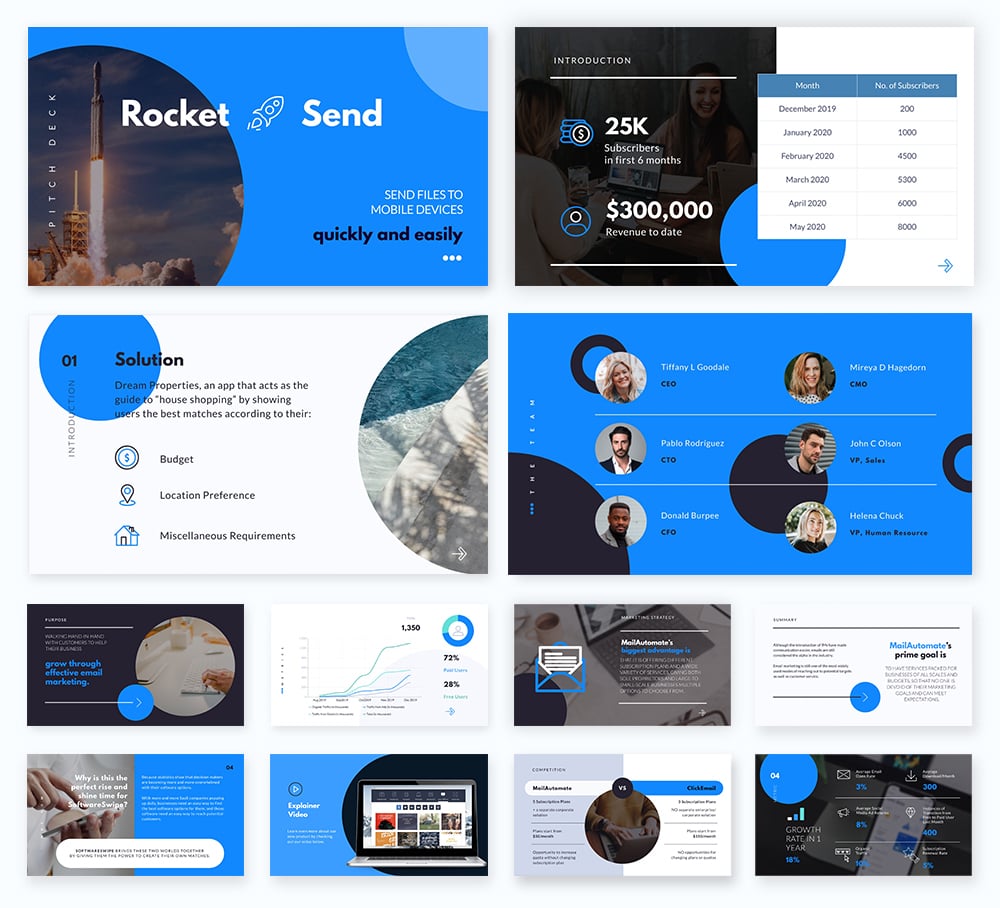
Visme's presentation templates offer a wide range of professionally designed themes with 300+ slides in 20+ different categories, making it the best choice for exploring creative presentation ideas without PowerPoint. You can create visually stunning slides with our carefully curated color schemes and stylish designs.
Read this article about 25 free presentation themes in Visme and find the perfect one.
Visme's presentation maker and branded presentation templates have been helping businesses create impactful presentations while saving them time and money. That's why many businesses choose Visme over other tools.
But don't just take it for word. Here's what one of our satisfied customers has to say about Visme.
"Previously we were using PowerPoint, which is fine, but the interactivity you can get with Visme is so much more robust that we've all steered away from PowerPoint."
"PowerPoint templates are plain and boring, and we want to create more fun and engaging content. Visme has multiple slide templates to choose from, which makes this so much easier."
"I just made a deck recently and it took me about 15-20 minutes. I found a template I really liked and tweaked it and put it in our brand colors. In PowerPoint, it would take anywhere from an hour to an hour and a half."
- Kendra Bradley, Graphic Content Developer at WOW!
10 Add full-screen videos
The use of full-screen video in your slides can have a big impact on your storytelling. There’s a catch though. The wrong video will be detrimental to your message, be mindful of the videos you chose to grace the background of your slides. The video should either tell your story without words or be a complement that won’t interfere. The wrong video will confuse your viewers and it will be hard to get their undivided attention back.
If you’re looking for quick idea inspiration, check out our YouTube video where Mike shares 30 of our favorite presentation ideas at a glance.

11 Use an 80’s visual style
If looking for a unique design style, why not try an 80’s style for a change. Neon graffiti writing, disco balls, and brightly colored shapes might go well with your presentation’s topic. You can use 80’s visuals as small complementary elements or as the entirety of the presentation style. Nevertheless, if your presentation is about something quite serious then maybe you should try another style.
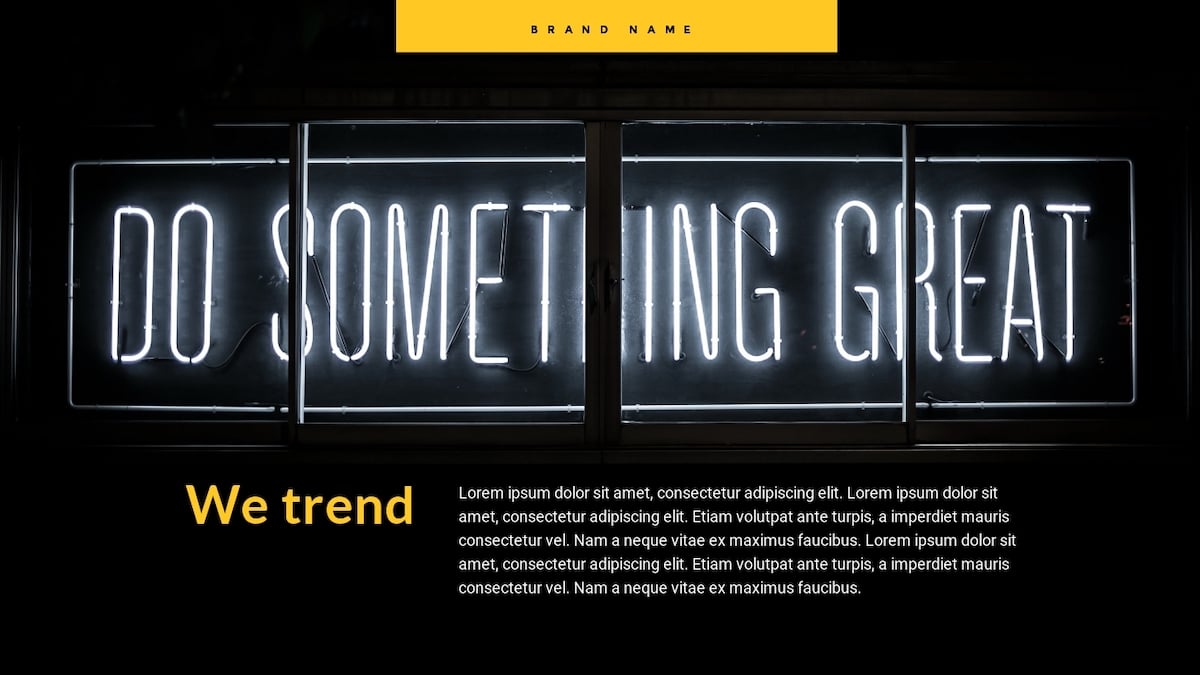
All you have to do is provide a text prompt, choose your preferred template style and the tool will generate text, images and icons and prepare a ready-to-use presentation within seconds.
The flexibility to customize these presentations in the Visme editor adds the perfect finishing touches to your visual storytelling journey.
12 Go vintage
Another creative presentation idea is the vintage look. This could work really well with a history-themed presentation or anything to do with recuperating old traditions. When we say “vintage” we mean sepia-toned photos, intricate picture frames, bold fonts which look like they came out of old posters.
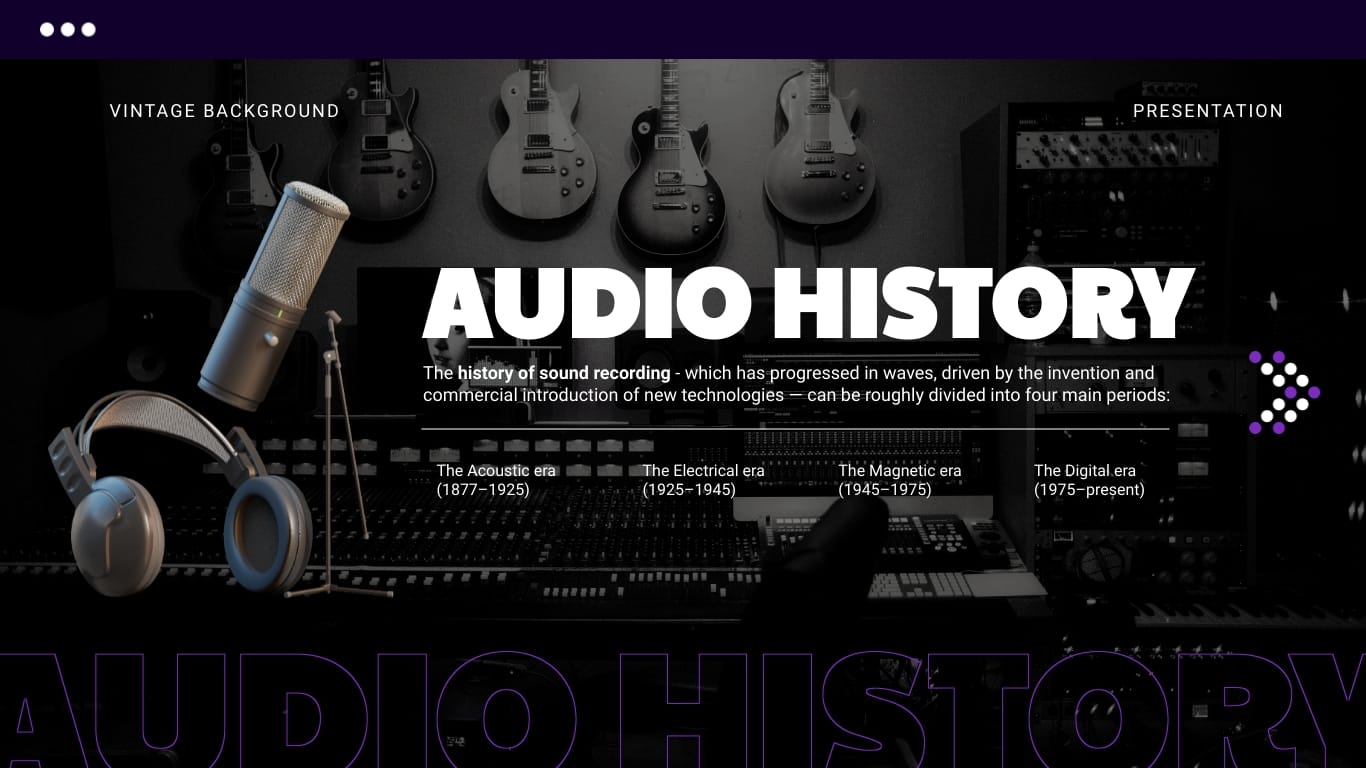
A vintage color palette is usually pastel turquoise green, ochre yellow and washed out blue and orange. You could consider using vintage mockup sets to create scenes for your slides, or use vintage style fonts, and old photographs as backgrounds.

13 Use a monochrome palette
A monochrome palette is one that maintains a single tonality in different strengths. For example, you can create a presentation in shades of blue, or in shades of orange. Use the palest shade for the background and a stronger shade for the titles and decorative shapes. Try doing it the opposite way as well. You can even use photos with a bit of a filter effect in the chosen color by adding a color filter.
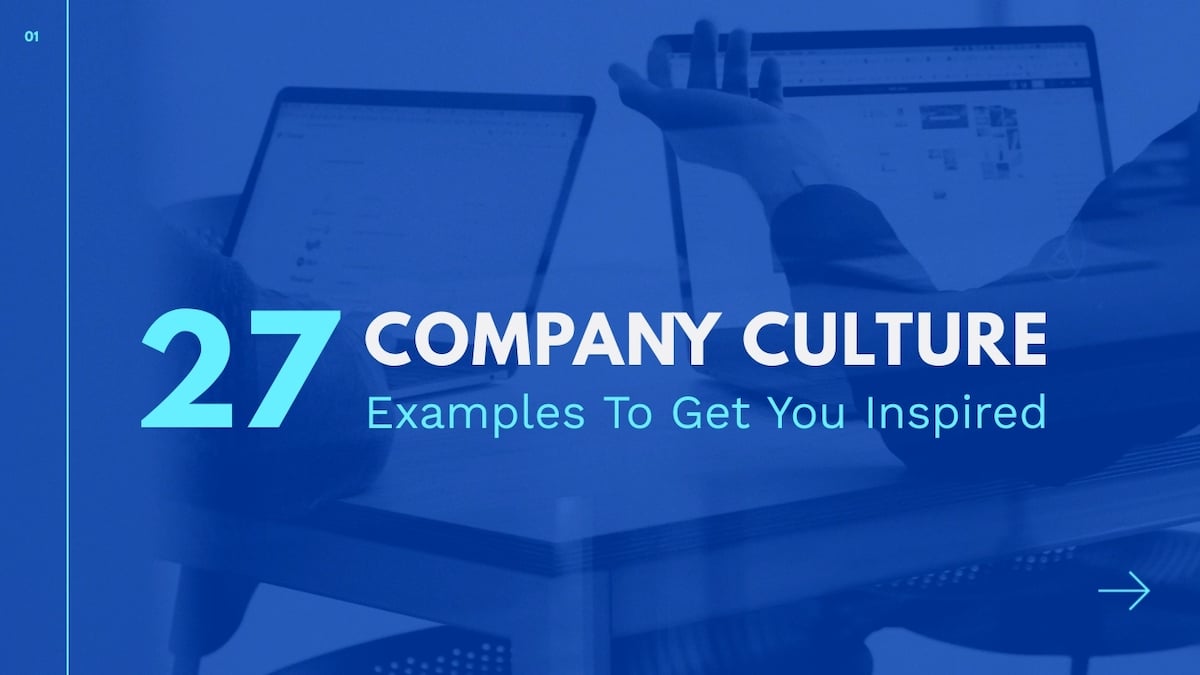
14 Tell a personal story
Telling stories from your own life—whether those stories are deeply moving, humorous tales, or just little snippets that allow someone to look into your history—can be a great way to make a presentation more meaningful.
Colin Stokes uses this to his advantage in his TED talk. He begins by talking about the movies he watches with his daughter and what she likes, and then moving into watching a movie with his son, and wondering how it has affected him, allowing him to move seamlessly into his actual points.
Watch the video below to learn how Colin Stokes did it

Choose a relevant story from your past, and tell it with all the honesty that you can. Your audience will feel that, sympathize, and therefore connect more with your message.
15 Creative photo crops
The photos in your presentations can be cropped hundreds of different ways. From simple circles or rectangles to more elaborate triangles, polygons, letter shapes or even a brushstroke. Analyze the message of your presentation to know which shape to use for the cropping of your photos. You can also create a collage with the shapes as long as they don’t distract from the information being presented.

16 Add fun illustrations
Adding fun illustrations is a great idea to engage your audience during a presentation. They can help break up text-heavy slides, make your presentation more visually attractive and reinforce your message, making it one of the best fun presentation ideas.
Hand-drawn doodles, icons and graphics and animated GIFs are all illustrations you can use. To maximize the visual impact of your illustrations, you can use them in 3D.
With Visme, you can enhance your presentation by adding 3D objects that allow you to customize their colors, size and alignment. Additionally, you can add 3D animated graphics to take things to the next level.
When using illustrations, it's important to remember to use them sparingly to avoid overwhelming your audience. Less is more when it comes to adding graphics to your slides. Remember to match the illustrations with your theme and color scheme to keep things consistent.

17 Thick and bold fonts
Huge chunky fonts are a great way to call attention to titles on slides. You could even try making the letters bleed over the edges or place the words vertical along the side. The best thick and bold fonts are the ones with minimal decorations. Try using fonts that have strong corners or the opposite, extreme rounded terminals. It will also work best if the title is short and sweet.

18 Go with nature
Freshen up your presentation with some natural elements around the edges or as a background. You could use full-screen background photos of leaves or palm fronds coming in from the sides of the slides.
Another presentation idea would be to use nature-related photography along with other design ideas like interesting photo crops. This technique could be used for presentations that relate to nature or natural topics, but also for a home decor proposal or creative direction pitch for a TV ad.
Integrating nature into your slides is a beautiful presentation example of how to connect with your audience on a different level. This technique could be used for presentations about environmental topics or even about home decoration.
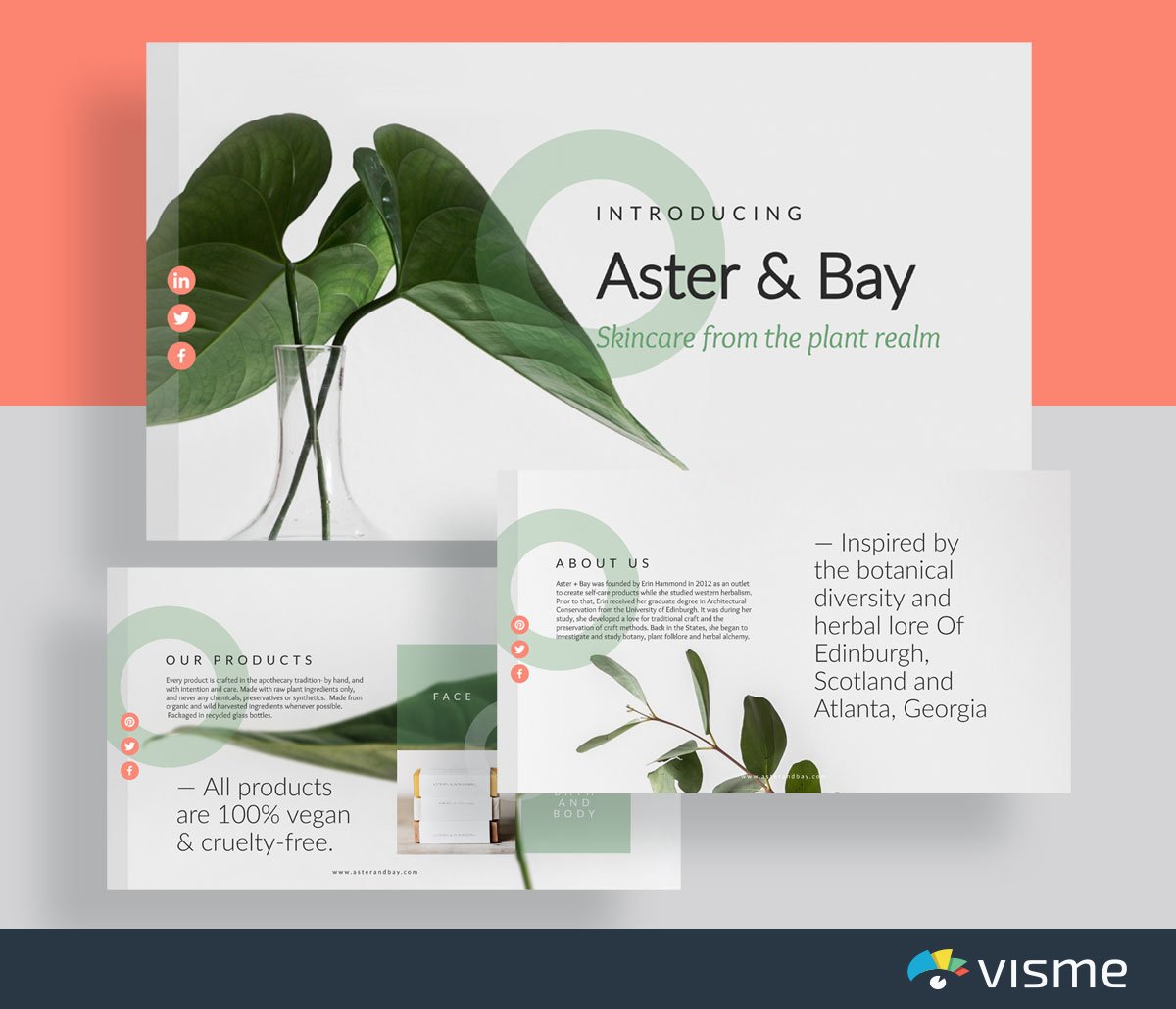
19 Use circles
Circles represent wholeness and a natural sense of completion. They can signify eternity and constant movement. They can also make your presentation more friendly and emotionally accessible. You can try using circles as decorative elements or as the shape for cropping images and as backgrounds for illustrations.
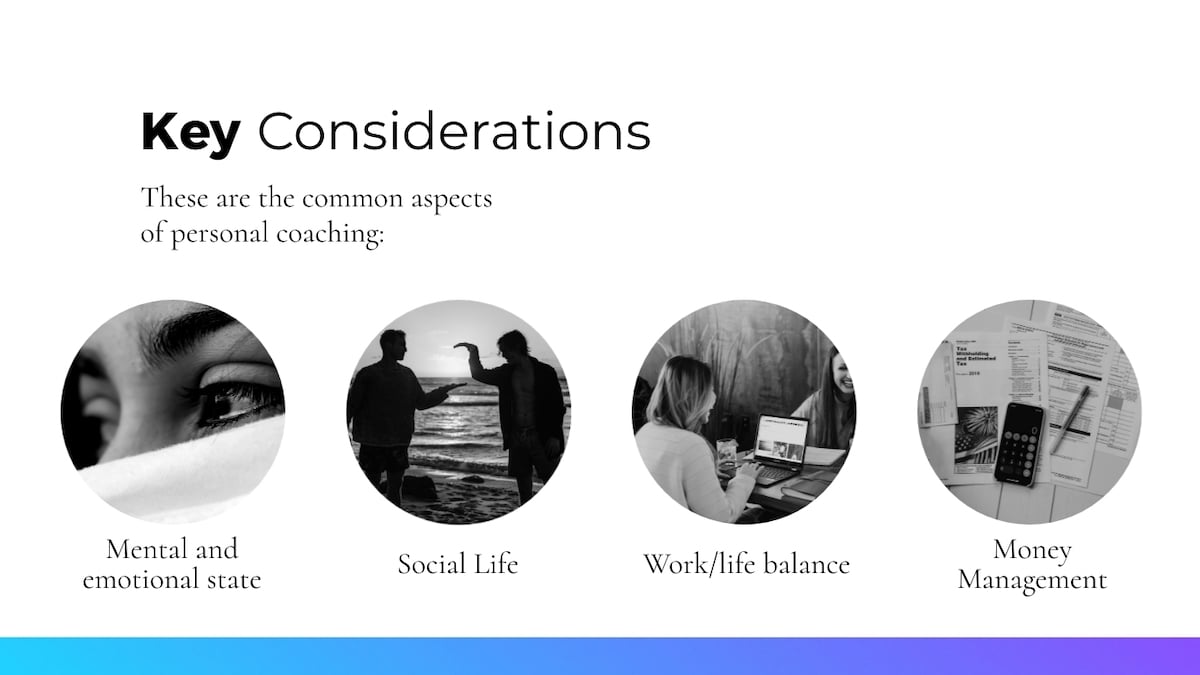
20 Add some sparkle (glitter backgrounds)
Give your presentations a little bit of a festive feel with some glittery details. This PowerPoint idea can work great if you are presenting a creative proposal for a fashion label or clothing catalog. It can even work really well for holiday-themed pitches or products. There are different types of glittery graphics you can use, like a glitter texture, a glittering rain or even just a dash of glitter. You can find some great glitter backgrounds and textures over at Freepik .

21 Get crafty (ripped paper details)
Sometimes to tell a story, visual details can really help get a mood across. Ripped paper shapes and edges can give a presentation a special feel, almost as if it was done by hand. This visual technique works for any type of presentation except maybe in a corporate setting. Ripped paper can be found on creative graphics resource sites or you can do it yourself and take a photo.

22 Cut-out paper illustrations
Another crafty idea to design your slides is by using cut paper illustrations. This technique could look really crafty or quite elegant if done well. Cut paper can be used as an elaborate background, as the letters in titles or as decorative elements. There are some great cut paper bundles online to use as PNG files which can be uploaded to the Visme editor.

23 Pathway transitions
Create interesting transitions by designing scenes or pathways instead of just sliding them in one unified direction. By doing this, you can use a storytelling technique that will keep the audience’s attention throughout the presentation and information relay. You can find out how to do it in our free guide to creating captivating presentations .
Create an automatically animated presentation in minutes.
24 use isometric illustrations.
If you are looking for a different way to illustrate your slides, why not consider using isometric illustrations? This style of illustration is great for explaining things that can be separated into parts. The parts can be animated as well. An isometric illustration can work for any kind of presentation, from technology to corporate. It will give your presentation a modern edge and a professional look.
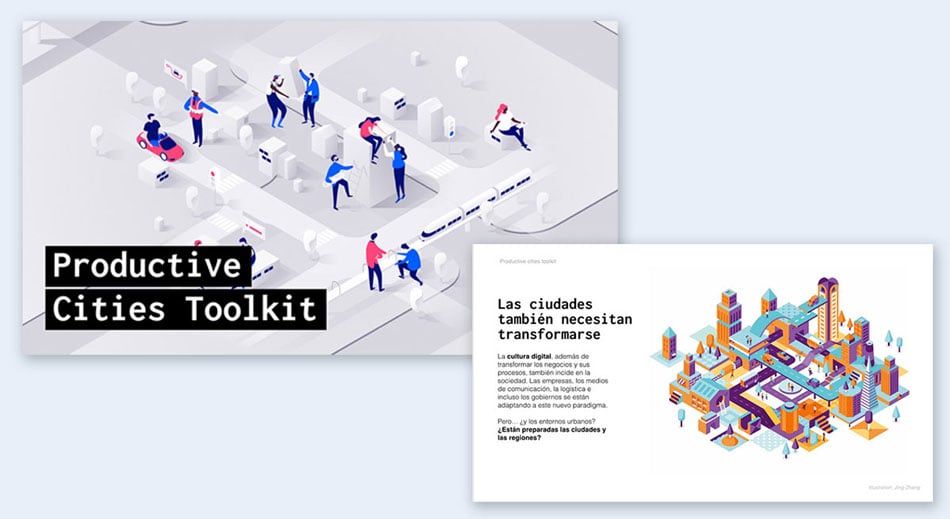
25 Use motion graphics
Motion graphics are a great way to illustrate an idea with animated objects . They don’t tell stories on their own, they support the context and illustrate the content.
For example, if your presentation is about travel, you could have flying airplanes across the slides or bags on a luggage conveyor belt. For something more abstract, you can use moving shapes and add effects to the titles. Your Visme editor has a variety of design tools to help you create all sorts of content with motion graphics.
Here’s what one of Visme’s satisfied customers Jessica L. | Small-Business Owner, has to say about Visme’s presentation tool:
"No need to go back to PowerPoint. Visme makes project presentations easy and fast. Lots of useful templates and excellent graphics. I enjoy the features they continue to add and update often. They make project work easy".
26 Add GIFs to your slides
GIFs can be fun, entertaining and humorous. They can also be informational. GIFs be sourced from sites like Giphy , where you can also create your own! Choosing to include a GIF in your presentation slide or a few different GIFs will depend on what message you want to send with your story. The theme and topic of your presentation will help you decide if you need a clip from a blockbuster movie or a quick representation of the process of your systems.
RELATED: Everything You Need to Know About Using Cool GIFs in Your Marketing
27 Use quotes between slides
Quotes can be good breathers between a bunch of informative slides. You can either use them to separate ideas inside your presentation or to start new sections of information. It’s important that your quotes represent the topic of your presentation so that they make sense and not confuse the viewer.
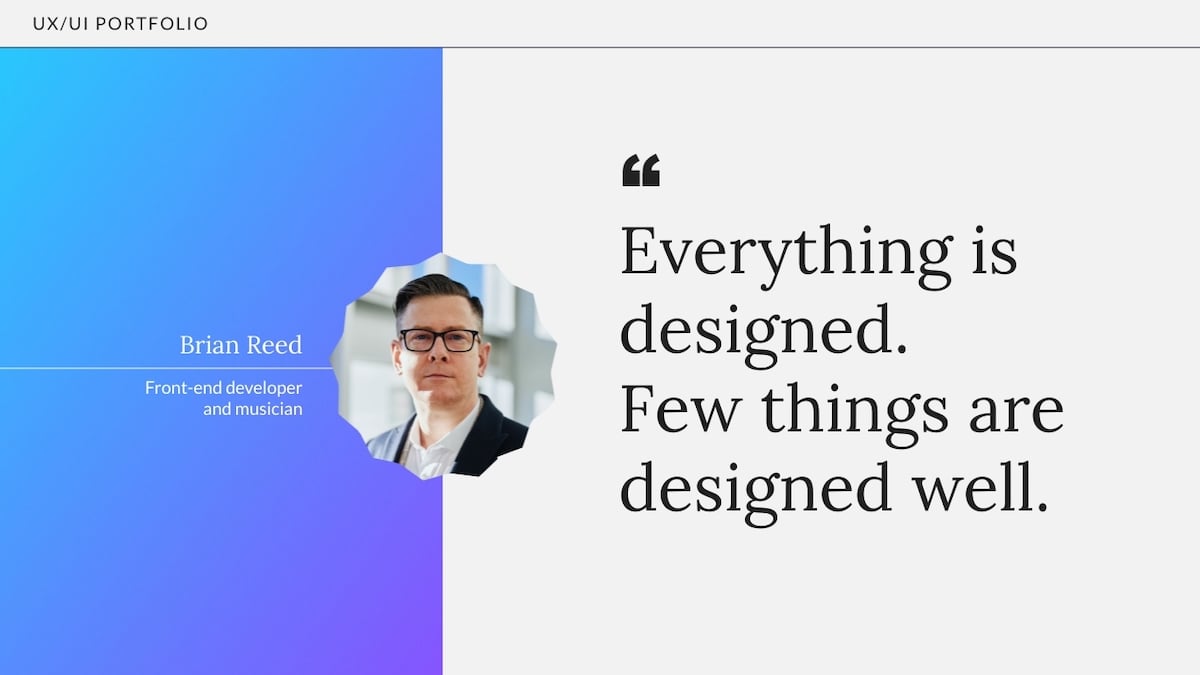
28 Start with “once upon a time”
One of the most effective and engaging ways to present a presentation is by incorporating creative storytelling techniques.
If a presentation can be created as a story, then why not go all the way and start the presentation with a classic story opening? Using the “once upon a time” phrase will instantly grab the viewer’s attention because it will be out of the ordinary. Make a slide especially for it with a visual that matches the topic of your presentation.

29 Turn the slides into a scrolling infographic instead of a presentation
To showcase your content in a unique and engaging way, consider using creative slide ideas that break away from the traditional slide-by-slide approach. For instance, you can arrange your slides vertically to create a scrolling infographic instead of a classic slide-by-slide transition presentation.
This innovative format expands the types of presentations you can create, offering a fresh perspective on information delivery.
An added bonus to this presentation style is to add parallax scrolling or interaction animation. As the viewer scrolls down, the information fills each slide progressively. It doesn’t continue until the viewer scrolls again. This technique is best for displaying online slide show presentation ideas.
Create a scrolling presentation in minutes.
30 engage your audience.
What’s one of the best ways to make your presentations more interesting? Make the audience a part of them.
Regardless if you’re presenting in person to a room full of people or via Zoom to viewers around the world, there are a number of techniques to engage your audience with both your content and yourself. The trick is to make them feel connected somehow, like they can relate. You can achieve this with humor, storytelling, asking questions and inviting them to leave comments in the webinar chat window.
Take this speech by Donovan Livingston. He delivers a commencement speech in spoken word poetry, and specifically encourages the audience to take part, saying they should clap, throw their hands in the air, or otherwise participate if they feel so moved. While not seen, several people are heard cheering and clapping throughout the video.
Participation can also be accomplished through things such as games, posing questions or something as simple as asking participants to raise their hands.
31 Use a scrunched paper background
Give your presentation a laid-back and grunge feel by designing it with a scrunched paper background. It can be any kind of paper really, depending on your topic. It could be notebook paper, or printer paper, it could even be recycled paper. Try a few different types of paper until you find the one that suits your story.
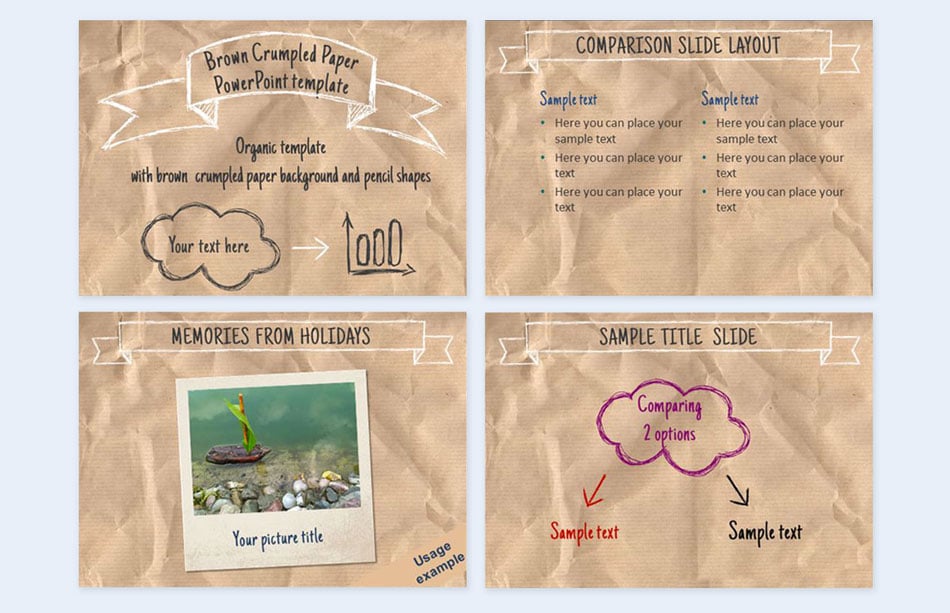
32 Add interactive pop-ups
Adding interactive pop-ups is a game-changer when it comes to creative ways of presenting. These pop-ups allow you to go beyond the traditional approach, giving your audience a more dynamic and engaging experience.
Interactive pop-ups can take many forms, from quizzes and polls to clickable infographics and interactive timelines. With Visme, you can access various interactive features that can help you create engaging and effective presentations.
For example, you can create clickable icons or buttons that allow your audience to explore additional information or resources. You can also create interactive timelines that enable your audience to explore different events or milestones.
One of the most powerful interactive features of Visme is the ability to create quizzes and polls. You can make interactive questions and answer options that allow your audience to engage with your presentation on a deeper level.
You can also use this feature to gather feedback from your audience, allowing you to tailor your presentation to their needs and interests.
Watch the video below or read this article to learn how to create an interactive presentation .

33 Use a back-to-school theme
A back-to-school theme can make your presentation look like a lot of fun. This is a great technique for teachers and educators welcoming their students back to a new school year. The background can be a sheet of notebook paper, an open notebook, or a blackboard. The edges could be decorated with pencils and paperclips, maybe an eraser or sharpener. The back-to-school theme has lots of possibilities.
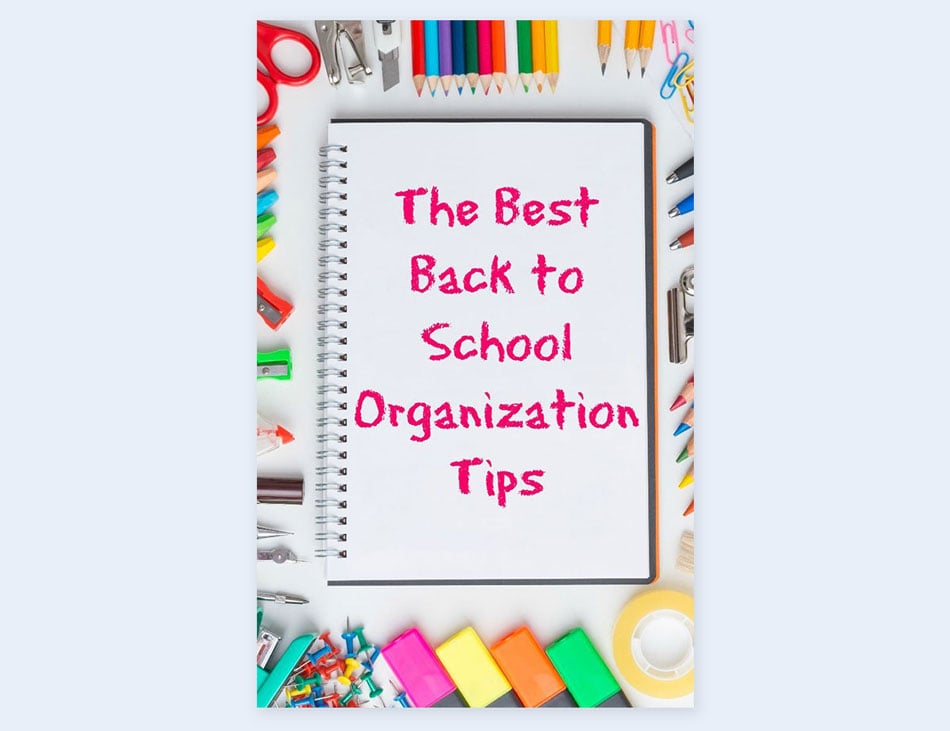
34 Use a billboard-inspired theme
Use billboard mockups to create slides which look like billboards. This could look interesting and quite unique. You could use the same billboard for all the slides, or different ones for a more varied approach. This technique would work great with a pitch for an election or a local spot in a government office.
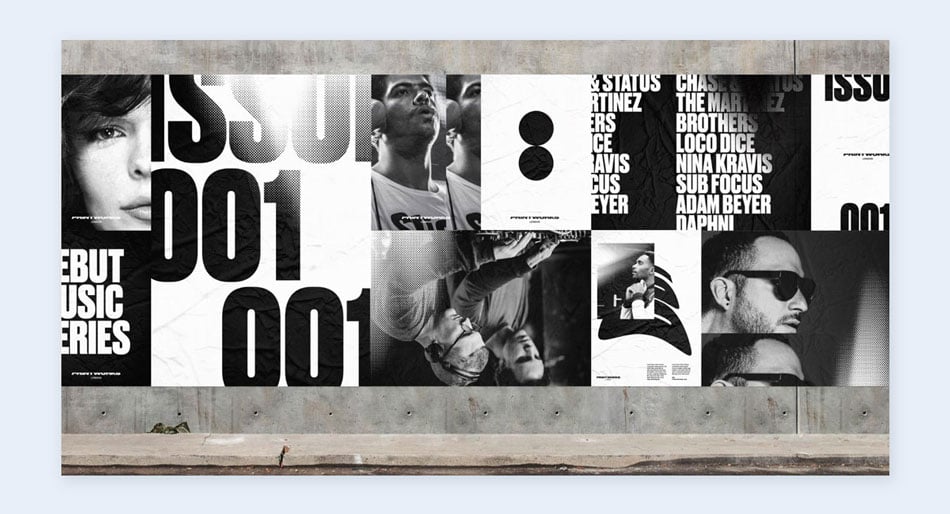
35 Use black-and-white photography
Black and white photography is a classic design technique. They import elegance and sophistication to any design by providing a minimalistic approach to the visuals. The photos can either be desaturated from color photos or given an artistic flair with extra contrast and fewer grey tones.
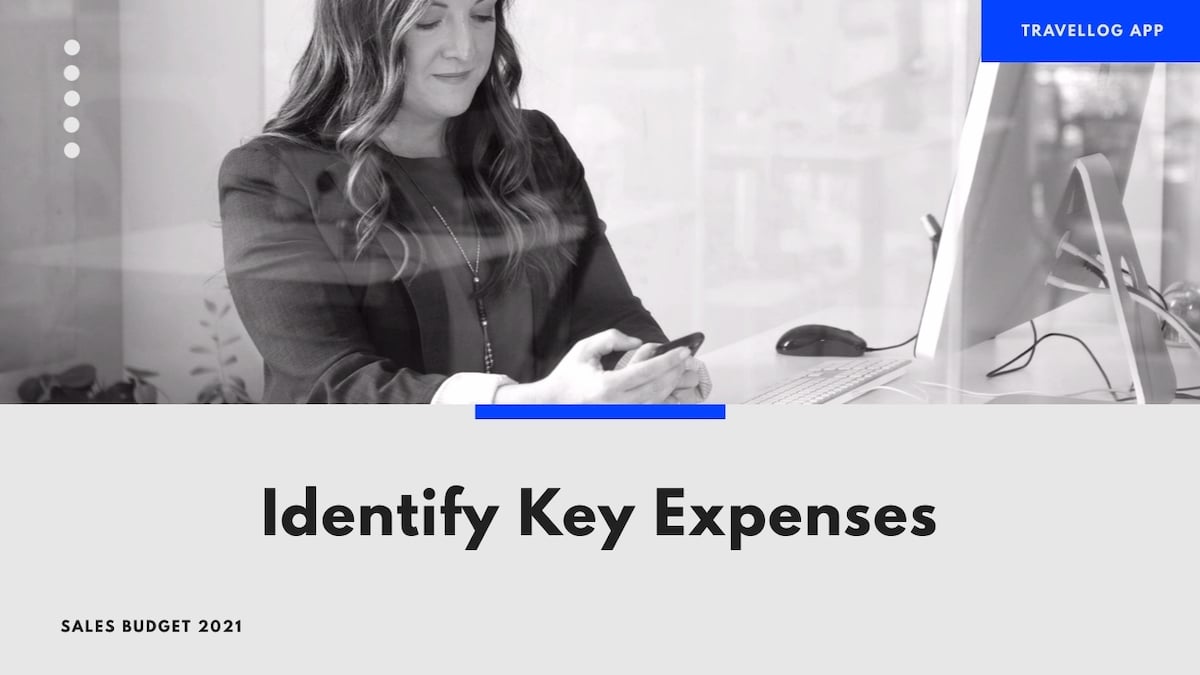
36 Explain your reasons
What people really want to know is why you’re giving the presentation you’re giving. This is especially true if you’re pitching to investors or potential new clients. When you share your why with the audience using storytelling and body language, you make meaningful connections and lasting relationships
Simon Sinek explains quite well why this is so important—the greatest leaders, the ones who inspire the most people, understand why they do the things they do, rather than just what or how.
When it comes to explaining your reasons, one tool that can significantly improve your presentations is Visme's AI writer . This advanced feature helps you write your presentation copy, break down complex ideas and edit or improve your existing words. With Visme's AI writer, you can make sure your "why" is clear and easy to understand alongside your visuals.
37 Add an audio narrative
Your presentation doesn’t need to be silent, especially if you won’t be standing by it to tell the story yourself. Adding an audio narrative can turn a viewable presentation into an experience. You can either set it up as a video that runs on its own and the viewer looks and listens, or it can be triggered by arrows that are clicked on.
RELATED: How to Create a Narrated Presentation With Voice Over Using Visme
38 Follow a space theme with photography
Most of the photos from Nasa are labeled as public domain. Meaning that you can give your presentation a space theme quite easily. Choose images of astronauts in space or more abstract and colorful images like distant galaxies and nebulas. The latter can make great backgrounds behind content without the topic necessarily being about space.
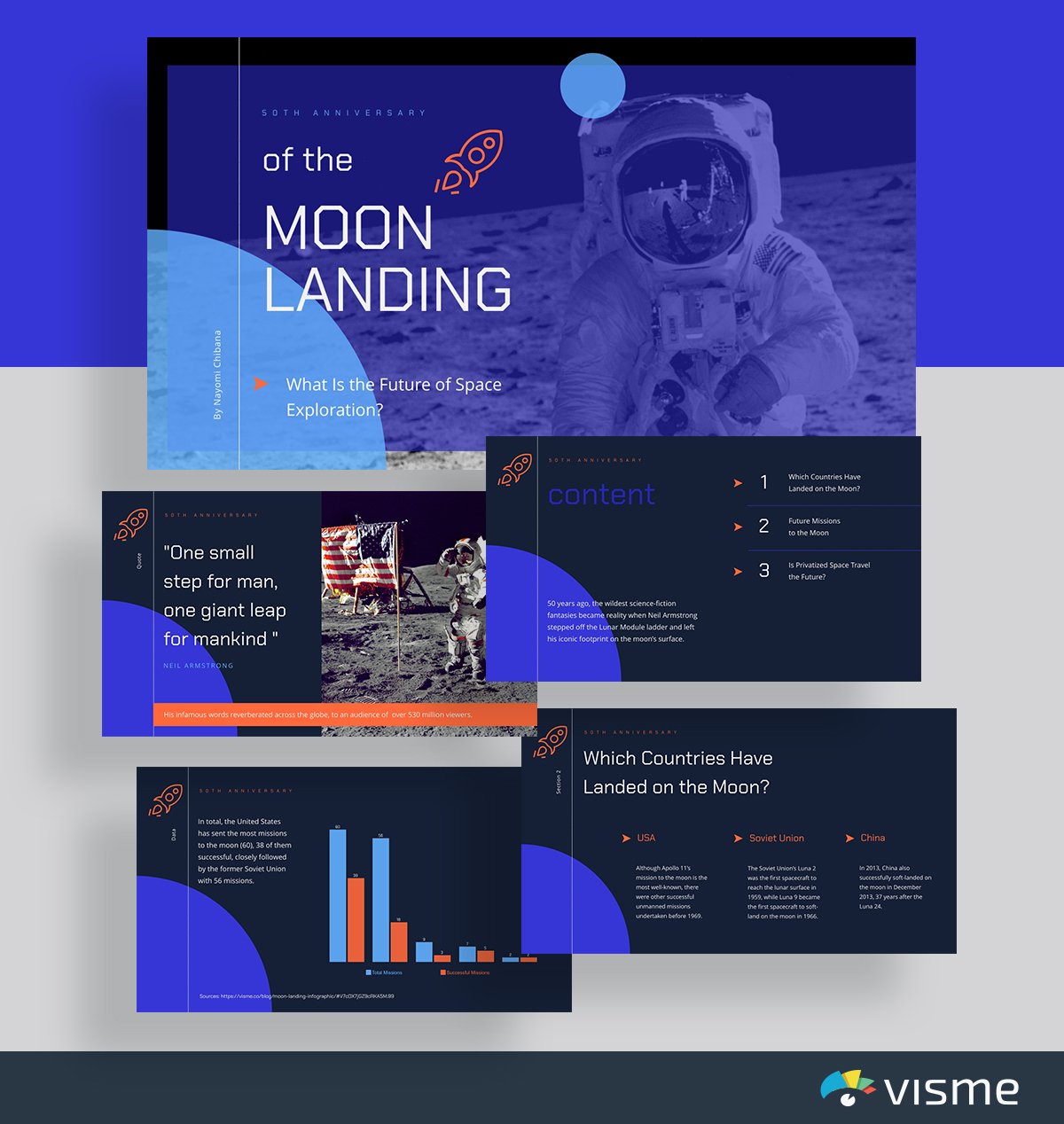
39 Do a space theme with illustration
An illustrated space theme can be either colorful and whimsical or sober and elegant. By choosing the style of illustration you use, you can either use this technique for presentations related to children or scientists. Cartoon astronauts can be lots of fun, line illustration planets can be educational and data-driven drawings can be informational.
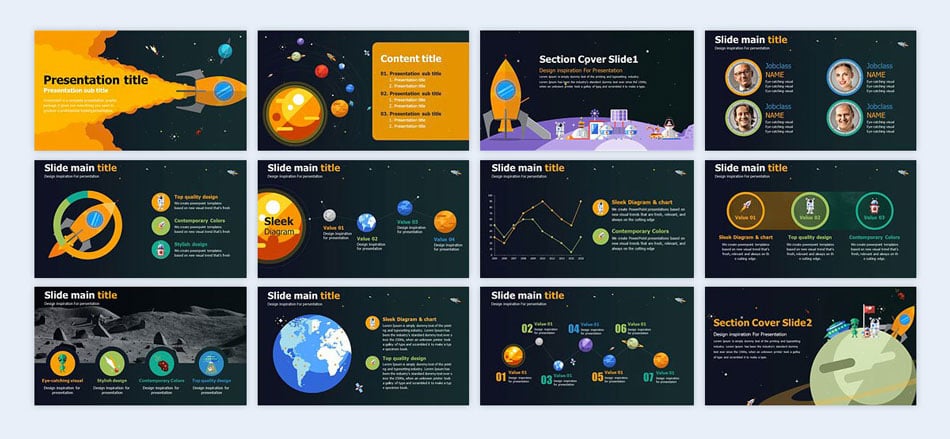
40 Include music
Sometimes, when listening to someone talk for long periods of time, it helps to have something else to draw your attention. While images are great, including music can really help stimulate an audience and set the mood.
Dean Burnett talks about why this happens: “[Music] provides non-invasive noise and pleasurable feelings, to effectively neutralize the unconscious attention system’s ability to distract us.” Essentially, music is entertaining enough that, when in the background, can keep us focused on otherwise un-entertaining things.
Take, for example, this valedictorian’s speech. While peppered with humor and stories of his time through high school, he uses background music to help keep people’s attention—in fact, this is specifically stated to be his reason for including music, humorously quipping about giving the audience something to listen to while they “zone out” of his speech.
Whether incorporated into individual slides, in a video, done live, or with a music-playing device nearby, this creative presentation idea can be a great way to enhance the quality of your speech or talk.
41 Graffiti photography backgrounds and details
Using colorful backgrounds like photos of urban graffiti can give your presentation a bit of an edge. There are lots of free photographs of graffiti on sites like Unsplash which you can use straight away. Apart from graffiti murals, you can also incorporate graffiti letterings in your titles and quotes. You can find graffiti style fonts online quite easily.
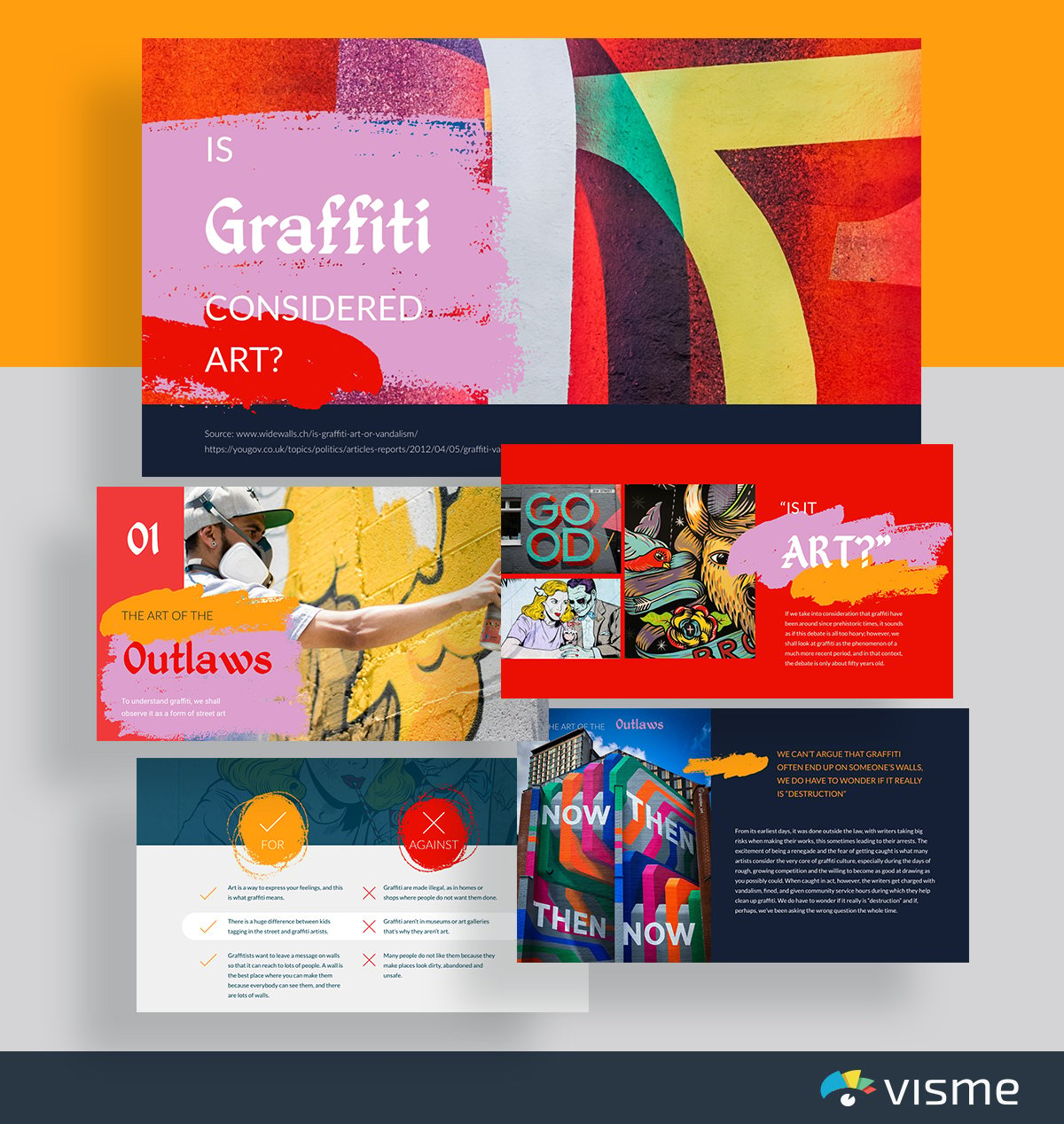
42 Stop-motion
The stop-motion technique can take time but it can also make your presentation unforgettable. There are lots of ways to use stop-motion, either with characters doing actions or objects that move around and create a scene. Stop-motion can also be used to create titles that move into place. What the title is written with can be anything, from toys to plants. The theme and topic of your presentation will ultimately be the driving point to what kind of stop-motion can be used. But be sure that it works from educational to promotional to corporate.
43 Claymation
Very similar to stop-motion, claymation is the animation of things created with clay or play-doh. Anything can be created with clay, so the possibilities really are endless about what can be achieved. This technique really does take a lot of time, you can source it out to a professional or buy some already created footage. The claymation can be just a decorative element in the background or it could also be the center of the presentation.
44 Color blocking
The color blocking technique is another creative presentation idea that entails using color in large sections and in contrasting tones. The idea is that the color blocks will be strong and colorful. The color blocks can either be the shapes that determine where the information goes or just a way to separate the slides in specific sections.
Any type of presentation can benefit from color blocking. Just make sure you use colors that go together and don’t clash. Explore this technique for different presentation slide ideas, especially when aiming for a bold and visually striking effect. Take a look at this sponsorship deck and how it uses bright and bold color blocking techniques.
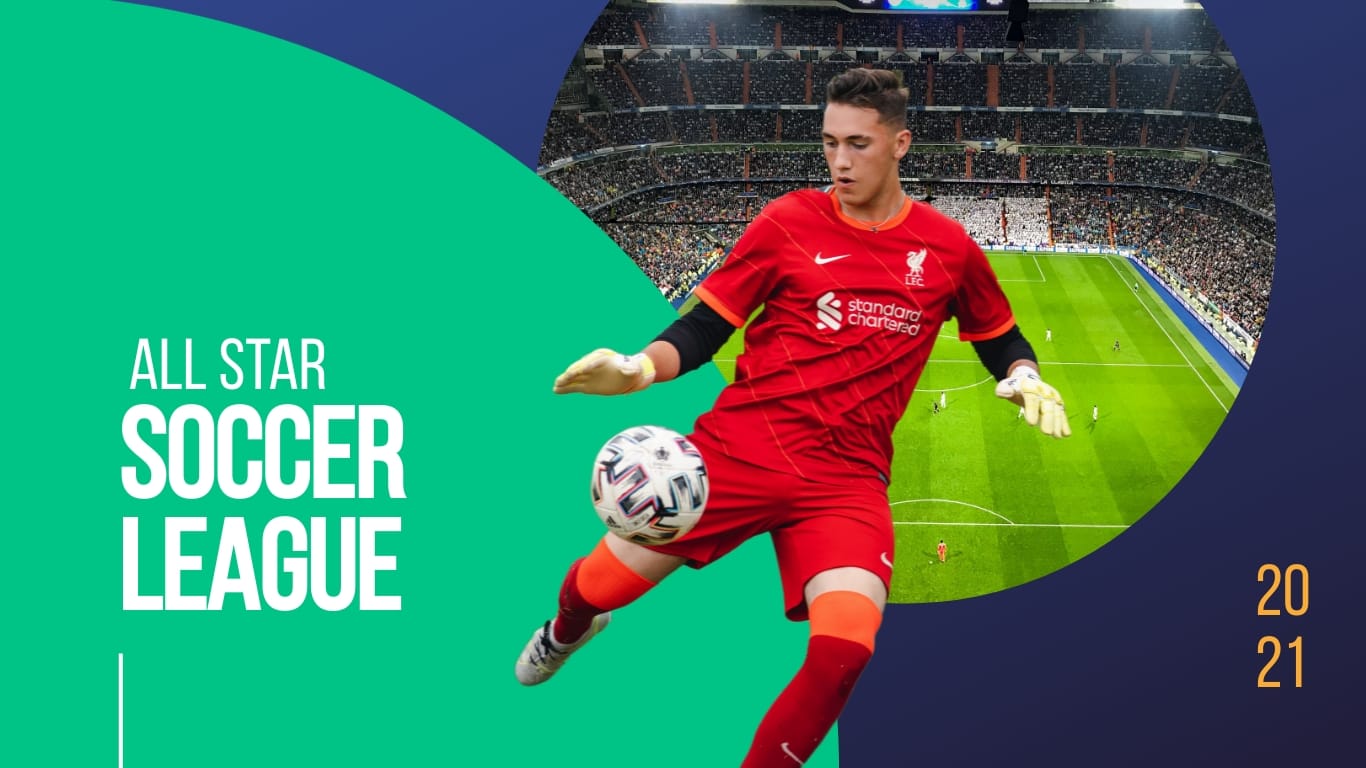
45 Get surreal
Surrealism is an avant-garde movement from the 20th century which was meant to tap into subconscious creativity. This might not be the kind of design technique for any sort of presentation but it can work for one that is about art, or literature or other creative outlets. There are plenty of surrealist artworks in the public domain sector or the Metropolitan Museum of Art. These can be used as subtle backgrounds or visual complements to the text.
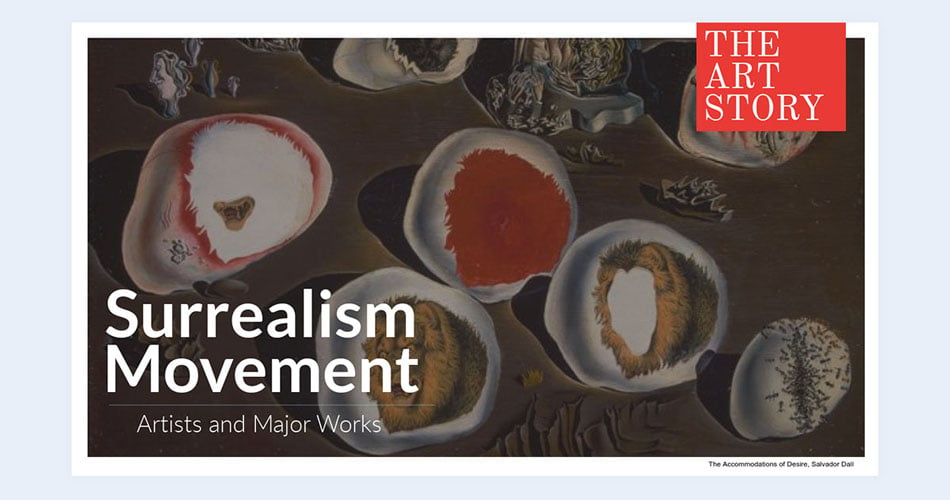
Designing a presentation for an organization requires input from different stakeholders. However, when collaborating with others on a presentation design, keeping track of all the moving parts can be difficult.
That's where Visme's workflow management feature comes in. It helps organize roles, tasks, progress, deadlines and corrections all in one place to make your presentation design process efficient and smooth.
46 Polaroids
Polaroids, often a photography favorite, can inspire creative photography presentation ideas. The original Polaroids from the 70’s could be used as vintage polaroids that have been kept in a box for years. The newest Instamatic photographs, which are the new kind of polaroids, can be used for a fun way to show photos and visuals in presentation slides. You could either use one polaroid per slide or a collection of polaroids on a table or corkboard.
There are many topics that can work with Polaroid photography backgrounds and details in your slide show presentation ideas.

47 Use a Handwriting Font
Fonts come in all shapes and sizes, including lots of handwriting fonts. Handwritten fonts can be used for any type of presentation as long as the style matches the topic of the information. There are kid-style handwriting, calligraphy style handwriting, hand lettering, and novelty fonts as well. The options are wide and varied for this design technique. Creative Bloq has a great collection of handwritten fonts.
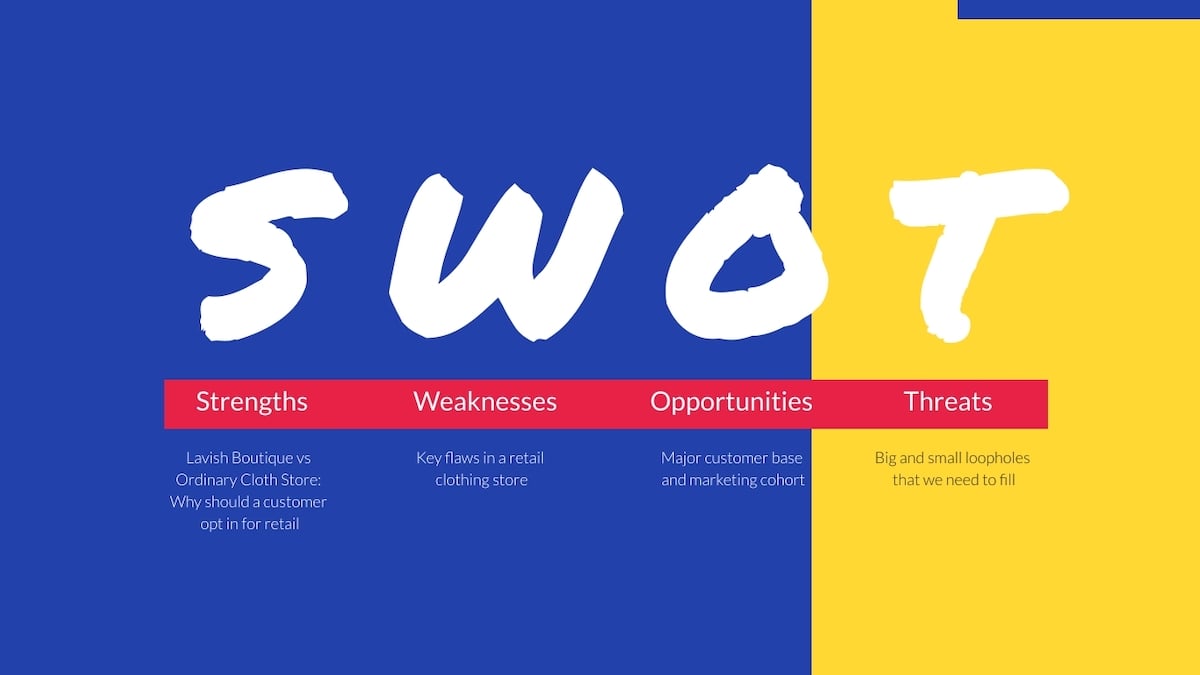
48 Use a geometric background
A geometric background can look really nice on any presentation. Geometric backgrounds can be tiled polygons or more abstract compositions of different size polygons. The decision to choose between tiled shapes and more creative compositions will depend on your creative angle and disposition. You can use these types of designs with any colors, so you can match the theme or your brand.

49 Coffee style design
Using a coffee-style design can work for any PowerPoint presentation idea, from office-related topics to digital nomads to anything or anyone who loves coffee. If the background is subtle, it can fit a more serious topic or data report. It can make a boring presentation just a bit more visually entertaining than the rest. Of course, it can also be perfect for a small coffee brewer pitching their company to investors.

50 Include memes
You’ve seen them everywhere by this point. You might be pretty sick of them. However, that doesn’t mean memes can’t be useful—in fact, using a couple strategically can surprise the audience and make them laugh.
The presentation " Memes, Memes Everywhere" focuses on, unsurprisingly, memes, and explains their purpose while using examples on every slide, which help support their points and add some humor to a very text-heavy presentation.
Choosing relevant memes and using them sparingly can really help add some personality to your presentation, without distracting from the work.
RELATED: 85+ Best Free Presentation Templates
51 Polka dots
Using a polka-dot background is suitable for various types of presentations. It can give your presentation a whimsical look or simply give it a subtle texture. The polka dots could be small and soft or big and punchy. A strong polka-dot background can work great in a creative setting or even boring data analysis. The style of polka dots will depend on the general topic of your presentation. You can use the polka-dot design as a full background or as a decorative section on the slide.
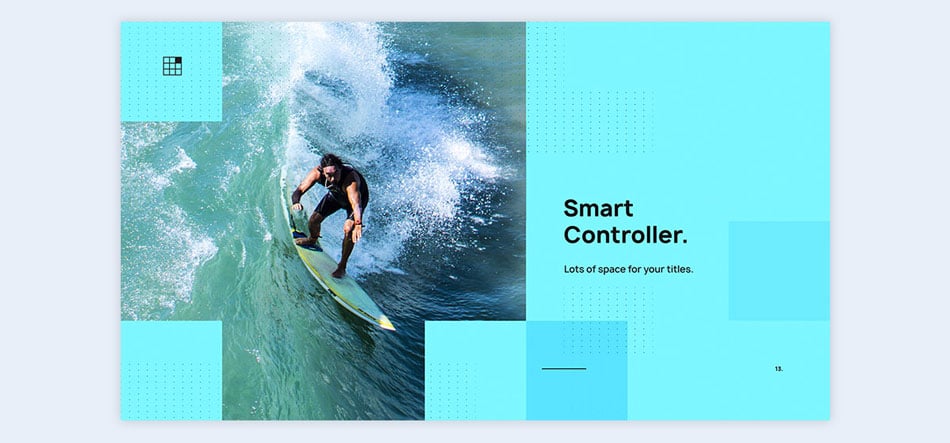
52 Metaphors
Visual metaphors can be useful in a similar manner; they can spice up your presentation, illustrate your point, and make your work far more entertaining. James Geary speaks about just how important metaphors are.
His presentation provides several examples of metaphors--such as the phrase “some jobs are jails”--and explains just how hard it is to ignore the lasting power of a well-used metaphor. Because of the connotations a metaphor can bring to the table, their use is an excellent way to imbue added meaning to your words.
53 Use timelines in your slides
Timelines can be used in lots of different ways inside a PowerPoint presentation, and the ideas are limitless. A timeline can either be inside one slide, or it can be connected between various slides. You can make a timeline with icons, connected shapes, or an inclined line. The timeline can be a visual way of explaining a chronological event or a plan of action that needs to be taken care of. Make sure the timeline fits the rest of the theme.
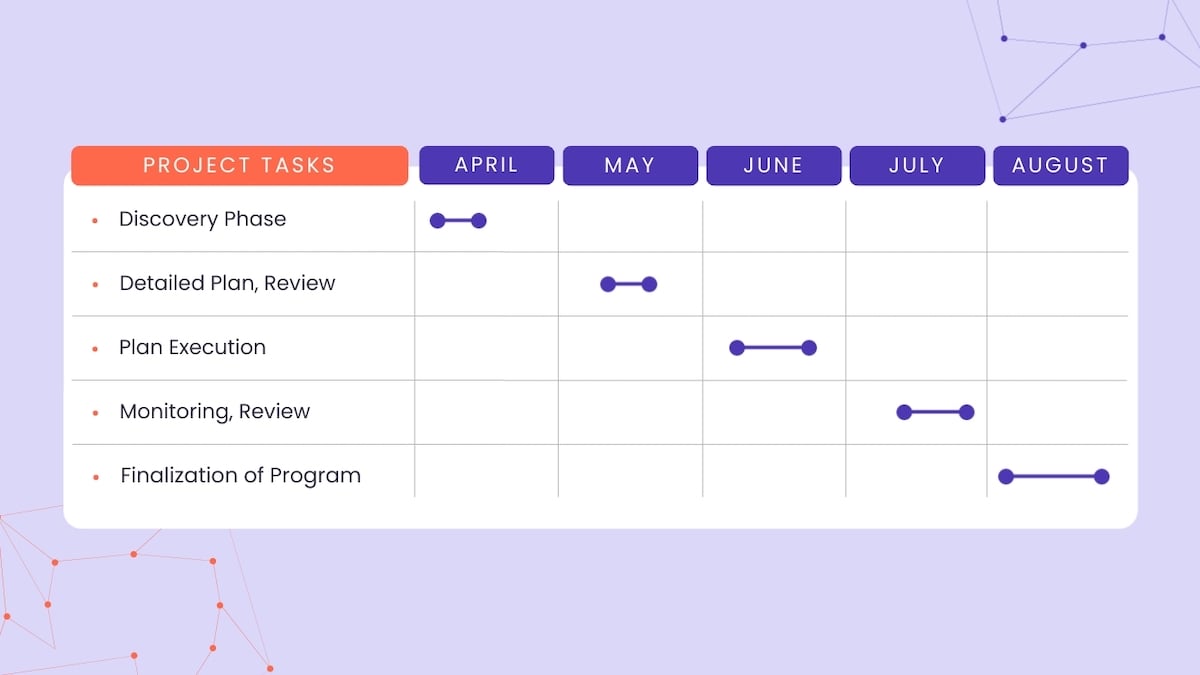
54 Use a comic book style
Comic books are a source of inspiration for many people. The visual aspect of a comic style composition can really make your presentation shine. There are a few ways you can use this technique. You could set up the slides as if they were snippets of a comic book, place the text in speech and thought bubbles and apply a background with a pointillist texture. If using characters, make sure the characters fit the theme of your presentation. For a perfect fit, hire a designer to create a comic book presentation just for your company.
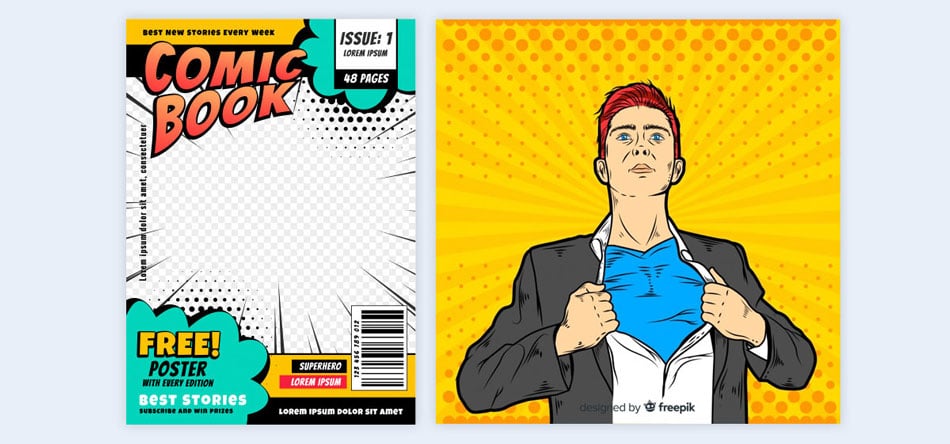
55 Use a manga style
Looking for creative PowerPoint slide ideas that stand out? Consider taking inspiration from the Japanese art of Manga. Manga can give your presentation a distinct and eye-catching look, much like comic books.
It isn’t as versatile as a comic book because it has a more specific look, so it might not work for all topics. It can work for more creative outlets like fashion, art, and photography. Manga has a specific style for the atmosphere around the unique characters as well. They are more common in black and white and look very photographic.

56 Use psychedelic visuals
Psychedelia was a big part of the design world in the 60’s and 70’s. Music and creative event posters were so intricate and colorful that they took an important place in the design history books. This design style can be used for a unique visual approach in your presentations. Just like many other techniques we have mentioned, they can be used as a background in slides or as decorative elements. The swirly shapes and contrasting colors can call attention to the viewer in a positive way.

Create professional and engaging presentations online!
- Choose from hundreds of fully designed templates
- Align colors, fonts and images with your brand
- Add custom charts, timelines, icons, animations and more
57 Use neon lights
Neon lights are a great way to give your presentation some life when it’s otherwise visually bland. There are plenty of neon light fonts available online to choose from, from classic style neon tubing on a wall to a neon style given to a font to make it look like neon. Presentations of any topic can be given an additional visual with a bit of neon brightness.
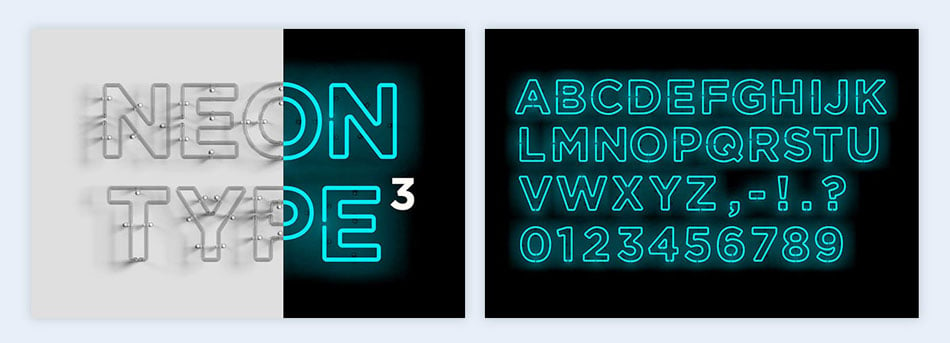
58 Cinemagraph backgrounds
A cinemagraph is like a GIF loaded with elegance. The idea behind a cinemagraph is a photo with a moving section which makes it look cinematic. This kind of background can keep your viewers happily hypnotized while listening to your audio narrative or keep them on the slide longer to truly grasp the information being given. There are cinemagraphs available for all sorts of themes and topics. You can definitely find one that suits your needs.
59 Full-screen video backgrounds
A full-screen background can be really appealing. But just like other design ideas, the video you choose needs to match the theme and topic of your presentation. Your best bet is to have a video which is directly related to what your presentation is about. Videos can be created especially for your purpose, sourced with permission from YouTube or bought from a stock video site.
60 Visualize data
Staring at a large amount of numbers on screen can be overwhelming for most people, even if the realities of those numbers enforce your point. What’s the best way to avoid scaring your crowd? Put the data into easily understandable visualizations. This especially helpful when customizing sales, business or consultant presentation template .
If you want to take this a step further, you can use illustrations or create infographics to make these data visualizations even more engaging.

61 Use a wild west theme
The wild west is not a very versatile theme but can work for a history project or a proposal for a wild west themed party or event. What entails a wild west theme? Brown sandy tones, horses, cowboys, and tumbleweeds. If the full-on wild west theme is too much, you can also take a cue from the era and be inspired by the color scheme. Another approach would be to use photography from the actual west of the United States, mountains and deserts and so on.
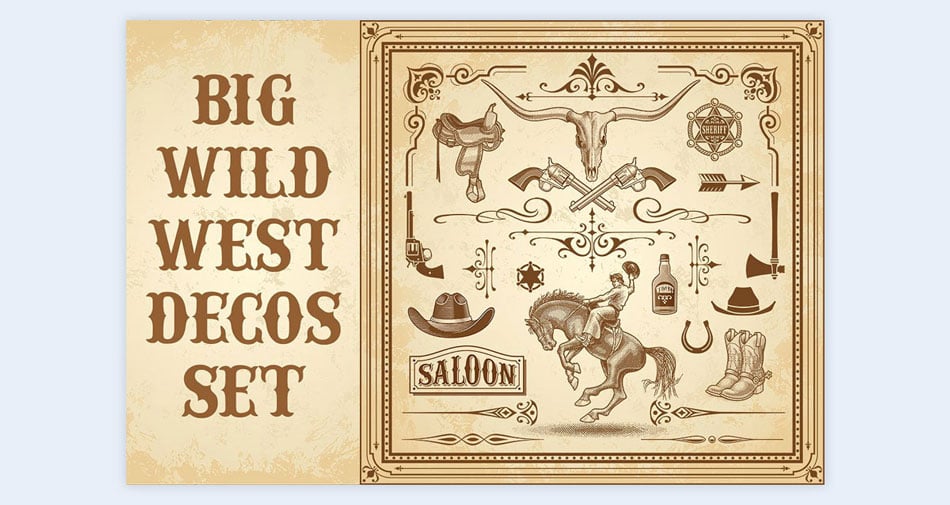
62 Use mind maps
Mind maps are great visual tools for explaining concepts easily. By including mind maps in your slides, you can relay complicated information visually and creatively. There are eight types of mind maps, the most common being bubble maps, the tree map, and flow map. Each one has a different purpose and you can learn all about this in our guide about mind maps in the Visual Learning Center.
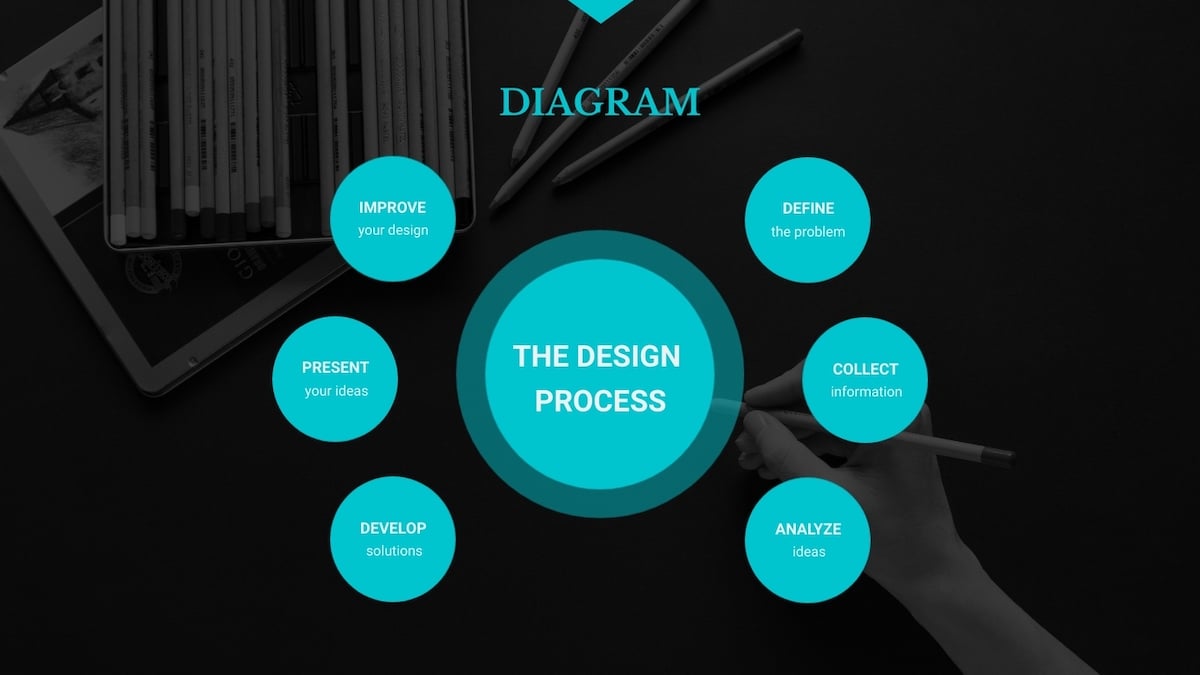
63 Use interactive geographic maps
The difference between a static map and an interactive map will define how much attention your slides get. Regions can switch colors according to a change in data over time, making the map more into a chart. With Visme, you can make your maps interactive with live data . All you need to do is sync your data from a Google Sheets file and when your presentation is published online, your map will always be synchronized to that data.
Want to create your own interactive map?
- Create a color-coded map to visualize geographical data
- Choose either the entire world map, a continent or a country
- Enable feature to have data values appear on hover
64 Color contrasts
Using contrasting colors in your slides will make the information pop out of the screen in a positive way. The trick to using contrasting colors is to know how colors match together. Contrasting doesn’t mean they need to clash. Try using a color palette generator like Adobe Color to find great palettes that will make this technique your new best friend. You can learn more about how color works in our guide about color perception in the Visme Learning Center.
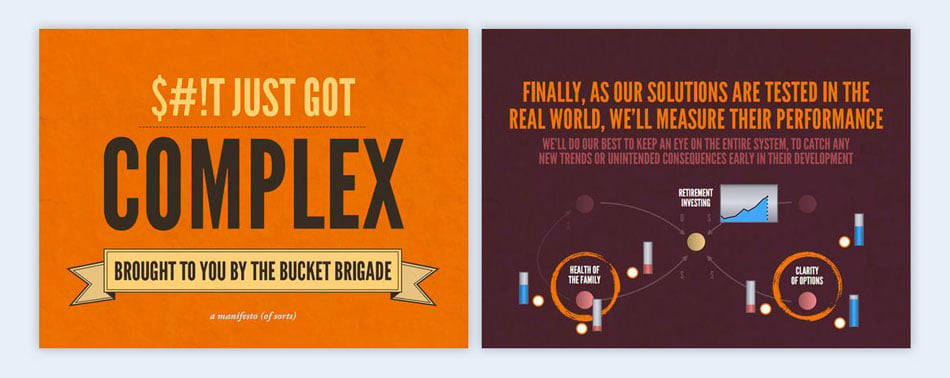
65 Live data graphs
Adding live data to a presentation can turn your slides into evergreen content in a flash. You can use any type of chart and populate it with live data such as bar graphs, line graphs, pie graphs, and more. You can add live data graphs to one or two slides in your presentation or have a series of them. Creating a live data graph is easy with the Visme editor.
66 Color fade transitions
Transitions come in lots of different styles. We have mentioned horizontal transitions, animated transitions, and pathway transitions. This particular technique involves color as the ruling factor.
A color-fade transition makes each slide connected to each other through color. This can be achieved with gradients, color blocks, or colored photo filters. Make your PowerPoint presentation ideas stand out with color fade transitions.
67 “Grow” your presentation so it looks like one animated slide
This creative PowerPoint idea is quite interesting as it really only uses one slide that grows upon itself. The practical way to do this is to create the final slide with all the parts and information set up like a finished puzzle. Once you have the completed slide, duplicate it as many times as you need and systematically take off a bit of information until you’ve reached the first title slide. Once you have all the slides, make sure they are in order before downloading the entire thing.
RELATED: A Non-Designer’s Guide to Creating Memorable Visual Presentations [Free E-Book]
68 Use humor
Want a great way to connect with your audience and make a memorable, more engaging presentation? Be funny. When used strategically, this is a great way to capture attention. In fact, infusing humor into your talk is one of the most effective fun presentation ideas you can use.
Morgan Spurlock makes wonderful use of this in his TED talk. For example, in one of his earliest statements, he offered individuals the opportunity to buy the rights to name his TED talk—which he refers to again at the end, where he reveals the title. He peppers the entire presentation with humorous commentary that nonetheless supports his point.
Create relevant jokes or find a way to bring out the humor in your subject, and your audience will be much more engaged and more likely to remember your words.
69 Tree diagram transitions
A tree diagram is one of the eight thinking maps which help visualize idea and concepts. The purpose of a tree diagram is to classify and organize information. This map can help build a presentation by making sure each slide is a continuation of the one before. They might need to be grouped into sections so that all the information is relayed easily.
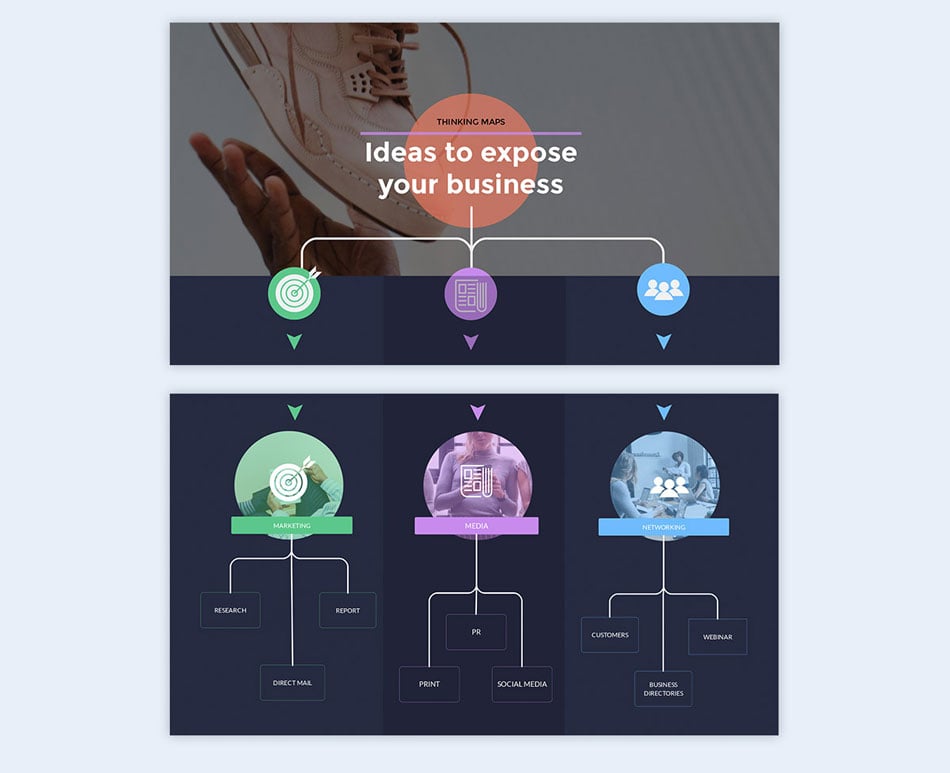
Want to create your own tree diagram?
- Get a head start with pre-made flowchart blocks
- Easily snap lines and objects together
- Dozens of shapes and lines styles to choose from
70 Journal style (with hand-drawn illustrations on the margins)
One creative presentation idea is to make your talk just a little bit different than the rest is to use a journal style. The general visual idea for this technique is to make your slides look like the pages of a journal. The style of the journal will depend on what your presentation topic is. It can be a whimsical bullet journal or an intricate botany journal. You could even consider handwriting on paper as a background.
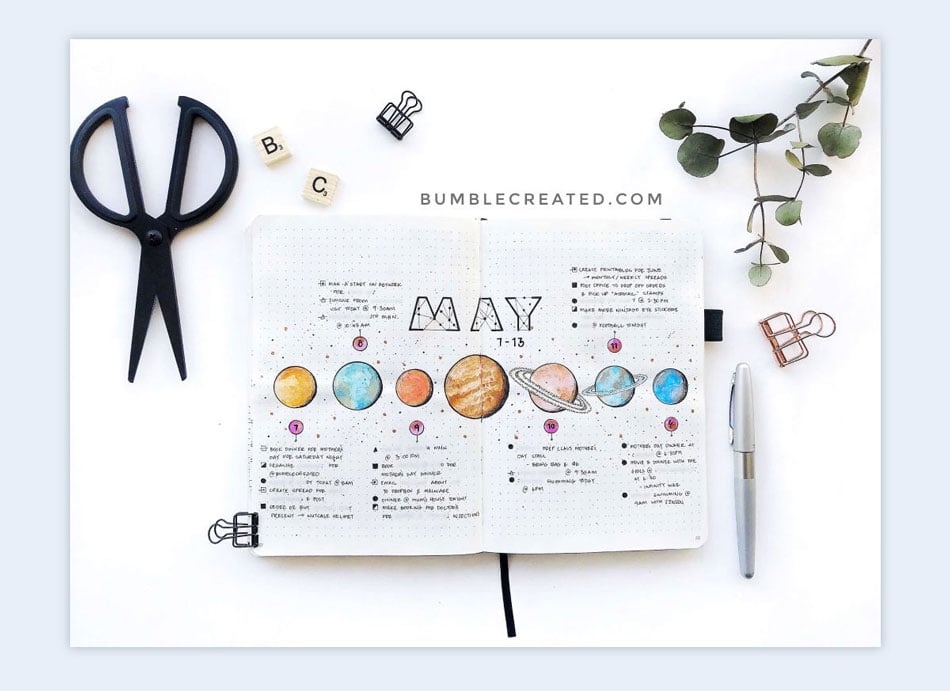
71 Ink splatters
Use ink splatters to decorate your slides any way you like. They can be big and impressive behind the content, or they can be small and subtle like drops from a pen. An ink splatter can give your presentation a bit of an artistic flair and if done right, can make your slides look elegant and clean. Any style of presentation can benefit from some ink splatters as a decorative element.
If you're looking for fresh presentation slide ideas, why not experiment with ink splatters and see how they can enhance your next presentation?
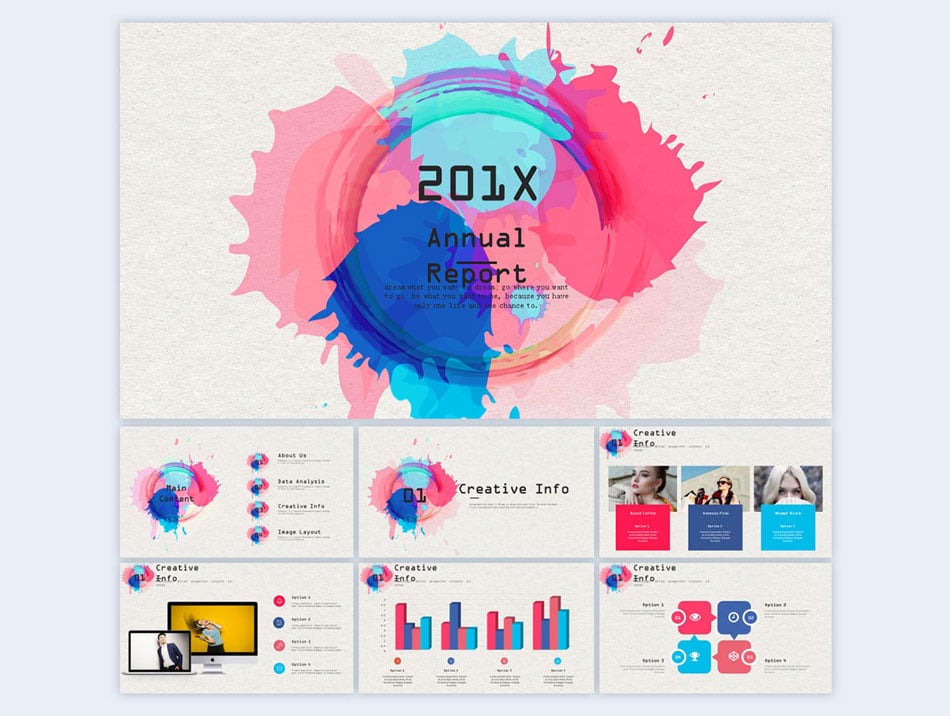
72 Passport with stamps
Using travel stamps as a decorative element can work for a presentation with a travel-theme or a creative design proposal for a department store or airport mall. The stamps can be used as a background on a passport page or on their own around the content. A photo of a real passport page can be used for this technique but there are plenty of graphics available in this style on sites like Freepik .
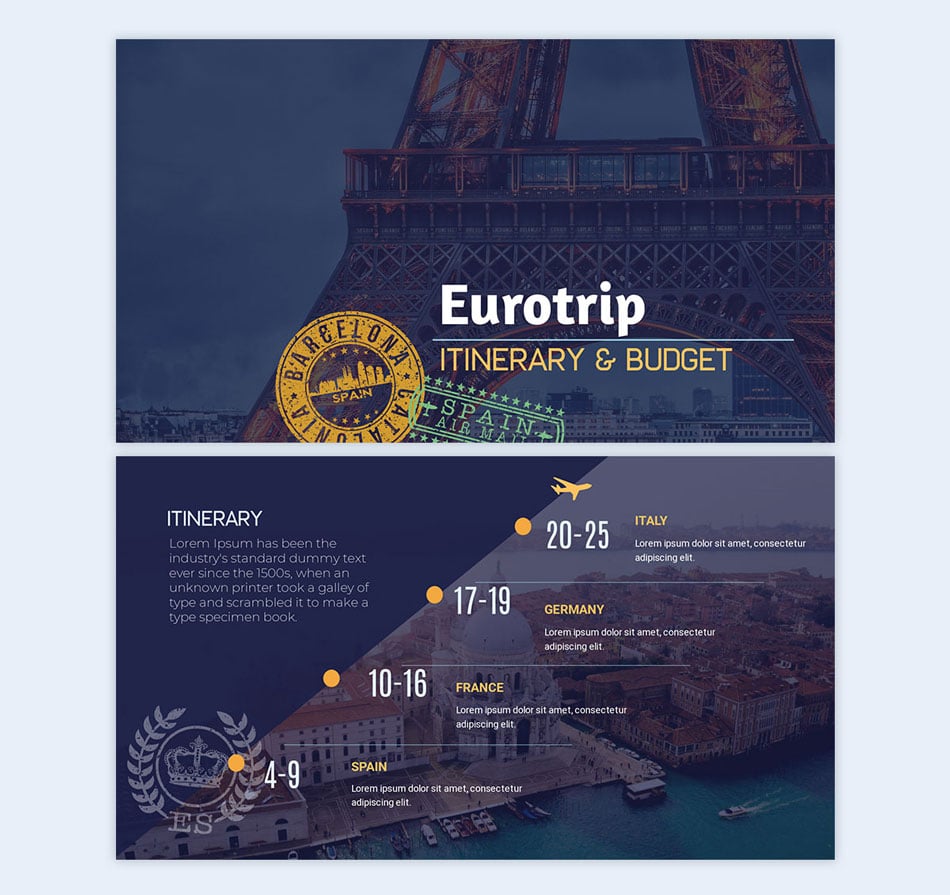
73 Express your emotions
We can sometimes be afraid of expressing how we feel, even to those we’re close to, much less in front of a crowd. However, showing them makes your words more authentic and can generate compassion or excitement in your audience.
Take this TED talk by Thordis Elva and Tom Stranger , for example. While the two talk about their experiences, their voices break and crack. The emotional turmoil they went through is clearly heard, and viewers can clearly understand their pain.
This can take some getting used to, and some courage. However, the results are well worth the effort.
74 Use a video game theme
Video games come in all shapes and sizes. From kids' games to arcade games to car games. Each one has their own style, just like presentations do. If you think a video game visual style is good for your project, consider all the different kinds until you find the one that fits best. You can use game screenshots as backgrounds or infuse the entire design of the presentation with the video game style you chose.
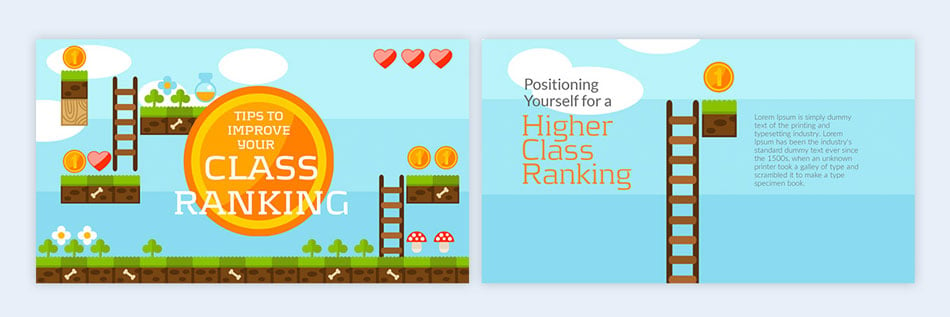
75 Use postcards
One of the least-used creative presentation ideas is to turn your content inside slides into postcards which have been sent from around the world. They can be new postcards which could be used from either front or back sides. The back part would make a great text block for the content you need to display, the photo side can be on the sides or as a background. This design technique can work for presentations about literature, family connections, history or travel. There are postcard templates available on sites like Creative Market .
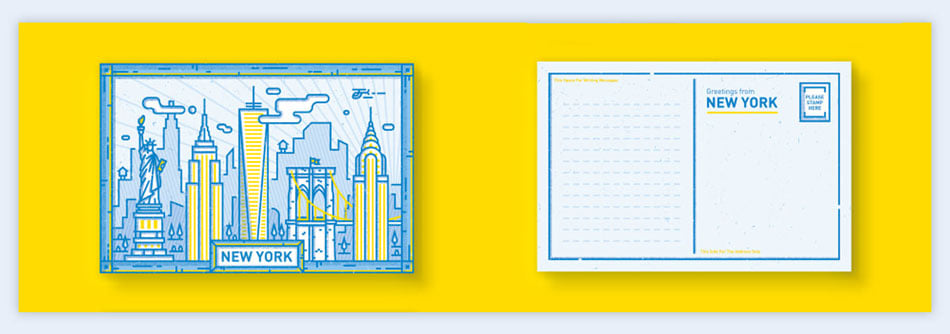
76 Incorporate robots in the design
Using robots in your slides can be a creative approach to visually elevate your presentation. There are different styles of robots you can add to your presentation design; realistic photography of anamorphic robots, cute illustrated robots, or robotic parts from factories. These visuals might only apply for technology-themed presentations or about robots themselves. Cute illustrations of robots can be great backgrounds for whimsical topics or other styles of storytelling presentations.
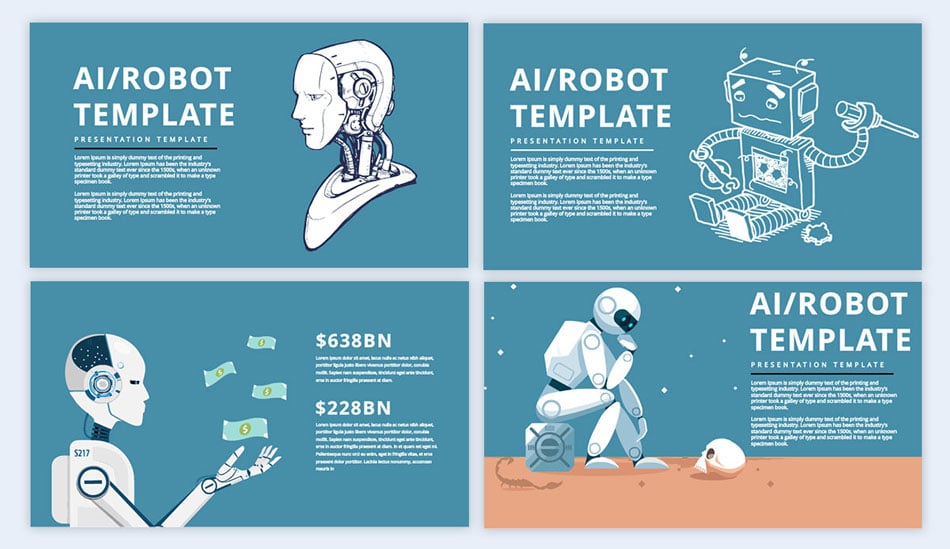
77 Chalk on blackboard
Looking for creative slides presentation ideas? Consider using a chalkboard design to add a unique and nostalgic touch to your presentation.
Writing on a chalkboard is not limited to a school setting or a bar menu. These two might be the most common yet they are not the only possibilities for using chalk on a blackboard. A good handwriting font is the best companion to a chalkboard design. Some of these fonts are already available with a chalky texture and others might need some professional tweaking to get the right texture.
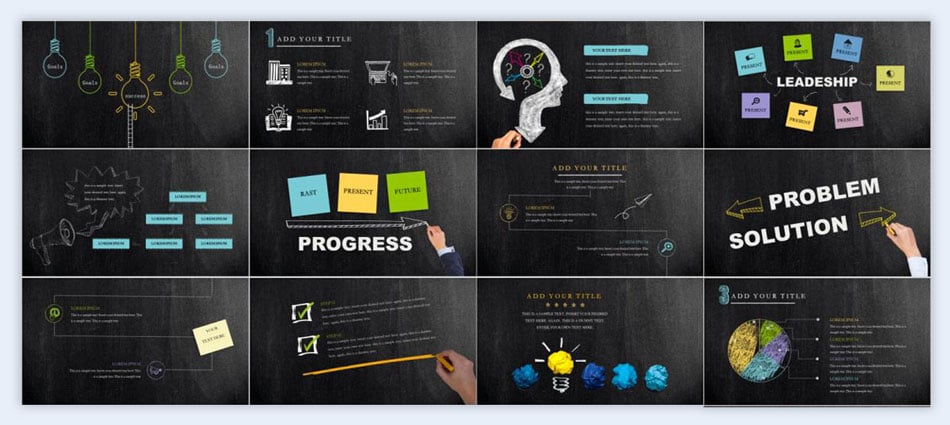
78 Get inspired by a specific location
Even if the PowerPoint presentation ideas you are designing are not about a specific place in the world, you can be inspired by one to set up the color scheme and feel of the slides. For example, if you get inspired by Greece, you can use white and light blue hues or even photos of Greek islands. If you get inspired by Brazil, you can use photos of the beach, the texture of the boardwalk tiles or green, blue, and yellow color schemes.
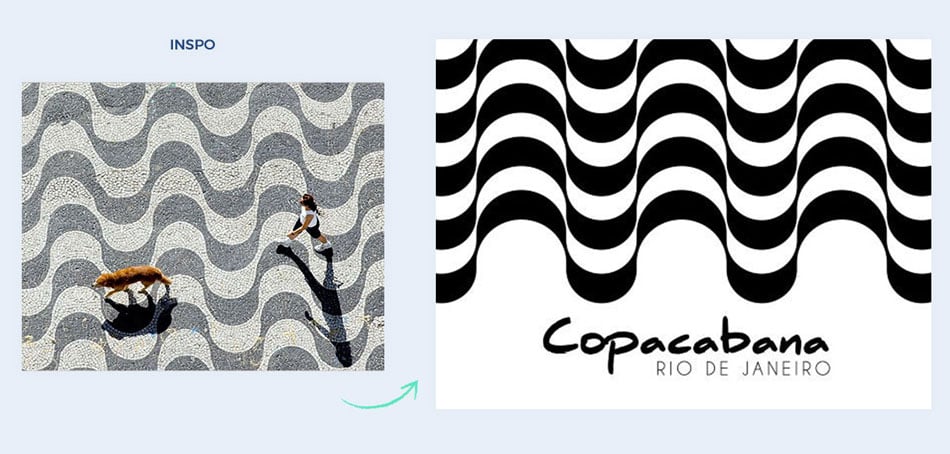
79 Use props
Using props can quickly turn a run-of-the-mill presentation into a unique, interactive experience. Kenny Nguyen demonstrates this well. In his talk he often refers to the “sword of yes” and “shield of no.” Naturally he picks up a sword and shield from the table to help demonstrate his points.
Choosing similar props can help you really illustrate your points—and make it that much more entertaining, too.
80 Use hashtags as titles
In the age of social media, hashtags are used every day. They appear regularly on social media, in spoken and written conversations, and of course in content marketing. Why not include some hashtags as titles? This technique will work great in a presentation for a social media content management pitch, or an in an influencer marketing strategy. On another note, hashtag titles can even be used for any type of presentation geared at the digital generation.
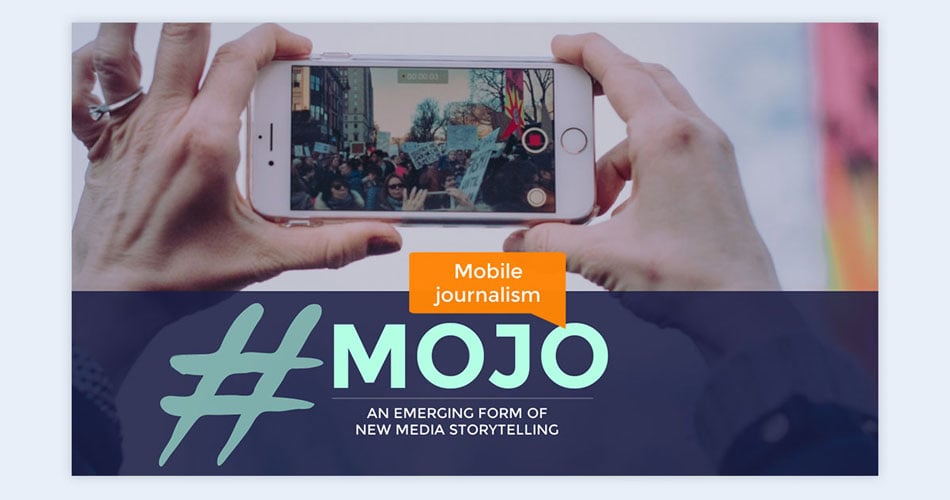
81 Black background, white letters, and color accents
When you use a black background, the colors that you place on top will usually look brighter than if they were on a white background. When creating this kind of color palette, make sure the colors you use don’t clash with each other or with the black. Along with the bright colors, make sure you use white to make the composition pop! Neon colors or pastel tones are what will work best.
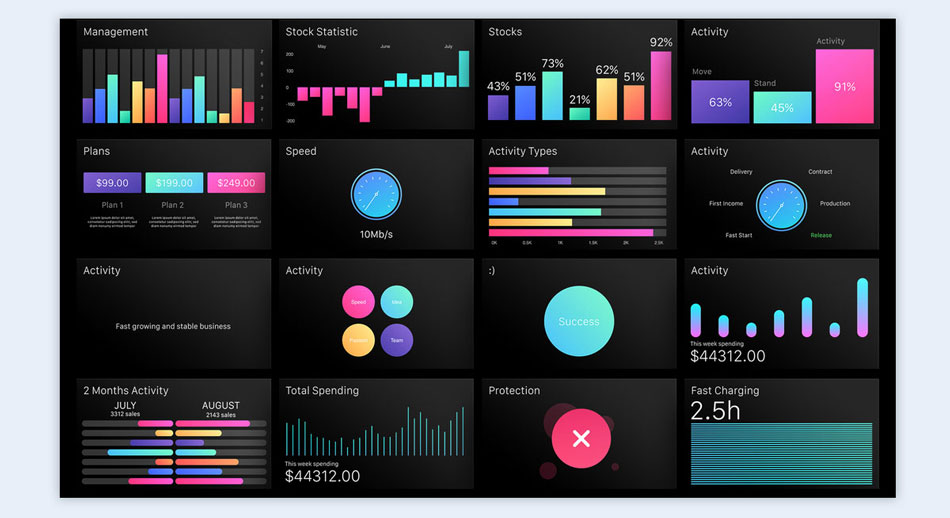
82 Vintage film edges
Even though we are used to taking photos with our phones, the classic nostalgia of film is still prevalent in the world of visuals and design. The graphic representation of a film negative is as recognizable as an envelope representing an email. Use a vintage film edge along the horizontal edges of your slides to give your visuals a cinematic feel. Even better if you make the edges animated so that it looks like it’s rolling along on a projector.
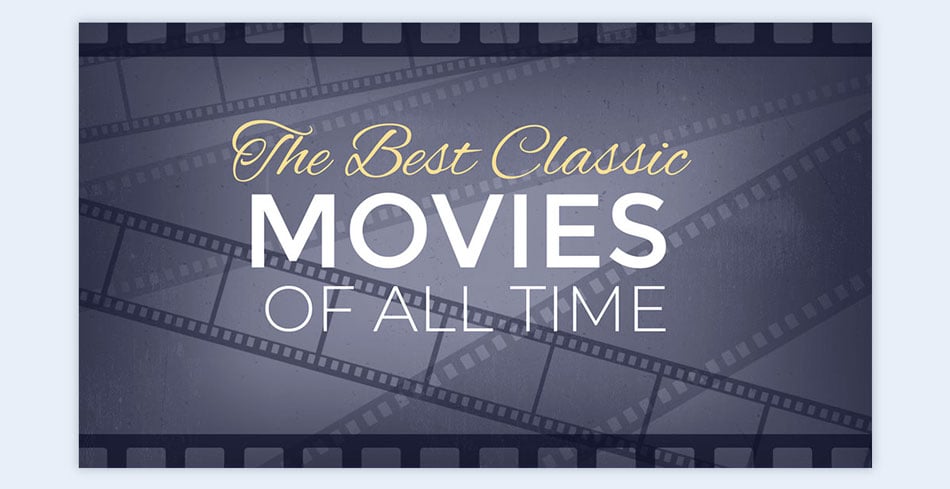
83 Adult coloring book inspired design
Using a coloring book design can be really creative. Practically anything can be turned into a coloring book style illustration. A great way to use this technique is to have the first slide with the un-colored illustration and then progressively color in the illustration as the slides progress. Furthermore, if the illustration is depictive of the information, the visuals can be even more engaging.

84 Stripes
A stripes design is as classic as it gets. From pinstripes to artistic colorful lines, you can use them as a subtle background or a powerful striped theme intertwined with text boxes. Stripes are the kind of design technique that can work for any type of presentation, from corporate to educational.
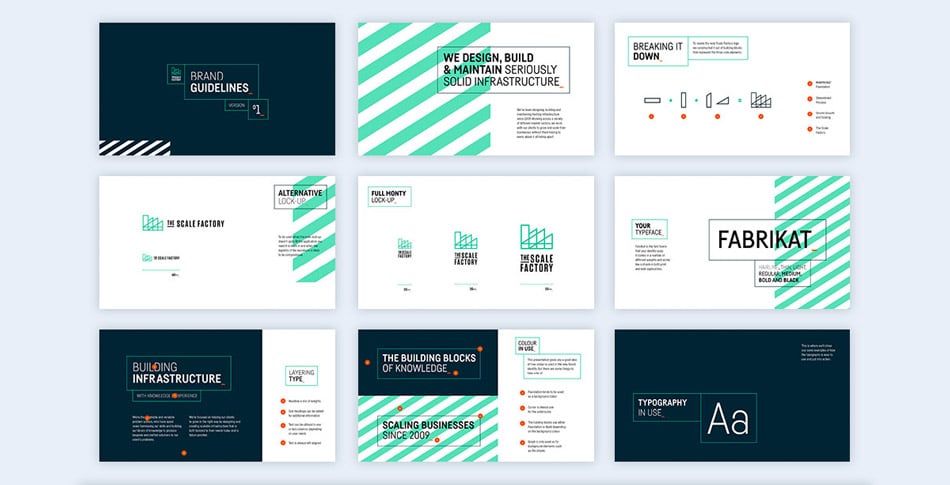
85 Make each slide look like a social media post
Just like postcards and polaroids, you could try a creative approach and use social media templates to put the content in. The most notorious social media visual channel is Instagram. It has been known to inspire offline events as well. Make your slides look like social media posts or social media pages. For this technique, you can either use screenshots or templates.
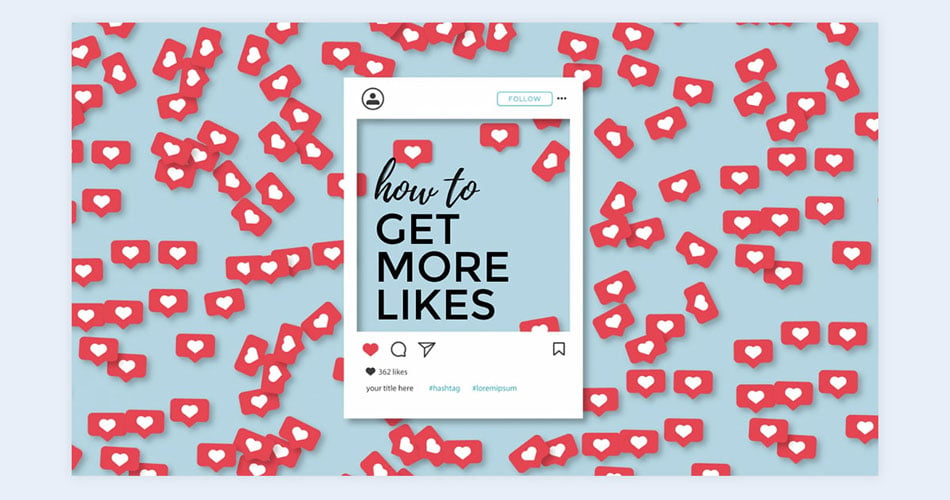
86 Ink in water
Dropping ink in water creates beautiful colorful bubbly designs which can be photographed at high speed. These images can be used as backgrounds for any type of creative theme presentations. Choose the color and thickness of the ink design to match the theme of your presentation. There are also animated versions of this effect which can be bought like video stock.
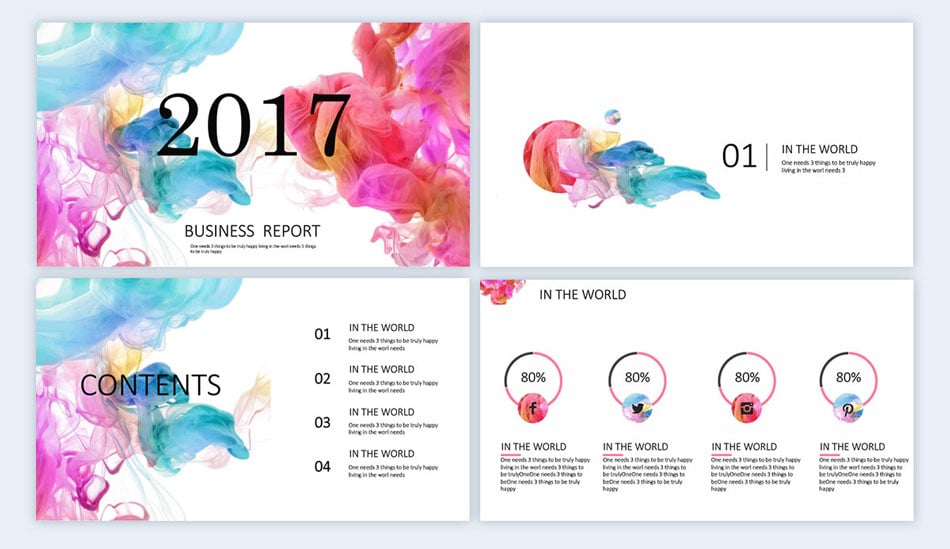
87 Lego bricks
Use lego bricks as inspiration to fill your presentation slides with color and fun. Use the bricks to create slide frames, letters or even charts. The best approach to a lego inspired presentation is to be creative. There are lots of things you can do with lego, you could go as far as using the legos to write the titles of the slides. Don’t use the Lego logo though unless you are specifically designing a presentation about lego.

88 Use classic storytelling techniques
A presentation is, in a way, like a story—you’re talking about your chosen subject and leading viewers on a journey to discover what that subject means. Moreover, stories hold an intrinsic interest for us. Therefore, you can easily use several storytelling techniques to help improve your presentation.
Alex Blinkoff goes into this in great detail, examining things such as “The Hero’s Journey” and provides several examples of ways to use storytelling techniques in your presentations. Check them out, and decide what might work best for your subject.

Click on image to view interactive slide show created with Visme
89 Jigsaw puzzles
Pieces of a jigsaw puzzle can be used to make charts, infographic diagrams, or interlocking frames. The idea behind puzzle pieces is that things come together to form a whole and this concept can be used for any slide and any kind of presentation. Make sure to use a suitable color palette that matches your theme and the rest of the presentation.
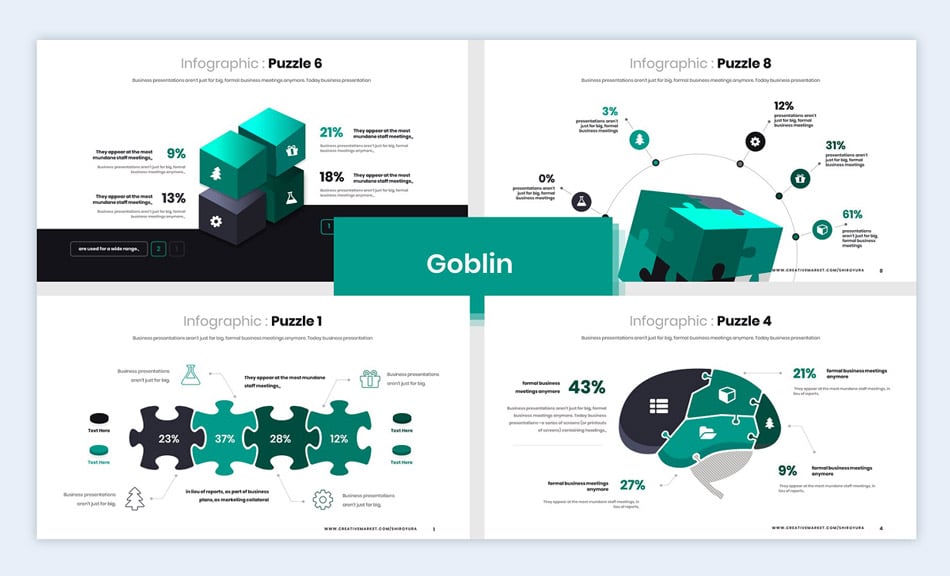
90 Headlines coming in animated on boats/trains/airplane
Headlines or titles can be given a life of their own inside the slides. One interesting and creative approach would be to make the titles enter the slide on top of some kind of vehicle. The vehicle could be anything, from a train to a boat, to an airplane. Depending on the type of vehicle, this animated technique can be used for child-themed topics, transportation themes, travel ideas, or even about a corporate sales report.
91 Use a camouflage design
Camo doesn’t necessarily need to convey a sense of military, although it does carry a strong connection. Thankfully, camouflage comes in different styles, from jungle greens to desert browns. Other out of the box camouflage styles are the ones where the colors are completely off the charts, like pinks and blues. Camouflage designs are better used as backgrounds or small subtle sections.

92 Use unique novelty fonts for headers
There are so many novelty fonts to choose from out there these days! Using a unique novelty font for the titles and headers is a great way to add some visual pizzazz to your slides. Try looking for some really special fonts that carry personality. Once you have selected the font, add some color and texture to make it look even better.
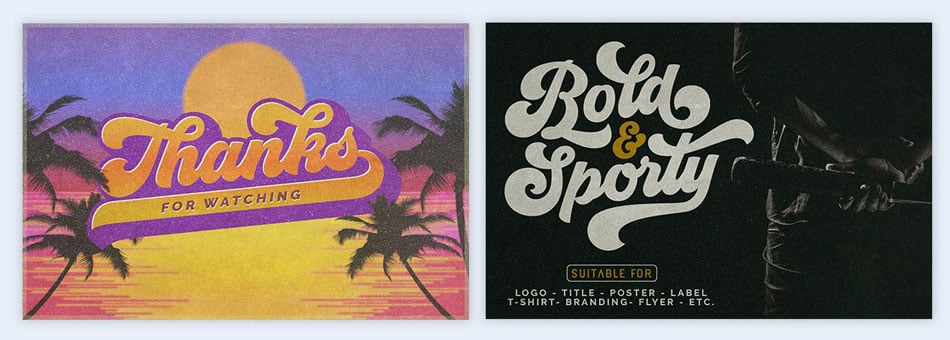
93 Use a city skyline
Using a background of a city skyline can work great for a presentation related to business or corporate topics. It can also be perfect for an urban travel related theme or educational presentation. You can choose to use photography as a background or with the buildings cut out from the sky. Another choice is to find an illustrated city skyline and use it as a border on the slides.
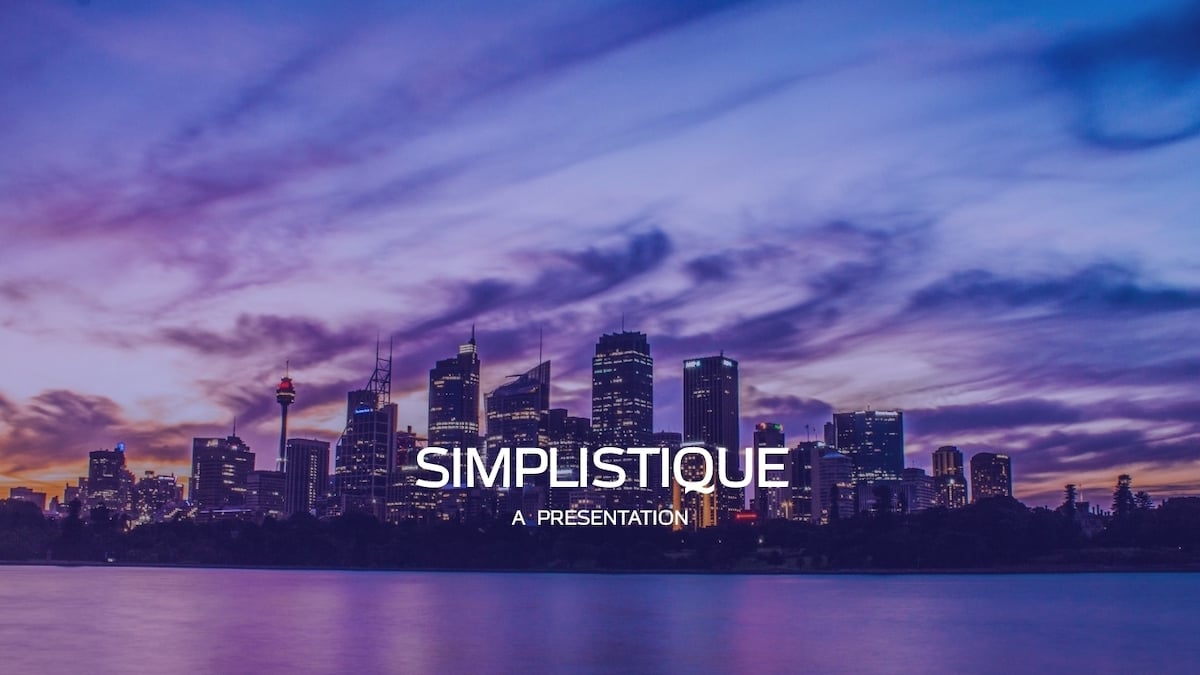
94 Use a connected dots background
One of the design trends of the last few years is the connected dots visual. It’s used on websites and on printed flyers. It’s so versatile that it can be added to any kind of presentation in a heartbeat. The lines can be short or long between the dots and the composition can be tight or spread out. You can find connected dot visuals easily on sites like Freepik, in lots of different colors. If you can manage vector graphics , you can also change the composition of the dots quite easily yourself.
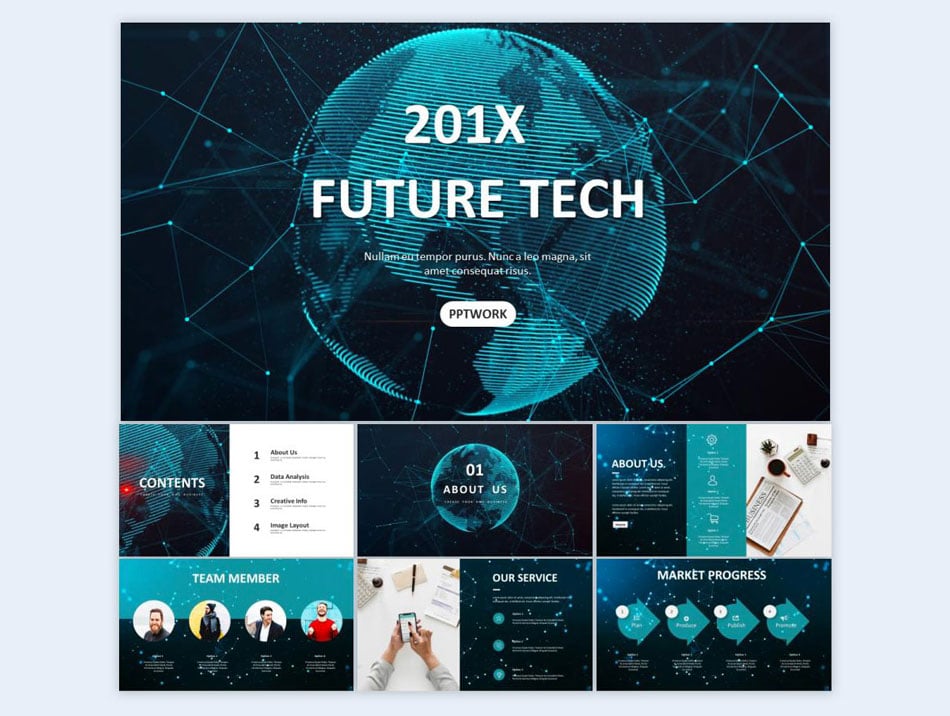
95 Use a bokeh background
Bokeh is a photography and light technique which turns dots of light into bright shiny spheres. With a bit of creativity, the lights can be turned into shapes, like hearts or stars. This design style is great for backgrounds since it’s mostly abstract. It works best as a complement to the content instead of an important visual aspect. You can find bokeh backgrounds in stock photo sites or make it yourself.
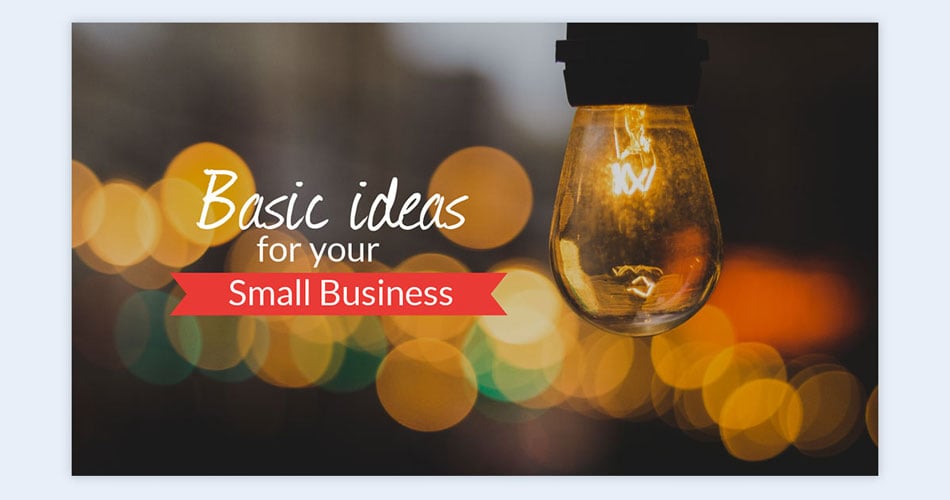
96 Use watercolor designs
The use of watercolor designs is an easy way of infusing some lively color into a presentation. Watercolors can be a splash on the background, shapes around the content, or colorful strokes intertwined with text boxes. Depending on the color of the paint used, the watercolor technique can be used for any type of presentation. A soft watercolor brushed background can work for a feminine theme and a deep intense splash can add visual creativity to an otherwise boring corporate presentation.
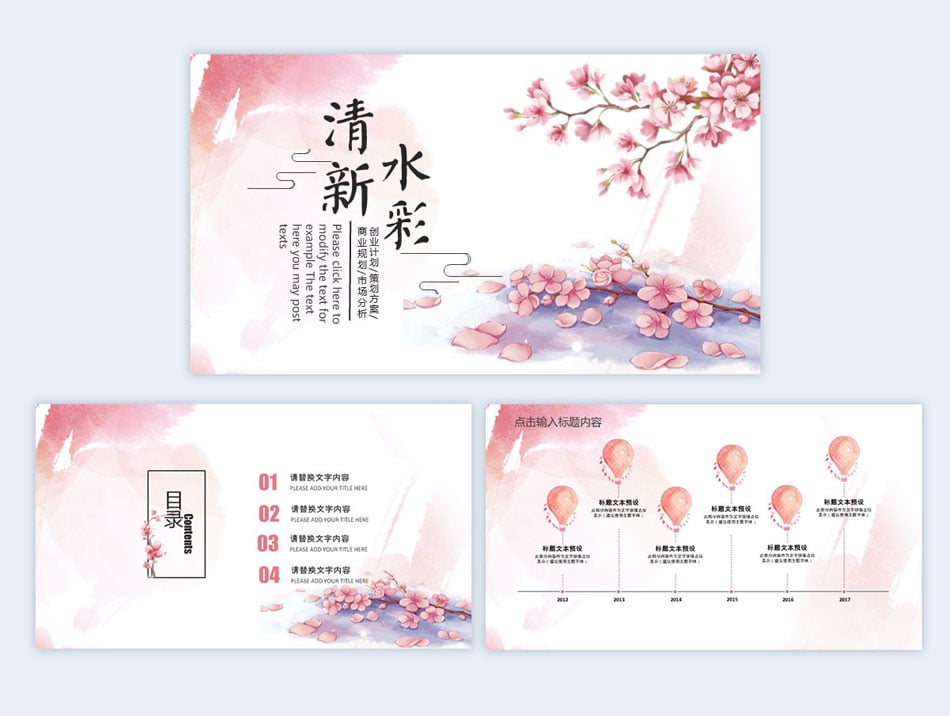
Just like watercolor graphics, paint can add a dose of creativity to any presentation. Different to watercolors though, paint is more intense. Paint based graphics come in all shapes and sizes, from thick brush strokes to paint drips. Digital paint compositions can also make great backgrounds for colorful and creative presentations.
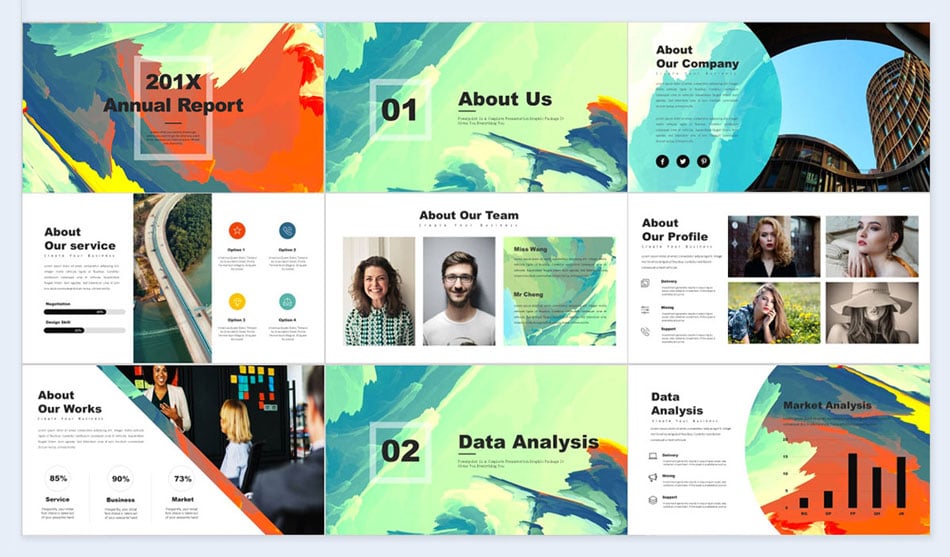
98 Use bright fun colors
Why create a bland presentation when you can make it fun and colorful instead? Creative color palettes can include up to six different colors which look great together. Use shapes, cut-outs, color blocks, swashes, anything your heart desires. This technique is for letting go and being creatively free with color. Just make sure the colors go together by trying out some palettes first.
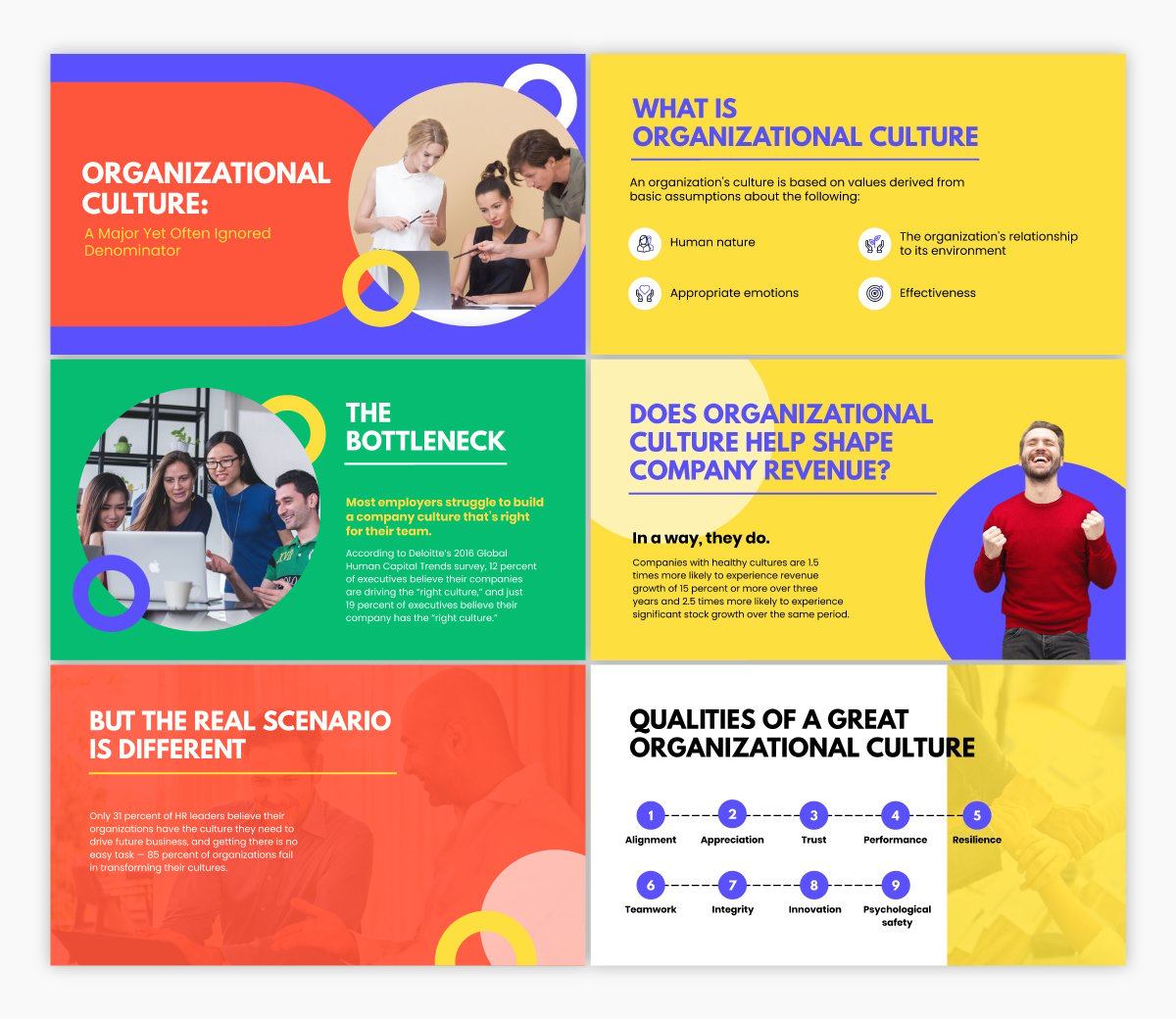
99 Use arrow graphics
Arrows symbolize direction. They can be a great addition to your charts, infographic visuals and slide sections. You could even do the entire presentation using arrows. According to their size, color, and thickness, they have different temperaments. Look for different styles of arrows and see if they fit your topic and theme. Freepik has some great arrow visuals and the Visme editor also has arrow icons and infographic visuals.
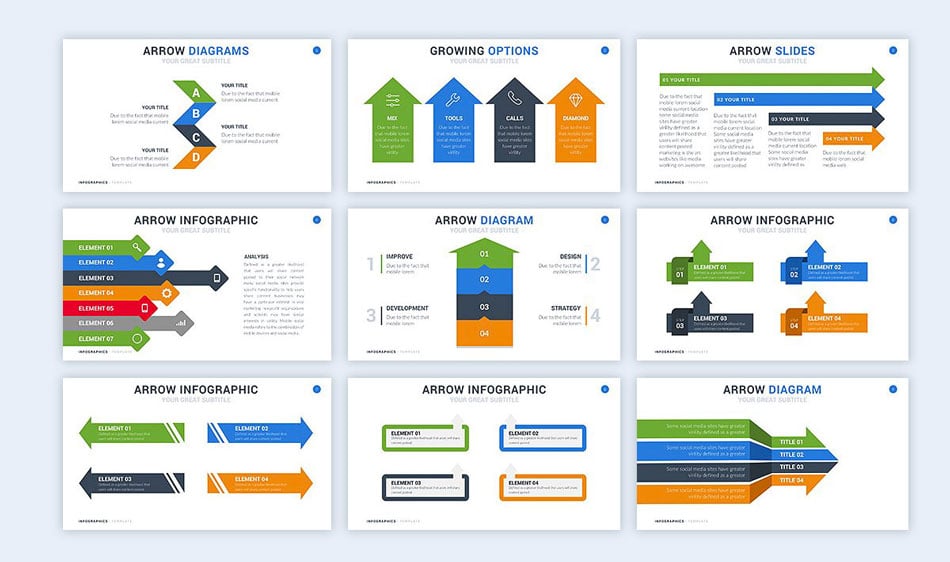
100 Use electronic visuals
Another great idea for a background visual is the inside of a computer system. The intricate details of a motherboard or a close up of a memory chip can make a great visual impact. Apart from using an electronic background image, little pieces of electronic devices can be placed around the slide as decoration. This technique is generally limited to electronic or computer theme topics.

101 Metaphors
Visual metaphors can be useful in a similar manner. They can spice up your presentation, illustrate your point, and make your work far more entertaining. James Geary speaks about just how important metaphors are.
102 Keep it feminine
A feminine style design can work for your presentation if your company makes products for women or if your targeted audience is women. By feminine design, we mean light and soft colors, subtle shapes and a general airy feeling to the composition. Feminine design can be minimal but it can also be decadent and full of style. Whichever you chose, make sure it fits with your audience.

103 Go futuristic
A futuristic style can fit any theme as long as the concept of the future depicted, fits the topic of the presentation. Futuristic design can be of many different styles; from spaceship driving controls to cosmos related atmospheres, to flying cars, and artificial intelligence. Even color palettes can look futuristic if you add some metallic tones.
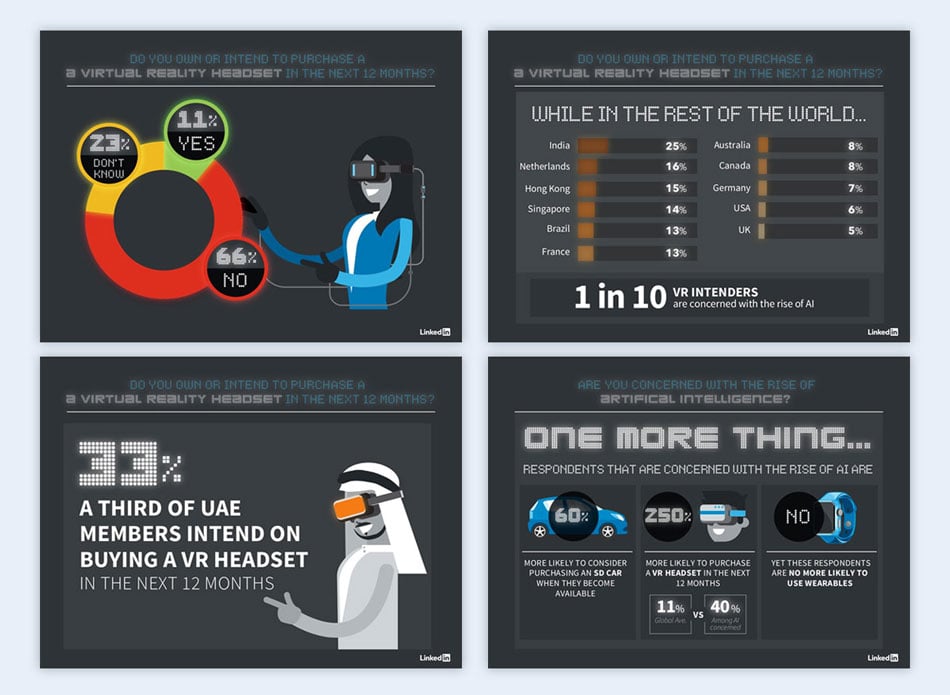
104 Add a music background
A music soundtrack can be added to any presentation that doesn’t have any other sort of audio already. The best music for a presentation is one without lyrics, in other words, an instrumental track. A good track will accompany the content in a positive way and not interfere with the message. You can find audio tracks easily online.
105 Communicate with images
A picture can speak a thousand words. Naturally, they can be used to communicate concepts that, for the sake of space or time, you might not be able to include in the presentation itself. This slide deck uses this strategy to its advantage.
The presentation includes many images as backgrounds and minimal text. The images used always either enhance what’s being said or, in some cases, provide the answer for viewers. For example, the second slide states “The Landscape Today,” and includes a bleak background with a broken, tilted picture frame, emphasizing the idea that the following slides (which describe the landscape) offer some pretty disheartening information.
Using images in a related fashion can help express your views and emphasize your message.
Harness the power of Visme's AI image edit tools in your toolkit. These advanced yet easy-to-use tools let you effortlessly edit, touch up, unblur and upscale your images using simple prompts. It's an incredibly convenient way to add extra polish and clarity to your pictures to make your presentations more impactful.
106 Include artsy data visualization
Data visualization is a way of showing data and information in a way that is visually expressive. Creative data analysts can make some really beautiful creations and you can hire them to make them for you. If you haven’t seen any creative data visualizations, take a look at our collection of the best of 2018 and get inspired. You can either make the whole presentation into a data viz or add them to some of the slides.
By Beyond Words Studio
RELATED: The 25 Best Data Visualizations of 2018
107 Stay branded
This creative tip is a simple yet effective way to spark good presentation ideas. When creating your presentation, do your best to stay on brand. This, of course, will work only if you are creating a presentation for your own brand. If creating one for a client, then you should stay on brand with their own brand style guide. This means only use the brand colors and fonts, use photos, textures, and shapes that match the brand.
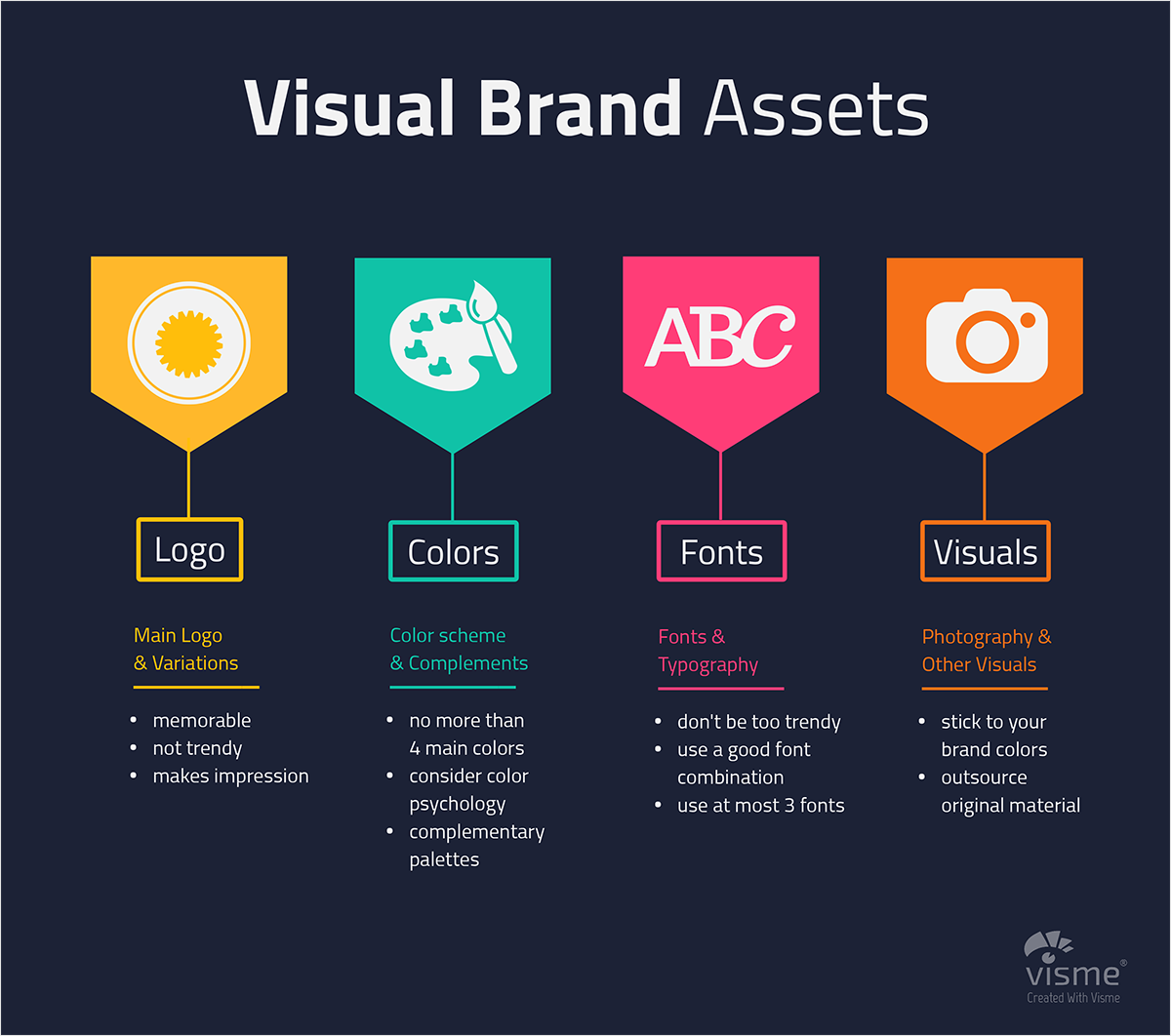
Use Visme's brand design tool to ensure your presentations perfectly reflect your brand personality. Just copy and paste your website URL, and the tool will automatically extract your branding assets, such as brand colors, brand fonts and company logo.
108 Ask questions
A great tip to make your PowerPoint presentations ideas more interactive is to ask questions from your audience. Like the example below, you can display only your question on the slide. Once the audience has pitched in their opinions and answers, you can click to reveal the actual answer. You can enable this type of interactivity on click when making a presentation in Visme .
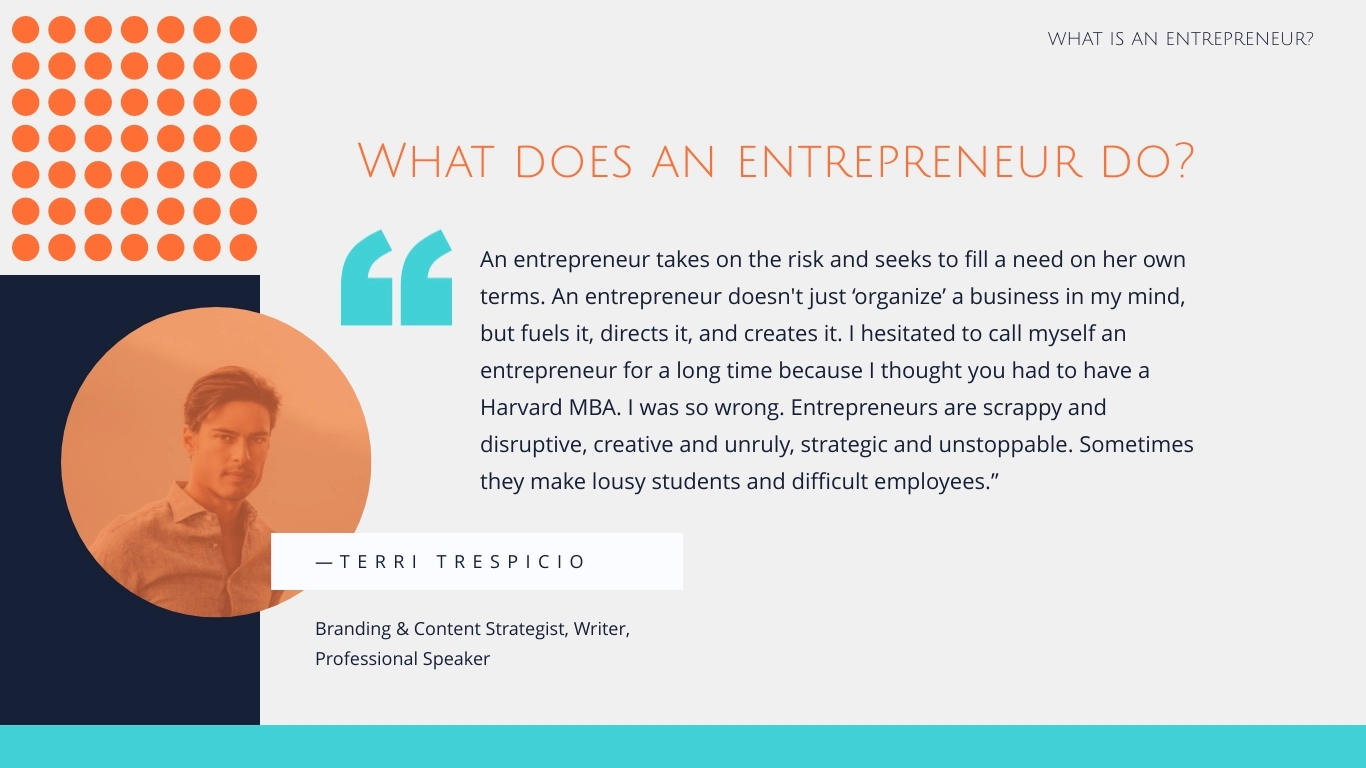
109 Replace boring bullet points with visuals
While adding bullet points in your slides might be better than adding walls of text, they're still not the most effective way to get your message across and engage your audience. Take things up a notch and replace boring bullets with visuals, such as photos and even icons. Here's an example of how you can use icons to add a creative twist to the plain ol' bullet points.
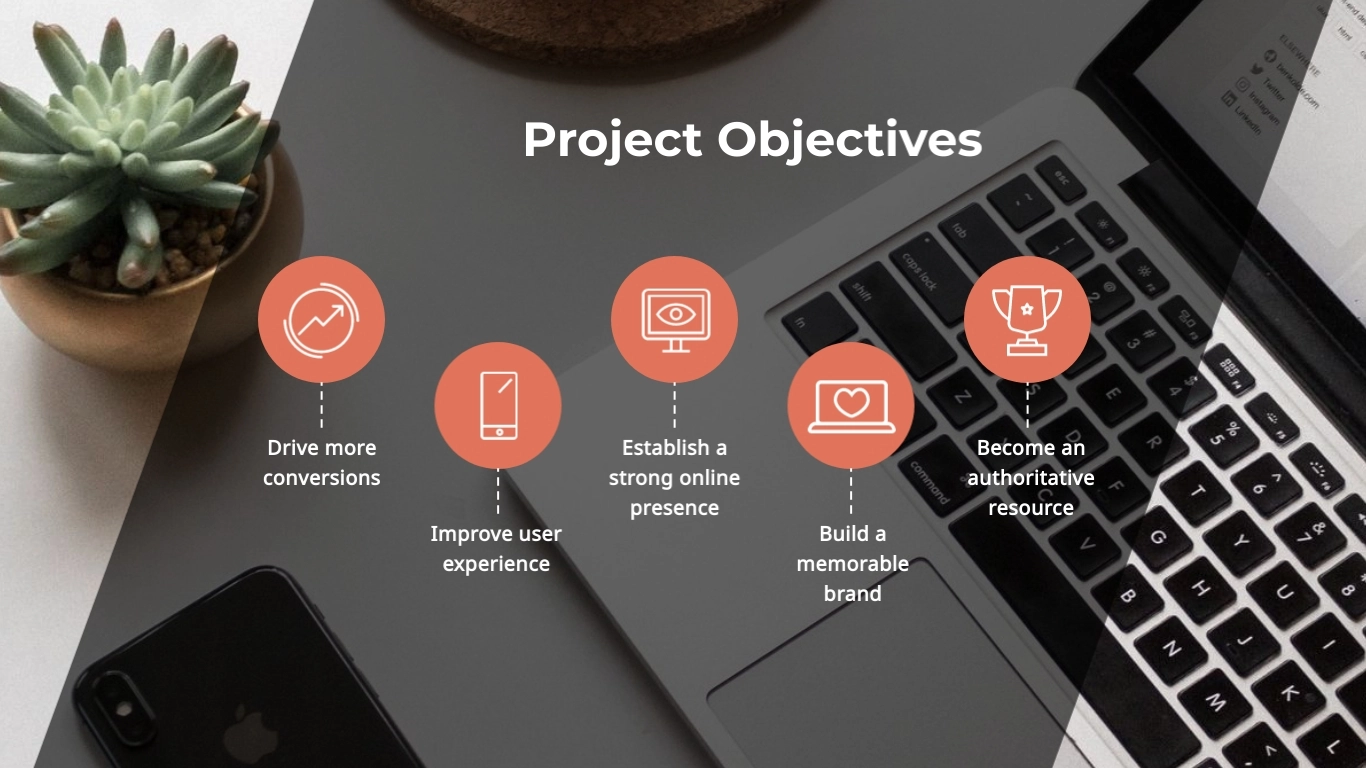
110 Share your slide deck
Downloading your slide deck and presenting in front of an audience is not the only way to use your presentation. Make the most of your slides by sharing your presentation online.
Add interactive elements, such as clickable buttons, links, hover effects, popups, embedded videos and more so your audience can view and engage with your slides on their own.
If you've created your presentation in Visme, you can share your presentation publicly or privately using a link, or embed it anywhere you like.
Start Using These Creative Presentation Ideas
Ready to start creating your own presentation after over 100 pieces of inspiration? Choose your favorite creative presentation ideas and incorporate them into your own presentation.
You can add interactivity, animation, visuals and all kinds of creative elements to your presentations when you design them in Visme's online presentation maker. With our Dynamic Field feature , you can automatically update key information in real-time across all your slides or multiple projects. Customize existing dynamic fields or create new ones and format them to maintain design consistency.
Create a free account with Visme to start building a presentation your audience will love.
Design a beautiful and engaging presentation with Visme

Trusted by leading brands
Recommended content for you:

Create Stunning Content!
Design visual brand experiences for your business whether you are a seasoned designer or a total novice.
About the Author
Orana is a multi-faceted creative. She is a content writer, artist, and designer. She travels the world with her family and is currently in Istanbul. Find out more about her work at oranavelarde.com

- How it Works

150+ Presentation Topics To Make an Impact Instantly
Presentations
Picture Yourself as the Star of a Presentation.
To really shine, you need a topic that grabs everyone’s attention. It’s more than just speaking well or having cool slides; it all starts with a topic that makes your audience curious.
Imagine standing in front of a group, not just sharing facts, but telling a story that keeps everyone interested. Presentations aren’t only about work or school; they’re a chance to be creative and make things interesting.
Every day, there are 50,000 presentations happening. They’re not all serious business or school stuff; some are about fun and quirky things like a duck on a tricycle or a dog wearing glasses. It’s surprising, right?
Still, half of people get bored during presentations. That’s why it’s crucial to make them exciting. That’s where our ideas come in—over 150 of them! And here’s the cool part: these ideas aren’t just for offices or classrooms; they’re for any time you want to share something in a fun way.
So, get ready to explore 150+ presentation ideas that will help you make an impact instantly.
How to Choose the Best Presentation Topic: Step-by-Step Process
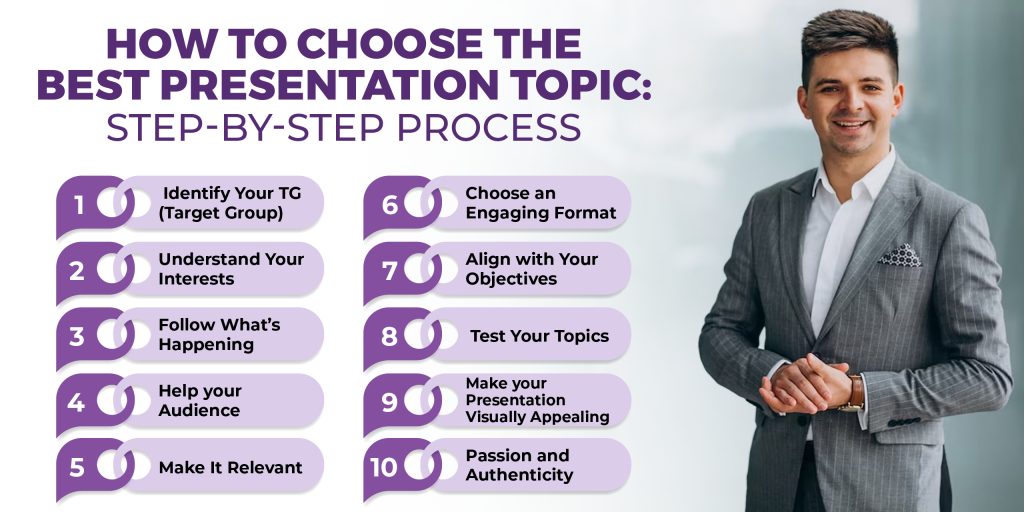
Picking the right presentation topic is like winning half the battle before you even begin. After selecting your topic, you’ll focus on content creation and presentation design. If you need help with presentation designs, consider Design Shifu , offering dedicated designers for your needs. You get unlimited designs for a flat monthly fee, which includes not only presentation designs but also services like infographics, social media designs, logo design, etc. Now, back to the topic selection. You need to strike a balance between creativity and relevance to make an impact on the right audience. Here’s a step-by-step guide to help you choose a compelling topic:
How : Conduct surveys or interviews to understand your audience’s interests, needs, and knowledge level. Example : For a group of professionals, consider topics related to their industry trends or challenges.
How : Reflect on your strengths, experiences, and knowledge areas. Example : With a digital marketing background, a topic like Effective Social Media Strategies for Business Growth might be ideal.
How : Stay updated on current events, industry trends, and popular discussions. Example : In technology, a presentation on The Future of Artificial Intelligence in Everyday Life can be timely and interesting.
How : Identify challenges your audience faces and offer solutions. Example : For entrepreneurs, Overcoming Common Startup Challenges can be highly relevant.
How : Relate your topic to the audience’s daily lives or work. Example : A presentation on Time Management Hacks for Busy Professionals can be relatable and valuable.
How : Consider using a storytelling approach, case studies, or interactive elements. Example : Instead of Benefits of Healthy Living, structure it as a personal journey with before-and-after anecdotes.
How : Clarify your presentation’s purpose (educate, persuade, entertain) and choose a topic that aligns. Example : For inspiration, Unleashing Creativity in the Workplace could be impactful.
How : Pitch your topic ideas to a small group or colleagues for feedback. Example : Present brief overviews of two potential topics and ask for input on which generates more interest.
How : Incorporate visuals to enhance your presentation or get help from presentation design experts like Design Shifu . Example : A presentation on The Power of Data Visualization can include compelling charts and graphics.
How : Choose a topic you are genuinely passionate about. Example : If passionate about environmental issues, a presentation on Sustainable Practices in Everyday Life will be engaging and authentic.
Remember to tailor these tips to your specific context, and feel free to combine multiple elements to create a unique and impactful presentation topic that resonates with your audience.
General Presentation Topic Ideas for 2024
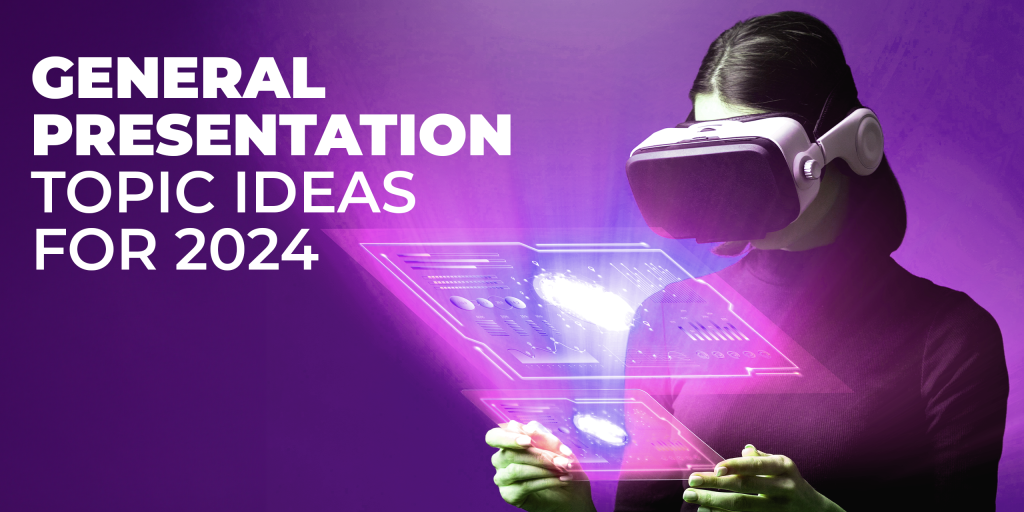
- The Future of Virtual Reality in Education
- The Psychology of Decision-Making: Unraveling the Influences
- Sustainable Fashion: Balancing Style and Ethics
- Blockchain Beyond Cryptocurrency: Real-World Applications
- The Art of Storytelling in Marketing: Creating Lasting Impressions
- The Impact of Social Media on Mental Health
- Innovative Approaches to Urban Planning for a Sustainable Future
- Biohacking: Enhancing Human Performance through Technology
- The Rise of Remote Work: Challenges and Opportunities
- Exploring the Intersection of Art and Artificial Intelligence
Leadership Topic Ideas for Presentation

- Servant Leadership: A Paradigm Shift in Management
- Leading with Empathy in the Corporate World
- Adaptive Leadership in Times of Uncertainty
- The Role of Emotional Intelligence in Effective Leadership
- Leadership Lessons from Unlikely Sources: Animals, Nature, and Beyond
- Fostering a Culture of Innovation: Leadership Strategies
- The Power of Authentic Leadership in Building Trust
- Cross-Cultural Leadership: Navigating Global Teams
- Resilient Leadership: Bouncing Back from Setbacks
- Balancing Confidence and Humility: The Art of Humble Leadership
Business Communication Topic Ideas for Presentation

- Non-verbal Communication in the Digital Age
- Crisis Communication: Strategies for Effective Response
- Navigating Difficult Conversations in the Workplace
- The Influence of Language on Business Negotiations
- The Art of Persuasion: Building Convincing Arguments
- Digital Etiquette: Navigating Professionalism Online
- The Role of Empathy in Customer Communication
- Building a Strong Personal Brand through Communication
- Overcoming Communication Barriers in Diverse Teams
- Humor in Business Communication: When and How to Use It
Presentation Topic Ideas for Controversial Issues

- The Ethics of Genetic Engineering: Navigating the CRISPR Era
- Exploring Both Sides: The Controversy of Universal Basic Income
- The Debate on Privacy vs. National Security in the Digital Age
- The Morality of Artificial Intelligence: Can Machines Have Ethics?
- The Role of Government in Regulating Social Media: Striking the Right Balance
- Medical Marijuana: Bridging the Gap between Medicine and Recreation
- The Controversy of Fast Fashion: Environmental Impact vs. Accessibility
- The Ethics of Animal Testing: Finding Alternatives
- Free Speech in the Digital Space: Where to Draw the Line?
- The Impact of Cancel Culture: Constructive Criticism or Online Harassment?
Presentation Topics Ideas for Designing

- The Psychology of Color in Graphic Design: A Deep Dive
- User-Centered Design: Shaping Products Around People’s Needs
- Minimalism vs. Maximalism: Finding the Right Design Balance
- Designing for Accessibility: Ensuring Inclusivity in Every Interface
- The Evolution of Logo Design: From Tradition to Modern Trends
- Immersive Experiences in Web Design: Beyond the Screen
- The Art of Visual Storytelling: Engaging Audiences through Design
- Typography Trends: Balancing Readability and Aesthetics
- Environmental Design: Merging Sustainability with Aesthetics
- Augmented Reality in Design: Enhancing User Experiences
Presentation Topics Ideas for Marketing

- The Psychology of Consumer Behavior: Understanding the Purchase Decision
- Influencer Marketing: Strategies for Authentic Brand Partnerships
- The Power of Emotional Marketing: Creating Lasting Connections
- Content Marketing in the Age of Information Overload
- Ethical Marketing: Building Trust and Loyalty with Transparency
- The Future of Social Media Marketing: Emerging Platforms and Trends
- Neuromarketing: Leveraging Brain Science to Drive Engagement
- Storytelling in Branding: Crafting Compelling Narratives
- Data-Driven Marketing: Turning Analytics into Actionable Insights
- Interactive Marketing Campaigns: Engaging Audiences in the Digital Age
Presentation Topics Ideas for Entrepreneurship

- Bootstrapping vs. Funding: Choosing the Right Path for Your Startup
- The Role of Failure in Entrepreneurial Success: Embracing Setbacks
- Social Entrepreneurship: Making a Profit with a Purpose
- Innovative Business Models: Disrupting Traditional Industries
- The Art of Pitching: Capturing Investors’ Attention in 5 Minutes
- Balancing Creativity and Structure in Entrepreneurial Ventures
- Building a Sustainable Business: Environmental and Financial Considerations
- The Future of E-Commerce: Trends and Opportunities
- Cultivating a Culture of Innovation in Small Businesses
- The Gig Economy: Navigating the Rise of Freelance and Remote Work
Presentation Topic Ideas for Personal Experiences

- Turning Adversity into Strength: Lessons from Personal Challenges
- My Journey in [Specific Industry]: Lessons Learned and Insights Gained
- The Impact of Travel on Personal Growth and Perspective
- Lessons from Parenting: Applying Family Insights in Professional Life
- Overcoming Fear of Public Speaking: A Personal Triumph
- Navigating Cross-Cultural Experiences: Stories of Adaptation
- From Passion to Profession: Pursuing Your Dreams
- The Power of Vulnerability in Building Meaningful Connections
- Balancing Work and Personal Life: My Successes and Failures
- Lessons from a Hobby: How [Specific Hobby] Shaped My Outlook
Presentation Topic Ideas for Current Trends

- The Metaverse: Exploring the Next Frontier of Digital Interaction
- Decentralized Finance (DeFi): Transforming Traditional Banking Systems
- NFTs (Non-Fungible Tokens): Redefining Ownership in the Digital Age
- The Evolution of Electric Vehicles: Sustainable Transportation Trends
- The Subscription Economy: Shifting from Ownership to Access
- Health and Wellness Tech: The Rise of Wearables and Digital Health
- Micro-Moments in Marketing: Capturing Attention in Seconds
- The Influence of Remote Learning on Education: Challenges and Innovations
- Circular Economy: Reducing Waste and Promoting Sustainable Consumption
- Productizing the services in 2024
Presentation Topic Ideas for Industry Insights

- Revolutionizing Healthcare: The Impact of Telemedicine and Health Tech
- Smart Cities: Integrating Technology for Urban Development
- The Future of Aerospace: Space Tourism and Beyond
- Renewable Energy Innovations: Advancements in Solar, Wind, and Beyond
- Evolving Trends in the Fashion Industry: Sustainability and Tech Integration
- The Changing Landscape of Food Industry: Plant-Based and Lab-Grown Alternatives
- Emerging Trends in the Gaming Industry: AR, VR, and Cloud Gaming
- Transforming Agriculture: AgTech Solutions for a Sustainable Future
- The Future of Transportation: Hyperloop, Autonomous Vehicles, and Drones
- Innovations in Construction: Sustainable Materials and Smart Infrastructure
Presentation Topic Ideas for Digital Marketing
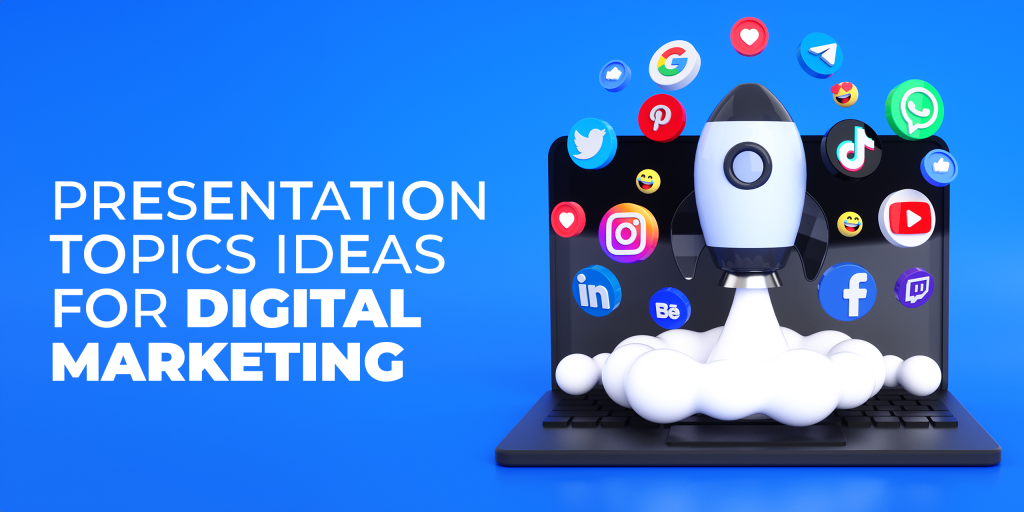
- Voice Search Optimization: Adapting to Changing Search Patterns
- The Role of Chatbots in Customer Engagement: Enhancing User Experience
- Video Marketing Strategies: Creating Compelling Visual Content
- Interactive Email Campaigns: Beyond the Click-Through Rate
- The Impact of AI on Personalizing Digital Marketing Campaigns
- Podcasting as a Marketing Tool: Building Authority and Connection
- Virtual Events and Experiences: Engaging Audiences in a Digital Landscape
- Data Privacy in Digital Marketing: Navigating Regulations and Trust
- The Power of User-Generated Content: Turning Customers into Advocates
- Inclusive Marketing: Representing Diversity in Brand Campaigns
Presentation Topic Ideas for AI (Artificial Intelligence)
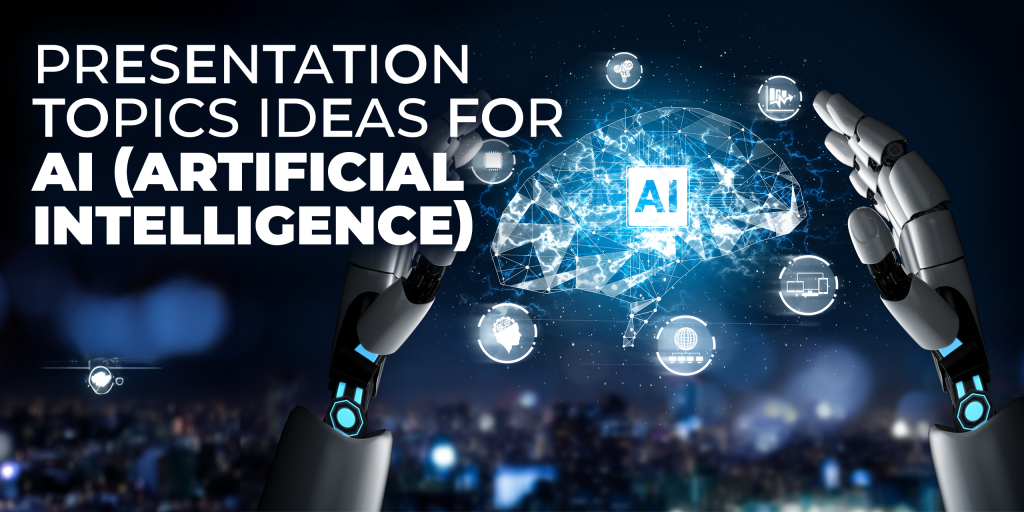
- Ethical Considerations in AI: Addressing Bias and Fairness
- Explainable AI: Bridging the Gap Between Complexity and Understanding
- AI in Healthcare: Diagnosing, Treating, and Preventing Diseases
- The Role of AI in Climate Change: From Prediction to Mitigation
- AI and Creativity: Exploring the Intersection of Technology and Art
- AI in Education: Personalized Learning and Classroom Integration
- Robotics and AI in Manufacturing: Transforming Production Processes
- AI-Enhanced Cybersecurity: Protecting Against Evolving Threats
- Natural Language Processing: Breaking Barriers in Human-Computer Interaction
- AI for Social Good: Solving Global Challenges with Technology
Presentation Topic Ideas for Sales Consulting

- Consultative Selling: Building Relationships and Adding Value
- Sales Psychology: Understanding Customer Motivations and Objections
- Adapting to the Digital Sales Landscape: Strategies for Online Selling
- The Art of Negotiation: Techniques for Successful Deal-Making
- Sales Automation: Streamlining Processes for Efficiency and Effectiveness
- Account-Based Selling: Tailoring Strategies for Targeted Clientele
- The Future of B2B Sales: Trends and Technologies Shaping the Industry
- Building a Personal Brand for Sales Success: Online and Offline
- Customer Retention Strategies: Going Beyond the Initial Sale
- Storyselling: Using Narratives to Persuade and Connect with Customers
Presentation Topic Ideas for Time Management

- The Pomodoro Technique: Boosting Productivity with Time Blocks
- Time Management for Remote Workers: Balancing Flexibility and Structure
- Eisenhower Matrix: Prioritizing Tasks for Maximum Impact
- Mindful Time Management: Incorporating Meditation and Reflection
- Time Blocking for Success: Structuring Your Day for Optimal Performance
- Effective Goal Setting: Aligning Tasks with Long-Term Objectives
- Technology and Time Management: Tools for Efficiency and Focus
- The 2-Minute Rule: Tackling Small Tasks for Immediate Progress
- Batch Processing: Streamlining Work by Grouping Similar Activities
- Time Management in Leadership: Balancing Responsibilities and Delegation
Presentation Topic Ideas for Technology

- The Evolution of Cybersecurity: Adapting to Emerging Threats
- Cloud Computing Trends: From Infrastructure to Platform as a Service
- Blockchain in Business: Beyond Cryptocurrency Applications
- The Future of Quantum Computing: Revolutionizing Data Processing
- 5G Technology: Implications for Connectivity and Innovation
- Edge Computing: Reducing Latency and Enhancing Performance
- The Role of DevOps in Streamlining Software Development and Operations
- Cybersecurity in the Internet of Things (IoT): Protecting Connected Devices
- Augmented Reality in IT: Enhancing User Experiences and Workflows
- Data Governance and Privacy: Navigating Legal and Ethical Considerations
Presentation Topics Ideas for Corporate Business Leaders

- Agile Business Models: Adapting to Rapid Change and Uncertainty
- Creating a Culture of Innovation: Strategies for Fostering Creativity
- Business Ethics in the Age of Transparency: Building Trust with Stakeholders
- The Future of Work: Redefining the Employee Experience
- Strategic Partnerships: Collaborative Approaches to Business Growth
- Globalization vs. Localization: Finding the Right Balance in Business Expansion
- Intrapreneurship: Nurturing Entrepreneurial Spirit within Large Organizations
- Crisis Management in Business: Strategies for Resilience and Recovery
- The Impact of Corporate Social Responsibility on Brand Reputation
- Business Model Innovation: Rethinking Traditional Approaches for Success
Work-Life Presentation Topic Idea s

- Remote Team Building: Strategies for Fostering Collaboration and Connection
- Embracing a Growth Mindset in the Workplace: Navigating Challenges with a Positive Perspective
- Balancing Work and Parenthood: Tips for Working Parents
- Building a Culture of Inclusivity: Creating a Supportive and Diverse Work Environment
- The Future of Flexible Work: Adapting to Changing Work Structures
- Mindful Leadership: Integrating Mindfulness Practices for Effective Management
- Navigating Workplace Conflict: Strategies for Resolution and Relationship Building
- Workplace Well-being Programs: Enhancing Employee Health and Productivity
- The Importance of Continuous Learning: Staying Relevant in a Rapidly Changing Work Environment
- Resilience in the Face of Professional Setbacks: Bouncing Back from Career Challenges
| |
DESIGN SHIFU
Read design shifu's articles and profile., privacy overview.
- International
- Education Jobs
- Schools directory
- Resources Education Jobs Schools directory News Search

Space - fun introduction lesson
Subject: Primary science
Age range: 7-11
Resource type: Lesson (complete)
Last updated
28 August 2024
- Share through email
- Share through twitter
- Share through linkedin
- Share through facebook
- Share through pinterest

This PowerPoint lesson on space exploration is designed to engage and educate primary school students about the wonders of space.
It’s perfect for teachers looking to introduce a topic day on space, providing a fun and interactive way to explore the subject.
The resource contains various activities, including a mind-mapping session , a game of "Two Truths and a Lie, " and a video of the Artemis I launch to captivate the students’ imagination.
Each slide focuses on a different aspect of space exploration, from advancing scientific knowledge to inspiring future generations.
Please note that in the notes section of the ppt you can find info and answers for the two truths and one lie game!
Tes paid licence How can I reuse this?
Your rating is required to reflect your happiness.
It's good to leave some feedback.
Something went wrong, please try again later.
This resource hasn't been reviewed yet
To ensure quality for our reviews, only customers who have purchased this resource can review it
Report this resource to let us know if it violates our terms and conditions. Our customer service team will review your report and will be in touch.
Not quite what you were looking for? Search by keyword to find the right resource:
The University of Chicago The Law School
Innovation clinic—significant achievements for 2023-24.
The Innovation Clinic continued its track record of success during the 2023-2024 school year, facing unprecedented demand for our pro bono services as our reputation for providing high caliber transactional and regulatory representation spread. The overwhelming number of assistance requests we received from the University of Chicago, City of Chicago, and even national startup and venture capital communities enabled our students to cherry-pick the most interesting, pedagogically valuable assignments offered to them. Our focus on serving startups, rather than all small- to medium-sized businesses, and our specialization in the needs and considerations that these companies have, which differ substantially from the needs of more traditional small businesses, has proven to be a strong differentiator for the program both in terms of business development and prospective and current student interest, as has our further focus on tackling idiosyncratic, complex regulatory challenges for first-of-their kind startups. We are also beginning to enjoy more long-term relationships with clients who repeatedly engage us for multiple projects over the course of a year or more as their legal needs develop.
This year’s twelve students completed over twenty projects and represented clients in a very broad range of industries: mental health and wellbeing, content creation, medical education, biotech and drug discovery, chemistry, food and beverage, art, personal finance, renewable energy, fintech, consumer products and services, artificial intelligence (“AI”), and others. The matters that the students handled gave them an unparalleled view into the emerging companies and venture capital space, at a level of complexity and agency that most junior lawyers will not experience until several years into their careers.
Representative Engagements
While the Innovation Clinic’s engagements are highly confidential and cannot be described in detail, a high-level description of a representative sample of projects undertaken by the Innovation Clinic this year includes:
Transactional/Commercial Work
- A previous client developing a symptom-tracking wellness app for chronic disease sufferers engaged the Innovation Clinic again, this time to restructure its cap table by moving one founder’s interest in the company to a foreign holding company and subjecting the holding company to appropriate protections in favor of the startup.
- Another client with whom the Innovation Clinic had already worked several times engaged us for several new projects, including (1) restructuring their cap table and issuing equity to an additional, new founder, (2) drafting several different forms of license agreements that the company could use when generating content for the platform, covering situations in which the company would license existing content from other providers, jointly develop new content together with contractors or specialists that would then be jointly owned by all creators, or commission contractors to make content solely owned by the company, (3) drafting simple agreements for future equity (“Safes”) for the company to use in its seed stage fundraising round, and (4) drafting terms of service and a privacy policy for the platform.
- Yet another repeat client, an internet platform that supports independent artists by creating short films featuring the artists to promote their work and facilitates sales of the artists’ art through its platform, retained us this year to draft a form of independent contractor agreement that could be used when the company hires artists to be featured in content that the company’s Fortune 500 brand partners commission from the company, and to create capsule art collections that could be sold by these Fortune 500 brand partners in conjunction with the content promotion.
- We worked with a platform using AI to accelerate the Investigational New Drug (IND) approval and application process to draft a form of license agreement for use with its customers and an NDA for prospective investors.
- A novel personal finance platform for young, high-earning individuals engaged the Innovation Clinic to form an entity for the platform, including helping the founders to negotiate a deal among them with respect to roles and equity, terms that the equity would be subject to, and other post-incorporation matters, as well as to draft terms of service and a privacy policy for the platform.
- Students also formed an entity for a biotech therapeutics company founded by University of Chicago faculty members and an AI-powered legal billing management platform founded by University of Chicago students.
- A founder the Innovation Clinic had represented in connection with one venture engaged us on behalf of his other venture team to draft an equity incentive plan for the company as well as other required implementing documentation. His venture with which we previously worked also engaged us this year to draft Safes to be used with over twenty investors in a seed financing round.
More information regarding other types of transactional projects that we typically take on can be found here .
Regulatory Research and Advice
- A team of Innovation Clinic students invested a substantial portion of our regulatory time this year performing highly detailed and complicated research into public utilities laws of several states to advise a groundbreaking renewable energy technology company as to how its product might be regulated in these states and its clearest path to market. This project involved a review of not only the relevant state statutes but also an analysis of the interplay between state and federal statutes as it relates to public utilities law, the administrative codes of the relevant state executive branch agencies, and binding and non-binding administrative orders, decisions and guidance from such agencies in other contexts that could shed light on how such states would regulate this never-before-seen product that their laws clearly never contemplated could exist. The highly varied approach to utilities regulation in all states examined led to a nuanced set of analysis and recommendations for the client.
- In another significant research project, a separate team of Innovation Clinic students undertook a comprehensive review of all settlement orders and court decisions related to actions brought by the Consumer Financial Protection Bureau for violations of the prohibition on unfair, deceptive, or abusive acts and practices under the Consumer Financial Protection Act, as well as selected relevant settlement orders, court decisions, and other formal and informal guidance documents related to actions brought by the Federal Trade Commission for violations of the prohibition on unfair or deceptive acts or practices under Section 5 of the Federal Trade Commission Act, to assemble a playbook for a fintech company regarding compliance. This playbook, which distilled very complicated, voluminous legal decisions and concepts into a series of bullet points with clear, easy-to-follow rules and best practices, designed to be distributed to non-lawyers in many different facets of this business, covered all aspects of operations that could subject a company like this one to liability under the laws examined, including with respect to asset purchase transactions, marketing and consumer onboarding, usage of certain terms of art in advertising, disclosure requirements, fee structures, communications with customers, legal documentation requirements, customer service and support, debt collection practices, arrangements with third parties who act on the company’s behalf, and more.
Miscellaneous
- Last year’s students built upon the Innovation Clinic’s progress in shaping the rules promulgated by the Financial Crimes Enforcement Network (“FinCEN”) pursuant to the Corporate Transparency Act to create a client alert summarizing the final rule, its impact on startups, and what startups need to know in order to comply. When FinCEN issued additional guidance with respect to that final rule and changed portions of the final rule including timelines for compliance, this year’s students updated the alert, then distributed it to current and former clients to notify them of the need to comply. The final bulletin is available here .
- In furtherance of that work, additional Innovation Clinic students this year analyzed the impact of the final rule not just on the Innovation Clinic’s clients but also its impact on the Innovation Clinic, and how the Innovation Clinic should change its practices to ensure compliance and minimize risk to the Innovation Clinic. This also involved putting together a comprehensive filing guide for companies that are ready to file their certificates of incorporation to show them procedurally how to do so and explain the choices they must make during the filing process, so that the Innovation Clinic would not be involved in directing or controlling the filings and thus would not be considered a “company applicant” on any client’s Corporate Transparency Act filings with FinCEN.
- The Innovation Clinic also began producing thought leadership pieces regarding AI, leveraging our distinct and uniquely University of Chicago expertise in structuring early-stage companies and analyzing complex regulatory issues with a law and economics lens to add our voice to those speaking on this important topic. One student wrote about whether non-profits are really the most desirable form of entity for mitigating risks associated with AI development, and another team of students prepared an analysis of the EU’s AI Act, comparing it to the Executive Order on AI from President Biden, and recommended a path forward for an AI regulatory environment in the United States. Both pieces can be found here , with more to come!
Innovation Trek
Thanks to another generous gift from Douglas Clark, ’89, and managing partner of Wilson, Sonsini, Goodrich & Rosati, we were able to operationalize the second Innovation Trek over Spring Break 2024. The Innovation Trek provides University of Chicago Law School students with a rare opportunity to explore the innovation and venture capital ecosystem in its epicenter, Silicon Valley. The program enables participating students to learn from business and legal experts in a variety of different industries and roles within the ecosystem to see how the law and economics principles that students learn about in the classroom play out in the real world, and facilitates meaningful connections between alumni, students, and other speakers who are leaders in their fields. This year, we took twenty-three students (as opposed to twelve during the first Trek) and expanded the offering to include not just Innovation Clinic students but also interested students from our JD/MBA Program and Doctoroff Business Leadership Program. We also enjoyed four jam-packed days in Silicon Valley, expanding the trip from the two and a half days that we spent in the Bay Area during our 2022 Trek.
The substantive sessions of the Trek were varied and impactful, and enabled in no small part thanks to substantial contributions from numerous alumni of the Law School. Students were fortunate to visit Coinbase’s Mountain View headquarters to learn from legal leaders at the company on all things Coinbase, crypto, and in-house, Plug & Play Tech Center’s Sunnyvale location to learn more about its investment thesis and accelerator programming, and Google’s Moonshot Factory, X, where we heard from lawyers at a number of different Alphabet companies about their lives as in-house counsel and the varied roles that in-house lawyers can have. We were also hosted by Wilson, Sonsini, Goodrich & Rosati and Fenwick & West LLP where we held sessions featuring lawyers from those firms, alumni from within and outside of those firms, and non-lawyer industry experts on topics such as artificial intelligence, climate tech and renewables, intellectual property, biotech, investing in Silicon Valley, and growth stage companies, and general advice on career trajectories and strategies. We further held a young alumni roundtable, where our students got to speak with alumni who graduated in the past five years for intimate, candid discussions about life as junior associates. In total, our students heard from more than forty speakers, including over twenty University of Chicago alumni from various divisions.
The Trek didn’t stop with education, though. Throughout the week students also had the opportunity to network with speakers to learn more from them outside the confines of panel presentations and to grow their networks. We had a networking dinner with Kirkland & Ellis, a closing dinner with all Trek participants, and for the first time hosted an event for admitted students, Trek participants, and alumni to come together to share experiences and recruit the next generation of Law School students. Several speakers and students stayed in touch following the Trek, and this resulted not just in meaningful relationships but also in employment for some students who attended.
More information on the purposes of the Trek is available here , the full itinerary is available here , and one student participant’s story describing her reflections on and descriptions of her experience on the Trek is available here .
The Innovation Clinic is grateful to all of its clients for continuing to provide its students with challenging, high-quality legal work, and to the many alumni who engage with us for providing an irreplaceable client pipeline and for sharing their time and energy with our students. Our clients are breaking the mold and bringing innovations to market that will improve the lives of people around the world in numerous ways. We are glad to aid in their success in any way that we can. We look forward to another productive year in 2024-2025!

IMAGES
VIDEO
COMMENTS
Here are some key points explaining why we study space: Understanding our Origins: Space research helps us uncover the origins of the universe, including how galaxies, stars, and planets formed. Advancing Scientific Knowledge: Studying space leads to breakthroughs in physics, astronomy, and other scientific fields, expanding our understanding of the cosmos.
HERMES (Heliophysics Environmental and Radiation Measurement Experiment Suite) Herschel Space Observatory. HETE-1 (High Energy Transient Explorer 1) HETE-2 (High Energy Transient Explorer 2) High-Tech Computing. Hinode (Solar B) Hipparcos. Hi-Rate Composite Aircraft Manufacturing. Hispanic Heritage Month.
Space Topics For Presentation. Giving a presentation or seminar on space could be quite dicey. It requires that you can make complex phenomena appeal to the mind of your listeners. To be able to do this, you need to have a considerable amount of knowledge in any of the space science topics that you choose. A tip will be to choose topics that ...
The hallmark is audience participation, and the topics addressed span the Earth and space sciences. The central objective is to develop conceptual understanding of the universe around us by building bridges to the familiar—using the power of models. Provided below are descriptions of presentations by our staff which were developed for Family ...
Video playlists about Space. The most notable talks of 2018, chosen by TED Curator Chris Anderson. What. A. Year. These 25 TED Talks helped us make better decisions, taught us some fascinating science, gave us some hope for humanity and showed us what it's like to climb 3,000 feet ... without a rope. Zoom into the strange wonder and potential ...
Explaining Aerodynamics can be an interesting topic. It also allows you to introduce props such as a plane and practical exercises such as creating your own plane and analyzing its aerodynamics. The introduction of visuals for such a topic can greatly enhance the learning experience. 6. Gravity.
a. Captivating Audiences with Presentation Templates. The best presentation templates available on the internet offer a powerful tool for bringing the wonders of space to life in our presentations ...
Jaime Neely — April 25, 2014 — Autos. These presentations on space will definitely appeal to any science or outer space enthusiast. Addressing topics such as space exploration, the possibility of building communities on both the moon and Mars and the politics surround outer space missions, these speeches are informative and, in some cases ...
Space Presentation templates The Slidesgo rocket is about to take off! Get on it to discover everything in outer space: galaxies, planets, stars, satellites and amazing Google Slides themes and PowerPoint templates to use in your space presentations. ... Slidesgo templates like this one here offer the possibility to convey a concept, idea or ...
126 Topics about Space. For a space essay, you need a rocketing title! Welcome to our space essay topics, where we journey beyond Earth's boundaries. Space exploration, astronomy, and the mysteries of the universe have captivated human curiosity for centuries! Go through these space topics for presentation and uncover the wonders arising from ...
These space presentation templates are suitable for any audience interested in astronomy, space exploration, or science fiction. They can be used for educational purposes, professional presentations, or even for entertainment purposes at events or conferences related to space and technology. Download these space templates and take your audience ...
Night Sky Tour. Presentation on what is currently in our night sky: Identify Constellations, nebulas and other deep sky objects in our current night sky. Schedule a virtual field trip to the Pierce College Science Dome for your K-12 class, homeschool group, club, or scout group.
This presentation is about major discoveries made with telescopes, and how the evolution of telescope technology changed the way we understand our universe. 5. Space Weather Use this presentation to show how space weather directly effects our way of life on Earth, and illustrate the Earth-Sun connection. 4. A Galaxy Full of Black Holes
Space exploration, development, and security are increasingly important elements of national policy and strategy. Inevitably, the presidential term starting in 2021 will include the need for many high-level decisions on space-related issues. Aerospace has created a series of discussion papers—Space Agenda 2021—on topics already at the forefront, or likely to emerge in the next few years.
A review of the recent space exploration breakthroughs. The moon landing. The Mars landing of space rovers. A deeper look at the history of astronomy. Reviewing the heliocentric model of the galaxy. Analyzing the lifecycle of a star.
The analysis of the accidents led to the development of a number of recommendations. The Main Reasons for Space Exploration. In 1957, the Soviet successfully launched the first satellite into space that marked the beginning of space exploration. After the success of the Soviet's satellite, the U.S.invested more into space exploration.
The first was to identify the terrestrial planets that existed in the habitable zone of the huge number of stars that the mission was going to analyze. Space Exploration Accidents: Challenger and Columbia. The failure in the joint of the elements of the rocket motor caused the Challenger catastrophe.
Looking for presentation topics that will captivate any audience in 2024? Our guide features over 500 engaging and informative ideas spanning business, tech, arts, and more. ... Space Odyssey: The never-ending quest for exploration. Tech Fashion: Wearable tech for the fashion-forward. The 5G Revolution: The need for speed ...
Data visualizations can elevate your presentation from being a good one to a great one. By providing data behind your arguments, you'll appear more trustworthy and confident in your audience's eyes. Add charts, graphs, interactive maps, and more to your presentations with Prezi Design. You can choose from a wide selection of charts and maps ...
As a presenter, having a variety of captivating topics for 20-minute presentations is crucial. These 200 topics are designed to energize and engage your audience, ensuring your next presentation is a memorable one! ... Space Exploration: Benefits and Risks; Mindfulness and Stress Reduction Techniques; Plastic Pollution and Ocean Conservation;
Most of the photos from Nasa are labeled as public domain. Meaning that you can give your presentation a space theme quite easily. Choose images of astronauts in space or more abstract and colorful images like distant galaxies and nebulas. The latter can make great backgrounds behind content without the topic necessarily being about space.
You get unlimited designs for a flat monthly fee, which includes not only presentation designs but also services like infographics, social media designs, logo design, etc. Now, back to the topic selection. You need to strike a balance between creativity and relevance to make an impact on the right audience.
This PowerPoint lesson on space exploration is designed to engage and educate primary school students about the wonders of space. It's perfect for teachers looking to introduce a topic day on space, providing a fun and interactive way to explore the subject. ... Please note that in the notes section of the ppt you can find info and answers ...
General The Innovation Clinic continued its track record of success during the 2023-2024 school year, facing unprecedented demand for our pro bono services as our reputation for providing high caliber transactional and regulatory representation spread. The overwhelming number of assistance requests we received from the University of Chicago, City of Chicago, and even national startup and ...